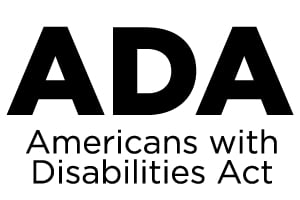How to Grow Your YouTube Channel With 9 Tips and Tricks
Are you looking for tips on how to start and build a successful YouTube channel? If so, you’ve come to the right place. We’ll help you understand what it takes to create engaging videos and grow your online presence. From optimizing your content for SEO, creating compelling video titles, producing quality visual content, and utilizing social media platforms – we have all the advice you need to make your mark on YouTube. Let’s get started!
Table of contents
- Understanding Your Audience and Niche
- High-Quality Content Creation
- Optimizing Video Titles, Descriptions, and Tags
- Utilizing Thumbnails and Channel Art
- Use Subtitles for your Videos
- Leveraging Social Media and Cross-Promotion
- Consistency and Scheduling
- Promoting Your Channel Beyond YouTube
- Engaging with Your Audience
Tip #1: Understanding Your Audience and Niche
When you start a YouTube channel, it’s important that you have an understanding of what target audience and niche you cater to. You will need to think about who your viewers are, what kind of videos you plan on creating, and how to get them interested in watching your content.
You can decide to focus on a particular topic or genre, which could be anything from cooking tutorials to video game reviews, or you could choose to create a wide variety of videos. No matter what type of content you decide upon, it’s best to focus on topics that interest you and that others may find useful.
It’s also helpful to identify who your ideal viewers are — their demographics, interests, and preferences. Conduct thorough research to gain insights into the popular trends and topics within your niche. This knowledge will help you create content that resonates with your audience, keeping them engaged and coming back for more.
Once you have determined what kind of videos you want to create and who would likely watch them, it’s time to do some research on the competition. Look into other popular YouTube channels in your niche and consider how they are promoting their content – this will give you a better idea of what techniques may be successful with your channel as well. It’s important to remember that even though there is competition out there, people often subscribe to multiple channels on the same topic, so don’t let that discourage you from taking the plunge!
Tip #2: High-Quality Content Creation
Creating high-quality content is a critical component of successful video marketing. You should consider what kind of content will be most engaging for your target audience, as well as which platforms are best suited for your videos. For example, a YouTube channel is ideal for more interactive content that features links and other clickable elements, while a video on Instagram is better suited to shorter clips that are easy to share.
Be sure to focus on quality when creating content – things like clear audio, good lighting, and high-definition video can make all the difference. Start by meticulously planning and scripting your videos to ensure a clear and coherent message. Invest in professional equipment such as cameras, microphones, and lighting to enhance the production value of your videos. Additionally, utilize video editing software to refine your content, add visual elements, and create a polished final product.
Find out everything you need to know about subtitling for Youtube
Read the blogTip #3: Optimizing Video Titles, Descriptions, and Tags
Optimizing your video titles, descriptions, and tags on YouTube is essential for getting discovered and growing your channel. Crafting attention-grabbing titles is essential to pique the interest of potential viewers and entice them to click on your videos.
Your title should be concise and to the point while providing enough information about the video content. It should also include relevant keywords that people may search for in order to find it more easily. Your description should provide a clear overview of what the video is about as well as capture viewers’ interest and entice them to watch. As for tags, they can help with categorization; however, make sure not to choose too many irrelevant tags or too generic ones like “funny” or “entertainment.” Instead, focus on relevant keywords that accurately represent the content of your video in order to more effectively target your audience.
Tip #4: Utilizing Thumbnails and Channel Art
When it comes to making your YouTube channel look professional, utilizing thumbnails and channel art is key. Thumbnails are the small images that are associated with each video you produce, and they provide viewers with a visual representation of what the video is about. It’s important to make sure that each thumbnail is unique, relevant to its corresponding video content, and follows YouTube’s guidelines for size and resolution. On the other hand, channel art is the large image that appears at the top of your YouTube channel page. This image should be eye-catching, attention-grabbing and represent your brand in a positive light while following YouTube’s specifications for size and resolution as well. By ensuring both thumbnails and channel art fit within YouTube’s guidelines and are visually pleasing, viewers will be more likely to watch your videos. Furthermore, having an aesthetically pleasing profile page can help set you apart from other channels on YouTube. Creating good content isn’t enough – ensure that design plays a role in the success of your channel.
Utilizing thumbnails and creating great channel art is the perfect way to give your viewers the best possible experience when visiting your page! So take some time to make sure these elements look amazing and represent your brand well – it’s all part of creating a successful online presence!
Tip #5: Use Subtitles for Your Videos
Subtitling your YouTube videos offers a range of benefits that can significantly enhance your channel’s growth and accessibility. Firstly, subtitles make your content more inclusive and accessible to viewers with hearing impairments or language barriers, allowing them to fully engage with your videos. This expands your potential audience and demonstrates a commitment to inclusivity. Subtitles also improve the overall user experience by providing clarity and comprehension, especially in cases where audio quality may be compromised or when viewers are in noisy environments. Additionally, subtitles improve search engine optimization (SEO) as they provide text content that can be indexed by search engines, increasing the likelihood of your videos being discovered by new viewers. Moreover, subtitles enable viewers to follow along with your videos in situations where sound cannot be played, such as in quiet environments or while watching muted videos. By providing subtitles, you not only cater to a wider audience but also enhance the overall quality and accessibility of your YouTube channel.
To get subtitles for your videos rapidly, you can use services like Amberscript. Our platform offers both automatic and human-made services, so you can choose the option that best fits your needs. When you choose the automatic service, you obtain your subtitles within minutes and you can easily edit them using our editor before exporting the file. However, you can always request that our expert subtitlers take care of your file, so you are sure that your subtitles will be 100% accurate when you get them back.

Tip #6: Leveraging Social Media and Cross-Promotion
In this digital age, leveraging social media and cross-promotion is an essential part of any marketing strategy. Utilizing social media platforms like YouTube can be a great way to reach potential customers and promote your business. You can create a YouTube channel where you can upload videos that showcase your product or service, as well as share news and updates related to your company. Additionally, you can use cross-promotion techniques to reach new audiences by collaborating with other businesses or influencers in your industry. By using these tactics, you’ll be able to maximize the visibility of your brand and effectively spread the word about what you have to offer.
Tip #7: Consistency and Scheduling
Consistency and Scheduling are two of the key factors to consider when creating a YouTube channel. The frequency of content is an important factor, as it can help to build up a loyal audience base who will be expecting regular content from you. Some creators choose to post weekly or daily while others decide on a bi-weekly or monthly schedule – whatever works best for you. Consistent scheduling also helps viewers get into the rhythm of watching your videos; if people know when they can expect new content, they’re more likely to tune in every time. Additionally, having a consistent upload schedule allows viewers to plan their watch times around your upcoming videos – this way, they won’t miss any of your new content! Finally, consistency in the length and types of videos you produce will help to establish your channel’s identity and keep viewers engaged. Showing that you can produce quality content regularly helps build trust with your audience, which is essential for long-term success. With consistency and scheduling, you can create a reliable viewing experience that leaves viewers excited for more.
Tip #8: Promoting Your Channel Beyond YouTube
Now that your YouTube Channel is up and running, you’ll want to make sure as many people as possible see it. Promoting your channel beyond YouTube will help you reach a wider audience and increase engagement on your videos. Consider creating social media accounts for your channel and cross-promoting with other relevant channels or organizations in the same niche. You can also use email marketing campaigns to drive traffic back to your channel by including links in each message. Finally, don’t forget to host live streaming events on other platforms such as Twitch, Facebook Live or Instagram Live where you can invite viewers from those networks to join and watch your content. By taking advantage of all of the different ways available to promote your YouTube Channel, you’ll be able to reach more people and gain more views on your videos.
Another great way to promote your YouTube Channel is through SEO. By using targeted keywords in the titles, descriptions, and tags of all of your videos, you’ll be able to maximize their visibility in search engine results pages, helping them rank higher when users are searching for related content. You should also focus on creating backlinks from other websites that link back to your channel’s page or specific videos — this will help improve ranking and drive more traffic to your channel. With a few simple tactics like these, you can quickly see an increase in viewership and engagement from those who find you through organic search.
Why you should use Amberscript
Audio transcription has never been this simple. Start now and save hours of time!
Transcribe audio and video to text without errors and receive a perfect export.
GDPR compliant security and safety. Your files are confidentially stored in a secure environment.
Tip #9: Engaging with Your Audience
Engaging with your audience is an essential part of running a successful YouTube channel. As you grow in popularity, it’s important to remember to respond and interact with your fan base. You can start by responding to comments on your videos, liking other people’s content, and even joining conversations on social media platforms like Twitter and Instagram. Don’t forget about the power of live streaming – this allows you to have a real-time conversation with your viewers! By engaging with your audience, you will be able to create meaningful relationships that will help keep them engaged and interested in what you have to offer. Additionally, you can use this engagement to learn more about your viewers and the types of content that they want to watch. All in all, engaging with your audience is an invaluable part of running a successful YouTube channel.
Additionally, when interacting with your audience (or potential audiences), be sure to do so in a respectful and professional manner. Remember that while you may have passionate views on certain topics, it’s important to remember that everyone has different opinions and perspectives. Try not to let things get heated or personal – treat every interaction as if it were taking place in a physical face-to-face conversation. By respecting each other’s thoughts and opinions, you will create a positive image for yourself which will help build trust between you and your audience.
In the digital age, one of the best ways to engage with your audience and gain more followers is through YouTube. YouTube channels are incredibly popular, so if you have something interesting or unique to share, it’s worth considering creating a channel. You can post videos regularly, plan collaborations with other creators, and interact with viewers – not only will this build relationships but also help grow your following. By engaging in conversation and responding to comments, you’ll be able to demonstrate that you care about what others think and get valuable feedback from what they say. This will foster loyalty and ensure that viewers keep coming back for more.
How to add subtitles to a video? Fast & Easy
Table of contents
- Why Subtitles are essential for your next Video Project
- Machine-made subtitling software vs professional subtitling services
- Why you should use Amberscript’s machine-made subtitling software
- Why you should use a professional subtitling service
- Industries and case studies
- Translated subtitles
- Legislation on subtitling accessibility
- Choosing the right subtitling solution
- Make your multimedia content accessible with Amberscript’s subtitling solutions
Why Subtitles are essential for your next Video Project
Are you looking to make your next video project more accessible and engaging?
Then you should consider adding subtitles! Subtitles are textual representations of spoken content in videos and can be turned on or off by viewers. Closed captions, on the other hand, include not only dialogue but also convey important auditory information such as sound effects and music. Subtitles are crucial for making your content more accessible to deaf and hard-of-hearing viewers, but they can also improve comprehension for non-native speakers and increase audience reach.
How do Amberscript’s subtitling services work?
If you’re looking for the right platform to add subtitles to your videos, Amberscript what your looking for. With our advanced technology and easy-to-use platform, adding subtitles to your videos has never been easier. Stay relevant and make your content accessible to everyone with Amberscript.
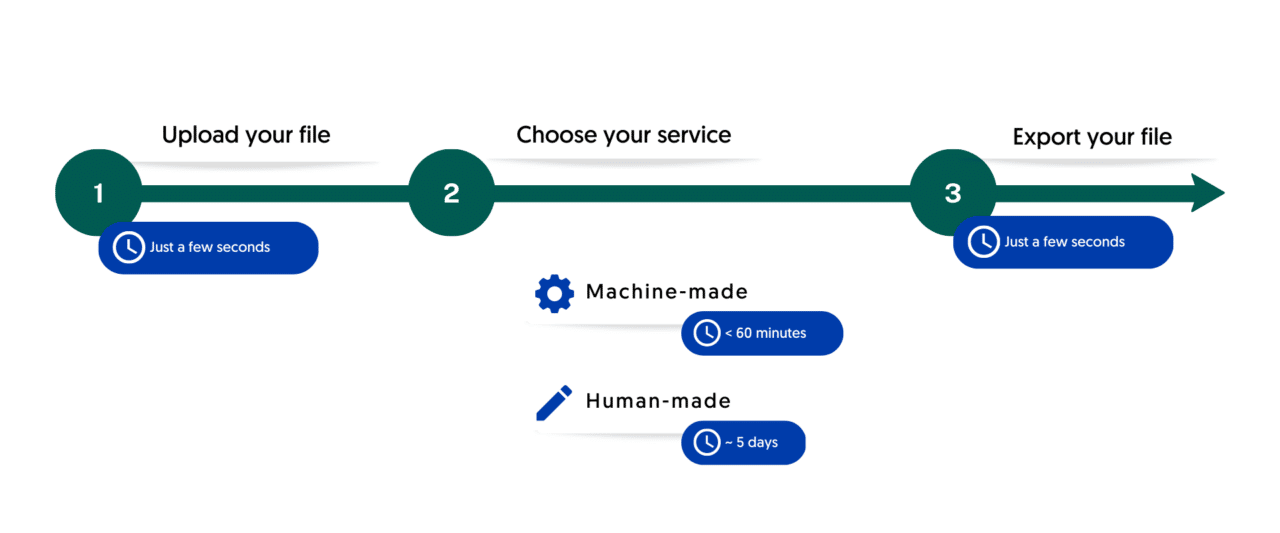
Machine-made subtitling software vs Professional subtitling services
Machine-made subtitling software and professional subtitling services are two methods for creating subtitles for videos. While machine-made software can be a quick and cost-effective solution, it may not always provide the accuracy and quality that professional subtitling services can offer. Here’s a detailed list of advantages and disadvantages of each:
Machine-made subtitling
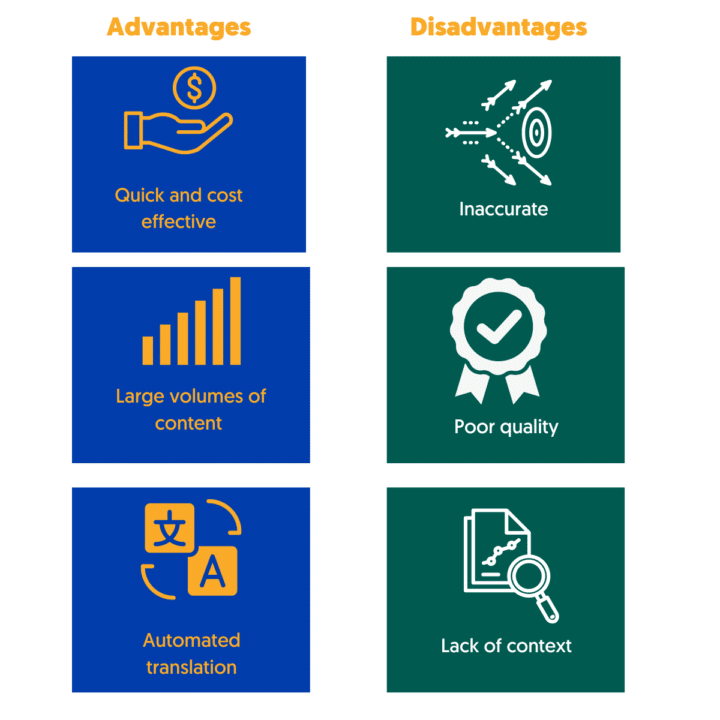
Advantages of machine-made subtitling software:
- Quick and cost-effective: Machine-made software can create subtitles in a matter of minutes, and the cost is usually lower than professional subtitling services.
- Large volumes of content: It can handle large volumes of content, making it useful for videos that have a short shelf life, like social media posts.
- Automated translation: Machine-made subtitling can translate subtitles into multiple languages quickly.
Disadvantages of machine-made subtitling software:
- Inaccurate: Machine-made software can sometimes produce inaccurate subtitles, especially with complicated dialogue or technical terms.
- Poor quality: The subtitles generated by machine-made subtitling may have poor formatting, timing, and synchronization.
- Lack of context: The software may not be able to capture the context of the content, leading to incorrect subtitles or omitting important information.
Professional subtitling services
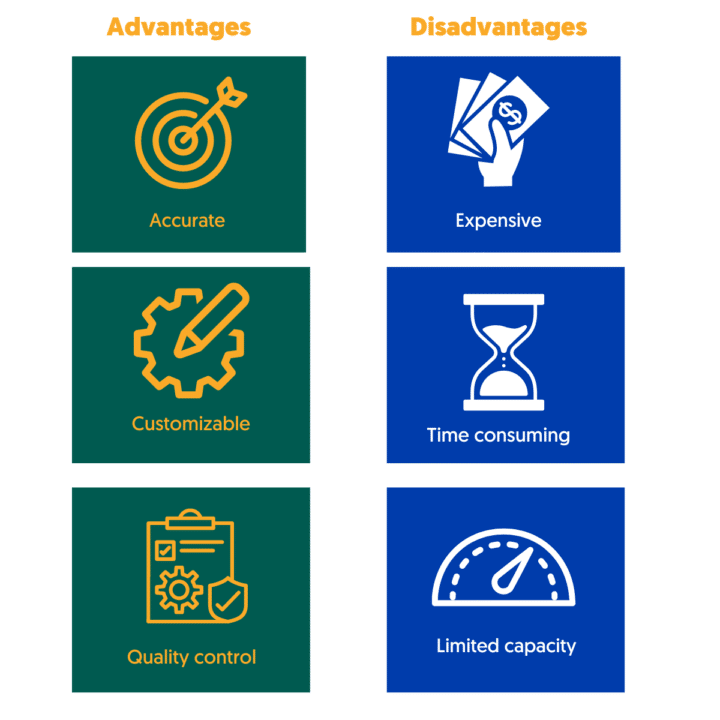
Advantages of professional subtitling services:
- Accurate: Professional subtitling services ensure accuracy and quality of subtitles, even with complicated dialogue or technical terms.
- Customization: Professional subtitling services can customize subtitles to fit the video’s style and tone.
- Quality control: Professional subtitling services have a review process to ensure quality control and catch any errors.
Disadvantages of professional subtitling services:
- Expensive: Professional subtitling services can be more expensive than machine-made software.
- More time needed: The process of creating subtitles manually can be time-consuming, especially for long videos or videos with complicated dialogue.
- Limited capacity: Professional subtitling services may have limited capacity and may not be able to handle large volumes of content.
Suitable cases for using a machine-made subtitling software
Here are some situations where it can be a good choice:
- Short videos with clear audio: Machine-made subtitling can work well for short videos with clear audio. In this case, the software can accurately transcribe the dialogue and generate subtitles quickly, without the need for additional editing or proofreading. For example, machine-made subtitling software can be used for social media posts or short promotional videos.
- Low budget projects: Machine-made subtitling software can be a cost-effective solution for projects with a limited budget. Since the software is usually less expensive than professional subtitling services, it can be a good choice for small businesses, independent creators, or low-budget productions.
- Quick turnaround time needed: Machine-made subtitling software can generate subtitles quickly, making it a good option when a quick turnaround time is needed. For example, if a video needs to be uploaded to a platform with a tight deadline, machine-made software can be used to generate subtitles quickly without the need for manual editing.

Learn how to improve your audio quality
Learn moreSuitable cases for using professional subtitling services
Accuracy is also essential. Here are some situations where professional subtitling may be the ideal choice:
- Longer videos with complex audio: For videos with long durations and complex audio, professional subtitling services can ensure accuracy and quality. The professional subtitlers can work on each subtitle to make sure they match the audio, are in sync with the visuals, and convey the intended meaning accurately. Longer videos with technical language, scientific terms, or legal jargon may require manual subtitling services to ensure accuracy.
- High budget projects: Professional subtitling services can be a good choice for high budget projects that require a high level of quality and accuracy. For example, movies, documentaries, or TV shows with a large audience may need professional subtitling to ensure that the subtitles are of high quality, and the audience can follow the story without any confusion.
- Quality control and accuracy are a top priority: Professional subtitling services are an ideal choice when quality control and accuracy are a top priority. Professional subtitling services companies have a review process to ensure that the subtitles are accurate, formatted correctly, and follow the style guide. They also have experienced subtitlers who can ensure that the subtitles convey the intended meaning of the video.
It’s important to note that professional subtitling services can be more expensive than machine-made software, but they provide a higher level of quality and accuracy. In addition, professional subtitling services offer additional services like translation, closed captions, and SDH (Subtitles for the Deaf and Hard-of-hearing). Overall, professional subtitling services are the best choice for videos that require a high level of accuracy and quality control.
Why you should use Amberscript’s machine-made subtitling software
Amberscript’s machine-made subtitling software is a powerful tool that can provide a range of benefits for those looking to add subtitles to their videos. Here are some of the key benefits of using Amberscript machine-made subtitling software:
- High accuracy and speed: Amberscript’s machine-made subtitling software uses advanced algorithms and artificial intelligence to provide high accuracy and speed when generating subtitles. The software can transcribe audio in multiple languages and dialects, even in noisy or low-quality recordings. It also offers customization options, such as the ability to adjust the subtitle timing and font size, to ensure that the subtitles match the video.
- User-friendly interface: Amberscript’s machine-made subtitling software has a user-friendly interface that makes it easy to use, even for those with no prior experience in subtitling. The software allows users to upload video or audio files directly, and it generates subtitles in a matter of minutes. The software also has an intuitive editing tool that allows users to edit the subtitles easily and export them in various file formats.
- Cost-effective pricing: Amberscript’s software is cost-effective, making it accessible to a wider range of users. The software offers different pricing plans based on the user’s needs, including a pay-per-minute option, a monthly subscription, or a one-time purchase. This flexibility ensures that users can find a plan that fits their budget.
Benefits of using Amberscript
Amberscript’s subtitling services are:
Edit your text in minutes or leave the work to our experienced subtitlers.
Our experienced subtitlers and thorough quality controls ensure 100% accuracy of transcripts and subtitles.
Through a series of integrations and API interfaces, you can fully automate your workflows.
Your data is in safe hands. We are GDPR compliant + ISO27001 and ISO9001 certified.
How to use Amberscript’s machine-made subtitling software
Amberscript’s software is a user-friendly tool that can provide accurate subtitles for videos in a matter of minutes. Here are the steps to follow when using the platform:
- Upload video and select language: The first step is to upload the video that needs subtitles to the Amberscript machine-made subtitling software platform. The user can drag and drop the video file or import it from their computer or cloud storage. Once the video is uploaded, the user needs to select the language of the audio in the video. The software supports multiple languages and dialects, making it a versatile tool for content creators.
- Choose subtitle style and formatting options: After selecting the language, the user can choose the style and formatting options for the subtitles. Amberscript machine-made software offers various customization options, including font size, color, and style. The user can also choose the placement of the subtitles on the screen, depending on their preference. Additionally, the software provides the option to add speaker identification or to remove filler words from the subtitles to make them more concise.
- Download and review subtitles: Once the customization options are set, the user can download the subtitles in their preferred format. The software offers multiple file formats, including SRT, VTT, and TXT. The user can then review the subtitles to ensure accuracy and adjust the timing if needed. The software also provides an editing tool to make changes to the subtitles easily.
When should you use Amberscript’s machine-made subtitling software?
Amberscript’s machine-made software can be a valuable tool for a variety of video content, including social media videos, short instructional videos, and marketing videos. Here are some reasons why using Amberscript’s machine-made subtitling software is important for each of these topics:
- Social media videos: Social media platforms, such as Facebook, Twitter, and Instagram, have become an essential part of communication for individuals and businesses. Social media videos have become increasingly popular as a way to engage with audiences and promote brands. However, most social media videos are watched on mobile devices without sound, making subtitles a crucial component for reaching a wider audience. By using Amberscript’s machine-made software, content creators can easily add subtitles to their social media videos, increasing accessibility and engagement.
- Short instructional videos: Short instructional videos have become a popular way to educate and inform audiences. These videos are often used in educational settings, training programs, or for DIY projects. Subtitles can be particularly helpful for instructional videos, as they can improve comprehension for non-native speakers and provide accessibility for individuals with hearing impairments. With Amberscript’s machine-made subtitling software, content creators can quickly add accurate subtitles to their instructional videos, improving the overall quality of the content.
- Marketing videos: Marketing videos are used to promote products, services, and brands. These videos often have a short time frame to capture the attention of the viewer and convey a message. Subtitles can be an effective way to improve engagement with marketing videos, as they allow viewers to watch the video in any environment, even without sound. Additionally, subtitles can improve the SEO of the video, as search engines can index the text. Amberscript’s machine-made subtitling can be a cost-effective way for businesses to add subtitles to their marketing videos, reaching a wider audience and improving the effectiveness of their marketing efforts.
By adding subtitles, content creators can increase accessibility, engagement, and reach for their videos, improving the overall quality and effectiveness of the content.
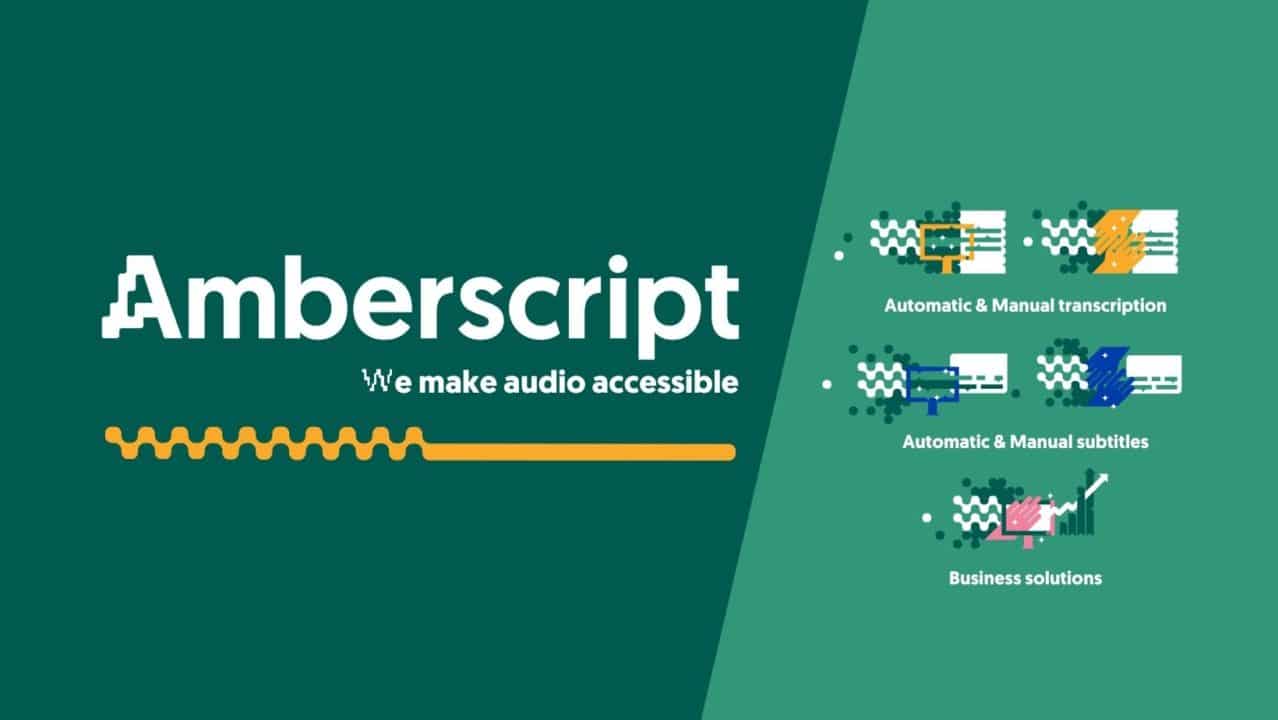
Why you should use a professional subtitling services
Professional subtitling services, like those offered by Amberscript, provide a range of benefits that can improve the quality of your video content. Here are some reasons why you should consider using professional subtitling services:
- High quality and accuracy: Professional subtitling services use experienced linguists who are trained to produce high-quality and accurate subtitles. They can accurately transcribe spoken dialogue, translate text into multiple languages, and ensure that the subtitles are synchronized with the video. With professional subtitling services, you can be confident that your subtitles are of the highest quality, improving the overall viewing experience for your audience.
- Experienced professionals: Professional subtitling services employ experienced professionals who have a deep understanding of the nuances of language and culture. They can provide accurate translations and localization services, ensuring that your subtitles are appropriate for your target audience. Additionally, professionals can help with quality control, ensuring that the final product meets the highest standards.
- Customized subtitle formatting options: Professional subtitling services offer a range of customization options for your subtitles. This includes font size, color, position, and style, allowing you to create subtitles that are consistent with your brand and style guide. Additionally, professionals can provide specialized formatting for certain types of content, such as scientific or technical videos.
How should you choose a professional subtitling services?
When it comes to choosing a professional subtitling services, there are several factors to consider. Here are some important things to keep in mind:
- Reputation and reviews: Look for a subtitling service with a strong reputation in the industry and positive reviews from past clients. This can give you confidence that the service will deliver high-quality work and meet your needs.
- Quality control and accuracy measures: Professional subtitling services should have rigorous quality control and accuracy measures in place to ensure that the final product is of the highest quality. Ask about their editing and proofreading processes to ensure that the subtitles are accurate and error-free.
- Turnaround time and pricing: Consider the turnaround time for the subtitling service and make sure it aligns with your needs. Additionally, compare pricing across different services to ensure that you are getting a fair price for the quality of work being provided.
When considering professional subtitling services, Amberscript is a great option to consider. With a strong reputation in the industry and positive reviews from past clients, you can be confident in the quality of their work. They also have rigorous quality control and accuracy measures in place to ensure that the final product is of the highest quality. With competitive pricing and a range of customization options available, they can meet your specific subtitling needs. Overall, choosing Amberscript for your professional subtitling needs can help ensure that your video content is of the highest quality and meets the needs of your target audience.
When should you use Amberscript’s professional subtitling services?
Subtitling services can be beneficial for a variety of video content, but they are especially important for educational videos, film and television productions, and corporate training videos. Here are some reasons why using Amberscript’s professional subtitling services is essential for these types of content:
- Educational videos: Educational videos are designed to convey important information to students, learners, and professionals. Subtitling services can help make these videos accessible to a wider audience, including those who are deaf or hard of hearing and non-native speakers. By using Amberscript’s professional subtitling services, you can ensure that the subtitles are accurate, easy to read, and timed correctly to the audio, enhancing the learning experience for all viewers.
- Film and television production: Subtitling is an essential aspect of film and television productions, as it enables audiences to enjoy content that is not in their native language. Amberscript’s professional subtitling can ensure that the subtitles are well-timed, accurately translated, and presented in a visually appealing way, without distracting from the content. This can help enhance the viewing experience and make the content more accessible to a wider audience.
- Corporate training videos: Corporate training videos are designed to provide important information to employees and partners. Subtitling can help ensure that this information is accessible to all viewers, including those who are deaf or hard of hearing and non-native speakers. With Amberscript’s professional subtitling, you can ensure that the subtitles are accurate, well-timed, and presented in a professional manner, enhancing the training experience for all viewers.
Industries and case studies
E-Learning and Distance Learning
Subtitles are essential in e-learning and distance learning environments, as they can increase accessibility and comprehension for non-native speakers and individuals with hearing impairments. Additionally, subtitles can improve retention and engagement levels by allowing learners to follow along with the spoken content while reading the text. Case studies have shown that implementing subtitles in e-learning and distance learning can lead to increased participation and success rates. For example, the language learning platform Duolingo has reported increased user engagement and satisfaction since implementing subtitles in their courses.

Learn how to add subtitles to your Canva courses
Read the blogFilm and Television Industry
Subtitling is crucial in the film and television industry, especially for international distribution. Subtitles not only increase accessibility for non-native speakers but also allow for the retention of the original language and cultural context. Netflix, for example, has made a significant investment in localization and subtitling to increase their global reach and engagement. Their approach involves hiring local translators and subtitlers to ensure accuracy and cultural relevance for each region.
Learn how to create captions for your Vimeo videos
Read the blogCorporate sector
Subtitles can play a crucial role in employee training and communication in the corporate industry. They can increase accessibility and comprehension for non-native speakers and individuals with hearing impairments, as well as improve retention and engagement levels. Case studies have shown that implementing subtitles in corporate training videos can lead to higher participation and comprehension rates. For example, IBM has successfully implemented subtitles in their employee training programs, leading to increased engagement and improved training outcomes.

Overall, subtitling is an essential tool in various industries, from e-learning and distance learning to the film and television and corporate industries. Successful implementation can lead to increased accessibility, comprehension, retention, and engagement levels, making it a valuable investment for any organization.
Translated subtitles
Translated subtitles are subtitles that have been translated from the original language of the video content into another language. They are designed to make the video accessible to non-native speakers and to help the content reach a wider audience in different countries.

Find out everything you need to know about translated subtitles
Read the blogOverview of the three subtitling methods
| Machine-made subtitles | Professional subtitles | Translated subtitles | |
|---|---|---|---|
| Speed | 1-2 hours | 3-5 business days | 3-5 business days |
| Accuracy | 85% | 100% | 100% |
| Security | High | High | High |
| Languages | 39 | 15 | 15 |
The importance of localization for international audiences
Localization is the process of adapting content to suit the cultural and linguistic differences of a specific country or region. It is essential for reaching international audiences, as it helps to ensure that the content is relevant, understandable, and engaging for viewers in different countries. Translated subtitles are a key component of localization, as they allow viewers to understand the content in their native language, making it more accessible and engaging.
The importance of translated subtitles
Translated subtitles are an essential tool for making video content accessible to non-native speakers and expanding its reach to audiences in different countries. The importance of translated subtitles can be seen in the following ways:
- Increased reach and audience engagement: Translated subtitles can significantly expand the reach of video content, as they make it accessible to viewers who speak different languages. This can lead to increased audience engagement and help content creators to build a global audience.
- Improved comprehension for non-native speakers: Translated subtitles can also improve the comprehension of video content for non-native speakers. When watching videos in a foreign language, even those with some understanding of the language may miss some nuances or colloquialisms. Translated subtitles make it easier for viewers to understand the content and engage with it fully.
- Cultural sensitivity and accuracy: Translated subtitles can also ensure that content is culturally sensitive and accurate. The translation process requires an understanding of the cultural nuances and customs of the target audience. Therefore, it is essential to work with professional translators who are experienced in translating content for different cultures. Accurate translation ensures that the message is conveyed correctly and helps to avoid any potential misunderstandings or cultural insensitivity.
How to create translated subtitles
Creating translated subtitles can be a complex and time-consuming process, but Amberscript offers several solutions to streamline the process and ensure high-quality results. Here are three options for creating translated subtitles with Amberscript:
- Professional translation services: The most accurate and reliable way to create translated subtitles is by using human translation services. With Amberscript’s professional translation team, you can be sure that your subtitles will be accurate, culturally sensitive, and easy to understand for your target audience. Simply upload your video and select the target language, and Amberscript will provide you with a quote for the translation service. The team will then work to deliver the translated subtitles in a timely manner.
- Machine translation with post-editing: If you’re working with a limited budget or time constraints, machine translation with post-editing can be a more cost-effective and efficient option. Amberscript’s machine translation technology uses advanced algorithms and artificial intelligence to generate a rough draft of the translated subtitles. A professional translator then reviews and edits the machine-generated subtitles for accuracy and cultural sensitivity. This option can be a great choice for videos with simple language and straightforward content.
- Subtitling software with automatic translation: For videos with shorter run times and simple content, Amberscript’s subtitling software with automatic translation can be a fast and convenient option. Simply upload your video and select the target language, and the software will automatically generate the translated subtitles. While this option may not be as accurate as human translation or machine translation with post-editing, it can be a great choice for videos with a quick turnaround time or a limited budget.
No matter which option you choose, Amberscript offers a range of formatting and customization options to ensure that your translated subtitles match the look and feel of your original video. With Amberscript’s user-friendly platform and experienced team, creating translated subtitles has never been easier or more accessible.
Best Services and Softwares for Translated Subtitles
When it comes to translated subtitles, one of the best options is to hire a professional translation service that specializes in subtitling. Here are some top translation services that offer subtitle translation:
- Amberscript: Amberscript’s translation service provides high-quality, accurate translations that are tailored to the specific needs of each project. Their team of experienced translators ensures that the translated subtitles are culturally sensitive and accurate. Moreover, they offer a wide range of language pairs, making them a great choice for international projects.
- Gengo: Gengo is another popular translation service that offers subtitle translation. They have a large network of translators that specialize in subtitling and can provide translations in over 70 languages. They also have a user-friendly platform that allows for easy management and delivery of subtitle files.
- Rev: Rev is a well-known transcription and translation service that also offers subtitle translation. They have a team of professional translators that specialize in subtitling and can provide translations in over 15 languages. They also offer a quick turnaround time and competitive pricing.
Amberscript also offers a subtitle translation software solution that can help create high-quality translated subtitles. With its advanced AI-based technology, Amberscript’s software can automatically translate subtitles in various languages quickly and accurately. The software provides customizable options for subtitle formatting and styling, making it suitable for a range of video projects.
Amberscript’s software also allows for post-editing and review of the translated subtitles, ensuring accuracy and quality control. Additionally, the software is user-friendly and easy to navigate, making it accessible to both professionals and non-professionals.
Legislation on Subtitling Accessibility
Americans with Disabilities Act (ADA)
Ensuring subtitling accessibility is not just a legal requirement, but also a moral and ethical responsibility. It enables individuals with disabilities to fully participate in public life and have equal access to information and opportunities. By providing subtitling accessibility, entities can also expand their audience and reach a wider demographic, ultimately benefiting both themselves and their viewers.
Amberscript offers solutions for subtitling accessibility, including both machine-made and professional subtitling services, as well as translated subtitle services. Amberscript’s subtitling services are designed to meet accessibility requirements and ensure compliance with the ADA and other accessibility regulations. With high accuracy and a user-friendly interface, Amberscript’s solutions can help entities create high-quality subtitles that are accessible to all viewers.
Title II and Title III of ADA and their requirements for subtitling accessibility
he Americans with Disabilities Act (ADA) is a civil rights law that prohibits discrimination against individuals with disabilities in all areas of public life. Title II and Title III of the ADA require that public entities and places of public accommodation, respectively, provide equal access to individuals with disabilities, including those who are deaf or hard of hearing. Subtitling accessibility is an essential component of meeting this requirement.
Title II of the ADA applies to state and local government entities, including schools and universities, and requires them to provide effective communication for individuals with disabilities, which includes providing auxiliary aids and services such as closed captioning. Title III of the ADA applies to places of public accommodation, such as movie theatres and hotels, and also requires them to provide effective communication for individuals with disabilities, including through the provision of auxiliary aids and services.
Penalties for noncompliance with ADA
Penalties for noncompliance with the ADA can be severe, ranging from monetary fines to lawsuits and legal action. The U.S. Department of Justice is responsible for enforcing the ADA, and individuals can also file private lawsuits against noncompliant entities.
21st Century Communications and Video Accessibility Act (CVAA)
The 21st Century Communications and Video Accessibility Act (CVAA) was enacted by the Federal Communications Commission (FCC) in 2010 to ensure accessibility to modern communication technologies for people with disabilities. The act covers all video programming distributed over the internet, including live and prerecorded content.
- The CVAA requires video programming distributors to make their content accessible to individuals who are deaf, hard of hearing, blind, or visually impaired. This includes the provision of closed captions for pre-recorded and live programming, as well as audio descriptions for certain content.
- The CVAA requires video programming distributors to provide closed captions for all pre-recorded programming that has been shown on television with captions since September 30, 2012. For live programming, distributors must provide captions within 12 hours of the original airtime. The CVAA also requires video programming distributors to make their user interfaces accessible to people with disabilities.
- The FCC has the power to enforce the CVAA and impose penalties for noncompliance. Fines for noncompliance can range from $10,000 to $100,000 per violation. The FCC can also require distributors to take remedial actions to bring their services into compliance with the CVAA.
- In addition to the CVAA, the European Union has enacted several accessibility-related directives and regulations that cover subtitling accessibility. The European Accessibility Act (EAA) requires member states to ensure that goods and services, including video content, are accessible to people with disabilities. The Audiovisual Media Services Directive (AVMSD) requires on-demand audiovisual media services to provide access services such as subtitling, audio description, and sign language interpretation.
Overall, the CVAA and other accessibility legislation underscore the importance of subtitling accessibility in ensuring equal access to information and entertainment for people with disabilities. It is important for video content producers and distributors to comply with these regulations and ensure that their content is accessible to all viewers. Amberscript can help by providing subtitling services that meet the accessibility requirements of these laws and regulations.
Audiovisual Media Services Directive (AVMSD)
The Audiovisual Media Services Directive (AVMSD) is a European Union law that regulates audiovisual media services across Europe. The directive aims to ensure that media services, including television broadcasting and video-on-demand platforms, are accessible to everyone, including people with disabilities. One of the key aspects of the AVMSD is its focus on subtitling accessibility.
Under the AVMSD, media services must provide accessible subtitling for people with disabilities, including the deaf and hard-of-hearing. The directive requires that subtitling be accurate, clear, and easy to understand, and that it be provided in the viewer’s native language. The AVMSD also mandates that subtitling be available for a certain percentage of programming, and that it be provided in a timely manner.
The AVMSD imposes penalties for noncompliance with its requirements for subtitling accessibility. Member states are required to ensure that appropriate measures are in place to enforce the directive, including penalties for noncompliance. Penalties may include fines, suspension or revocation of broadcasting licenses, and other sanctions.
In summary, the AVMSD plays an important role in ensuring that subtitling accessibility is a priority for media services across Europe. By mandating accurate, clear, and easy-to-understand subtitling, the directive ensures that people with disabilities can fully access and enjoy audiovisual media services. Noncompliance with the AVMSD can result in significant penalties, making it crucial for media services to comply with its requirements for subtitling accessibility.
Web Accessibility Directive
The Web Accessibility Directive is a piece of legislation introduced by the European Union in 2016. It aims to ensure that public sector websites and mobile applications are accessible to people with disabilities, including those with hearing impairments who require subtitling to access audiovisual content. The directive requires all public sector bodies to make their websites and mobile applications accessible by complying with the Web Content Accessibility Guidelines (WCAG) 2.1, a set of guidelines for making content accessible on the web.

Find out more about digital accessibility and WCAG 2.1
Read the blogclosed captions or subtitles for audiovisual content: The subtitles must be accurate, synchronized with the audio, and easy to read. The directive also requires that the subtitles can be turned on or off by the user and that they are available in a format that is compatible with assistive technologies, such as screen readers.
Member States of the European Union are responsible for enforcing the Web Accessibility Directive, and penalties for noncompliance may vary depending on the country. However, in general, public sector bodies that fail to comply with the directive may face legal action, fines, or reputational damage. In addition, inaccessible websites and mobile applications may result in exclusion of people with disabilities from accessing public services or information, which can lead to social and economic disadvantage.
Choosing the Right Subtitling Solution
Choosing the right subtitling solution can be a daunting task, as there are numerous factors to consider. It is essential to choose a subtitling solution that fits your budget, language support, workflow and collaboration tools, customization and control, and customer support requirements. In this section, we will discuss the factors you should consider when choosing a subtitling solution and compare popular subtitling solutions, including Amberscript.
Factors to Consider:
- Budget: The cost of subtitling solutions can vary greatly depending on the provider and the level of service. It’s important to consider your budget and find a solution that fits within it.
- Language support: If you require subtitling in multiple languages, it’s important to choose a provider that offers comprehensive language support.
- Workflow and collaboration tools: If you have a team of people working on subtitling projects, it’s important to choose a provider that offers workflow and collaboration tools to streamline the process.
- Customization and control: Depending on your needs, you may require a high degree of customization and control over your subtitling projects. Choose a provider that offers flexibility in these areas.
- Customer support: It’s important to choose a provider that offers responsive and helpful customer support in case any issues arise.
Make Your Multimedia Content Accessible with Amberscript’s Subtitling Solutions
As the world becomes more connected, the need for accessible multimedia content has become increasingly important.
Subtitling is a crucial aspect of content creation, distribution, and accessibility. It improves audience engagement, comprehension, and cultural sensitivity, also legislation mandates the need for subtitling accessibility. When choosing the right subtitling solution, factors such as budget, language support, workflow, customization, and customer support need to be considered.
The future of subtitling is exciting, with advancements in technology and machine learning algorithms leading to more accurate and efficient subtitling solutions. At Amberscript, we offer a range of subtitling solutions, including our subtitle generator and professional subtitling services. We invite you to try our services and experience the benefits of accurate and timely subtitling. Join us in our mission to make multimedia content accessible to all.
Frequently asked questions
-
Can I burn the subtitles directly onto my video?
If you have exported the transcript as a SRT, EBU-STL or VTT file, you can easily burn them onto your video using video-editing software.
-
Do you add timestamps?
Yes, timestamps are included in the transcript.You can choose to export the transcript with or without timestamps.
-
Do you offer services in other languages?
For our human-made subtitling services we work with a network of language experts in 15 different languages. Find out which here. If the language you want is not on the list, please contact us through our contact form.
-
How do I add captions to a video on Vimeo?
To add captions to your Vimeo video, simply add the file you have created using Amberscript to your video in the editing window on Vimeo. Click on “distribution”, then “subtitles” and finally click on the + symbol to upload the SRT file.
-
How do I add captions to a Youtube video?
To add captions to your Youtube video, simply add the file you have created using Amberscript to your video in the Youtube Studio. Click on “subtitles”, then “add” and finally “upload file” and select the SRT file.
-
How do I export my subtitles?
Once your file is ready and available in your account, you can simply click on the file name and then select the “export file” button at the top left of the page. You can then select the file format, style of sutitles (between BBC and Netflix) and alignment. Please note that you can only export a file if you have validated your email address when creating an account.
-
How do you keep my files secure and confidential?
Amberscript’s IT infrastructure is built on the server infrastructure of Amazon Web Services located in Frankfurt, Germany. All data that is processed by Amberscript will be stored and processed on highly secured servers with regular back-ups on the same infrastructure.
-
What is the turnaround time?
The standard deliver time is up to 5 business days. You will also have the option to ask for a rush order. We will then prioritize your file and deliver up to 4 times as fast.
-
Will different speakers be distinguished?
Yes, our software indicates different speakers and when the speaker changes.
-
What subtitle file formats are supported?
Our software allows you to export the transcript from the video or audio file as an SRT, EBU-STL or VTT file.
The Importance of Precise Subtitles for the Film Industry
In the realm of global cinema, one tiny feature often goes unnoticed but has a profound impact on the viewing experience: subtitles. With the film industry becoming ever more international, films now reach a wider audience than ever before, spanning various languages, cultures, and regions. As these cinematic works cross borders, subtitles act as a pivotal bridge, enabling the story to resonate with diverse audiences. However, the art of subtitling requires a delicate balance of linguistic precision, cultural understanding, and technical finesse. This article will explore how precise subtitles are vital in enhancing the cinematic experience for both local and international viewers, shedding light on their role in accessibility, preserving artistic intent, engaging global audiences, and much more.
Table of Contents
- Understanding the Role of Subtitles in Films
- Improving Accessibility for Diverse Audiences
- Preserving Artistic Intent and Storytelling
- Engaging Global Audiences
- Avoiding Misinterpretation and Miscommunication
- Technical Considerations for Subtitling
- The Role of Professional Subtitlers and Translators
- Subtitling Challenges in a Rapidly Changing Industry
Understanding the Role of Subtitles in Films
Subtitles, in essence, are written translations of dialogue that appear on the screen while a film is playing. Their primary purpose is to facilitate understanding by rendering spoken words into a readable format. This function becomes particularly important when the film is presented to an audience whose native language differs from that used in the film.
There are several types of subtitles utilized in movies. Interlingual subtitles translate the spoken language into another language, making foreign films accessible to a broader audience. Intralingual subtitles transcribe dialogue within the same language, beneficial for viewers with hearing impairments or those who have trouble understanding the dialogue due to accents or speed of speech. Subtitles for the Deaf and Hard-of-Hearing (SDH) and closed captions not only transcribe dialogue but also include relevant non-dialogue information such as sound effects and musical cues, thus creating a more immersive viewing experience for those with hearing difficulties.
Historically, subtitles were introduced in the silent film era, with intertitles providing narrative continuity or dialogue. With the advent of sound films, however, subtitles evolved to become an essential tool for overcoming language barriers, paving the way for global cinema. As the film industry continues to expand its international reach, the role of subtitles in cinema becomes increasingly significant.

Learn more about Subtitles and Accessibility
Read the blogImproving Accessibility for Diverse Audiences
The beauty of cinema is that it transcends borders and unites people under the universal language of storytelling. Its power and reach are largely amplified by subtitles, which play a pivotal role in breaking down language barriers, thus making films accessible to diverse audiences.
Interlingual subtitles, for example, are a bridge between languages, allowing non-native speakers to understand and appreciate films from around the world. By providing a written translation of a film’s dialogue, they open up a wealth of foreign films to international audiences, fostering cross-cultural exchanges and enhancing the viewer’s global cinematic experience.
For those who are deaf or hard of hearing, subtitles can make the difference between exclusion and inclusion in the cinematic world. Subtitles for the Deaf and Hard-of-Hearing (SDH) and closed captions go beyond transcribing dialogue – they also include vital non-dialogue elements like sound effects and musical cues. This added layer of detail allows these viewers to fully immerse themselves in the story, providing a more enriching and inclusive viewing experience.
Intralingual subtitles also play a crucial role in fostering inclusivity, particularly for regional dialects. They assist viewers who might struggle with heavy accents, fast speech, or colloquial terms used in the film, ensuring no one is left out of the experience due to language proficiency or regional variances. Through these practices, subtitles effectively democratize cinema, making it a universal medium that everyone can enjoy.
Preserving Artistic Intent and Storytelling
Effective subtitling serves as a silent and unobtrusive guide that leads viewers through the narrative, upholding the original intent and tone of the film. It’s an art form in itself, requiring the subtitler to faithfully transmit meaning, emotions, humor, and cultural nuances from one language to another, all while maintaining the rhythm and pace of the film. Good subtitling is not just about direct translation – it’s about capturing the essence of the dialogue, the character’s personality, and the overall mood of the scene.
In many cases, dialogues in films are laced with idiomatic expressions, cultural references, or puns that might not have a direct translation in other languages. A skilled subtitler has the tough task of finding suitable equivalents in the target language that deliver the same impact and remain true to the director’s vision. Therefore, precise subtitling can preserve the intended humor or drama of a scene, making it resonate with the audience regardless of cultural or linguistic differences.
Moreover, subtitles also play an essential role in maintaining the continuity and flow of the narrative. By appearing and disappearing in sync with the characters’ speech, they guide the viewers through the plot, ensuring a seamless viewing experience. Inaccurate or mistimed subtitles can disrupt this flow, leading to confusion or even misinformation. Thus, the accuracy and timing of subtitles are vital in preserving the storytelling and artistic intent of a film.
In this rapidly globalizing world, subtitles are no longer just an add-on feature for films. They are an integral part of the cinematic experience that ensures the film’s message, story, and artistic integrity reach as many people as possible in its truest form.

Engaging Global Audiences
Subtitling has opened up the world of cinema to global audiences, fostering a massive expansion of cross-cultural exchange. It has effectively eliminated linguistic hurdles, enabling films to be appreciated beyond their country of origin, and allowing audiences worldwide to experience a vast array of cinematic narratives.
Translating a film’s dialogue into multiple languages via subtitles has empowered international film enthusiasts to enjoy films that they might not have access to otherwise due to language constraints. This accessibility means that a film produced in any part of the world can find an audience in any other, facilitating a truly global conversation around cinema. This global reach has not only lead to increased revenue for the film industry, but it has also enriched the viewer’s experience by exposing them to different cultures, perspectives, and storytelling traditions.
Moreover, the art of subtitling can play a significant role in enhancing the global popularity of a film. Accurate and well-timed subtitles that capture the original tone, humor, and cultural nuances can vastly increase a film’s appeal, leading to positive word-of-mouth and higher viewer ratings on global platforms.
In conclusion, precise subtitling is not just a tool for understanding dialogues in foreign films. It’s a powerful instrument in the film industry’s arsenal that engages global audiences, promotes cross-cultural understanding, and drives the universal appeal of cinema.
Avoiding Misinterpretation and Miscommunication
In the realm of cinema, precise subtitling is the key to averting misinterpretation and miscommunication. Dialogues in a film deliver not just words, but also carry the weight of context, emotions, and cultural implications. A minor discrepancy in subtitles can change the intended meaning, causing confusion, and potentially giving rise to unintended interpretations.
Subtitles serve as the interpreter for the audience, and hence any inaccuracies can lead to a distorted understanding of the plot or character intentions. For instance, a sarcastic remark can be mistaken for a serious statement if the subtitles fail to capture the nuances of sarcasm. Similarly, a culturally specific phrase or idiom could lose its impact if not translated or explained correctly, leading to a disconnect between the viewer and the narrative.
Avoiding such miscommunication requires a thorough understanding of both the source and target languages, cultural sensitivity, and a keen attention to detail. The goal is to ensure that the subtitles faithfully represent the dialogues, preserving the original tone, intent, and subtleties. This accuracy is crucial not just for providing viewers with an authentic viewing experience, but also for maintaining the reputation of the film and its creators. Any misinterpretation can potentially impact viewer ratings, reviews, and ultimately the success of the film on a global scale.
In essence, precise subtitling is a crucial aspect of the film industry that prevents mistranslations, preserves the integrity of the original dialogues, and ensures that audiences around the world can enjoy the film as intended by its creators.
The Role of Professional Subtitlers and Translators
Professional subtitlers and translators play an integral role in shaping the global film industry. They serve as linguistic intermediaries, bridging the gap between diverse cultures and fostering a sense of unity through shared cinematic experiences. They are not just translators, but also cultural interpreters, tasked with the delicate job of transposing the cultural nuances, humor, and emotions from one language to another.
Subtitlers and translators possess an in-depth understanding of both the source and target languages and cultures. They employ their expertise to ensure that the subtleties of dialogue, tone, and context are accurately captured in the subtitles, thereby preventing misinterpretations and miscommunications. They help preserve the integrity of dialogue, ensuring that the film’s narrative and character portrayals are understood as the creators intended.
Moreover, these professionals are skilled in dealing with the technical aspects of subtitling, ensuring synchronicity between subtitles and dialogue, maintaining readability and length, and taking into account the needs of viewers with hearing impairments. Their work goes beyond mere translation, encompassing a range of skills that contribute to the viewer’s overall cinematic experience.
In conclusion, professional subtitlers and translators play a pivotal role in the film industry, making cinema a more accessible and engaging medium for audiences around the globe. Their expertise and dedication are instrumental in promoting cross-cultural understanding, expanding the reach of films, and enhancing the global popularity of cinema.
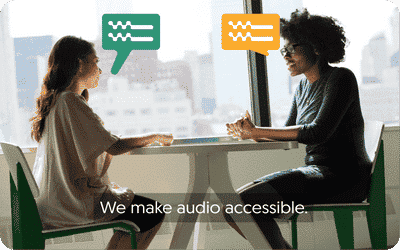
Get a customized offer
Request a quote to translate subtitles
Technical Considerations for Subtitling
The process of subtitling is not simply about translating dialogues, it also involves several technical aspects that contribute to a smooth and meaningful viewing experience. One primary consideration is the timing and synchronization of subtitles. The subtitles should appear and disappear exactly when the respective dialogue is being delivered on-screen, maintaining a rhythm that aligns with the pace of the conversation.
Another important aspect is the length and readability of subtitles. Subtitles should be concise, fitting comfortably within a viewer’s reading speed, while still effectively conveying the essence of the dialogue. Overly long or complex subtitles can be challenging to read in the short time they are displayed, potentially causing viewers to miss crucial moments in the film.
The format and appearance of subtitles also play a crucial role. The font, size, color, and placement of subtitles can affect how easily they are read and understood. The subtitles should be easily distinguishable from the background, ensuring that they stand out clearly on the screen.
The process has never been easier with Amberscript: you can either choose our automatic subtitling services and use the online editor to edit and customize your captions, or you can ask our professional subtitlers to take care of the whole process for you! No matter your needs, Amberscript has a solution for you.
Moreover, the subtitler must bear in mind that subtitles often serve as a means for the hearing impaired to access the film’s content. Therefore, it’s essential to include relevant non-dialogue information in the subtitles, like the description of sound effects or music playing in the background, which can significantly enhance the viewing experience for those viewers.
In sum, technical considerations in subtitling are fundamental to delivering a viewer-friendly, accurate, and engaging cinematic experience. The technical precision of subtitles directly impacts the viewer’s ability to follow and appreciate the narrative, underscoring the necessity for meticulous attention to detail in the process of subtitling.
Subtitling Challenges in a Rapidly Changing Industry
In an industry that is continuously evolving, subtitlers and translators face a number of challenges. With the rise of digital media platforms and the increasing demand for high-quality content, the workload has significantly increased. Tight deadlines and high volume demands make the task of maintaining precision and quality in subtitling even more challenging.
One of the major hurdles is the constant evolution of language itself. New phrases, idioms, and slang are being introduced regularly, and these need to be accurately captured in subtitles to keep pace with the dynamic nature of languages. Similarly, the rise of regional content has brought local dialects and vernaculars to the forefront, adding another level of complexity to the subtitling process.
In addition, cultural sensitivities and regional nuances pose a significant challenge. Ensuring that subtitles do not offend any particular group or culture while maintaining the essence of the original content can be a delicate balancing act. This is particularly pertinent in today’s globalized world, where a film produced in one corner of the globe can be viewed by a diverse, international audience.
Technological advancements too, while offering new tools and functionalities, also bring about their own set of challenges. Subtitlers must constantly upgrade their skills to make use of the latest software and technology, adapting to changes like the rise of AI-powered translation tools and automated subtitling.
In conclusion, while the rapidly changing nature of the film industry offers exciting opportunities, it also presents a host of challenges to subtitlers and translators. Navigating these hurdles requires a blend of linguistic expertise, cultural understanding, technical skills, and adaptability, underlining the importance and complexity of the subtitling profession in the modern film industry.
Maximizing Exposure and Engagement with a Global Audience on YouTube
YouTube is an essential platform for anyone looking to reach a global audience. With its massive user base and powerful video hosting capabilities, YouTube offers countless opportunities for content creators to maximize exposure and engagement with audiences from around the world. However, in order to capitalize on these opportunities, it’s important to understand how best to create engaging content that appeals to a diverse viewership. This article will provide key strategies for understanding your target global audience and optimizing your YouTube channel and videos in order to maximize exposure and engagement with a global audience. By following them, you can ensure your YouTube content reaches the most people and remains engaging for viewers from all around the world. Let’s get started!
Table of contents
- Understanding Your Target Global Audience
- Creating Engaging Content for a Global Audience
- Optimizing YouTube Channel and Videos
- Leveraging Social Media and Cross-Promotion
- Utilizing Localization Strategies
- Engaging with the Global Community
- Building a Global Network
- Tracking and Analyzing Metrics
Understanding Your Target Audience
When it comes to creating a successful YouTube channel, understanding your target audience is essential. Determining who your target audience is will help you tailor content that resonates and engages them with the right messaging.
One way to get an idea of who you should be targeting is by looking at what kind of content already exists on YouTube and which topics are discussed most often in your niche. For example, if you’re creating a fitness-related channel, look for channels that are already successful in the same niche and analyze their videos – which topics are they discussing? What kind of language do they use? Do certain types of videos perform better than others?
You can also conduct market research and surveys to gain insights into your target audience’s needs, interests, and behavior. This will give you valuable information that can help guide your content strategy and ensure that the content you create is tailored to your specific target audience.
By understanding your target audience, you can create content that resonates with them and establish a meaningful connection with viewers. Ultimately, this will help you build an engaged community of followers who are more likely to support your channel in the long-term.
Why you should use Amberscript
Audio transcription has never been this simple. Start now and save hours of time!
Transcribe audio and video to text without errors and receive a perfect export.
GDPR compliant security and safety. Your files are confidentially stored in a secure environment.
Creating Engaging Content for a Global Audience
When creating content for a global audience, it’s important to keep in mind that different cultures have different values and preferences. To ensure you are engaging with an international audience, consider creating content across multiple platforms such as Facebook, Twitter, Instagram and YouTube. Having a presence on these channels will help give your brand more reach and visibility around the world.
When utilizing YouTube as part of your content strategy, make sure to create videos that are tailored to different countries or cultural backgrounds. This could include localized versions of existing videos or even new content created specifically for those audiences. It’s also important to provide subtitles in different languages so all viewers can understand what is being said in each video. Additionally, consider adding localized branding elements to your videos to make them more relatable for viewers in different parts of the world.
Creating engaging content for a global audience does not have to be an intimidating task. By putting in the time and effort to create localized versions of existing content and creating new content specifically tailored for different countries, you can ensure that your brand is reaching a wide range of people around the world. With enough dedication and research, creating successful content for a global audience is definitely achievable!
Optimizing YouTube Channel and Videos
Optimizing your YouTube channel and videos can help you become more successful on the platform. Here are some tips to keep in mind when optimizing your Youtube channel and videos:
- Create compelling titles for your videos – Titles should be descriptive, concise, and catchy to grab viewers’ attention. Use relevant tags and descriptions that resonate with your audience, and include keywords to improve search engine visibility. This optimization helps potential viewers find your content when searching for related topics.
- Use custom thumbnails for each video – Create visually appealing and attention-grabbing thumbnails that accurately represent the content of your videos. Thumbnails serve as a preview and can significantly impact click-through rates. Additionally, create engaging video intros that captivate viewers from the start, encouraging them to watch the entire video and subscribe to your channel.
- Optimize video metadata for search engine optimization (SEO) – Pay attention to the details of your video metadata, including closed captions, transcripts, and subtitles. Subtitling, in particular, is a valuable tool for optimizing your videos. By adding subtitles or closed captions in multiple languages, you enhance accessibility for viewers who are deaf or hard of hearing and cater to a global audience. Additionally, subtitles provide text-based content that can be indexed by search engines, boosting your video’s visibility in search results. You can easily obtain subtitles by using Amberscript’s subtitling services.
Leveraging Social Media and Cross-Promotion
Social media is an essential tool for marketing, as the audiences you reach on these platforms are massive. Utilizing YouTube for example, can help your business gain a huge amount of exposure with videos that are educational or entertaining and related to your brand. Creating a channel allows customers to watch content that will engage them, making it more likely that they will remember your company when they need its services or products.
Cross-promotion is another great way to get the word out about what you’re offering. Finding other businesses with similar markets can open up opportunities for both of you. For instance, if you offer web design services, find a hosting company who would benefit from your services and reach out to them about forming a collaboration. Both of you may be able to gain new customers due to the promotion.
Using social media and cross-promotion are great ways to increase brand awareness and help expand your customer base. Don’t forget to take advantage of these tools while marketing for your business!
Utilizing Localization Strategies
Localization is a great strategy that can help any organization reach more customers in their target market. To make the most out of this strategy, organizations should consider utilizing YouTube as part of their localization efforts. By creating a localized YouTube channel, businesses can create content specifically targeted at audiences in different regions or countries. This localized video content can be used to introduce new products and services, showcase existing offerings, and even respond quickly to customer inquiries. Additionally, localized channels on YouTube allow for companies to personalize messages intended for local markets, making it easier for customers to connect with the brand. Through these localized channels, organizations are able to build relationships with customers across borders while also expanding their global footprint. With the right strategies and resources in place, businesses will be able to make the most out of localization efforts through YouTube.
Utilizing localization on YouTube can come with some challenges, however. Creating localized channels for each target market requires careful planning and resources dedicated towards creating new content for multiple platforms and regions. Additionally, organizations must ensure that their content is culturally appropriate for each given region or country they are targeting in order to ensure success. Moreover, companies should be mindful of any local laws or regulations related to digital media in order to avoid potential legal issues down the line. With these considerations in mind, businesses will be better equipped to leverage localization strategies on YouTube effectively and successfully reach customers across borders.
Engaging with the Global Community
Engaging with the global community goes beyond simply posting content on YouTube. It involves actively fostering interaction and building meaningful connections with your audience. One effective way to do this is by organizing contests and challenges that encourage viewers from different countries to participate. Whether it’s a video submission contest or a creative challenge, these activities create a sense of excitement and involvement, making your audience feel like valued contributors.
In addition to contests, responding to comments and feedback is vital when engaging with your public. Take the time to acknowledge and respond to comments, answer questions and address concerns. This level of interaction demonstrates that you genuinely care about your viewers and their opinions, fostering a sense of community and loyalty.
Live streaming and interactive sessions are powerful tools for engaging with a global audience in real-time. Hosting live Q&A sessions, interactive games, or collaborative projects allows your viewers to directly interact with you and with one another. These sessions create a unique and immersive experience, forging deeper connections and solidifying your presence as an influential content creator.
By actively engaging with your global community, you create an environment that encourages ongoing participation, discussion, and sharing. This not only strengthens the bond between you and your audience but also encourages them to share your content with others, thus increasing your reach and exposure on YouTube.
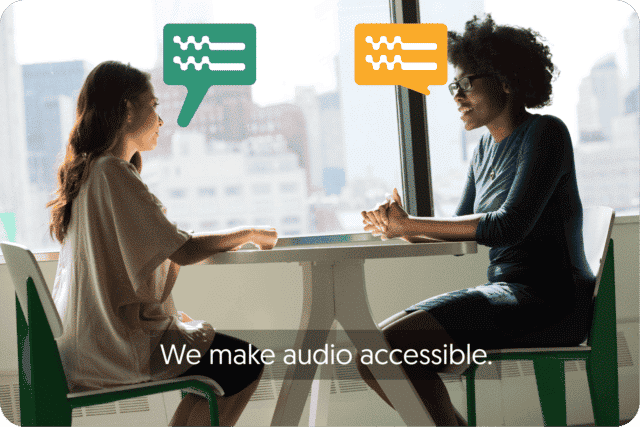
Get a customized offer
Request a quote for your subtitling needs
Building a Global Network
Building a global network is essential for expanding your reach and influence on YouTube. Establishing connections with content creators, influencers, and brands from different countries can help to introduce your videos to new demographics and tap into unexplored markets. Here are few strategies for taking advantage of the international opportunities available to you:
- Attend international events and conferences: Attending international events related to your niche is an effective way of building relationships with content creators, industry professionals, and enthusiasts from all over the world. Participating in workshops, panels discussions, and networking sessions at these gatherings give you the chance to share ideas with people from diverse backgrounds and cultures while learning more about trends and best practices in the industry.
- Collaborate with creators and influencers from different countries: Linking up with content creators in foreign countries enables you to benefit from their influence while introducing your content to their audience. When seeking potential collaborators, look for those who share similar values or interests as yourself as this will allow both parties to get more out of the partnership. You could collaborate on videos, joint projects, or have them appear as guests on your channel – either option provides a great opportunity for exposure and cross-promotion across borders.
- Explore cross-promotional opportunities with global brands: Partnering up with global brands can not only increase visibility but also add credibility to your channel. Make sure that any brand you collaborate with is a good fit for both your own values and those of your target audience. Possible forms of collaboration include sponsored videos or product integrations which can help bring attention from different parts of the world and open doors for future collaborations or sponsorships.
When building a global network, it’s important to approach collaborations with authenticity and mutual benefit in mind. Seek partnerships that align with your values and resonate with your audience, ensuring that any collaborations feel genuine and add value to your content. Building a strong global network not only helps you reach new audiences but also fosters valuable relationships that can enhance your growth and open doors to exciting opportunities in the YouTube community.
Tracking and Analyzing Metrics
Tracking and analyzing metrics is an important part of running a successful YouTube channel. When it comes to YouTube, there are two main categories of metrics: engagement metrics and performance metrics. Engagement metrics measure how viewers interact with your videos, such as the total number of views, likes, comments, shares and watch time. Performance metrics measure how effectively you’re reaching your target audience and driving traffic to your videos, such as impressions, cost per view or click-through rate. By tracking these different types of data points over time, you can determine which strategies are working best for your channel and make adjustments accordingly. Additionally, analyzing these metrics can help you decide what type of content to create in order to maximize viewership potential. Ultimately, understanding and analyzing your channel’s metrics will help you create better videos and maximize success on YouTube.
By tracking and analyzing these metrics, you can make informed decisions about how to optimize your content in order to get more views, likes, shares, and comments. Additionally, it allows you to monitor your progress over time so that you can accurately measure the success of your efforts. It is important to remember that while numbers are helpful tools for measuring results, it isn’t all about the numbers; how viewers engage with your content should be taken into account as well. Taking the time to track and analyze metrics will allow you to identify trends, refine strategies, and ultimately improve the effectiveness of your content on YouTube.
Find out everything you need to know about subtitling for Youtube
Read the blogBy leveraging the power of YouTube, creating an effective channel and uploading interesting content regularly, you can reach a global audience with ease. With the right strategies in place for optimizing your videos to maximize visibility and engagement, it is possible to build a large following on this platform. As long as you are consistent in producing engaging content that resonates with viewers around the world, there’s no reason why you won’t be able to establish yourself as an authority in your niche. So what are you waiting for? Start building your own successful YouTube channel today!
Dubbing vs Subtitles: Are They Both Necessary for Translation?
In an increasingly globalized world, where cultures and languages intermingle, the need for effective audiovisual translation has become paramount. Audiovisual translation (AVT) is the process of taking a source audiovisual text and translating it into another language. There are two main types of AVT, dubbing and subtitles: dubbing is when spoken dialogue is dubbed over in a new language, while subtitles refer to the written on-screen translation of the original dialogue.
The question arises: Are both dubbing and subtitles necessary for translation, or does one method suffice? In this article, we’ll explore both techniques in more detail, and we’ll try to answer that question. Let’s get started.
Table of contents:
- Dubbing: Pros and Cons
- Subtitles: Pros and Cons
- Contextual Factors in Choosing Dubbing or Subtitles
- The Evolution of Translation Techniques
- Finding the Right Balance: Hybrid Approaches
Dubbing: Pros and Cons
Dubbing is the practice of combining audio from the target language with the original visuals, in order to give viewers an immersive experience. This translation method provides several advantages, including:
Enabling viewers to focus on visuals and emotions
With dubbing, viewers no longer need to read subtitles while also paying attention to the visual elements of a film or show. This can allow them to better appreciate the story, as they can focus entirely on the visuals and emotions rather than reading at the same time. This is especially beneficial for individuals who prefer an immersive audio experience or find it challenging to read subtitles quickly.
Enhanced accessibility for viewers who prefer audio over reading
Some viewers have visual impairments or reading difficulties, or maybe they simply find it easier to absorb information when it’s spoken, rather than having to read subtitles. Dubbing can make the content more accessible for these viewers, which could be beneficial in terms of audience engagement.
Enhanced immersive experience
Dubbing can create a more immersive viewing experience for audiences by making them feel like they are part of the story. Voice actors can add emotion and nuance that would not be present with subtitles, allowing viewers to identify strongly with certain characters or situations.
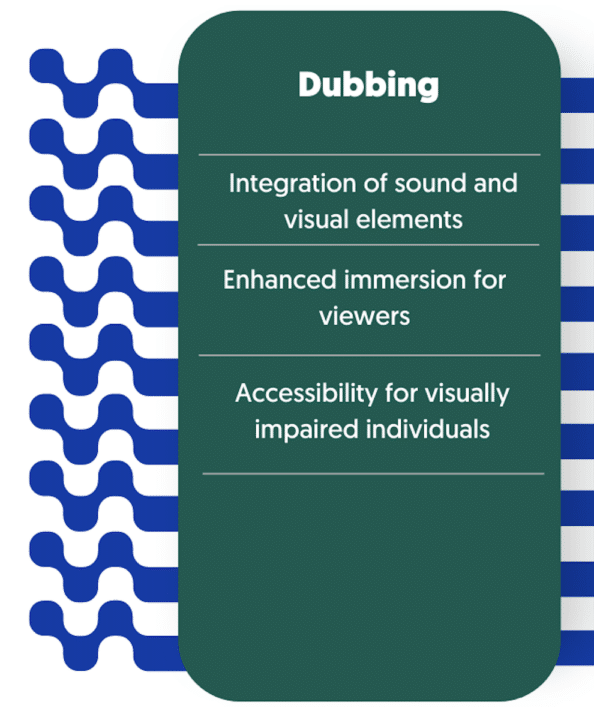
Despite these benefits, dubbing also comes with certain drawbacks. Some of the main concerns are:
Potential loss of original dialogue and cultural nuances
When dubbing is done incorrectly, it can lead to a loss of the original dialogue or cultural nuances present in the original version. It’s important for translators and voice actors to be aware of these aspects when translating so that they are not inadvertently altered.
Challenge of synchronizing lip movements and maintaining authenticity
Dubbing requires careful timing in order to ensure that the lip movements match the audio. Otherwise, viewers may feel disconnected from what’s happening on screen. This makes it difficult to achieve a high degree of authenticity with dubbing unless done very carefully.
Limited availability of voice actors and production costs
Dubbing is often more expensive than subtitles due to its greater level of complexity: hiring professional voice actors, recording studios, and production teams can significantly impact one’s budget. Furthermore, there is a limited pool of voice actors available to dub films and TV shows, which can make it difficult to recreate the original performance.
Overall, dubbing has both advantages and disadvantages that should be taken into consideration when deciding between dubbing or subtitles. It may be beneficial for certain viewers, but not all content may benefit from using this method. Ultimately, the decision will depend on the specific project and budget constraints.

Find out more about our dubbing solutions
Find out moreSubtitles: Pros and Cons
Subtitles, on the other hand, provide a written translation of the dialogue displayed on the screen, allowing audiences in different countries to enjoy a film or show. There are, however, some advantages and disadvantages associated with them. Let’s explore the pros and cons of subtitles.
Preserve the original dialogue and cultural context
The main advantage of using subtitles is that they preserve the original dialogue and cultural context without relying on dubbing actors from another language. This means viewers get to hear the authentic performances, intonations, and voices of the actors, enabling a closer connection to the original production. Subtitles also allow for the inclusion of cultural references, idiomatic expressions, and wordplay that might otherwise be lost in the dubbing process.
Cheaper and faster to produce compared to dubbing
Producing subtitles is cheaper, faster and overall more efficient than hiring a different cast for dubbed versions. Since they involve translating the dialogue and syncing it with the visuals, the overall cost and time required for subtitle production are significantly reduced. This makes subtitles a more accessible option for smaller production studios or independent filmmakers with limited resources.
Enhanced accessibility for hearing impaired individuals
Subtitles provide an additional benefit in terms of accessibility for individuals with hearing impairments. By displaying the translated text on the screen, subtitles enable hearing-impaired viewers to follow the dialogue and fully engage with the content. This inclusivity aspect is a crucial advantage of subtitles, allowing a broader audience to enjoy audiovisual material.
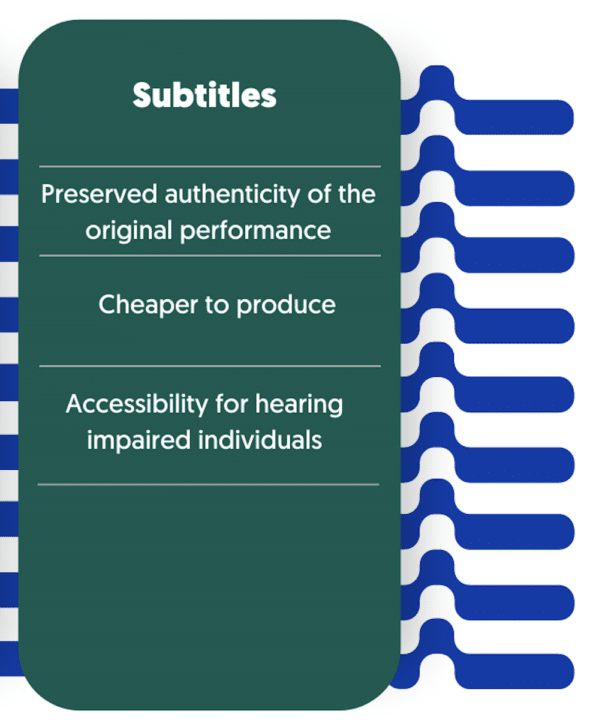
On the other hand, subtitles have some drawbacks as well. Firstly, they require the viewer to read while watching which can be distracting and take away from their visual attention. Secondly, translations can be condensed or simplified for readability which might lead to missing out on nuances in the language. Finally, subtitles may not be accessible to illiterate or visually impaired viewers who cannot follow the text due to a language barrier. Relying solely on written text can exclude certain audiences who may not have access to or benefit from subtitles as a means of translation.
Knowing about the advantages and disadvantages of subtitles is crucial if you’re considering using them when translating your content. In the next sections, we will further explore the contextual factors that influence the choice between dubbing and subtitles and examine the evolving techniques and hybrid approaches in audiovisual translation.
Contextual Factors in Choosing Dubbing or Subtitles
When deciding between dubbing or subtitles for a film, there are several contextual factors to take into account. First, it’s important to analyze the target audience and their preferences. For example, some viewers may have a strong preference for dubbing due to their familiarity with the practice or a preference for an immersive audio experience. Others may prefer subtitles, appreciating the authenticity of the original performances and the opportunity to hear the actors’ voices..
Second, cultural and linguistic aspects of the source material should be taken into consideration. Is the original language likely to be understood by all members of the target audience? If not, dubbing may be necessary in order to make sure everyone can understand what is being said; this is the case with content aimed at younger viewers who may struggle with reading subtitles or for genres where visual elements are more critical than linguistic accuracy. However, certain films or TV shows heavily rely on cultural references, wordplay, or specific dialects, making subtitles a more suitable option for retaining those nuances.
Lastly, practical constraints and budget limitations need to be explored as well. Dubbing requires a substantial investment due to the work required for translation and voice-over artists, recording studios, and post-production facilities, which may not be feasible for smaller productions with limited resources. Ultimately, a combination of dubbing and subtitles may be the best option for reaching the right audience and remaining within budget.
The Evolution of Translation Techniques
Over the years, audiovisual translation techniques have undergone significant evolution, driven by advancements in technology and changing audience preferences. While dubbing and subtitles have been the primary methods, alternative approaches have emerged, making it easier for us to consume and understand global content. From silent movies with intertitles, to post-synchronized dubbing, and now emerging voice-over narration, simultaneous translation techniques, and machine translation powered by AI – the development of these solutions has enabled an unprecedented level of international access to media.
In recent times, new technologies and alternative methods for translating media are emerging:
- Voice-over narration involves adding a narrator’s voice to the original soundtrack, providing a translation alongside the original audio, preserving those nuances that could have been lost through dubbing alone. Voice-over narration can be effective for documentaries, interviews, or other content where maintaining the authenticity of the original voices is crucial.
- Simultaneous translation techniques, often seen in live events or conferences, use natural language processing (NLP) and AI algorithms such as machine translation to produce near real-time interpretations of the audio – making it possible for those who speak different languages to interact without having to switch languages and interrupt the flow of the dialogue.
- Machine translation has seen major advances in recent years. Powered by AI and deep learning algorithms, machine translations are quickly advancing and reaching levels that make it possible to streamline the translation process by automating the generation of subtitles or even providing real-time dubbing. However, challenges remain in achieving linguistic accuracy, maintaining the nuances of the original content, and overcoming the limitations of machine-generated translations.
As we move into a new era of increased global connectivity, the evolution of translation techniques will continue to be a key factor in creating accessible media content worldwide. Hybrid approaches combining dubbing and subtitles are also gaining traction, aiming to strike a balance between the advantages of both techniques.
In the following section, we will explore successful examples of hybrid approaches and delve into the benefits, challenges, and limitations they present in the audiovisual translation landscape.
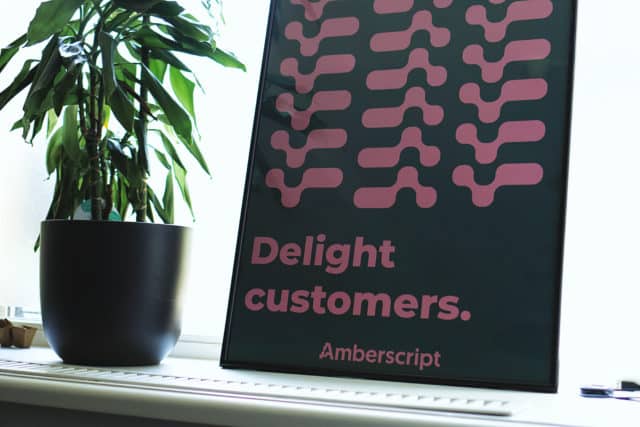
Get a customized offer
Request a quote to translate subtitles
Finding the Right Balance: Hybrid Approaches
Finding the right balance between dubbed versions and subtitled versions of content can be daunting. Fortunately, hybrid approaches to language-customization offer a wide range of solutions for striking that balance.
For example, a film may utilize dubbing for main characters to enhance emotional engagement while using subtitles for background dialogue to maintain linguistic accuracy. Hybrid approaches allow for a tailored translation experience that considers the unique requirements of each project and target audience.
Combining dubbing and subtitles also has many benefits; it allows producers to customize content to target particular audiences, preserve the original audio elements of a production, and create engaging experiences for international viewers. This method also allows for greater flexibility when it comes to language translation; producers can choose different languages in which to dub or subtitle their content.
Despite its benefits, hybrid approaches do have some limitations. It can be difficult to achieve perfect synchronization between the dubbing and subtitles. Additionally, costs may increase due to additional time spent on translations and sync issues that arise from combining dubbing and subtitles. Even with these challenges, however, hybrid approaches offer great potential for customizing content and making it more accessible for global audiences.
In conclusion, it is clear that both dubbing and subtitles have their place in audiovisual translation, and the choice between the two depends on various factors. Considering audience preferences, cultural context, and practical constraints is crucial in determining the most appropriate translation method. Furthermore, as audiovisual translation techniques evolve, hybrid approaches have emerged as a promising solution to merge these two great methods.
Ultimately, the goal of audiovisual translation is to bridge linguistic and cultural gaps, making content accessible and enjoyable for a diverse range of viewers. By carefully weighing the pros and cons of dubbing and subtitles and embracing innovative approaches, we can strive to create more inclusive and engaging audiovisual experiences in an increasingly interconnected world.
Dubbing vs Subtitles: Which Is More Accurate and Efficient?
In the world of film and television, content has long relied on the practice of translating dialogue to reach global audiences, and this is done thanks to dubbing and subtitles. Although both methods serve the purpose of bridging language barriers to allow viewers to understand foreign productions without any difficulty, a debate persists regarding their accuracy and efficiency in conveying the original meaning and maintaining viewer engagement.
This piece explores the debate between dubbing and subtitles, examining their strengths and limitations regarding accuracy and efficiency. We will consider the pros and cons of each technique, as well as their respective roles in the media industry. The discussion will provide a comprehensive overview of dubbing versus subtitles to help viewers make an informed decision about which is more accurate and efficient. Let’s dive in!
Table of contents
- Understanding Dubbing
- Assessing Dubbing’s Accuracy
- Exploring Subtitles
- Analyzing Subtitles’ Accuracy
- Comparing Accuracy and Efficiency
Understanding Dubbing
Dubbing is a technique in audiovisual translation where the original dialogue of a film or television show is replaced with translated dialogue recorded in a different language. It’s commonly used to make content more accessible for viewers who don’t understand the original language. This is an alternative to subtitles, which involve overlaying text on the bottom of a video.
The dubbing process involves several steps: first the script needs to be adapted to the target language, and then you need to find voice actors who can match the tone and emotion of the original dialogue, as well as finding appropriate timings for lines so that they fit seamlessly into visuals. After the dialogue has been recorded and the dubbed audio mixed and integrated into the original audiovisuals, you obtain a localized content with a professional touch that engages audiences from different backgrounds and cultures.
Advantages of Dubbing
There are several advantages to dubbing over subtitling, including:
- Providing viewers with a seamless viewing experience, without any distractions from text at the bottom of the screen. The synchronization of the translated dialogue with the characters’ lip movements enhances the sense of realism, making it easier for the audience to immerse themselves in the story and connect with the characters.
- Making content accessible for non-readers and people with visual impairments, who can benefit from audio cues instead of text. By providing a complete audio translation, dubbing ensures that these audiences can fully engage with the content without relying on visual cues.
- Enabling producers to capture regional nuances that may be lost with subtitles and adapt the dialogue to reflect cultural nuances, accents, and expressions of the target language, allowing content creators to engage their local audiences more effectively.
Assessing Dubbing’s Accuracy
Assessing the accuracy of dubbing is essential in ensuring that viewers are able to get the most out of their movie-watching experience. While more straightforward than subtitles, dubbing still faces its own set of challenges and limitations that can affect its accuracy in conveying the original meaning.
- Lip-syncing Issues and Mismatched Dialogue: Lip-syncing issues can arise due to differences between languages which makes it difficult to synchronize the translated dialogue with lip movements. The necessity to match the timing and rhythm of the original dialogue can sometimes result in slight alterations or compromises in the translation, potentially affecting the accuracy of the conveyed message. This also includes dialogues feeling out of place or having mismatched timing.
- Difficulty Preserving the Original Tone and Emotions: One big challenge of dubbing is maintaining the intended tone, emotions, and nuances of the original performances in the translations. Voice actors must effectively capture the essence of the characters and deliver their lines with the appropriate emotional range, ensuring the audience receives a faithful representation of the original intent.
Evaluating dubbing for its effectiveness in conveying the original meaning includes assessing how well voice actors have been able to capture the essence of characters through their performance as well as examining the quality of the translated scripts used in dubbing. To ensure the correct portrayal of the nuances of the languages, some dubbing studios employed voice actors who are familiar with both languages. Furthermore, a good translation of the script, that takes into account cultural references and idioms, is also necessary to ensure that viewers are not missing out on any underlying messages within films.
Considering these factors, the accuracy of dubbing ultimately hinges on the expertise of the voice actors, the quality of the translated script, and the attention to detail in achieving synchronization. By carefully addressing these challenges and maintaining high standards, dubbing can successfully convey the original meaning and allow viewers to connect with the content on a deeper level.

Find out more about our dubbing solutions
Find out moreExploring Subtitles
Subtitles are an integral part of the film and television industry, allowing for cross-language understanding without changing the original content. Subtitles are a textual translation of a narration displayed on screen while the original audio is retained. They are typically placed at the bottom of the screen and synchronized with the timing of the spoken words. Subtitles can be either burned into the video or provided as separate files, allowing viewers to enable or disable them as needed.
Advantages of Subtitles
Alongside dubbing, subtitles are one of the most common methods when it comes to translating content for foreign audiences. Their popularity is well understood when looking at the several advantages they offer:
- Subtitles provide a direct translation of the dialogue that does not alter the original audio track. This allows to preserve the original content, giving viewers the possibility to understand what is being said without losing the authenticity of the speakers’ performances and nuances such as tone, accent, or emotion.
- Subtitles help maintain authenticity and cultural context to the original content, as it doesn’t change the way the actors’ originally spoke. This enables a more accurate representation of the original work, making subtitles an ideal choice for international distribution of film and television, since the viewer can grasp the linguistic and cultural references embedded in the original dialogue without alterations.
These advantages make subtitles more favored than dubbing in many cases, allowing viewers around the world to understand a story without changing its essence. Subtitles are also preferred when dubbed versions can be difficult to find or produce, as is often the case with independent films and foreign-language TV shows.
Analyzing Subtitles’ Accuracy
Subtitles too can present certain challenges that must be addressed in order to ensure the accuracy of their translations.
- Limited screen space and time constraints: These constraints mean that subtitlers must fit their translations within a short amount of time, which can limit their ability to translate nuanced phrases or cultural specific references accurately.
- Some idioms or puns may require more than a concise translation: Some elements of language (wordplay, culturally specific references, idiomatic expressions) need a longer explanation than what is provided by subtitles, making them difficult to convey fully in another language.
To assess the effectiveness of subtitles in conveying the original meaning, one must examine both the translation quality and accuracy, as well as the readability, timing, and placement of subtitles. For instance, instead of finding a suitable equivalent in the target language, some subtitlers may use words that are overly literal when translating a phrase, which can lead to confusion or misinterpretation. Additionally, making sure that subtitles appear at the right time, without covering important visuals and remain on screen for an appropriate amount of time is essential to allowing viewers to understand them fully.

Get a customized offer
Request a quote to translate subtitles
Comparing Accuracy and Efficiency
When it comes to accuracy and efficiency, both dubbing and subtitles aim to achieve accuracy in conveying the original meaning, at different levels, while also being as efficient as possible.
- Dubbing provides greater linguistic and cultural accuracy when compared to subtitles as it offers a translation that often matches the original dialogue. Furthermore, dubbing has been shown to have a more positive impact on viewers’ understanding and immersion thanks to its focus on providing a seamless audiovisual experience, in comparison to subtitles, which can be distracting and hard to follow for some audiences. In terms of efficiency, dubbing involves multiple steps, such as script adaptation, voice recording, and audio integration, making it a time-consuming and costly process.
- Subtitles, on the other hand, are beneficial for accuracy for allowing viewers to hear the original audio. As far as efficiency is concerned, they are generally seen as a faster option due to their ease of implementation. Additionally, subtitles tend to require lower production costs than dubbing since the process involves less effort and technical resources.
However, research has indicated that accuracy and efficiency levels depend greatly on the audience preferences, which can vary greatly depending on language and culture. While some viewers may prefer dubbing, others may favor subtitles. Considering audience expectations can help determine the most efficient method for reaching and engaging the target audience.
Overall, the choice of which method to use ultimately depends on context and desired outcomes. When accuracy is paramount, dubbing is preferable; however, for greater efficiency, subtitles can be a better option. Ultimately, a careful assessment of each approach should be undertaken in order to make an informed decision that suits your needs.

In conclusion, dubbing and subtitles are two key methods of translation that have been used to bridge the language gap between countries. Dubbing is an expensive process but provides a more realistic viewing experience as it allows for lip syncing and character voice continuity. Subtitles, on the other hand, are much cheaper than dubbing and can be used to quickly translate programs into multiple languages with accuracy. Ultimately, both methods have their advantages and disadvantages, so there is no one-size-fits-all solution when it comes to translating entertainment for global audiences.
As technological advancements in translation technology continue to improve, we may see further developments in both dubbing and subtitling techniques that could provide even greater accuracy and efficiency for providing international audiences with high-quality translations.
Ultimately, the importance of providing quality translations for global viewers should not be overlooked. In an increasingly connected world, it is essential to provide entertainment that is accessible and understandable to all viewers regardless of language barrier. With dubbing and subtitling, we can bridge the gap between countries and cultures, allowing us to enjoy a truly universal entertainment experience.
Dubbing vs Subtitling: Which one is Best for Movies and TV Shows?
Are you a movie buff or TV show enthusiast? Have you ever wondered why movies and TV shows are watched in different languages? The answer lies in the concept of localization, which is the process of adapting content into specific languages and cultures. This article delves into two important aspects of localization: dubbing and subtitles. It will explore their pros and cons to help you decide which one is best for your viewing pleasure. Both techniques have their merits and drawbacks, raising the age-old question: Which one is best for movies and TV shows?
Table of Contents
- What is Dubbing?
- Advantages of Dubbing
- Disadvantages of Dubbing
- What are Subtitles?
- Advantages of Subtitles
- Disadvantages of Subtitles
- What to consider when comparing dubbing and subtitles
What is Dubbing?
Dubbing is the process of replacing an original dialogue of a movie or TV show with a different translated version. It allows viewers to watch content in their native language and hear the voices of familiar actors. It involves recording new dialogue and synchronizing it with the lip movements of the actors on screen. Dubbing is often used when distributing films or television series internationally, as it eliminates the need for subtitles that may be difficult to read or understand.
The dubbing process typically begins by selecting voice actors who perform their lines according to edited dialogue transcriptions; the process requires skilled voice actors who can effectively convey the emotions and nuances of the original performances. Then, sound engineers mix these performances with music, sound effects, and other audio elements to create a seamless audiovisual experience. This process can also involve lip synchronization so that the dubbed audio matches the existing visuals on screen.
Advantages of Dubbing
Dubbing has many advantages when translating a movie. Here are some examples:
- Seamless integration of voices with visuals: Dubbing allows for a seamless integration of voices, making it feel as if the characters are speaking the viewer’s language. This can enhance the immersion and emotional connection with the story.
- Enhanced immersion for viewers: By eliminating the need to read subtitles, dubbing allows viewers to fully focus on the visual aspects of the movie or TV show, capturing their attention and preventing potential distractions.
- Accessibility for non-readers or visually impaired individuals: Dubbing provides accessibility for those who may have difficulty reading subtitles, such as non-readers or visually impaired individuals, allowing them to fully engage with the content.
Disadvantages of Dubbing
However, despite the many benefits, there are also drawbacks to dubbing that should be considered as well:
- Potential loss of original performances and cultural nuances: Dubbing requires translation and adaptation of the original script, which can sometimes result in the loss of the nuances and cultural context that are unique to the language version originally produced. It may also alter the delivery and tone of the performances.
- Challenges with lip synchronization and voice acting quality: Achieving accurate lip synchronization is difficult and in some cases it may result in unnatural audio/visual pairing, with the dubbed voices not perfectly matching the actors’ lip movements. Additionally, the quality of voice acting is often inconsistent, which can affect the overall experience. Luckily, Amberscript can help voice actors solve this issue by providing transcription services. Having a transcription of the dialogue would help the actors familiarize themselves with the text, while also improving their timing and delivery thanks to features such as timestamps.
- Limited availability of languages for dubbing: Dubbing requires significant resources and expertise, which limits the number of languages available for dubbing compared to subtitles, which instead can be used with any language. This can pose a challenge for viewers who prefer watching content in less commonly spoken languages.
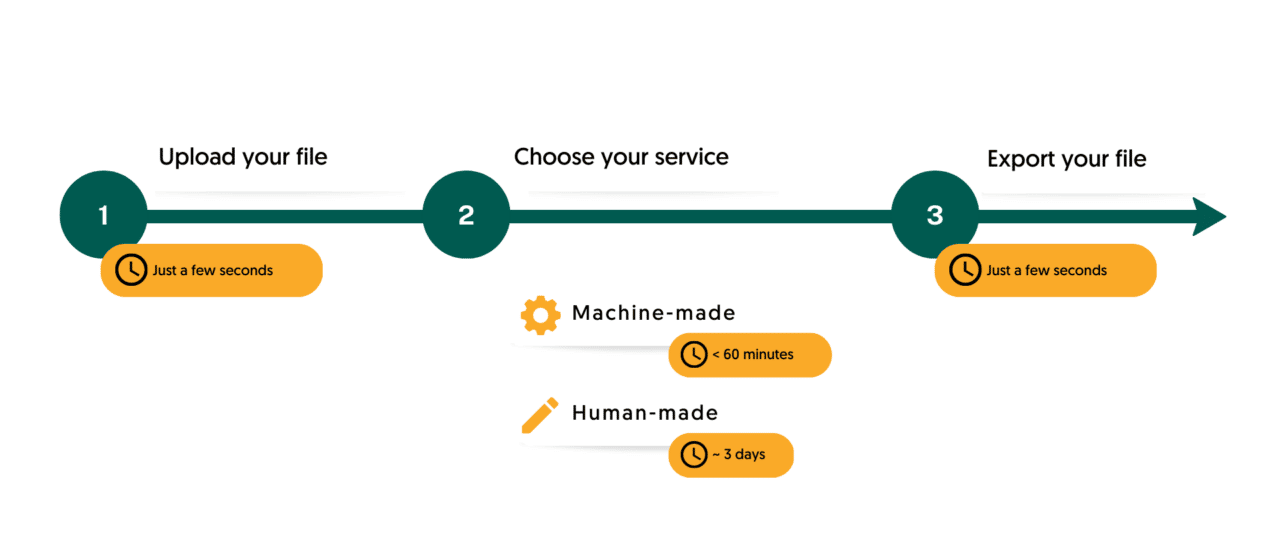
Overall, dubbing offers an alternative solution for audiences who do not understand or prefer subtitles. For this reason, it remains a popular method for international film and television distribution. It can be used to bridge cultural gaps and provide a more immersive viewing experience, but it also has drawbacks that should be considered before its implementation.

Find out more about our dubbing solutions
Find out moreWhat are Subtitles?
Subtitles are written words that appear on the screen to aid in the translation of a dialogue or Narrator’s voice, typically used to translate foreign language films; these textual translations of the dialogue are displayed at the bottom of the screen while the original audio remains intact. For this reason, some believe this method to be more advantageous than dubbing, which involves replacing the original audio with a new one in another language. Subtitles come in two main varieties – open and closed. Open subtitles can be viewed by all individuals regardless if they want them or not, while closed subtitles offer viewers an option to turn it on or off.
Advantages of subtitles
The benefits of using subtitles far outweigh the disadvantages. Some of these advantages are:
- Preserving the authenticity of the original language: Subtitles retain the original language, allowing viewers to experience the performances, accents, and emotions as intended by the creators, which often add to the charm and humor of the viewing experience. The audience then does not miss out on any authenticity and cultural nuances that would otherwise be lost through dubbing.
- Enhanced accessibility for hearing impaired individuals: Subtitles provide an essential means of accessibility for individuals with hearing impairments. By displaying the dialogue as text, those who are deaf or hard of hearing can fully understand and engage with the content.
- Offering a learning opportunity for language acquisition: Subtitles can be valuable for language learners, as through passive exposure they provide an opportunity to associate written words with spoken language, aiding in vocabulary acquisition and comprehension.
Disadvantages of subtitles
Although subtitles offer many advantages, there are also some potential drawbacks.
- Diverted attention from visuals to reading: Reading subtitles requires constant attention, which can divert the viewer’s focus from the visual aspects of the movie or TV show. This may result in missing out on both subtle details in the cinematography and key visual elements in the scene.
- Potential inaccuracies in translation and timing: Translation accuracy may be lower with subtitles than dubbing due to time constraints or translation errors. Translating dialogue into subtitles requires condensing the information while preserving its meaning; this can lead to potential inaccuracies or simplifications in translation. Additionally, timing issues may occur if the subtitles do not match the pace of the dialogue.
- Exclusion of non-readers or visually impaired individuals: Non-readers or those with vision problems will not be able to benefit from this method of interpreting dialogue, as subtitles heavily rely on reading skills. This might exclude non-readers or visually impaired individuals from fully accessing and enjoying the content.
Overall, subtitles provide convenience and authenticity that allow viewers to experience a film in its original language. Subtitles are an invaluable tool for those who wish to learn new languages by watching films, and they preserve the original performance of actors. While there are some potential disadvantages, they do not outweigh the advantages of subtitles.

Get a customized offer
Request a quote to translate subtitles
Factors to consider when comparing dubbing and subtitles
When producing content for an international audience, there are a few factors to consider. Firstly, cultural and regional preferences should be taken into account – different countries might have different language preferences when it comes to films or TV shows. Some audiences prefer subtitles while other regions have a long-standing tradition of dubbing – keeping these preferences in mind can help you create content that appeals more effectively to target audiences.
Secondly, the target audience’s language proficiency should also be considered when deciding whether to use subtitles or dubbing. Viewers who are fluent in the original language may prefer subtitles to maintain the integrity of the performances, while those with limited language proficiency might find dubbing more accessible and immersive.
Thirdly, genre-specific considerations should also be taken into account. For example, in animated films, dubbing can be more easily accepted since the visuals are not directly tied to real actors’ lip movements. On the other hand, films that rely heavily on dialogue – such as romantic comedies or dramas – may benefit from using subtitles, so they can better convey the emotion and intensity of the scenes.
Finally, practical constraints such as production costs and time should also not be forgotten. Dubbing can require more resources than subtitling, such as including talented voice actors, sound studios, and production time, and if there are tight deadlines then it may not be feasible to include both. Subtitling, while still requiring translation expertise, may be a more cost-effective and time-efficient option. Amberscript is an example of a fast and efficient subtitling service that can help you obtain high quality translated subtitles for a reasonable price.
Consider all these factors when deciding between subtitles and dubbing for your content.
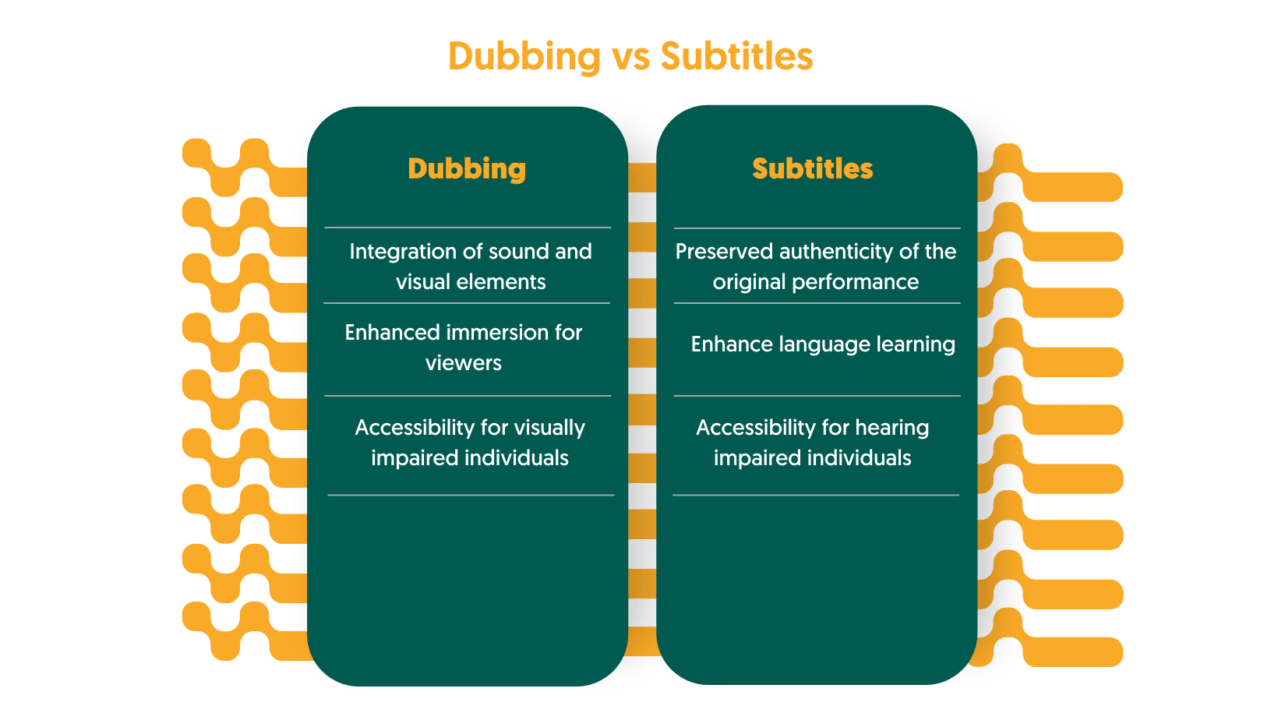
In conclusion, both dubbing and subtitles have their advantages and disadvantages. Ultimately, choosing which method is best for a particular type of content depends largely on individual preferences. As content creators, it’s important to maintain the artistic integrity of the original work while also considering accessibility and audience preferences. Where feasible, providing both options can help broaden the reach of your content.
By understanding how these two methods compare, you’ll be better equipped to make informed decisions when it comes to localizing your project for different audiences. Regardless of what choice you make, selecting the right option will ensure that your message reaches more people in a way that resonates with them.
All in all, dubbing and subtitling provide powerful tools to help you communicate your story and share it with the world. With careful consideration and thought, you can ensure that your message is heard loud and clear!
The benefits of subtitling for Law
The importance of effective communication in legal proceedings
In the legal industry, having clear and accurate communication is paramount to success. Whether it’s in a courtroom, deposition, or with clients, being able to understand all parties involved goes a long way in achieving justice. Subtitling is an important tool that can help ensure everyone involved is on the same page with any legal proceedings. It provides an added layer of clarity and understanding regarding any complicated documents or conversations related to the law.
Table of contents
- Subtitling in the Context of Law
- Enhanced Accessibility
- Improved Understanding and Comprehension
- Using subtitles to facilitate Language Learning
- Supporting Multilingual Proceedings
- Enhanced Memorization and Retention
- Facilitating Legal Research and Analysis
- Ensuring Accuracy and Clarity
Subtitling in the Context of Law
Subtitles are critical tools for anyone working in the legal industry who needs to understand complex conversations or read through lengthy documents in a short amount of time. In addition, subtitles are particularly useful for people who are hearing-impaired or have difficulty understanding spoken language due to language barriers. By providing subtitles for court hearings and other legal proceedings, it allows these individuals to still be able to comprehend what’s going on so they can make informed decisions.
Let’s see some examples of how subtitles can be helpful in a legal context:
Subtitling for Lawyers
Subtitles allow lawyers to review and analyze court proceedings, depositions, and witness testimonies more efficiently by providing a written record that can be easily referenced and quoted. Subtitled legal content, such as educational videos or webinars, assists lawyers in improving their knowledge and understanding of specific areas of law. Subtitles can aid lawyers in comprehending legal content in foreign languages, ensuring accurate interpretation and understanding.
Subtitling for Judges
Subtitles can be used during live court sessions to assist judges in understanding spoken content, especially in cases involving individuals with heavy accents or when audio quality is poor. Subtitling helps in creating accurate and detailed transcripts of court proceedings, making it easier for judges to review and reference specific parts of the proceedings. Subtitles promote accessibility for individuals with hearing impairments, ensuring their participation in the legal process.
Subtitling for Reporters and Journalists
Subtitles enable reporters and journalists to accurately quote and report on court hearings and legal events, ensuring the precision of the information provided to the public. Subtitles aid reporters and journalists in understanding legal content in different languages, facilitating accurate reporting on international legal matters. By incorporating subtitles into news broadcasts and online videos related to legal matters, reporters and journalists can make their content accessible to individuals with hearing impairments.
Subtitling for Law Enforcement
Subtitles can be used to create accurate transcripts of interviews and interrogations, ensuring a detailed record of the proceedings for investigative purposes. Subtitled training videos and educational materials assist law enforcement personnel in understanding legal procedures, improving their communication skills, and enhancing their knowledge of applicable laws. Subtitles aid law enforcement officers in communicating effectively with individuals who speak different languages, promoting understanding and compliance during interactions.
These are just a few examples of how subtitling can be beneficial in the context of law, as the versatility of subtitling extends to various legal scenarios. A valuable software that can help you get started with subtitling is Amberscript. Not only it is extremely easy to use, but it also offers different services based on your needs: whether you decide to let the software automatically create the subtitles or you prefer to have professional subtitlers handle your file, Amberscript has got you covered.

Enhanced accessibility
Enhanced accessibility has become an important factor in many industries, and the legal sector is no exception. By providing enhanced accessibility options, more people are able to gain access to the justice system – regardless of their physical abilities or linguistic backgrounds. With the help of these tools, legal providers are able to guarantee a more equitable system for everyone.
In an effort to become more accessible, many legal providers have begun taking advantage of current technology in order to provide enhanced accessibility options. Some examples are:
Accessibility for people with hearing impairments: Subtitling provides accessibility for people with hearing impairments, allowing them to follow and understand spoken content through written text. This ensures that individuals who are deaf or hard of hearing can better understand complex legal concepts, actively participate in legal proceedings and access legal information without relying on others.
Inclusivity for individuals with language barriers: By providing translated subtitles, this type of technology can also help to ensure accurate translations of legal documentation into multiple languages and help those who may not be fluent in a particular language better understand the law. Amberscript can help you translate your subtitles fast and accurately in 18 different languages.
Compliance with legal requirements for accessibility
Subtitling is not only helpful in enhancing accessibility, but it can also help your organization meet legal requirements for accessibility, such as subtitles for video and audio content. It also helps ensure that your documents comply with laws mandating the use of accessible formats. The Americans with Disabilities Act (ADA) in the United States, and the General Data Protection Regulation (GDPR) in the European Union are only two examples of such regulations.
All of this ultimately helps your business stay compliant with the latest rules on web accessibility and disability rights. With enhanced accessibility, you can make sure you’re meeting all applicable legal requirements and providing a great user experience at the same time!
Improved understanding and comprehension
Subtitles provide an invaluable service for everyone involved in the courtroom by enhancing comprehension and clarity of legal terminology. They also help bridge any gap between native speakers, non-native speakers, or those with hearing impairments by creating a more inclusive environment. With this technology, understanding complex legal concepts can become much simpler and easier to comprehend.
To better understand complex legal terminology, subtitles can be added to help explain the meaning of words or phrases that might otherwise go over some people’s heads. This makes it easier for viewers to comprehend fast-paced legal proceedings and documentation. Those who are not native speakers of a language can use subtitles to gain greater understanding of the legal content being presented. Subtitles have great potential to improve access to justice for non-native speakers and people with hearing impairments. This technology is beneficial both inside and outside of courtrooms as it provides a tool to make complex legal proceedings easier to understand.

Get a customized offer
Request a quote to translate subtitles
Using subtitles to facilitate language learning
Subtitles are one of the most effective ways to facilitate language learning in legal contexts. By including subtitles in documents and audiovisual materials, users can read along with the material while hearing it spoken aloud at the same time. This dual-mode approach allows students to become better familiarized with legal terminology and apply it more easily when writing or speaking. Furthermore, subtitles can be used as an additional tool for transcription, helping learners identify words they don’t know within a particular context and further reinforcing their understanding of the language.
Exposure to legal terminology and terminology consistency
By utilizing subtitles, users can gain a greater exposure to legal terminology. If the subtitles are properly formatted and consistent in their language use, learners can more easily recognize and remember key phrases. This will not only improve comprehension but also help them build up a larger legal vocabulary which they can apply in their own conversations and readings.
Reinforcing language skills through audiovisual materials
Subtitles are also invaluable tools for reinforcing language skills through audiovisual materials. By reading along with dialogue or listening to lectures while watching the visuals, students can take full advantage of the audio-visual combination to further develop their understanding of legal discourse and deepen their knowledge of the language. Furthermore, subtitles can also be used as an aid tool when it comes to practicing and learning legal language, as they allow users to review and revise more easily, thus speeding up their mastery of the language.
Supporting multilingual proceedings
Amongst the many benefits that subtitling provides in legal contexts, supporting multilingual proceedings is one of the most important. Here’s how subtitles can help:
Facilitating communication in international legal cases: In international legal cases, accurate and reliable communication is essential for a successful outcome. To ensure the highest quality of services in multilingual proceedings, subtitles are often used to facilitate understanding between all parties involved. Subtitles allow people with different native languages to understand what’s said in court without having to use a human interpreter.
Minimizing interpretation errors and miscommunication: Interpretation errors and miscommunication can have significant repercussions in legal proceedings, especially when parties don’t share a common language. By using subtitling, the risk of interpretation errors is significantly reduced. Subtitles provide a written representation of the spoken content, offering a clear and consistent understanding of the proceedings. This minimizes the potential for miscommunication, ensuring that legal information is accurately conveyed to all participants, regardless of their language proficiency.
Strengthening cross-border legal cooperation and understanding: Subtitling contributes to stronger cross-border legal cooperation and understanding by fostering inclusive and accessible communication. When participants can follow the proceedings in their native language through subtitles, they feel more engaged and empowered to actively participate in the legal process. This promotes equal representation and a sense of fairness, ultimately strengthening cross-border cooperation and fostering a deeper understanding of different legal systems and practices.
Enhanced memorisation and retention
Enhanced memorization and retention are significant advantages of incorporating subtitling in the context of law. Subtitles provide visual reinforcement of the spoken content which, paired with auditory stimuli, engages dual audiovisual processing. This is particularly beneficial for legal professionals and students who are exposed to vast amounts of complex information. Subtitles allow them to reinforce their understanding of legal terminology, retain key details from legal proceedings, and improve overall information retention.
Visual reinforcement of spoken content
One key aspect of enhanced memorization and retention is the visual reinforcement of spoken content. By presenting the spoken words in written form on the screen, subtitling helps reinforce understanding and retention. In a study conducted at the University of California, Los Angeles (UCLA), legal professionals and students experienced improved memorization and retention when engaging in dual audiovisual processing — listening to audio content with subtitles. This finding suggests that the visual cues provided by subtitles serve as a valuable aid in the learning process, as they improve memorization and comprehension of legal documentation, enabling individuals to absorb and recall crucial legal concepts more effectively.
Cognitive benefits of dual audiovisual processing
The cognitive benefits of dual audiovisual processing, which is facilitated by subtitling, can have a positive impact on learning, comprehension, and memory retention. When auditory information is complemented by visual text in the form of subtitles, it stimulates multiple sensory channels simultaneously, leading to heightened engagement and sustained focus on the content being presented. Research has shown that the simultaneous engagement of multiple sensory modalities enhances memory consolidation by creating stronger associations and connections in the brain.
Increased information retention for legal professionals and students
For legal professionals, having access to audiovisual content with subtitles can help them stay up-to-date on the latest developments in their field, as well as provide a way to quickly review complex topics or cases. Additionally, students of law can benefit greatly from dual audiovisual processing as they are tasked with learning large volumes of information that must be remembered for tests and exams. With both audio and visual cues present, users have a much higher likelihood of retaining the material over time.
Facilitating legal research and analysis
Improved searchability and indexing of legal content
Having the right technology can help legal professionals and researchers easily access, search, and analyze different types of information. Improved searchability and indexing make it easier to locate relevant documents quickly, while efficient review of video or audio evidence can be done with the help of subtitles or transcription services.
Automated document search and indexing technologies enable users to quickly find what they need without having to spend hours combing through endless paperwork. Subtitling is also a great way to archive legal footage and make it easily accessible for future reference. By adding subtitles to archived video content, users can quickly locate relevant information without having to watch an entire video from start to finish.
Efficient review of video or audio services
Legal professionals can benefit from transcription services that allow them to easily review audio or video evidence with accurate subtitles. The data collected by these tools can also be used for analytics purposes, providing insights into trends in the industry—which can then be applied to make strategic decisions about client cases.
Assisting researchers and legal professionals in extracting information
In the past, extracting information from legal documents was a lengthy and arduous task. With AI-powered tools, this process is now much faster and more efficient. By utilizing natural language processing (NLP) tools, legal researchers can extract pertinent facts from complex legal documentation faster than ever before. With AI-assisted technologies at their disposal, users are able to save time locating information in order to focus on higher level tasks such as strategy development and assessment of case merits. Ultimately, these advances in legal research and analysis streamline processes for law firms and lawyers alike—allowing them to better serve their clients and increase productivity.
Benefits of using Amberscript
Amberscript’s services are:
Edit your text in minutes or leave the work to our experienced subtitlers.
Our experienced subtitlers, voice actors and thorough quality controls ensure 100% accuracy of transcripts, subtitles and dubbing services.
Through a series of integrations and API interfaces, you can fully automate your workflows.
Your data is in safe hands. We are GDPR compliant + ISO27001 and ISO9001 certified.
Ensuring accuracy and clarity
Quality control through professional subtitling services
When it comes to ensuring accuracy and clarity in legal communication, quality control is essential. Professional subtitling services are a great way to ensure that the content of legal documents is accurately portrayed. Subtitles should not only be easy to read and comprehend, but should also reflect the tone and intent of the original document in order to ensure accuracy of information. For this reason, Amberscript offers a manual subtitling service: the professional subtitlers will make sure that your file is as accurate as possible, and will make sure everything is of the highest quality; you only have to upload your file.
Reducing misinterpretation and ambiguity in legal communication
When communicating legally-binding language or technical terminology, misinterpretation and ambiguity can lead to costly mistakes. To reduce this risk, all parties involved must pay attention to detail throughout the process. This means double checking transcripts for typos or errors before signing or submitting the document. Additionally, using transcription services can help ensure that all relevant information is captured, and that any errors are caught before it’s too late.
It is clear that subtitling has a great deal to offer the legal profession, from facilitating legal language learning to enhancing comprehension by providing a dual-mode approach and granting greater access to legal terminology. To make the most of these benefits, organizations can leverage advanced subtitling solutions like Amberscript. Amberscript’s cutting-edge technology and expertise in subtitling enable accurate and efficient conversion of spoken content into written subtitles, bolstering the effectiveness of multilingual proceedings and supporting a more accessible and inclusive legal environment. With Amberscript’s assistance, the advantages of subtitling can be harnessed to their fullest potential, revolutionizing the way we approach multilingual proceedings in the field of law.
Frequently asked questions
-
Are you ISO27001 certified or do you have any other ISO certifications?
Amberscript’s IT infrastructure is built on data-servers provided by Google Cloud Platform, which are certified to the highest standards (including ISO27001). Amberscript as a company is also ISO27001 certified and has relevant processes in place to assure quality management and integrity of data.
-
How can I deliver large and/or multiple confidential files?
You can share it though our platform. We have developed a secure internal platform to share transcripts that need to be corrected or checked by our transcribers. The files will therefore only be seen by relevant third-parties and cannot be accessed by employees or third-parties.
-
Can I burn the subtitles directly onto my video?
If you have exported the transcript as a SRT, EBU-STL or VTT file, you can easily burn them onto your video using video-editing software.
-
Do you offer services in other languages?
For our human-made subtitling services we work with a network of language experts in 15 different languages. Find out which here. If the language you want is not on the list, please contact us through our contact form.
-
How do I export my subtitles?
Once your file is ready and available in your account, you can simply click on the file name and then select the “export file” button at the top left of the page. You can then select the file format, style of sutitles (between BBC and Netflix) and alignment. Please note that you can only export a file if you have validated your email address when creating an account.
-
How do you keep my files secure and confidential?
Amberscript’s IT infrastructure is built on the server infrastructure of Amazon Web Services located in Frankfurt, Germany. All data that is processed by Amberscript will be stored and processed on highly secured servers with regular back-ups on the same infrastructure.
-
To which languages can you translate subtitles?
For our human-made subtitling services we work with a network of language experts in 15 different languages. Find out which here. If the language you want is not on the list, please contact us through our contact form.
-
What is the turnaround time?
The standard deliver time is up to 5 business days. You will also have the option to ask for a rush order. We will then prioritize your file and deliver up to 4 times as fast.
-
Will different speakers be distinguished?
Yes, our software indicates different speakers and when the speaker changes.
-
What subtitle file formats are supported?
Our software allows you to export the transcript from the video or audio file as an SRT, EBU-STL or VTT file.
Subtitling as a valuable tool to access legal information
Subtitling for Law and its role in enhancing accessibility
Access to legal information is a fundamental right that empowers individuals to understand their rights, navigate the legal system, and ensure justice. However, the complexity of legal language poses a significant barrier for many people, especially those with hearing impairments or limited proficiency in the language of the legal content. In such a context, subtitling emerges as a powerful solution to bridge the accessibility gap and facilitate equal access to legal information.
Why is it important for everyone to have access to legal information?
Subtitling not only enhances access to legal information but also provides other benefits, such as improving comprehension and retention of material. It can enable individuals to read along while they watch a video, which can significantly increase their learning potential. This can be especially beneficial for people with disabilities who may struggle with auditory processing or need more time to retain information.
Table of contents
- The Challenge of accessing legal information
- Subtitling as an effective solution for Accessing Legal information
- Legal requirements and Subtitling
- Challenges and solutions in subtitling legal content
- Impacts and Future Directions

The challenge of accessing legal information
Accessing legal information can be a challenge for many people. Traditional methods of accessing legal information, such as written documents and court proceedings, may not provide the best experience or understanding for people with hearing impairments or language barriers, as they can be difficult to comprehend, even for those without these challenges. Luckily, subtitling has become an important tool in the field, making it easier to overcome the barrier that is complex legal language, so that people can understand and benefit from it.
Complexity of legal language and its barriers to comprehension
The complexity of legal language presents an additional obstacle to comprehension, and traditional methods of accessing legal information such as written documents, court proceedings and the like may not be suitable in all cases.
Fortunately, there is now a valuable tool available that can help tackle these challenges: subtitling. Subtitles provide an accessible way to understand audio information quickly and accurately. By providing written versions of words spoken in video recordings, subtitles improve the accessibility of audio-visual content to non-native speakers and deaf or hard-of-hearing individuals. With subtitles, individuals can connect to court proceedings without missing crucial details that may arise in verbal arguments. In such cases, subtitles allow those with disabilities or language barriers access to the same level of information as their counterparts.
Limitations of these methods
For individuals with either of these challenges, traditional methods of accessing legal information can present a significant barrier. Subtitles are an incredibly valuable resource in removing this obstacle, providing written versions of spoken words that make understanding the material much simpler. One great example is the use of subtitles in court proceedings. This ensures that everyone is able to access and understand what’s happening during the trial no matter their hearing abilities or language fluency.
Subtitles have also been beneficial in providing access to legal information in the form of documentaries, conferences and other materials that may not be available in written or audio versions otherwise. Having this additional support when trying to comprehend complex legal language makes a huge difference for individuals who are already at a disadvantage in navigating the often intimidating world of law.
Benefits of using Amberscript
Amberscript’s services are:
Edit your text in minutes or leave the work to our experienced subtitlers.
Our experienced subtitlers, voice actors and thorough quality controls ensure 100% accuracy of transcripts, subtitles and dubbing services.
Through a series of integrations and API interfaces, you can fully automate your workflows.
Your data is in safe hands. We are GDPR compliant + ISO27001 and ISO9001 certified.
Subtitling: an effective solution for accessing legal information
How are subtitles applied to various media formats?
Subtitling is the process of providing textual representations of spoken dialogue or audio content in a video or multimedia format. This can be done in various ways such as open captions, which are permanently embedded into the video, and closed captions which can be toggled on or off by viewers. This technique can be used in a variety of media formats, such as movies and TV shows, but it also has applications in accessing legal information.
Benefits of subtitling for enhancing accessibility
Subtitling offers significant benefits for enhancing accessibility in the legal domain. Firstly, it facilitates comprehension for individuals with hearing impairments by providing a written representation of the spoken dialogue or audio content. Subtitles enable those with hearing disabilities to understand legal information effectively, ensuring their equal access to crucial legal content.
Secondly, subtitling assists individuals with limited proficiency in the language of the legal information, which is a crucial aspect of subtitling in the legal domain. Legal terminology and complex concepts can be overwhelming, even for individuals who are proficient in the language. Subtitles can include explanations, definitions, and contextual cues that help individuals grasp the meaning behind the legal terms. This added layer of support enhances comprehension and empowers individuals to better understand and navigate the legal system. By providing translated subtitles and contextual explanations, subtitling allows individuals to read and process the information at their own pace, and gives them the possibility to actively engage with the content.

Get a customized offer
Request a quote to translate subtitles
Legal requirements and subtitling
Regulations and guidelines that mandate subtitling for legal content
The legal framework surrounding accessibility and subtitling is extensive. Regulations like the Americans with Disabilities Act (ADA) require public institutions, services, and programs to provide appropriate communication aids such as subtitles for people with hearing disabilities. There are also guidelines from organizations such as the World Wide Web Consortium (W3C), which mandate subtitling for audio-visual content if it is considered essential for providing access to the information within it.
Significance of adherence to accessibility laws to ensure equal access to legal information
Adherence to these laws and guidelines is essential, as it ensures that everyone has equal access to legal information. Not only does this mean that all citizens are able to understand and access legal content, but it also helps reduce the risk of misinterpretation or confusion due to lack of comprehension. By providing subtitles for legal content with audio-visual components, disabled individuals can gain the same level of understanding as those without disabilities. It also allows them to take full advantage of their legal rights, which is integral for protecting their interests and ensuring justice.
Challenges and solutions in subtitling legal content
Subtitling legal content presents a unique set of challenges that require careful consideration and innovative solutions. Inaccurate transcriptions of complex legal terminology and the synchronization of subtitles with legal audiovisual content can hinder effective communication and comprehension. However, by leveraging collaboration between legal experts and subtitling professionals, along with specialized software and tools, these challenges can be effectively addressed.
Some challenges specific to subtitling legal information are:
Accuracy and complex legal terminology
Legal language is known for its complexity, precise terminology, and nuanced meaning. Translating such intricate terms into subtitles requires expertise in both the legal field and subtitling techniques. The challenges include understanding the context, accurately translating legal jargon, and conveying the intended meaning succinctly.
Amberscript can help you overcome this challenge thanks to their professional subtitlers, who are experienced in dealing with complex legal terminology. By choosing their manual subtitling services you can make sure that your subtitles are as accurate as possible.
Ensuring synchronization of subtitles with legal audiovisual content
The synchronization of subtitles with legal audiovisual content is vital to ensure a seamless viewing experience. In legal contexts, such as courtroom proceedings or educational videos, precise timing is crucial to match the dialogue with the visuals accurately. Delayed or out-of-sync subtitles can lead to confusion and hinder understanding.
To address this challenge, specialized subtitling software and tools can be utilized. An example of such a software is Amberscript. Thanks to their automatic subtitling services, you won’t have to worry about having to create and align the subtitles with the video yourself. Let them take care of the subtitles: you will be able to edit and customize them once you get the file back.

Impacts and future directions
Positive impacts of subtitling on access to legal information
Subtitling has significant positive impacts on access to legal information, fostering empowerment, transparency, and accountability within the legal system.
Empowering individuals to understand and exercise their legal rights
Firstly, subtitling empowers individuals to understand and exercise their legal rights. By providing a textual representation of legal content, subtitling ensures that individuals, including those with hearing impairments or limited language proficiency, can comprehend crucial information about their rights, responsibilities, and legal procedures. This empowerment enables individuals to make informed decisions, seek appropriate legal assistance, and actively participate in the legal system.
Promoting transparency and accountability in the legal system
Secondly, subtitling promotes transparency and accountability in the legal system. By making legal information accessible through subtitles, the legal process becomes more comprehensible and transparent to a wider audience. Subtitles allow individuals to follow courtroom proceedings, educational videos, or legal documentaries, which in turn promotes public understanding and trust in the legal system. It also encourages accountability among legal practitioners, as their actions and statements become more accessible and subject to scrutiny.
Potential advancements and innovations in subtitling technology for legal contexts
Looking towards the future, there are potential advancements and innovations in subtitling technology that can further enhance accessibility in legal contexts. This includes the development of more sophisticated speech recognition software and machine learning algorithms that can accurately transcribe legal terminology in real-time. Such advancements would improve the speed and accuracy of subtitling, enabling individuals to access legal information promptly and reliably.
Additionally, ongoing research and collaboration are vital to improving subtitling practices and expanding accessibility in the legal domain. Collaborations between legal experts, subtitling professionals, technology developers, and accessibility advocates can lead to the development of comprehensive guidelines and standards for subtitling legal content. These guidelines can address specific challenges related to legal language, terminology, synchronization, and quality control, ensuring that subtitling practices meet the highest standards of accuracy and accessibility.
The use of subtitling for accessing legal information is becoming increasingly popular as it increases accessibility to legal audio-visual content across all demographics, and especially those who may struggle with traditional methods. Subtitling provides an invaluable tool for improving the accessibility of legal information and is likely to become an even more important part of accessing this vital resource in the future.
By implementing subtitling in legal contexts, individuals with hearing impairments or language barriers can have equal access to legal information, promoting transparency and accountability in the legal system.
Frequently asked questions
-
Can I burn the subtitles directly onto my video?
If you have exported the transcript as a SRT, EBU-STL or VTT file, you can easily burn them onto your video using video-editing software.
-
Can I export my files with timestamps?
Yes, you can. The transcript always includes timestamps in our online editor and you can choose to export the file with or without timestamps.
-
Do you add timestamps?
Yes, timestamps are included in the transcript.You can choose to export the transcript with or without timestamps.
-
Do you offer services in other languages?
For our human-made subtitling services we work with a network of language experts in 15 different languages. Find out which here. If the language you want is not on the list, please contact us through our contact form.
-
How do I export my subtitles?
Once your file is ready and available in your account, you can simply click on the file name and then select the “export file” button at the top left of the page. You can then select the file format, style of sutitles (between BBC and Netflix) and alignment. Please note that you can only export a file if you have validated your email address when creating an account.
-
How do you keep my files secure and confidential?
Amberscript’s IT infrastructure is built on the server infrastructure of Amazon Web Services located in Frankfurt, Germany. All data that is processed by Amberscript will be stored and processed on highly secured servers with regular back-ups on the same infrastructure.
-
To which languages can you translate subtitles?
For our human-made subtitling services we work with a network of language experts in 15 different languages. Find out which here. If the language you want is not on the list, please contact us through our contact form.
-
What is the turnaround time?
The standard deliver time is up to 5 business days. You will also have the option to ask for a rush order. We will then prioritize your file and deliver up to 4 times as fast.
-
Will different speakers be distinguished?
Yes, our software indicates different speakers and when the speaker changes.
-
What subtitle file formats are supported?
Our software allows you to export the transcript from the video or audio file as an SRT, EBU-STL or VTT file.
How to choose an automatic subtitling tool
In today’s fast-paced world, multimedia content is a vital component of current interaction. However, not all viewers can hear or understand the audio content of videos, whether due to hearing impairment or language barriers. Here is where automatic subtitling tools come in, making videos more accessible to a broader audience.
Automatic subtitling, or machine made subtitling involves the use of machine learning algorithms to transcribe the audio content of videos into text format. The process can save time and increase accessibility for viewers who require subtitles to understand the content.
Agenda
- Factors to consider when choosing an automatic subtitling tool
- Common misconceptions about automatic subtitling
- Amberscript as the choice #1
- Enhancing accessibility and engagement: The power of automatic subtitling with Amberscript
Factors to consider when choosing an automatic subtitling tool
Do not make this choice blindly. There are a number of factors that you must consider before you pick the subtitling tool that will work best for you. Now let us explore some crucial elements to consider while selecting automatic subtitling software.
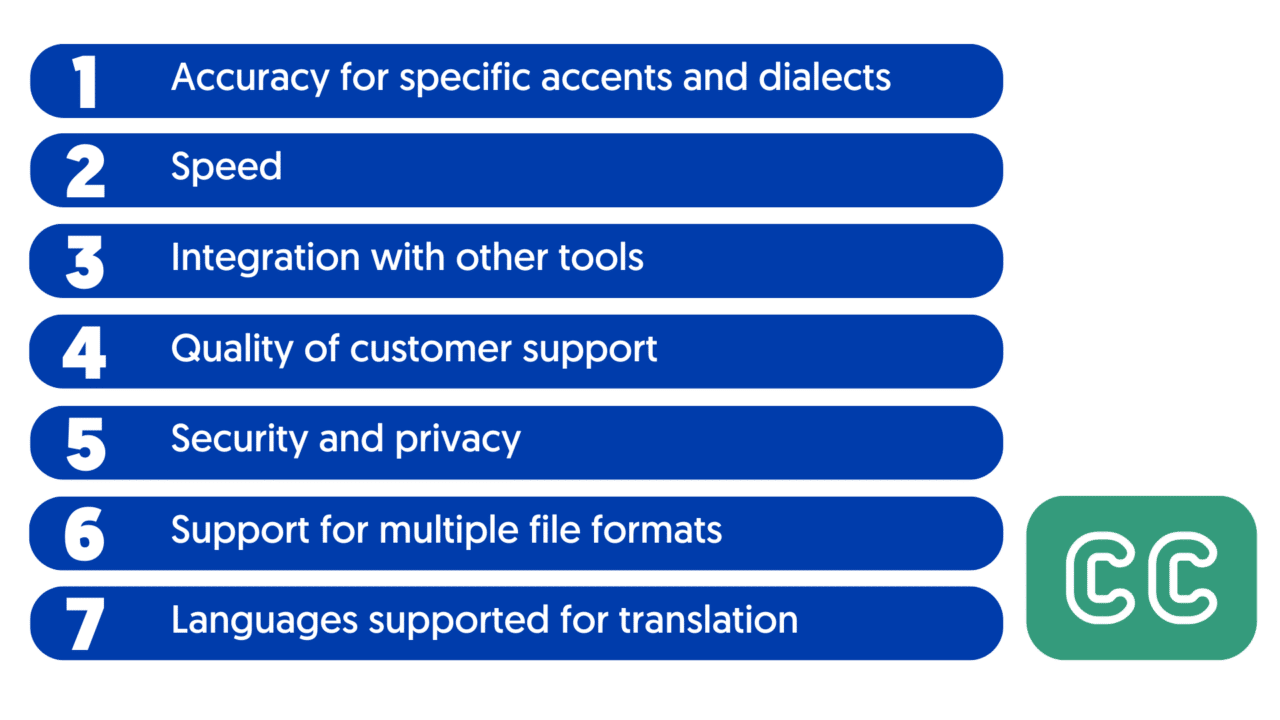
Accuracy for specific accents and dialects
One of the most significant elements to consider when selecting an automatic subtitling technology is its precision in capturing specific accents and dialects. Accuracy is especially crucial for content creators who are targeting a specific audience with a certain accent or dialect.
It is critical to remember that not all automatic subtitling solutions are made equal in terms of accuracy. Some tools are better suited for transcribing certain accents and dialects than others. A subtitling tool that performs well for American English, for example, may not be as accurate when transcribing British English.
It is essential that you test your automatic subtitling technology with a sample of your content to confirm that it is accurate for your intended audience. Testing will show you how successfully the tool can transcribe the accents and dialects in your material. Claim your free trial and test Ammberscript’s subtitling quality here.
Another way to ensure accuracy is to choose a tool that has been specifically designed for the accent or dialect you are targeting. Many automatic subtitling tools now offer options for different accents and dialects, so it is important to choose a tool that offers the option that best suits your needs. For exmaple, Amberscript has languages experts from more than 39 different countries and also covers specific accents, such as all English accents or the Swiss German dialect.
Choosing an automatic subtitling technology that can effectively transcribe the accents and dialects used in your video is critical to ensuring that your audience completely understands and enjoys your material.
Speed
Another important factor to consider when choosing an automatic subtitling tool is its speed. The tool’s speed might have a significant impact on your productivity, especially if you produce a huge amount of information.
Various automatic subtitling software are faster than others, however, keep in mind that speed is also affected by the length and intricacy of your content. For example, a tool may be fast at transcribing simple sentences but may struggle with more complex sentences.
It is recommended that you test your automatic subtitling tool with a sample of your content to check that it is fast enough for your purposes. Testing will show you how long the tool takes to transcribe your text and whether or not it fulfills your speed criteria.
Another way to speed up the subtitling process is to choose a tool that offers features such as automatic timecode generation and synchronization with your video editing software. By decreasing the need for manual modifications, these capabilities can save you time and improve your workflow.
It is important to choose an automatic subtitling tool that can transcribe your content quickly and accurately. By considering the speed and accuracy of the tool, you can ensure that your workflow is efficient and your audience can fully enjoy your content. Just want to choose a system that you can trust – Amberscript is one of the best choices you can make. But you can find a comparison of the best subtitling tools here.
Integration with other tools
One important factor to consider when choosing an automatic subtitling tool is whether it can integrate seamlessly with other tools or platforms that you use to create and distribute your content. For instance, if you are using video editing software or hosting platforms, you want to make sure that the automatic subtitle service can work seamlessly with these tools.
When evaluating different services, check to see if they offer integrations with other popular tools and platforms. Some services may allow you to upload your videos directly to video hosting platforms like YouTube or Vimeo with subtitles already added.
Quality of customer support
No matter how easy to use an automatic subtitling tool may be, there may come a time when you need help or run into issues. Look for services that offer responsive and helpful customer support.
Some automatic subtitling tools offer customer support through various channels, such as email, phone, or live chat. Before selecting a tool, consider the availability of customer support and the responsiveness of the service.
Furthermore, some automatic subtitling solutions include resources such as tutorials, user guides, as well as frequently asked questions (FAQs) to help you resolve problems on your own. When you need rapid solutions to difficulties, these sites might be extremely useful.
Security and privacy
If you’re working with sensitive content, it’s crucial to evaluate the security and privacy features of any automatic subtitling tool you’re considering. Look for services that prioritize data protection and offer strong encryption to safeguard your content.
When evaluating different services, check to see what data protection measures they have in place. Security can include encryption of your video files and subtitles, as well as measures to prevent unauthorized access or data breaches. Some services may also have data privacy rules that adhere to industry norms and regulations.
By taking these aspects into account when selecting an automatic subtitling tool, you can guarantee that you choose a service that suits your demands while also providing the quality and assistance you require.
Support for multiple file formats
When choosing an automatic subtitling tool, it’s important to consider whether the service can generate subtitles in the file format you need. Given the type of content you’re making, subtitles in various file formats may be required to ensure compatibility with various systems and devices.
For example, some platforms may require subtitles in the SRT format, while others may require the WebVTT format. Some video editing software may require subtitles in specific file formats that are compatible with the software.
Therefore, it’s crucial to check if the automatic subtitling tool you’re considering supports the file formats you need. To ensure optimum adaptability and versatility, look for services that support a wide range of file types.
Remember, choosing an automatic subtitling tool with limited support for file formats may result in time-consuming conversions and additional work. Consequently, always confirm that the subtitling tool you select supports the file types required for the task at hand.
Languages supported for translation
If you need to translate your subtitles into multiple languages, it’s crucial to evaluate the language support offered by the automatic subtitling tool. Some tools may offer more extensive language support than others.
Before selecting a tool, review the languages supported for translation to ensure that it meets your needs. Some automatic subtitling tools offer translation support for a wide range of languages, while others may only support a few.
It’s also worth noting that translation quality varies based on the tool and language.
Some subtitling tools may produce more precise translations than others, so make careful to examine the translation’s accuracy before making your decision.
An overview of the best subtitle tools for your needs
| Software | Price | Accuracy | Security | Speed | Ease of use |
|---|---|---|---|---|---|
| Amberscript | From $8/hour (AI), Get a quote for manual services. | Up to 99% | High | Fast (AI), Varies (human) | Easy to use |
| Pictory AI | Free tier, paid plans start at $12/mo | Up to 95% | Moderate | Fast (AI) | Easy to use |
| Rev | $0.25/min (AI), From $1.50/min (human) | Up to 99% | High | Fast (AI), Varies (human) | Easy to use |
| 3Play Media | Pricing upon request | Up to 99% | High | Varies | Moderate |
| CaptioningStar | Starts at $1.50/minute | Up to 99% | High | Varies | Easy to use |
| Aegisub | Free | Depends on user | Depends on user’s system | Depends on user | Advanced, steeper learning curve |
| Otter.ai | Free tier, paid plans start at $10/mo | Up to 90% | Moderate | Fast (AI) | Easy to use |
| Subtitle Edit | Free | Depends on user | Depends on user’s system | Depends on user | Moderate |
| CaptionHub | Pricing upon request | Varies | High | Varies | Easy to use |
Common misconceptions about automatic subtitling
There are several misconceptions about automatic subtitling that prevent many content creators from utilizing this technology.
One common misconception is that automatic subtitling is always inaccurate. While there may be faults in automatic transcription, the technology has advanced significantly in recent years. Many automatic subtitling tools use advanced algorithms and machine learning to improve accuracy.
Another misconception is that automatic subtitling is only useful for certain types of content. Automatic subtitling, on the other hand, can be useful for a variety of content, including instructional videos and even social media material.
In fact, studies have shown that incorporating subtitles into video content can improve engagement and retention rates. According to a study by Facebook, videos with subtitles are watched 12% longer than those without.
Amberscript as the choice #1
When it comes to selecting a high-quality automatic subtitling tool, Amberscript is a top choice. Amberscript offers support for multiple file formats (e.g. SRT, VTT, EBU-STL and more), a wide range of languages for translation (+39), and seamless integration with other tools and platforms. Their customer support is also highly responsive and helpful.
Amberscript works by using advanced speech recognition technology to transcribe audio into text. The tool also offers a user-friendly editor that allows users to review and edit the subtitles before exporting them in their desired file format.
In addition to automatic subtitling, Amberscript also offers other services, including manual transcription, translation, and captioning.
Creating subtitles with Amberscript in 3 simple steps
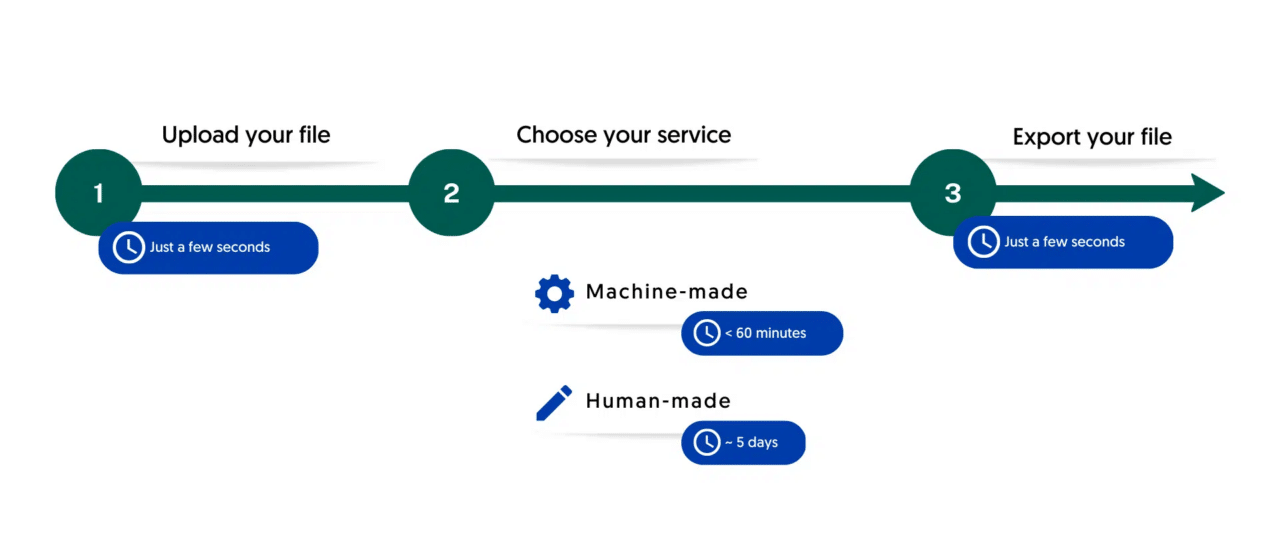
Benefits of using Amberscript
Amberscript’s subtitling services are:
Edit your text in minutes or leave the work to our experienced subtitlers.
Our experienced subtitlers and thorough quality controls ensure 100% accuracy of transcripts and subtitles.
Through a series of integrations and API interfaces, you can fully automate your workflows.
Your data is in safe hands. We are GDPR compliant + ISO27001 and ISO9001 certified.
Enhancing accessibility and engagement: The power of automatic subtitling with Amberscript
In conclusion, automatic subtitling is a valuable tool for content creators looking to improve accessibility and engagement for their audiences. When choosing an automatic subtitling program, consider elements like file format support, language translation, integration with other products, and customer assistance quality.
Amberscript is a top choice for a high-quality automatic subtitling tool that meets all of these criteria. Amberscript offers a comprehensive solution for automatic subtitling needs. These services include advanced speech recognition technology, a user-friendly editor, and additional services such as manual transcription and translation.
By choosing a high-quality automatic subtitling tool like Amberscript, content creators can ensure that their subtitles are accurate, accessible, and engaging for their audiences.
Frequently asked questions
-
Can I burn the subtitles directly onto my video?
If you have exported the transcript as a SRT, EBU-STL or VTT file, you can easily burn them onto your video using video-editing software.
-
Can I export my files with timestamps?
Yes, you can. The transcript always includes timestamps in our online editor and you can choose to export the file with or without timestamps.
-
Do you add timestamps?
Yes, timestamps are included in the transcript.You can choose to export the transcript with or without timestamps.
-
Do you offer services in other languages?
For our human-made subtitling services we work with a network of language experts in 15 different languages. Find out which here. If the language you want is not on the list, please contact us through our contact form.
-
How do I add captions to a video on Vimeo?
To add captions to your Vimeo video, simply add the file you have created using Amberscript to your video in the editing window on Vimeo. Click on “distribution”, then “subtitles” and finally click on the + symbol to upload the SRT file.
-
How do I add captions to a Youtube video?
To add captions to your Youtube video, simply add the file you have created using Amberscript to your video in the Youtube Studio. Click on “subtitles”, then “add” and finally “upload file” and select the SRT file.
-
How do I export my subtitles?
Once your file is ready and available in your account, you can simply click on the file name and then select the “export file” button at the top left of the page. You can then select the file format, style of sutitles (between BBC and Netflix) and alignment. Please note that you can only export a file if you have validated your email address when creating an account.
-
How do you keep my files secure and confidential?
Amberscript’s IT infrastructure is built on the server infrastructure of Amazon Web Services located in Frankfurt, Germany. All data that is processed by Amberscript will be stored and processed on highly secured servers with regular back-ups on the same infrastructure.
-
To which languages can you translate subtitles?
For our human-made subtitling services we work with a network of language experts in 15 different languages. Find out which here. If the language you want is not on the list, please contact us through our contact form.
-
What is the turnaround time?
The standard deliver time is up to 5 business days. You will also have the option to ask for a rush order. We will then prioritize your file and deliver up to 4 times as fast.
-
Will different speakers be distinguished?
Yes, our software indicates different speakers and when the speaker changes.
-
What subtitle file formats are supported?
Our software allows you to export the transcript from the video or audio file as an SRT, EBU-STL or VTT file.
Distance Learning: Top transcription and captioning services for online educators
Over time there has been a surge in the popularity of distance learning which offers flexibility for students who want an alternative way of studying outside conventional brick-and-mortar schools. With technological advances such as high-speed internet access globally available today, more individuals have access than ever!
Despite this progress, accessibility remains an issue, particularly for those with different needs who may face challenges accessing lectures or course content. Transcription and captioning services provided by experts can solve this problem: by creating transcripts of spoken audio recordings & captions on videos meaning everyone can enjoy easy access no matter their needs.
Agenda
- Transcription services
- Benefits of transcription services
- Top transcription services
- Captioning services
- Benefits of captioning services
- Top captioning services
- Comparison of transcription and captioning services
- Amberscript is the ultimate all-in-one option
- We must make sure everyone has equal access to these resources
Transcription services
Transcription services entail converting spoken language into written text format. It requires a keen ear and precision in documenting every word uttered during audio or video recordings. Online education platforms rely heavily on transcription services nowadays, with the growing popularity of e-learning amongst learners worldwide.
Transcripts enable educators to cater their teaching methods to diverse student requirements by accommodating individuals who face hearing impairment or linguistic obstacles.
Benefits of transcription services
In pursuit of maximizing the impact and efficacy of our e-learning resources, integrating transcription services affords numerous advantageous outcomes. A handful of these key benefits include:
Improved accessibility
Assistance is often needed for people to grasp audiovisual content fully. Thankfully transcription services offer written transcripts for such materials. This approach allows all students to fully participate in e-learning activities regardless of their preferred learning modes or cognitive limitations.
Enhanced comprehension
Despite being able to hear audio contents clearly and view videos without any problem, access to written transcripts remains critical for all students- including those who do not experience any impediments in these areas.
Written materials become even more necessary when handling technical and specialized subjects containing complex terminologies and ideas that require attention to detail during lectures. Creating more opportunities for students to access such resources results in a better understanding of the material and improved retention capacity over extended periods.
Top transcription services
Picking out the most suitable transcription service for online classes can be overwhelming. Nevertheless, we have streamlined this task by listing our top recommendations for the two best services:
Amberscript
Streamline your transcription experience with Amberscript – a versatile tool suitable for private users and large corporations. It is a top performer in this field by boasting custom-made solutions that utilize AI capabilities. Equally impressive are its stringent security measures- GDPR compliance guarantees stringent data protection standards.
They offer a wide range of capabilities, including eLearning subtitles that have gained popularity amongst educators for their dependability. Plus, with flexible and secure captioning/transcription offerings, individuals and businesses can trust Amberscript’s reliable service.
Pricing
Their pricing model begins at $10 for an hour of audio or video content. Additionally, they offer all users who sign up a complimentary 10-minute trial period.
Features
Amberscript has taken note of the challenges faced by audio transcription pros and developed a product that addresses every need. Their advanced features cater to users who require exceptional service delivery and accuracy while optimizing technology. For instance:
- Their automatic transcription and subtitle capability ensures that text-based formats are delivered quickly and accurately.
- The full API and multi-user accounts options facilitate collaboration across platforms while relying on best workflow management practices to maximize productivity.
- It has an advanced dashboard, an online text editor, and the ability to capture multiple speakers’ voices, proving why customers keep returning for more!
Sonix
This online platform provides premium text conversion from audio and video files in over 38 languages. As a result, accessing eLearning or other online courses becomes simple with one click.
Pricing
With Sonixs three different pricing options – there’s something for everyone! Starting with the pay-as-you-go option, which starts at an hourly rate of $10/ hour- perfect for those who need short burst transcriptions immediately.
Alternatively, the Premium User plan starts at $5/hour plus an additional $22 per user/month (potentially saving up to 25% by opting for annual payment). Moreover, we understand that every enterprise team has distinct requirements that need addressing. Contact their enterprise team directly to learn which pricing plan is right for your team.
Features
Sonix caters to individuals searching for a streamlined solution for all their transcription requirements. With their online text editor’s simplicity, auto speaker separation capabilities, and transcriptions’ searchable nature, users are sure to have all their needs met seamlessly.
For a comprehensive comparison of different transcription providers, click here.
Captioning services
To ensure all students have equal access to distance learning course material implementing captioning services can be a game changer. Captioning services enable effective communication across various languages and abilities by transcribing the spoken content in online videos or audio recordings into text displayed onscreen via captions of course creators.
Although subtitles also display dialogue transcription, they cannot compare to the inclusive solutions captions provide.
Benefits of captioning services
The following benefits are for example acquired by including captioning services in your online courses:
Inclusive to all
You may provide a supportive atmosphere for deaf and hard-of-hearing individuals by using captioning and subtitling services. People that are learning a new language or are unfamiliar with the dialect in the recording can also benefit from these services. Learn more about how subtitles help the deaf and hard of hearing here.
Improve audience engagement
By using captioning services, you make your information accessible to a larger audience and make it simpler for students to comprehend the subject matter. Captions and subtitles can also help your SEO ranking, making it simpler for prospective students to find your courses.
How to Add Subtitles to a Video: Fast & Easy Ways
Learn moreTop captioning services
The top two captioning services include:
Otter
Through its innovative use of machine learning and AI technologies, Otter delivers unparalleled automated captioning and subtitling services with exceptional precision. To ensure optimal quality control with minimal effort required on your part, Otter allows easy editing of final transcripts.
Pricing
When starting with them, opt for the Basic plan, which caters perfectly to your needs at no charge. If necessary features and minutes exceed the basic package, upgrading to their Pro option for just $8.33 monthly (billed annually with a 51% discount) may be in order.
Their Business plan starts at only $20 per user/month, and you save 33% if billed annually, and for large organizations that need extra security, control, and support, their Enterprise plan is the way to go.
Features
Regarding efficient note-taking or accurate transcription work, the features offered by Otter are second to none. With the ability to identify speakers by name, access recordings on both mobile and web platforms, and quickly locate key information through word highlighting – Otter truly sets itself apart from the competition.
Veed
Looking for a quick and easy way to enhance accessibility for your video content? Veed offers a solution that’s both efficient and effective. Their advanced speech recognition technology can automatically generate precise closed captions in over 100 languages and accents.
Pricing
The monthly cost plan is free, and a credit card is unnecessary. Pro and Business Plans are priced at $24 and $59 per month, respectively; for individuals and small enterprises. The $100/month Enterprise Plan is a special plan created to fulfill enterprises’ demands.
Features
By integrating Veeds eLearning feature into their material, users can significantly boost their educational content’s efficacy. This function permits educators to add interactive quizzes and questions that facilitate better topic comprehension. Moreover, it empowers them with the ability to share supplement resources alongside the video in formats such as links and PDF files.
Comparison of transcription and captioning services
There are some variations between these two services, so it’s important to analyze and compare transcription and captioning offerings to understand them better.
Type of Media
While captioning is better suited to enhancing video content and giving viewers a fuller experience, transcription is ideal for making spoken content more accessible and searchable.
Formatting
Captions are meticulously timed out and separated into designated segments, whereas transcripts lack such specific formatting details.
Amberscript is the ultimate all-in-one option
Amberscript’s innovative platform excels in more than transcribing or subtitling – they also offer exceptional dubbing, translation, and audio description options.
In seconds following registration, uploading audio or video content onto their streamlined platform couldn’t be simpler. Once complete, sharing or exporting the now-transcribed/captioned file will be a breeze thanks to their top-notch tech solutions.
Say goodbye to frustratingly complex transcriptions/captions- Amberscript has got you covered with their “Try for free” option.
We must make sure everyone has equal access to these resources
As we move further into the digital age of education with distance learning, online courses, and eLearning at the forefront, we must make sure everyone has equal access to these resources- including learners with hearing difficulties or language barriers. Transcription and captioning services are essential for ensuring inclusivity in our educational systems.
The Importance of Transcription and Captioning Services
Creating inclusive learning environments that cater to the requirements of all students requires transcription and captioning services. These programs make learning a fluid and fun process by allowing students to interact with the material in real-time and comprehend difficult language.
Why Amberscript?
Amberscript’s transcription and captioning services team is dedicated to improving education by making it inclusive, regardless of ability level or hearing loss. When you partner with them, you can rest assured that their accurate transcriptions will meet or exceed industry standards.
How to choose your subtitling service for precisely accurate subtitles
Multimedia content, especially videos, are becoming an increasingly important part of our lives. Accurate subtitles are essential for non-native speakers and persons with hearing impairments to understand and engage with video content. Choosing a subtitling firm can be challenging due to various factors such as accuracy, speed, cost, and quality. There are also subtitle software options available in the market due to advancements in speech-to-text technology. To select a subtitling service that meets your needs, consider the most critical elements, which we will explore.
Agenda
- Factors to consider when choosing a subtitling service
- Tools and technology for subtitling
- Subtitling with Amberscript
- Case studies and examples
- Choosing the right subtitling service is essential for achieving precise and accurate subtitles that meet your video content needs
As humanity becomes more connected, multimedia content is becoming an increasingly important part of our lives. From entertainment to education and beyond, videos offer a rich and engaging experience for viewers. However, not everyone can fully understand spoken language. Precisely accurate subtitles can make all the difference in helping all viewers to understand and engage with video content with ease.
The importance of accurate subtitles in video content cannot be overstated. To begin, subtitles are critical for non-native speakers of a language and persons with hearing impairments since they allow them to listen to audio material that would otherwise be inaccessible. Accurate subtitles can be the difference between a viewer being able to fully enjoy and understand a video, or being completely lost and disinterested.
Selecting a subtitling firm might be difficult, especially if you are unfamiliar with the procedure. A variety of aspects, including accuracy, speed, cost, and quality, must be reviewed. Additionally, with the advancements in speech-to-text technology, there are various subtitle software options available in the market.
We will explore how to choose a subtitling service that can provide precisely accurate subtitles for your video content. We’ll go over the most important elements to think about so you can choose a subtitling service that matches your individual requirements.
Factors to consider when choosing a subtitling service
Choosing the right subtitling service is crucial for ensuring that your video content reaches a wider audience and is accurately understood by viewers. When choosing a subtitling service, many aspects must be considered, including translation quality, timing and synchronization, and the type of subtitle software used.
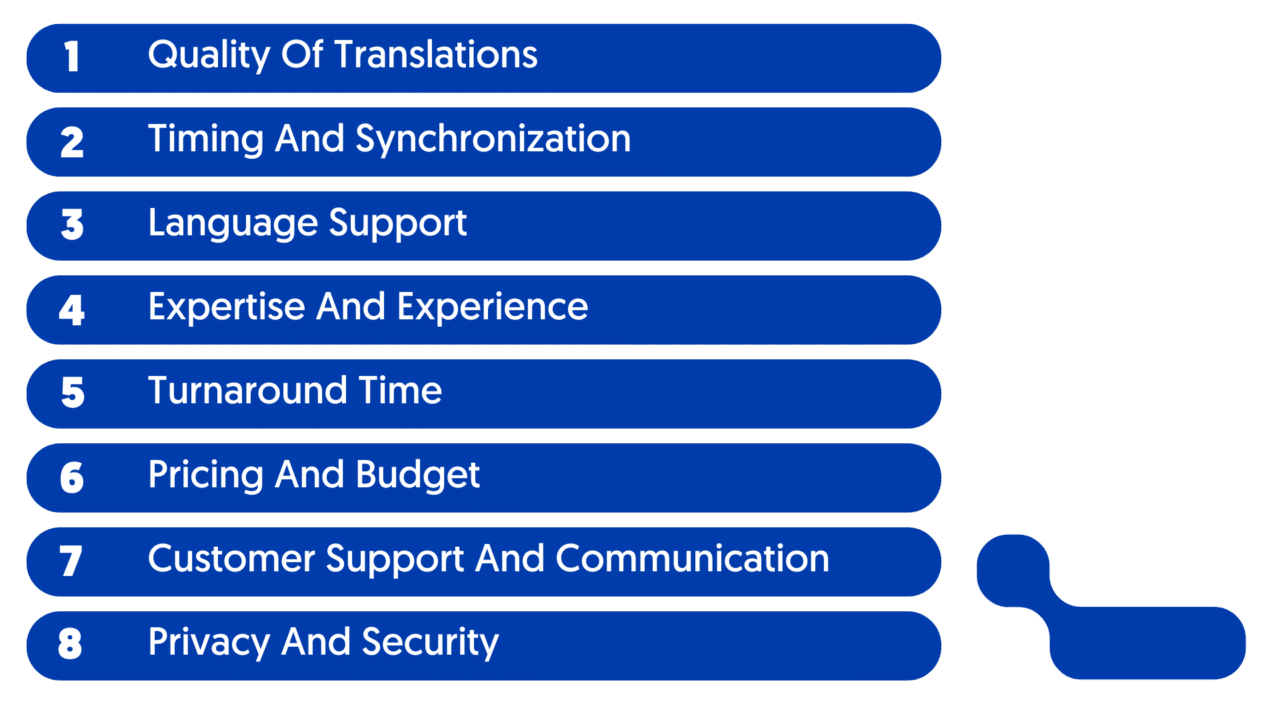
Quality of translations
The quality of translations is one of the most crucial elements to consider when selecting a subtitling provider. Accurate translations are critical for ensuring that the subtitles convey the intended meaning of the video content.
A subtitling service that uses native speakers or trained translators can provide higher-quality translations than those that rely solely on automated translation software. To assess the quality of a subtitling service’s translations, it’s essential to review their portfolio of work and read client testimonials.
Look for a subtitling service that has experience in your industry or niche and has a track record of producing accurate translations. Additionally, ask about their quality control process to ensure that the translations are reviewed and edited before delivery.
Timing and synchronization
Timing and synchronization are also critical factors to consider when selecting a subtitling service. The timing of subtitles can impact their accuracy, especially if they appear too late or too early in the video. Synchronization is also essential, as subtitles must align with the spoken words and match the pace of the video.
When selecting a subtitling service, look for one that has a streamlined process for timing and synchronization. Ask about their workflow and how they ensure that the subtitles are accurately timed and synchronized with the video. An experienced subtitling service provider should have a robust process in place that involves manual review and quality checks to ensure that the subtitles are synchronized correctly.
It’s also worth inquiring about the provider’s experience with different types of video content. The timing and synchronization of subtitles may vary depending on the nature of the video content, such as documentaries or live events, and an experienced provider will be able to adapt to these differences and provide accurate subtitles.
Overall, timing and synchronization are key factors to consider when selecting a subtitling service. Choosing a provider that has a streamlined process, experience with various video content, and a commitment to quality assurance can ensure that subtitles are accurately timed and synchronized, providing a positive experience for the viewer.
Language support
It’s essential to find a subtitling service that can support the languages you need to reach your target audience effectively. Subtitles that accurately express the meaning of the content in the viewer’s language can significantly improve their comprehension and appreciation of the film.
To assess a subtitling service’s language capabilities, start by checking the list of languages they support. Some subtitling services specialize in specific languages, while others may offer a broader range of language options. Ensure that the subtitling service has a deep understanding of the target language’s grammar, vocabulary, and cultural nuances.
Another factor to consider is whether the subtitling service provides human translation or machine translation. While machine translation is fast and affordable, it may not always provide the level of accuracy and context necessary for effective subtitles. Human translation, on the other hand, can guarantee correctness, albeit at a higher expense.
Expertise and experience
Expertise and experience are also crucial factors to consider when choosing a subtitling service. Working with a service provider who has expertise and experience in your industry or subject matter can ensure accurate and effective subtitling that resonates with your audience.
For example, if you need subtitling for medical videos, it’s crucial to choose a subtitling service that has experience in medical terminology and can accurately translate complex medical jargon. Similarly, if your video content covers technical topics, it’s important to select a service that has experience in technical language.
When evaluating a subtitling service’s expertise and experience, consider its portfolio, client list, and case studies. Evaluating reviews can provide insights into their experience with different industries and subject matter. Additionally, you can also ask for references from past clients to ensure that they have a track record of delivering quality subtitling services.
Turnaround time
Turnaround time is another important factor to consider when selecting a subtitling service. A subtitling service with a quick turnaround time can help ensure that your video content is available to your audience promptly.
However, keep in mind that the turnaround time should not impact the quality and accuracy of the subtitles. To assess a subtitling service’s turnaround time, check their estimated delivery times for different project sizes and languages. Additionally, check if they offer rush services and if they charge extra fees for rush services.
Finally, when evaluating a subtitling service’s turnaround time, prioritize accuracy and quality while ensuring that they can deliver your project within a reasonable time frame.
Pricing and budget
Evaluating the cost-effectiveness of subtitling services
Pricing and budget are important factors to consider when choosing a subtitling service. Pricing strategies range amongst suppliers, and costs can vary greatly depending on criteria such as language support, turnaround time, and level of customization.
Investing in a high-quality subtitling provider, for instance, may help you reach a larger audience and enhance interaction with your content. Additionally, consider any hidden fees or additional costs that may arise during the subtitling process.
Customer support and communication
The importance of responsiveness and accessibility
Good customer support and communication can make a big difference when working with a subtitling service. Look for a service provider who responds to your needs and is available when you have questions or concerns.
If you require a high degree of help, a business that gives a dedicated account manager or offers 24/7 support may be an intelligent alternative. A subtitling service that provides regular updates on the status of your project and is transparent about its process can help ensure a smooth and stress-free experience.
Privacy and security
Protecting sensitive information
Privacy and security considerations are important when sharing video content with a subtitling service. For example, a subtitling service that uses encryption and secure file transfer protocols can help protect your data from unauthorized access or interception.
Consider any data retention policies in place and ensure you understand how your data will be retained and utilized. Finally, consider any legal or regulatory requirements that may apply, and ensure that your subtitling service meets these criteria.
Tools and technology for subtitling
Subtitling has undergone a remarkable evolution from the days of manually written titles on film strips. There are a variety of tools and software accessible now that make subtitling faster, easier, and more accurate.
The advent of subtitling software was one of the most significant technological developments in subtitling. This software makes it easy for subtitlers to create subtitles that accurately match the dialogue in a video. By syncing the timing of subtitles with the speech, the software ensures that the text appears at the right moment.
In addition to subtitling software, another popular tool used in subtitling is automatic translation software. This tool leverages machine learning algorithms to automatically translate dialogue from one language to another. However, it is important to have a human editor to review and refine the subtitles.
Speech recognition technology is also used in subtitling. While it can be useful, it should be noted that it is not always dependable and may necessitate further editing to guarantee the subtitles are correct. To ensure precision and error-free subtitles, it is important to use the right tools for the job and to have human oversight. Automated tools should not replace the expertise and critical eye of a human editor.
Subtitling with Amberscript
Amberscript’s subtitle service is a hybrid service that combines the power of machine-based speech recognition technology with human intelligence to produce fast and accurate subtitles. Amberscript specializes in delivering accurate and high-quality transcripts that meet the needs of our clients.
Subtitling is accomplished through the use of a combination of Automatic Speech Recognition (ASR) for automatic transcription and Natural Language Processing (NLP) for improving accuracy. The content is then reviewed by humans to analyze and improve the accuracy of the transcription, ensuring that clients receive the most precise and error-free transcripts possible.
The process involves uploading your video content to Amberscript`s platform, where their advanced speech recognition algorithms transcribe the speech in the video. These transcriptions are then reviewed and edited by professional human editors to ensure accuracy and correct any errors.
One of the unique selling points of Amberscript’s Subtitle Service is its speed. The blend of machine and human skills enables us to generate high-quality subtitles in just a small percentage of the time that traditional subtitling processes would require.
Another advantage of using Amberscript’s Subtitle Service is its ease of use. The platform is simple to use and intuitive, allowing anyone to publish and manage video content. Amberscript’s Subtitle Service is a powerful tool for creating accurate and engaging subtitles for video content.
Easy Subtitling in 3 Steps

Case studies and examples
Accurate subtitles can make a significant difference in various contexts, including accessibility, education, and internationalization. Here are three case studies that highlight the importance of choosing the right subtitling service for precise and accurate subtitles.
Creating accessible virtual events for LR Health & Beauty
LR Health & Beauty wanted to create accessible virtual events for their audience. However, they faced challenges in delivering accurate and timely subtitles. Amberscript provided a solution with its advanced subtitling services, resulting in precise and accessible subtitles for LR Health & Beauty’s virtual events.
Cheflix and Amberscript join forces to make Michelin star cooking accessible to everyone.
A collaboration between Amberscript and the Cheflix platform aimed to make Michelin-star cooking accessible to a wider audience. Accurate and precise subtitles were provided by Amberscript for Cheflix cooking videos, improving inclusivity and accessibility for viewers.
Amberscript supports the University of Jena in making lecture recordings & co. digitally accessible
The University of Jena in Germany needed accurate and accessible subtitles for their lecture videos. Amberscript provided a reliable subtitling service that helped the university to make its content more accessible to all students including those who have hearing disabilities.
These case studies illustrate the importance of choosing the right subtitling service for accurate and precise subtitles. Precise subtitles may improve accessibility, expand the reach of content, and make it easier for people to comprehend and learn. With the right subtitling service, businesses, organizations, and educational institutions can achieve their goals of making their content more accessible and inclusive.
Choosing the right subtitling service is essential for achieving precise and accurate subtitles that meet your video content needs
Remember to consider factors like language support, expertise, turnaround time, pricing, customer support, privacy, and security when evaluating your options.
At Amberscript, we understand the importance of delivering fast, accurate, secure, and high-quality subtitles. Our subtitle service combines cutting-edge technology with human knowledge to ensure that your subtitles are delivered on time and with unrivaled accuracy.
Do not settle for second best. Choose Amberscript to discover the difference. Reach us today and find out more about our services and how we may assist you in meeting your subtitling objectives!
Frequently asked questions
-
Can I burn the subtitles directly onto my video?
If you have exported the transcript as a SRT, EBU-STL or VTT file, you can easily burn them onto your video using video-editing software.
-
Can I export my files with timestamps?
Yes, you can. The transcript always includes timestamps in our online editor and you can choose to export the file with or without timestamps.
-
Do you add timestamps?
Yes, timestamps are included in the transcript.You can choose to export the transcript with or without timestamps.
-
Do you offer services in other languages?
For our human-made subtitling services we work with a network of language experts in 15 different languages. Find out which here. If the language you want is not on the list, please contact us through our contact form.
-
How do I add captions to a video on Vimeo?
To add captions to your Vimeo video, simply add the file you have created using Amberscript to your video in the editing window on Vimeo. Click on “distribution”, then “subtitles” and finally click on the + symbol to upload the SRT file.
-
How do I add captions to a Youtube video?
To add captions to your Youtube video, simply add the file you have created using Amberscript to your video in the Youtube Studio. Click on “subtitles”, then “add” and finally “upload file” and select the SRT file.
-
How do I export my subtitles?
Once your file is ready and available in your account, you can simply click on the file name and then select the “export file” button at the top left of the page. You can then select the file format, style of sutitles (between BBC and Netflix) and alignment. Please note that you can only export a file if you have validated your email address when creating an account.
-
How do you keep my files secure and confidential?
Amberscript’s IT infrastructure is built on the server infrastructure of Amazon Web Services located in Frankfurt, Germany. All data that is processed by Amberscript will be stored and processed on highly secured servers with regular back-ups on the same infrastructure.
-
To which languages can you translate subtitles?
For our human-made subtitling services we work with a network of language experts in 15 different languages. Find out which here. If the language you want is not on the list, please contact us through our contact form.
-
What is the turnaround time?
The standard deliver time is up to 5 business days. You will also have the option to ask for a rush order. We will then prioritize your file and deliver up to 4 times as fast.
-
Will different speakers be distinguished?
Yes, our software indicates different speakers and when the speaker changes.
-
What subtitle file formats are supported?
Our software allows you to export the transcript from the video or audio file as an SRT, EBU-STL or VTT file.
Reasons Why No One Is Listening to Your Podcast
Podcasting is a popular medium for sharing ideas, information, and entertainment with varied audiences across the globe. Nevertheless, with the prevalence of podcasting, the competition to capture people’s attention has become even more aggressive.
On top of that, it’s incredibly challenging for podcasters to grow engaged and committed audiences. Capturing people’s attention doesn’t always assure longevity, cultural impact or even sales if that’s what you are after. But why exactly does this happen?
In this article, we will explore why podcasters might not be getting the engagement they need and how subtitling and transcription services can aid in growing and sustaining authentic engagement.
Table of contents
- Lack of Clarity and Focus
- Poor Audio Quality
- Lack of Promotion and Distribution
- How the Amberscript Transcription and Subtitle Service Works
- So, How Do I Get People to Listen to My Podcast
Lack of Clarity and Focus
To keep the audience interested and engaged, podcasters must have a focused and clear message that the target audience can relate to and easily follow.
For instance, if a podcast keeps rambling and has no clear topic or structure, the audience might find it challenging to understand the main point of that podcast. Due to the obscurity of the message, they may feel that they are wasting their time.
Also, if the episode addresses numerous topics, it can confuse the audience and make it challenging for them to follow along. Remember that people want to find solutions to their problems; not just an amalgamation of facts or a complex web of them that they struggle to pay attention to.
Fortunately, subtitling and transcription services can assist podcasters in augmenting the clarity and focus of their content. By including captions in their podcasts, podcasts can analyze the text and identify the areas that may be unfocused or unclear.
In addition, transcription and subtitling services can assist podcasters in identifying and doing away with filler words, such as ‘uh,’ that can distract the listeners from the main point. These services can help podcasters make their content even more accessible to a bigger audience.
Poor Audio Quality
Poor audio quality is another reason a podcast may not attract an audience. In this age of easy-to-access professional recording studios and high-quality audio equipment, audiences expect creators to produce clear and high-quality audio. Audios with poor quality can be a turnoff for audiences and make it challenging for them to follow along with the topic of discussion.
Some common issues podcasters can encounter include echoes, low volume, background noise, and static noise. Many factors, including a noisy recording environment, lack of proper recording equipment, or poor microphone techniques, can cause these problems.
Podcast transcription and subtitling services can assist podcasters in improving their audio quality by offering detailed audio-to-text captions that can be used for quality control and editing. For instance, transcribing can help a podcaster recognize areas of the episode where issues like background noise are prominent. They can then use this information to change the audio and avoid distortions or unwanted noise.
Moreover, precise subtitling services and captions can assist audiences in comprehending what is being talked about, even if the quality is poor. This can accommodate people with hearing impairments or those listening in noisy environments.
Lack of Promotion and Distribution
A lack of promotion and distribution is also an issue that can prevent a podcast from growing to its potential. Even if a podcast contains good-quality content and a dedicated following, it will remain stunted and plateau if it isn’t being effectively promoted.
Some common mistakes podcasters make in terms of promotion and distribution include neglecting to enhance the podcast for search engines, not promoting the podcast on different social media platforms, and failing to utilize email marketing to link themselves to new audiences.
Transcription service and subtitling can benefit podcasters in promoting their content by making it available to a wider audience. Transcripts offer an audio-to-text version of the podcast episode, making it easier for search engines to index the content. This enhanced indexing can help increase the podcast’s visibility, making it more straightforward for new audiences to discover in a saturated market.
Furthermore, audio-to-text and captions can be utilized as promotional and marketing material. For instance, podcasters can use extracts from their transcripts to endorse their episodes in email marketing campaigns, social media platforms, or on their website. This tactic will help attract new audiences and increase interest in the podcast.
How the Amberscript Transcription and Subtitle Service Works
Amberscript provides transcription and subtitling services that can assist individuals, businesses, and podcasters to increase the quality, promotion, and accessibility of their content. Here are the features explaining how it works;
- Upload your video or audio file: the initial step is to upload your video or audio file to Amberscript, which supports numerous file formats, including MP4, MP3, and WAV.
- Edit and proofread: when the transcription service is done, you can edit and proofread the text using Amberscript editor, which lets you make any necessary changes and make sure that the captions accurately reflect the content of your video or audio file.
- Subtitling services: if you add subtitling services, the Amberscript platform creates subtitles or captions for your file. These can be modified to fit your varied needs, such as positioning captions on the screen and adding color coding.
- Download and use: once the transcription service and subtitles are done, you can download them in numerous formats, including SRT, Word, or PDF. Then, you can use the subtitles and transcripts to increase the quality, accessibility, and promotion of your content.
Amberscript’s podcast transcription and subtitling services have many benefits, including increased quality, accessibility, time-saving automation, and enhanced promotion. Apart from that, Amberscript is user-friendly and allows you to upload your files for transcription easily; it provides customizable transcription services that suit your needs and supports many languages across the globe. Whether you are an individual, business, or podcaster, Amberscript’s transcription and subtitling services can assist you in increasing the quality and accessibility of your content and reaching a greater audience.
So, How Do I Get People To Listen to My Podcast
In conclusion, several issues can prevent a podcast’s growth, including poor audio quality, lack of clarity and focus, and inadequate distribution and promotion. By providing precise transcription service and captions, podcasters can reach more listeners, enhance promotion efforts and improve their content quality.
Fortunately, the Amberscript platform can help podcasters do away with these issues and improve their accessibility and quality of content. Amberscript’s transcription and subtitling services can help you take your content to higher levels, whether you are just beginning the journey or a seasoned podcaster. If you want a more in-depth guide on how to transcribe your podcasts you can check out our extensive guide on the entire process.
So why not give it a chance and see how it can help you grow your engagement and audience?
Dubbing and Subtitling in Translation Guideline
Table of contents:
- Importance of Dubbing and Subtitling in Translation
- Basics of Translation
- Understanding the Source Material
- Choosing the Right Method
- Quality Control
- Technical Aspects
- Cultural Considerations
- Conclusion
Importance of Dubbing and Subtitling in Translation
Dubbing and subtitling are both vital tools in translation, and each has unique advantages and disadvantages. While some viewers prefer dubbing, whereby one can concentrate on the visuals of a film or show without the distraction of reading text simultaneously, others prefer subtitling because the initial performance of the actors is preserved.
Dubbing involves replacing the original audio of a video with a new audio track in a different language. This is typically done by actors who voice over the initial dialogue. Dubbing is a popular option in countries with a strong tradition of watching movies and TV shows dubbed in their native language.
One of the advantages of dubbing is that it widens the scope of reach for foreign films and TV shows. Dubbing facilitates access for viewers who might never have tuned into the content previously due to language barriers or visual impairments. Additionally, it provides an opportunity for the film or TV show to generate foreign revenue, which benefits the cast and crew, the respective organization and the country at large.
Subtitling, on the other hand, involves adding translated text at the bottom of the screen while the original audio remains intact. It is a popular option in countries where viewers prefer to watch movies and TV shows in their original language with subtitles.
One of the advantages of subtitling is that it allows for the localization of content to specific regions and dialects. By adjusting the subtitles to reflect regional variations in language and culture, viewers can better understand and engage with the content. Furthermore, subtitles cater to a multilingual target audience, as they can be produced in multiple languages simultaneously, broadening the reach.
In summary, dubbing and subtitling are critical elements of translation, and the choice between the two depends on various factors such as cultural preferences, audience demographics, and budget constraints.
Basics of Translation
Translation is the process of converting written or spoken content from one language into another while preserving the meaning, tone, and style of the original material. Translators are professionals skilled in both the source and target language and have a deep understanding of the cultural nuances of both.
There are different translation methods, including:
- Human translation: This is the traditional method of translation where a human translator translates the text from one language to another. The translator reads the source text and produces an equivalent text in the target language. Professional translators or bilingual individuals usually make the most proficient human translators.
- Machine translation: This is the process of using computer software to translate text from one language to another. The software analyzes the source text and produces a translated version in the target language. Rule-based, statistical, or neural machine translation systems can be used for machine translation.
- Hybrid translation: This is a combination of human and machine translation. In this method, the machine translation system generates a first draft of the translation, which is then reviewed and edited by a human translator to ensure accuracy and clarity.
- Post-editing: This is a method of translation where a human translator reviews and edits the output of a machine translation system. The goal of post-editing is to improve the quality of the translation and make it more accurate and natural-sounding.
- Localization: This is a specialized form of translation that involves adapting a product or service to a specific language, culture, and market. Localization necessitates translating the text and adapting graphics, audio, and other elements to suit the target audience.
Each translation method has its strengths and weaknesses. The choice of method will depend on factors such as the type of content being translated, the level of accuracy required, and the available resources. In addition, all these translation methods are facilitated by tools such as dubbing and subtitling, which we shall look at below.
Definition of Dubbing and Subtitling
Dubbing and subtitling are two techniques used in audiovisual media to translate the dialogue or narration of a video from one language to another.
Dubbing involves replacing the original language of a video with a new one by recording a new voiceover in the target language. This technique entails hiring actors to record a new dialogue in the target language and synchronizing it with the video.
Subtitling involves adding a text translation of the dialogue or narration of a video on the screen. The text appears at the bottom of the screen, usually in the same language as the original audio or in a different language for viewers who don’t understand the original language.
Purpose of the Guideline
This guideline provides translators with comprehensive instructions on accurately and effectively translating media content through dubbing or subtitling while considering cultural and linguistic factors. It aims to ensure quality control and increase the global reach of media production by promoting effective and culturally appropriate translation.
Understanding the Source Material
The source material refers to the original content being translated from one language to another. This includes films, TV shows, interviews and speeches. The quality and accuracy of the translation heavily depend on the clarity and completeness of the source material as well as the translator’s expertise and understanding of the nuances of both languages.
Importance of Understanding the Source Material
Understanding the source material is crucial in the process of dubbing and subtitling for several reasons:
- Accuracy: A deep understanding of the source material is necessary to ensure the accuracy of the translation. Dubbing and subtitling require a precise and faithful translation of the original material. Any misunderstanding or misinterpretation of the source material can result in a mistranslation that may alter the meaning of the content.
- Adaptation: Understanding the source material also helps adapt the translation to the target language and culture. The translator must consider the source material’s linguistic factors, cultural nuances and references. Failure to do so can result in a translation that does not resonate with the target audience.
- Voice matching: In the case of dubbing, understanding the source material is essential to match the voice of the original actors with the translated version. This requires precise translation and understanding of the tone and delivery of the original content.
- Time constraints: In both dubbing and subtitling, time constraints are critical. A deep understanding of the source material can help the translator deliver a translation that meets the time constraints while conveying the intended meaning accurately.
In summary, it is critical to have a good understanding of the source material to communicate effectively and meet your translation objectives.
Analysis of the Source Material
Analysis of source material in translation refers to examining the original text before beginning the translation process. This analysis is critical to ensure that the translator understands the context, meaning, and intention of the source text accurately. The analysis involves the following steps:
- Understanding the purpose: The first step is to understand the purpose of the source material. The goal of the text may be to inform, inspire, persuade, entertain, or educate the reader. Understanding the intention will help the translator to convey the same purpose in the target language.
- Understanding the genre: The second step is to identify the genre of the source material. The genre may vary from fiction, non-fiction, poetry and romance to news and drama. Understanding the genre will help the translator to use the appropriate tone and style in the translation.
- Identifying the audience: The third step is to identify the target audience of the source material. The audience may be general readers, specialists, children, or adults. Understanding the audience will help the translator to use appropriate language and vocabulary in the translation.
- Analyzing the structure: The fourth step is to analyze the source material’s structure. This involves identifying the main ideas, themes, and motifs, as well as the organization of the text. Understanding the structure will help the translator to convey the same arrangement in the target language.
- Understanding the cultural context: The fifth step is to understand the cultural context of the source material. This involves identifying cultural references, idioms, and other expressions that may not be easily translatable. Understanding the cultural context will help the translator to use appropriate cultural equivalents in the translation.
By analyzing the source material before beginning the translation process, the translator can ensure that the translation accurately conveys the meaning and intention of the original text.

Choosing the Right Method
Choosing the most appropriate method between dubbing and subtitling depends on several factors explained below:
- Audience preferences: Consider the predisposition of your target audience. In some countries, audiences prefer dubbing over subtitles, while in others, subtitles are more common.
- Budget: Before deciding on whether to employ dubbing or subtitling techniques, it is vital to determine your budget. The cost of the two options varies significantly.
- Target language: The choice between dubbing and subtitling can also depend on the target language. Some languages are more widely used globally than others.
- Nature of the content: The type of content you’re working with can also influence your choice between dubbing and subtitling because they have varied pros and cons.
Choosing between dubbing and subtitling will depend on your specific needs and circumstances. It’s important to consider all the factors mentioned above and weigh the advantages and disadvantages of each method before making a decision.
Dubbing
The following is a list of advantages of using dubbing for translation, including specific examples:
- Accessibility: Dubbing makes films and TV shows more accessible to people who may not speak the original language. For example, the famous Japanese anime series “Dragon Ball Z” was dubbed into English and other languages, making it accessible to a larger global audience.
- Cultural relevance: Dubbing allows for cultural relevance and accuracy by translating idiomatic expressions and cultural references. For example, in the Spanish dub of “The Simpsons,” the character of Groundskeeper Willie is given a Scottish accent to reflect the original version.
- Enhanced viewing experience: Dubbing can enhance the viewing experience by allowing viewers to focus on the visuals without reading subtitles. For example, the famous Spanish Netflix series “Money Heist” was dubbed in English, allowing English-speaking viewers to fully immerse themselves in the show without needing subtitles.
- Targeted audience: Dubbing allows films and TV shows to target specific audiences. For example, the popular Korean drama “Crash Landing on You” was dubbed in Mandarin and released in China, where it gained a large following.
- Revenue: Dubbing can increase revenue by facilitating the availability of films and TV shows to a larger audience. For example, the Disney animated film “Frozen” was dubbed in many languages, helping it become the highest-grossing animated film of all time.
Subtitling
Subtitling in translation has several advantages, including:
- Accessibility: Subtitles make audiovisual content accessible to a larger demographic, including people who are deaf or hard of hearing, people who speak a different language, or people who prefer to watch silent videos.
- Retention and Comprehension: Subtitles can help viewers to better understand and retain information from the video. They allow viewers to follow the dialogue, especially in cases where the audio quality is poor or the accent is difficult to understand.
- Search Engine Optimization (SEO): Subtitling can improve the visibility and reach of videos on search engines and social media platforms. By adding accurate and relevant subtitles, the video becomes more searchable and shareable, increasing its chances of being discovered by a wider audience.
- Cost-Effective: Compared to dubbing, subtitling is more cost-effective for adding multilingual support to audiovisual content. Subtitles are less time-consuming to produce and demand fewer technical requirements.
In addition, here are some specific examples of subtitling benefits:
- In the education sector, you can use subtitling to make educational videos accessible to a larger audience. For example, online courses with subtitles can benefit students who speak a different language or have hearing impairments.
- In the entertainment industry, you can use subtitles to make movies and TV shows accessible to non-native speakers. This can increase the global reach of the content and attract a wider audience.
- In the corporate world, you can use subtitles to add multilingual support to corporate videos and presentations. This can improve communication within multinational teams and enhance the company’s brand image.
- In social media, videos with subtitles are more engaging and shareable since they can be watched without sound, making it easy for users to consume the content even in quiet environments.
Quality Control
Quality control is crucial in translation because it ensures that the translated content is accurate, consistent, and culturally appropriate. Translation is a complex process involving more than substituting words from one language to another. The translator must also consider the nuances and cultural differences between the source and target languages and the specific context in which the translation will be used.
Importance of Quality Control
Without proper quality control, errors can occur in the translation, which can have dire consequences. For example, mistranslations can lead to misunderstandings or even legal or financial problems. Inaccurate translations can also damage the translator’s reputation or that of the company that commissioned the translation.
To ensure the highest quality in translation, various quality control measures should be implemented throughout the translation process, including proofreading, editing, review and feedback.
Proofreading and Editing
Proofreading and editing are critical components of the translation process. Below are a few reasons why:
- Accuracy: The primary goal of translation is to convey the intended message accurately from one language to another. Proofreading and editing ensure that the translation is error-free and that the meaning of the source text is accurately conveyed in the target language.
- Clarity: A well-translated document should be easy to understand and flow smoothly. Proofreading and editing ensure that the text is clear, concise, and well-structured, making it easier for the reader to understand.
- Consistency: Consistency is essential in translation to maintain the coherence and integrity of the document. Proofreading and editing ensure that the content’s terminology, style, and tone are consistent.
- Cultural Sensitivity: Translations must be culturally sensitive and appropriate for the target audience. Proofreading and editing ensure the translation considers cultural nuances and customs, making the document suitable for the target audience.
Review and Feedback
Review and feedback are essential for effective translation. Here are some of the main reasons why:
- Quality Assurance: Translation review and feedback help ensure the final translation is accurate and error-free. It can help you spot grammatical, syntax, spelling, and vocabulary errors, resulting in high translation quality.
- Cultural Context: Translation review and feedback can ensure that the translation accounts for the cultural context of the target language. It can help to ensure that the translation accurately conveys the meaning of the source text and is culturally appropriate.
- Communication: Review and feedback help to foster communication between the translator and the reviewer. This allow the reviewer to ask questions, clarify meaning, and offer suggestions to the translator.
- Customer Satisfaction: Review and feedback help ensure the translation meets the customer’s needs. Providing an opportunity for the customer to review the translation, review and feedback ensure that the translation meets their requirements and expectations.
In summary, quality control measures ascertain that the translation process is thorough, effective and meets the initial objectives.
Technical Aspects
When it comes to translating audio and video content, dubbing and subtitling are two popular methods used to make content accessible to audiences who do not speak the language used in the original content.
However, both dubbing and subtitling require different technical requirements to ensure a high-quality final product that accurately reflects the original content.
In this section, we will explore the technical aspects of dubbing and provide guidelines for achieving accurate and high-quality dubbing. From recording equipment to script adaptation, we will delve into everything you need to know to ensure your dubbed content is a success.
Technical requirements for dubbing
Dubbing involves replacing the original soundtrack of a video with a translated soundtrack in a different language. It requires the recording of voiceovers and synchronization with the video.
The technical requirements for dubbing include high-quality recording equipment, experienced voice actors, and sound engineers. The translated script must be adapted to fit the timing of the original dialogue and lip movements of the characters on screen.
Quality control is essential to ensure that the final product is high quality and accurately reflects the original content.
Technical requirements for subtitling
Subtitling is translating the original dialogue by adding text to the bottom of a video. Accurate timing, appropriate font size and color, and correct translation of the original dialogue are all technical requirements for subtitling. Subtitles should not obscure the video’s view and should be easy to read.
Quality control is crucial to ensure that the subtitles are accurate and do not contain spelling or grammatical errors.
Cultural Considerations
Cultural considerations are a critical aspect of translation, particularly when it comes to dubbing and subtitling. This is because language and culture are intertwined, and differences in cultural norms, values, and beliefs can have a significant impact on how content is received by audiences in different regions.
By taking cultural considerations into account, translators can ensure that their content is accessible and relatable to global audiences, regardless of their cultural background or language.
Importance of Cultural Considerations
The translation is essential for understanding ideas from another culture, and cultural considerations must be integrated into the dubbing and subtitling process.
There are various points of view on the relationship between language and culture, including whether language is a part of the culture. But it’s a different story. It is critical to understand that culture and language are inextricably linked. Literacy, art, dialect and language, religion, ideologies, and syntax are all influenced by culture.
Ignoring cultural considerations in translation can result in serious mistakes and misinterpretations. Inaccurate translations that do not make sense to the target audience can result from a lack of cultural understanding. As a result, when translating media content, it is critical to consider cultural factors.
Localization
Localization is an important aspect of media translation because it goes beyond simply translating the original content’s language. It necessitates a thorough understanding of the cultural norms, beliefs, and preferences of the target audience. This includes, among other things, their customs, values, humor, and idiomatic expressions.
Effective localization involves adapting the content to make it more culturally relevant and relatable to the target audience. This can mean changing visual and audio components to better resonate with the audience, such as using different images that are more familiar to them or changing the background music to reflect their musical tastes.
Moreover, localization may entail changing the tone and style of the voiceover to match the preferences of the audience. Certain cultures, for example, may prefer a more formal tone of voice, whereas others may prefer a more casual tone.
Cultural Differences
Cultural differences can pose a challenge in the translation and localization processes, especially when it comes to humor, idioms, and expressions that do not have direct equivalents in the target language.
What may be considered funny or appropriate in one culture may not be in another, and a straightforward translation may not capture the intended meaning. Therefore, it’s crucial to take into account the cultural context and preferences of the target audience to ensure that the content is received positively and accurately.
Differences in language use and tone, in addition to humor, can have a significant impact on the translation process. Some languages distinguish between formal and informal forms of address, and it is critical to use the proper form when translating to ensure that the language is appropriate and respectful.
Nonverbal communication, gestures, and facial expressions are examples of cultural nuances that can have an impact on the translation and localization process. As a result, when translating and localizing content, it is critical to have a thorough understanding of the target culture and its distinctive nuances.
Conclusion
Dubbing and subtitling are important tools for media localization because they allow global audiences to access content in their native language. Adherence to the guidelines outlined here ensures translation accuracy, cultural sensitivity, and quality control
Recap of the guidelines
To recap it is important to follow the guidelines outlined in this document to ascertain translation quality and accuracy. For dubbing, this includes using high-quality recording equipment, experienced voice actors, and sound engineers.
The translated script must also be adapted to match the timing of the original dialogue and lip movements of the characters. For subtitling, accurate timing, appropriate font size and color, and correct translation of the original dialogue are crucial.
To localize the content to the cultural preferences of the target audience, cultural considerations are also significant in translation. Therefore, localization, the process of modifying the content to suit the cultural preferences of the intended audience is crucial. To better appeal to the target audience, this may entail altering the voiceover’s tone and style, music, or visuals.
Importance of adherence to the guidelines
Adherence to these guidelines ensures translation accuracy, cultural sensitivity, and quality control, eventually leading to a better viewing experience for global audiences. It is therefore important to prioritize these guidelines in any media localization project.
Future of dubbing and subtitling in translation
The future of dubbing and subtitling in translation is likely to be shaped by several factors, including technological advancements, evolving audience preferences, and changing market demands.
Ultimately, The future of dubbing and subtitling in translation appears bright, with increased demand for high-quality localization services as the world becomes more interconnected.
Audio Description: What Is It, and How Does It Work? Guideline
In today’s increasingly visual world, providing equal access to content for people with visual impairments is of paramount importance. One key element of making visual content accessible is audio description. This guide aims to offer an overview of audio description, explain its importance in accessibility, and provide some best practices for creating high-quality audio descriptions.
Table of contents:
- Definition of Audio Description
- Importance of Audio Description in Accessibility
- The Basics of Audio Description
- Best Practices for Audio Description
- Accessibility Standards and Laws
- Examples of Audio Description in Action
- Advancements in Audio Description Technology
- Conclusion
Definition of Audio Description
Audio description is a narration service that provides a verbal description of key visual elements in a video, film, or other multimedia content. Audio description typically includes descriptions of characters, settings, actions, facial expressions, costumes, and other important visual elements that contribute to the overall understanding of the content. By providing this additional layer of information, audio description allows visually impaired individuals to have a more immersive and inclusive experience when engaging with visual media.
Importance of Audio Description in Accessibility
For millions of people worldwide who are visually impaired, audio description is a vital tool for accessing visual media. It provides a more inclusive experience and ensures that everyone can enjoy the same content, regardless of their level of vision. In addition to enhancing the enjoyment and understanding of the content, audio description also serves as a valuable tool for education, promoting social inclusion, and fostering independence among people with visual impairments.
The Basics of Audio Description
In this section, we will explore the fundamentals of audio description, covering the essential concepts and terminology you need to understand as a content creator. By learning the basics of audio description, you can begin to appreciate its importance in making visual content accessible to a wider audience.
What is Audio Description?
Audio description is a separate audio track that runs alongside the main audio of a video, film, or multimedia content. It provides a verbal description of key visual elements, such as actions, settings, and body language, to help visually impaired individuals understand the context and enjoy the content.
Types of Audio Description
There are two main types of audio description: pre-recorded and live. Pre-recorded audio description is created in advance and can be carefully scripted and edited. It is typically used for movies, TV shows, and other pre-recorded content. Live audio description, on the other hand, is created in real-time by a trained audio describer during live events, such as theater performances or sports events.
The Difference Between Audio Description and Captions/Subtitles
While both audio description and captions/subtitles aim to make visual content more accessible, they serve different purposes. Captions and subtitles provide a written translation of the spoken dialogue and important sounds in a video for those who are deaf or hard of hearing. Audio description, conversely, provides a verbal description of key visual elements for those who are blind or visually impaired.

The Process of Audio Description
Creating effective audio descriptions involves a series of steps, from analyzing the content to quality assurance. In this section, we will guide you through the entire process of audio description, providing a comprehensive understanding of what it takes to create high-quality, accessible content.
Steps involved in creating audio description
Each step in the audio description process plays a crucial role in ensuring that the final product effectively communicates key visual information to the visually impaired audience. In this section, we will delve deeper into each step, highlighting the importance of thorough planning, scripting, recording, editing, and quality assurance.
1. Analyzing the content
The first step in creating audio description is to analyze the content thoroughly. This involves watching the video multiple times to identify the key visual elements that need to be described. These elements may include character actions, facial expressions, scene transitions, on-screen text, and other important visuals that contribute to the narrative or overall understanding of the content. During this stage, it is crucial to take detailed notes and create a comprehensive list of visual elements to be described.
2. Scripting
Once the content analysis is complete, the next step is to write a script that describes the identified visual elements in a concise and clear manner. The script should be structured in a way that complements the existing dialogue and sound without interfering with the original audio. It is important to use simple, easy-to-understand language and avoid jargon or complex terms.
When scripting, it is essential to prioritize the most critical visual elements and describe them in a manner that is easy for the listener to follow. This might involve breaking down complex actions or scenes into smaller, more manageable parts. Additionally, the script should be written in the present tense to maintain a sense of immediacy and better engage the listener.
3. Recording
Once the script is complete, the next step is to record the audio description. This process requires a professional voice actor or trained audio describer who has experience in creating audio descriptions. The voice talent should have a clear, articulate voice and be able to convey the necessary information without overshadowing the original audio.
It is crucial to provide the voice actor with a well-structured script and clear guidelines on the desired tone, pace, and style of the audio description. This ensures that the recording process runs smoothly and efficiently, resulting in a high-quality audio description.
4. Editing
After the audio description has been recorded, it must be edited and synchronized with the original content. This involves carefully aligning the audio description with the original audio, ensuring that the descriptions fit within the natural pauses in the dialogue and sound. During this stage, it may be necessary to make adjustments to the audio description’s timing or wording to achieve a seamless integration with the original content.
Additionally, the editing process should involve checking for any inconsistencies, errors, or unclear descriptions in the audio description. Any issues should be addressed and corrected to ensure the final product is polished and professional.
5. Quality assurance
The final step in creating audio description involves reviewing the finished product to ensure it meets the required quality standards and accessibility guidelines. This may involve seeking feedback from visually impaired users or consulting with accessibility experts to identify any potential issues or areas for improvement.
During the quality assurance process, it is essential to ensure that the audio description is clear, accurate, and effectively conveys the necessary information. Any identified issues should be addressed, and the audio description should be revised and retested until it meets the desired quality standards.
Choosing the right content for audio description
When selecting content for audio description, it is essential to identify the key visual elements that contribute to the narrative or overall understanding of the content. These elements may include character actions, facial expressions, scene transitions, and on-screen text.
Scripting and recording the audio description
Creating a high-quality audio description script requires a thorough understanding of the content and the ability to convey visual information in a concise and clear manner. The script should be written in a way that complements the existing dialogue and sound without interfering with the original audio. When recording the audio description, it is crucial to use a clear and natural voice that is easy to understand and follow.
Best Practices for Audio Description
To create effective and engaging audio descriptions, it’s essential to follow best practices that ensure clarity, accuracy, and consistency. In this section, we will discuss various guidelines and tips for creating high-quality audio descriptions that enhance the viewing experience for visually impaired users.
Guidelines for writing clear and concise descriptions
A well-written script is the foundation of a successful audio description. In this section, we will provide you with guidelines on how to write clear and concise descriptions that effectively convey the essential visual information in your content. Here are some things to keep in mind:
1. Focus on essential visual elements
When writing an audio description script, it is crucial to focus on the most important visual elements that contribute to the understanding of the content. This may include actions, settings, and character expressions, among other things. By prioritizing these essential elements, the audio description will be more effective and easier for the listener to follow.
2. Be objective
An effective audio description should be objective, providing an accurate and unbiased account of the visual elements on screen. Avoid interpreting or adding personal opinions to the description, as this can lead to confusion and detract from the listener’s experience. Instead, focus on conveying the facts and allowing the listener to form their own interpretations.
3. Use concise language
When crafting an audio description script, it is essential to use concise language that gets to the point quickly and efficiently. Avoid unnecessary details or overly complex language that may confuse or distract the listener. Instead, aim for simplicity and clarity, ensuring that the listener can easily understand and follow the description.
4. Match the tone and style of the content
The language and style of the audio description should match the tone and style of the original content. This helps create a cohesive and immersive experience for the listener. For example, if the content is lighthearted and humorous, the audio description should adopt a similar tone. Conversely, if the content is serious or dramatic, the audio description should reflect that as well.
5. Use the present tense
When writing an audio description script, it is essential to use the present tense to describe actions and events as they happen. This creates a sense of immediacy and helps the listener feel more connected to the content. Using the present tense also helps maintain consistency and makes the audio description easier to follow.
Tips for recording quality audio description
The quality of the audio description recording can significantly impact the overall accessibility of your content. In this section, we will share tips for recording high-quality audio descriptions that are easy to understand and enjoyable to listen to.
1. Use a professional voice actor or trained audio describer
The person recording the audio description should be a professional voice actor or trained audio describer with experience in creating audio descriptions. This ensures that the audio description is of high quality and effectively conveys the necessary information. A skilled voice talent will also be able to adapt their tone, pace, and style to match the original content, resulting in a seamless and engaging listening experience.
2. Maintain a consistent volume and pace
During the recording process, it is essential to maintain a consistent volume and pace. The audio description should be easily audible without overpowering the original audio and should be delivered at a comfortable pace that allows the listener to follow along without feeling rushed or overwhelmed. To achieve this, the voice actor should practice the script and receive feedback on their volume and pacing before recording the final version.
3. Use appropriate inflection
The voice actor should use inflection to convey emotion and context in the audio description, without overdoing it. This helps to create a more engaging and immersive experience for the listener. When recording the audio description, the voice talent should pay attention to the emotions and tone of the original content and adjust their inflection accordingly.
4. Synchronize with the original content
One of the most critical aspects of recording quality audio description is synchronizing the descriptions with the original content. The audio description should be carefully timed to fit within the natural pauses in the original audio, avoiding any clashes or interruptions. This may require multiple takes and careful editing to achieve the desired synchronization.
5. Test the final product
Once the audio description is complete, it is essential to test it with visually impaired users to ensure it effectively conveys the necessary information. This testing process can help identify any issues or areas for improvement, ensuring that the final product meets the needs of the intended audience.

Common mistakes to avoid
Even experienced content creators can make mistakes when creating audio descriptions. In this section, we will discuss some common pitfalls to avoid, ensuring that your audio descriptions meet the highest standards of quality and accessibility.
1. Over-describing
One common mistake in creating audio description is providing excessive detail that may distract or confuse the listener. While it is essential to include necessary information, it is equally important to strike a balance and avoid overloading the listener with too much detail. Focus on the most critical visual elements and prioritize clarity and conciseness.
2. Being subjective
Another common mistake is adding personal opinions or interpretations to the audio description. This can lead to confusion and detract from the listener’s experience. Instead, strive to be objective and provide an accurate, unbiased account of the visual elements on screen.
3. Clashing with original audio
A crucial aspect of creating effective audio description is ensuring that it does not interfere with the original dialogue and sounds. Poorly timed or overly loud descriptions can detract from the overall experience and make it difficult for the listener to follow the content. Be mindful of the original audio when scripting and recording the audio description, making sure it fits within the natural pauses and does not overshadow important dialogue or sound effects.
4. Using complex language
Using complex language or jargon in an audio description can make it difficult for the listener to understand and follow the content. Instead, aim to use simple, easy-to-understand language that conveys the necessary information clearly and concisely. This will make the audio description more accessible to a wider range of listeners, including those who may not be familiar with specific terminology.
5. Neglecting quality assurance
Quality assurance is a critical step in the audio description creation process that should not be overlooked. Skipping this step or rushing through it can result in a subpar final product that does not meet the required quality standards and accessibility guidelines. Always take the time to review and test the final audio description, addressing any issues and making necessary revisions until it meets the desired quality standards.
Accessibility Standards and Laws
To ensure that your content is accessible to all users, it’s essential to understand and comply with relevant accessibility standards and laws. In this section, we will provide an overview of the various guidelines and regulations that govern the use of audio description in different countries.
Overview of accessibility laws and guidelines
Various laws and guidelines govern the use of audio description to ensure that visual content is accessible to those with visual impairments. These regulations vary by country and may include requirements for broadcasters, streaming services, and other content providers to include audio description in their content.
In the United States, for example, the 21st Century Communications and Video Accessibility Act (CVAA) requires broadcasters and other video programming distributors to provide audio description for certain programming. The Federal Communications Commission (FCC) enforces these requirements and sets specific guidelines for the amount of audio-described content that must be provided.
Other countries, such as Canada, Australia, and the United Kingdom, also have their own accessibility laws and guidelines that mandate the provision of audio description for visual content. Content creators and providers should familiarize themselves with the relevant laws and guidelines in their jurisdiction to ensure compliance.
How audio description fits into accessibility standards
Audio description is an essential component of accessibility standards for visual content. By providing a verbal description of key visual elements, audio description ensures that people with visual impairments can enjoy and understand the content on an equal footing with those who are sighted.
Accessibility standards, such as the Web Content Accessibility Guidelines (WCAG), include specific criteria related to audio description. By meeting these criteria, content creators and providers can ensure their content is accessible to a wider range of users and compliant with internationally recognized accessibility standards.
Examples of Audio Description in Action
Audio description can be found in a wide range of visual content, enhancing the viewing experience for those who are visually impaired. In movies and TV shows, audio description fills in the gaps between dialogue and music, describing key visual elements such as character appearances, facial expressions, and important actions. Streaming platforms like Netflix, Hulu, Amazon Prime Video, and Disney+ offer audio description options for select titles, enabling visually impaired users to enjoy popular films and series alongside sighted viewers.
In addition to recorded content, audio description is also provided for live events such as theater performances, concerts, and sports events. In these settings, audio describers often provide live narration, describing the action on stage or the field as it unfolds. Venues may offer specialized equipment, such as headsets, to deliver the audio description directly to the visually impaired patrons, allowing them to follow along with the performance in real-time.
Educational materials, such as instructional videos and online courses, also benefit from audio description. By providing verbal descriptions of visual content, educators can ensure that visually impaired students have equal access to the information being presented. This not only fosters inclusivity but also supports the academic success of students with visual impairments.
Advancements in Audio Description Technology
As technology continues to advance, so does the potential for more efficient and effective audio description creation. In this section, we will explore some of the latest tools, software, and innovations that are shaping the future of audio description and accessibility.
Tools and software for creating audio description
There are various tools, software, and services available to help content creators produce high-quality audio descriptions. These solutions may include scriptwriting software, audio recording and editing programs, specialized audio description production software, and transcription services like Amberscript.
Scriptwriting software, such as Final Draft or Celtx, can assist in the creation of well-structured and properly formatted audio description scripts. These tools often include features like automatic formatting, collaboration capabilities, and revision tracking.
For recording and editing the audio description, professional audio software such as Adobe Audition, Audacity, or Pro Tools can be used. These programs offer a wide range of features for capturing, editing, and processing audio, ensuring that the final audio description is of the highest quality.
One essential component of creating high-quality audio descriptions is accurate transcription, and that’s where Amberscript comes in. Amberscript is a transcription service that offers fast and accurate transcriptions for a variety of applications, including audio description. By using Amberscript, content creators can quickly and accurately transcribe their original content, making it easier to create a script for the audio description.
The future of audio description and accessibility
As technology continues to evolve, there is great potential for advancements in audio description and accessibility. Innovations such as artificial intelligence and machine learning may lead to more efficient and accurate audio description creation processes, while improvements in voice recognition technology could enhance the overall quality of audio description recordings.
In addition to technological advancements, ongoing research and collaboration between content creators, accessibility experts, and the visually impaired community will play a critical role in shaping the future of audio description. By working together to identify new best practices, develop innovative tools, and advocate for greater accessibility, the future of audio description looks promising for both content creators and users.
Conclusion
In this guide, we have explored the importance of audio description and its role in making visual content accessible to everyone, regardless of their level of vision. As we wrap up, we will reiterate the significance of audio description in creating a more inclusive and accessible world and offer some final thoughts and recommendations for content creators, broadcasters, and anyone interested in making their content more accessible to those with visual impairments.
The importance of making media accessible to everyone
In today’s world, ensuring that visual content is accessible to everyone, regardless of their level of vision, is crucial. By providing audio description, content creators and broadcasters can create inclusive experiences that cater to the needs of visually impaired individuals. This not only helps promote equal access to information and entertainment but also demonstrates a commitment to social responsibility and inclusivity.
The role of audio description in accessibility
Audio description plays a significant role in making visual content accessible to those with visual impairments. By providing a verbal description of key visual elements, audio description enables individuals who are blind or visually impaired to understand and enjoy the content, enriching their overall experience.
Final thoughts and recommendations
Audio description plays a crucial role in creating a more inclusive and accessible world for individuals with visual impairments. As a content creator or provider, it’s essential to prioritize accessibility and implement audio description where possible, ensuring that your content can be enjoyed by all.
For those looking to create high-quality audio descriptions, consider partnering with a professional service like Amberscript. Amberscript offers innovative solutions for accessibility needs, including transcription, subtitling, and audio description services. By utilizing Amberscript’s expertise and advanced technology, you can ensure that your content meets the highest standards of accessibility and quality. To learn more about Amberscript and how we can help you make your content more accessible, check out our services for transcripts and subtitles.
In conclusion, we encourage you to continue learning about audio description, accessibility standards, and best practices. By staying informed and taking action, you can make a meaningful difference in the lives of millions of people who are visually impaired, fostering a more inclusive and accessible world for everyone.
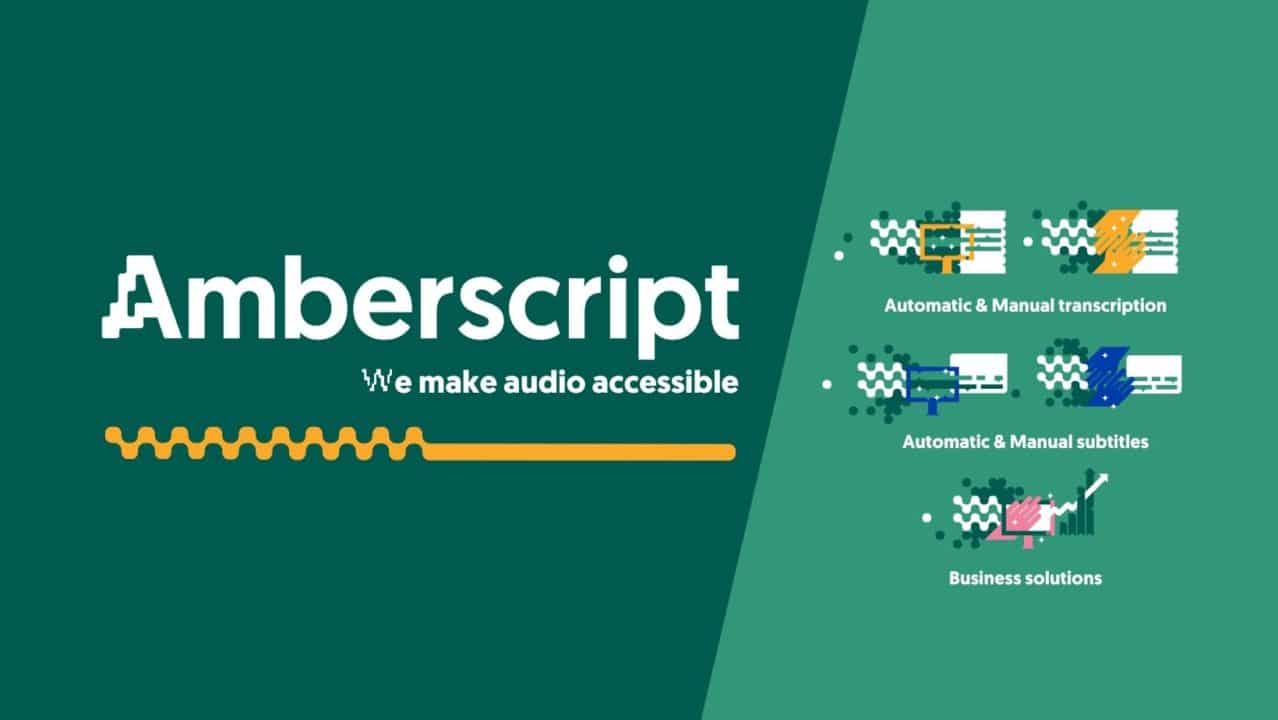
Subtitling and Dubbing Restrictions: How to Choose Your Priorities
Subtitling and dubbing are two methods used to make audiovisual content accessible to wider audiences. While both techniques have their advantages and disadvantages, there are some restrictions that should be considered when choosing which method to prioritize. In this article, we will explore the various factors that influence the decision-making process and provide guidance on how to choose the most appropriate method for your project.
Table of contents
- What are subtitles and dubs
- Considering restrictions when choosing between subtitling and dubbing
- Time and budget constraints
- Target audience and viewing experience
- Legal and technical constraints
- Other things to keep in mind
- Conclusion
- How to make your subtitles or dubs with Amberscript
What are subtitles and dubs?
Subtitling is the process of adding a written translation of spoken dialogue or other audio elements in a video. Subtitles appear at the bottom of the screen and enable viewers to follow along with the dialogue in a language that is not their own.
Dubbing, on the other hand, involves replacing the original audio in a video with a translated version in a different language. This means that voice actors record new dialogue in the target language, and the original audio is removed and replaced with the new version. Dubbing is often used for films, TV shows, and other forms of media that require a high degree of immersion and authenticity for the target audience.
Both subtitling and dubbing are used to make content accessible to viewers who speak different languages or have hearing impairments. However, each method has its own advantages and disadvantages, and it is up to content creators to decide which method is best suited for their needs based on factors such as budget, target audience, and the nature of the content being translated.
For more explanations on subtitles you can check our extensive subtitling guide for more information.
Considering restrictions when choosing between subtitling and dubbing:
When it comes to deciding whether to use subtitles or dubbing for audiovisual content, it is essential to consider the restrictions that may impact your decision. These restrictions can include legal and cultural factors, technical limitations, and budgetary constraints. Ignoring these restrictions could result in legal issues, misinterpretations, or a poor viewing experience for your audience.
Legal and cultural factors are crucial considerations when deciding between subtitling and dubbing. For instance, some countries have regulations mandating that all imported audiovisual content must be dubbed or subtitled in the local language. Similarly, cultural sensitivities may make it inappropriate to dub certain types of content, such as documentaries or news broadcasts, which could be seen as an attempt to manipulate the audience’s perception.
Technical limitations may also affect your decision between subtitling and dubbing. For example, some platforms or devices may not support dubbing or may have limitations that impact the quality of the dubbed audio. In such cases, subtitling may be a more practical solution.
Finally, budgetary constraints must be considered, as dubbing can be a much more expensive option than subtitling. This is particularly true for longer or more complex content, where dubbing costs can quickly escalate. In such cases, subtitling may be the only feasible option.
Overall, it is critical to consider all relevant restrictions when deciding between subtitling and dubbing. This will ensure that your content is legally compliant, culturally appropriate, technically feasible, and financially sustainable, and will provide the best possible viewing experience for your audience.
Time and budget constraints
How much time does it take to get subtitles vs dubs
One crucial factor to consider when deciding between subtitling and dubbing is the time required for each process. Subtitling is generally faster and less expensive than dubbing, as it involves adding written text to the screen that matches the spoken dialogue. This can be a significant advantage when working with tight budgets and deadlines.
In contrast, dubbing requires more time and resources, as it involves recording new audio tracks in the target language and matching them to the original video. This process requires a team of skilled actors, sound engineers, and translators, which can significantly increase the production costs.
However, it is essential to note that the time required for subtitling and dubbing can vary depending on factors such as the length and complexity of the content, the number of languages required, and the quality standards desired. Additionally, some languages may be more challenging to subtitle accurately due to differences in grammar, syntax, and idiomatic expressions, while others may be more difficult to dub due to differences in pronunciation and accent.
Ultimately, the decision between subtitling and dubbing should be based on a careful consideration of the project’s specific needs, goals, and target audience, taking into account factors such as time, budget, cultural sensitivity, and linguistic complexity.
How much does is cost to get subtitles vs dubs
Cost is another important factor to consider when choosing between subtitling and dubbing. Dubbing requires more resources and expertise than subtitling, and therefore tends to be more expensive. The process of dubbing involves hiring professional voice actors, audio engineers, and translators who are experienced in lip-syncing and adapting the script to match the length of the original dialogue.
Subtitling, on the other hand, is generally less expensive as it requires only a qualified translator and a skilled subtitler who can time and format the subtitles appropriately. However, if the source material contains complex technical or specialized vocabulary, the cost of subtitling may increase due to the need for a more specialized translator.
Additionally, it’s important to consider the cost of distribution. Dubbing requires separate audio tracks for each target language, while subtitling only requires the creation of subtitle files. This means that dubbing can be more expensive in terms of storage and distribution costs.
Overall, subtitling is generally the more cost-effective option, particularly for low-budget productions or those with a limited international market. Dubbing can be more expensive, but may be necessary for productions targeting a wider, multilingual audience or those with a higher budget.
Target audience and viewing experience
Do audiences prefer subtitles or dubs?
Audience preferences play a crucial role in deciding whether to use subtitling or dubbing for audio-visual content. In some countries, subtitling is the norm and audiences are used to reading subtitles while watching foreign content. However, in other regions, dubbing is more common, and audiences are more comfortable watching content with dubbed audio.
Factors that may influence audience preferences include age, education level, and familiarity with the target language. For instance, younger audiences tend to prefer dubbing while older viewers may prefer subtitles. Similarly, audiences who have a good understanding of the target language may prefer subtitles as they can appreciate the nuances of the original language, whereas those who struggle with the language may prefer dubbed audio for ease of understanding.
It is important to take the audience preferences into account when choosing between subtitling and dubbing. For instance, if a majority of the target audience prefer subtitles, then it may be more cost-effective and culturally sensitive to use subtitling instead of dubbing. On the other hand, if the majority prefer dubbed audio, then investing in high-quality dubbing may be a better option.
Overall, understanding the audience’s preferences and catering to their needs is essential when deciding between subtitling and dubbing, as it can affect the success of the content and the satisfaction of the viewers.
How does context change the best subtitle or dub method?
Viewing context is another important factor to consider when choosing between subtitling and dubbing. For educational content, such as documentaries or lectures, subtitling may be more appropriate since it allows viewers to read and comprehend the content at their own pace. Additionally, subtitles can be beneficial for viewers who are deaf or hard of hearing, as well as those who speak a different dialect or language than the original audio.
For entertainment content, such as films or television shows, audience preferences may vary. In some countries, dubbing is the norm for all foreign content, while in others, subtitles are preferred. In some cases, the context of the content may also play a role. For example, if a film is meant to be watched as a visual experience, such as an action movie, dubbing may be preferred as it allows viewers to fully focus on the action without the distraction of reading subtitles.
Ultimately, the viewing context and audience preferences should be considered when deciding between subtitling and dubbing. In some cases, it may be appropriate to offer both options to cater to a wider audience.
Do subtitles impact immersion and engagement compared to dubbing?
The choice between subtitling and dubbing can also impact how engaged and immersed viewers are in the content. In general, dubbing can create a more immersive experience for viewers, as they can focus on the visuals and the audio at the same time without the distraction of reading subtitles. However, poorly executed dubbing can also detract from immersion, particularly if the lip-syncing is off or the dubbing is not high quality.
On the other hand, subtitling allows viewers to hear the original audio and can maintain the intended emotional tone and nuances of the language. In some cases, subtitles can enhance immersion by providing context and cultural references that might otherwise be lost in dubbing. However, reading subtitles can also be distracting and can take away from the visual experience of the content.
The choice between subtitling and dubbing can also depend on the type of content and the context in which it will be viewed. For example, educational content may be better served by subtitling, as it allows viewers to see and hear the original language and learn new words and phrases. On the other hand, action-packed movies or TV shows may be better suited for dubbing, as it allows viewers to fully engage in the visual experience without being distracted by reading subtitles.
Ultimately, the choice between subtitling and dubbing depends on the priorities of the content creator and the needs and preferences of the target audience. A thoughtful consideration of these factors can help ensure that the chosen method enhances immersion and engagement, rather than detracting from it.
Legal and technical constraints
What legal requirements are attached to subtitling and dubbing?
Legal requirements for subtitling and dubbing vary by country and region. Some countries may have specific regulations regarding the use of subtitles or dubbing for certain types of content, such as educational or government-related materials.
In the United States, for example, the Americans with Disabilities Act (ADA) requires that any video content provided to the public include closed captions or a transcript for viewers who are deaf or hard of hearing. This means that companies and organizations may be legally required to provide closed captions or dubbing for their videos.
Similarly, some countries have language laws that require certain types of content to be presented in specific languages or dialects. For instance, in Canada, broadcasters must provide programming in both English and French to ensure equal representation of both languages.
It’s important for content creators and distributors to research the legal requirements for subtitling and dubbing in the regions where their content will be shown. Failure to comply with legal requirements can result in fines, legal action, and damage to a company’s reputation.
How to face technical limitations and compatibility issues
Technical limitations and compatibility issues are important factors to consider when deciding between subtitling and dubbing. One of the main challenges with subtitling is ensuring that the subtitles are readable and do not overlap with other visual elements in the video. Additionally, different devices and platforms may have different specifications for subtitle formats and compatibility.
Dubbing, on the other hand, requires more technical expertise and resources, such as recording studios and sound engineers. Matching the lip movements of the dubbed audio with the original video can also be a challenge, which requires careful attention to detail.
It is important to consider technical limitations and compatibility issues when deciding between subtitling and dubbing, as this can impact the quality of the final product and the viewing experience of the audience. In some cases, subtitling may be more practical and cost-effective, while in other cases, dubbing may be the preferred option for certain target audiences or viewing contexts. Ultimately, it is important to balance the technical considerations with the cultural and audience-related factors to choose the best approach for your specific needs.
Other things to keep in mind
Conveying cultural differences
When deciding between subtitling and dubbing, it’s important to consider restrictions such as budget, audience preferences, and legal requirements. Additionally, it’s crucial to prioritize cultural sensitivity when translating content for global audiences. Subtitles should use appropriate language and terminology, and avoid perpetuating harmful biases. Dubbing should strive for accurate lip-syncing and voice matching while also respecting the original intent of the content. Ultimately, the chosen approach should aim to enhance the viewer experience while staying true to the cultural context of the content.
Conveying nuances in language
When translating audiovisual content, there are often nuances in language and meaning that can be lost in translation. Subtitling and dubbing both present their own unique challenges in accurately conveying these nuances. Subtitling must balance brevity with clarity, while dubbing must match the lip movements and emotional tone of the original dialogue. Cultural context and colloquial expressions can also pose challenges in both subtitling and dubbing. It is important for translators to consider the intended audience and cultural context when making translation choices. By taking into account these nuances in language and meaning, translators can ensure that the final product accurately conveys the intended message to the target audience.
Conveying dialects and accents
When considering subtitling versus dubbing, differences in dialect and accents must be taken into account. Dubbing can be a more effective option when dealing with strong regional accents or dialects that may be difficult for non-native speakers to understand. However, dubbing can also potentially erase the cultural authenticity of the original content. Subtitling, on the other hand, allows the audience to hear the original dialogue and maintain the authenticity of the language and accent, but may be challenging for those who have difficulty reading quickly or with the written language. Overall, the decision on whether to use subtitling or dubbing depends on factors such as the target audience, the genre of the content, and the budget available for the project. A nuanced approach to language and accent considerations is necessary to ensure that the content is accurately conveyed and culturally sensitive while still being accessible to the intended audience.
Conclusion
Subtitling and dubbing are two common methods of translating audiovisual content. When choosing between them, it is important to consider factors such as audience preferences, cultural sensitivity, cost, time required, legal requirements, technical limitations, and the viewing context. Subtitling can be more cost-effective and faster than dubbing, but requires careful consideration of language nuances and can impact immersion and engagement. Dubbing, on the other hand, can provide a more immersive experience but is often more expensive and time-consuming. Both subtitling and dubbing require consideration of cultural sensitivity, such as respecting different dialects and accents and avoiding stereotypes. Legal requirements must also be considered, such as accessibility requirements for individuals with disabilities. Technical limitations, such as compatibility with different devices, can also impact the choice between subtitling and dubbing. Ultimately, the decision between subtitling and dubbing will depend on a range of factors, including the specific needs of the target audience and the goals of the content creator.
How to make your subtitles or dubs with Amberscript
Amberscript is your go-to solution for creating accurate and high-quality subtitles and dubs. Our state-of-the-art technology and expert team of professionals can help you create culturally sensitive and engaging content that resonates with your global audience. We use advanced speech recognition and translation tools to deliver fast and accurate results, ensuring that your content is accessible to all. Whether you need subtitles for educational videos or dubs for entertainment content, our team can deliver top-notch results tailored to your specific needs. Trust Amberscript for all your subtitling and dubbing needs and take your content to the next level. f you are interested in Amberscript you can find our dubbing services here, and our subtitling services here.
10 Things to Know Before Starting a YouTube Channel
YouTube is one of the most popular social media platforms worldwide. With over 2 billion active users, the platform provides a massive opportunity for creators to showcase their talents, share their knowledge, and engage with a vast audience. As such, it’s no wonder that so many people are eager to start their own YouTube channels in 2023. However, before you dive in, there are some essential things that you should know.
In this article, we’ll provide an overview of the top 10 things to consider before starting a YouTube channel. So, whether you’re an aspiring vlogger, a business owner, or just someone who wants to share their passion with the world, this article will cover everything you need to know to succeed on YouTube.
Table of contents
- Why should you create a YouTube channel?
- Top tips to know before starting a YouTube channel
- How to subtitle your YouTube videos with Amberscript
- Content ideas for starting a YouTube channel
Why Should You Create a YouTube Channel?
The power of YouTube lies in its ability to connect people from all over the world, creating a platform for individuals and businesses alike to share their passions and ideas with a global audience. By creating a YouTube channel, you open the door to a range of opportunities, including the chance to reach millions of people, develop new skills, and grow your brand.
YouTube also allows you to engage with your viewers in a unique and meaningful way, building a community around your content that can provide valuable feedback, support, and inspiration. Whether you’re looking to make a career out of YouTube or simply want to share your knowledge and talents with the world, starting a YouTube channel is a powerful way to make your mark and connect with people from all walks of life.

Top Tips to Know Before Starting a YouTube Channel
Creating a YouTube channel can be an exciting and rewarding experience, but it can also be challenging when you’re just getting started. With so many channels and creators on the platform, it can be difficult to know where to begin.
Let’s go over the top tips you need to know before starting a YouTube channel. From finding the right niche to promoting your videos and creating subtitles with Amberscript, these tips will help you succeed on YouTube and stand out from the competition.
1. Find the Equipment
Before you start creating content for your YouTube channel, you need to invest in the right equipment. This includes a camera, microphone, lighting, and editing software. You don’t necessarily need to spend a lot of money on expensive equipment, but you should ensure that the gear you use is of good quality. When it comes to choosing your camera, make sure to select one that has high video resolution and image stabilization, to produce clear and stable footage. You should also invest in a good quality microphone, which is essential to ensure your audio is of high quality.
2. Do Competitor Research
To stand out from the crowd, you need to identify what makes your content unique. Doing competitor research can help you identify gaps in the market and determine the types of content that perform well in your niche. You can use tools such as TubeBuddy, Social Blade, and VidIQ to research your competition, including their video views, engagement rates, and subscriber growth. This information can help you understand what works and what doesn’t, and provide inspiration for your own content. However, make sure you are not copying others, just taking inspiration from their content.
3. Find the Right Niche
To succeed on YouTube, it’s essential to find the right niche for your channel. The best way to do this is to identify your passions and interests, and then research what types of content perform well in those areas. You want to find a balance between something you are passionate about and a niche that is not overly crowded. It’s also important to understand your audience and their interests. By finding a specific niche and developing your content around that niche, you can stand out from the crowd and provide real value to your viewers.
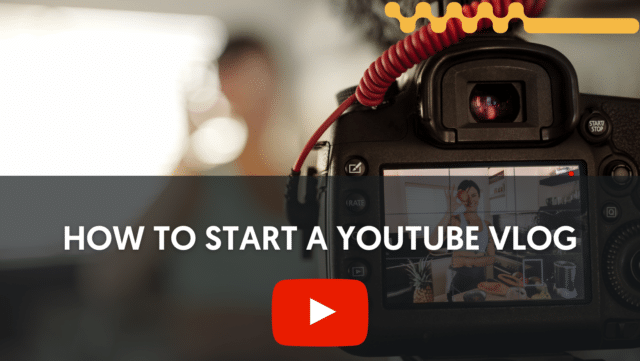
Learn how to start a YouTube channel
Read the blog4. Promote Your Videos
Creating great content is only half the battle. You also need to promote your videos to reach a wider audience. There are several ways to promote your videos, including social media, email newsletters, collaborations with other creators, and paid advertising. Social media is a great way to promote your videos to a wider audience, and to engage with your viewers on a more personal level. Email newsletters can also help you build a loyal following, and collaborations with other creators can help you reach a new audience. The key is to experiment with different promotion strategies and find what works best for your channel.Top of Form
5. Subtitle Your Video (Pro Tip: Add Translated Subtitles to Reach an International Audience)
Subtitling your videos is essential to make your content accessible to a wider audience. Adding subtitles can help people with hearing difficulties, non-native speakers, and those watching in a noisy environment to understand your content better. By adding translated subtitles to your videos, you can also reach an international audience and increase your viewership. Subtitles also help to increase the watch time of your videos, as viewers are more likely to stick around if they can follow along with the content.
Benefits for the Deaf and Hard of Hearing
Subtitling your videos can benefit the deaf and hard of hearing community, as it allows them to follow along with your content without relying on audio. This is essential for creating an inclusive environment and making your content accessible to a wider audience. By adding captions, you are also complying with accessibility laws in many countries, which require video content to be accessible to those with disabilities.
Benefits for Internationals
By adding translated subtitles to your videos, you can make your content accessible to non-native speakers, which is essential for reaching a global audience. This can help you grow your audience, increase engagement, and build a loyal following of fans from all over the world. Providing subtitles can also improve the viewing experience for international viewers, who may struggle to follow along with your content without them.
Benefits for People Unable to Turn Up the Volume
Finally, adding subtitles can benefit people who are unable to turn up the volume on their devices. This could be due to watching videos in public places, or to avoid disturbing others around them. By adding captions, you make it easier for these viewers to follow along with your content and improve the overall viewing experience. This is particularly important for mobile viewers who may be watching in noisy environments, such as on public transport or in a crowded area.
6. Pay Attention to SEO
Search Engine Optimization (SEO) is crucial for your videos to be discovered on YouTube. You can start by finding the right keywords and tags to include in your video titles and descriptions. This will help your videos appear in search results for relevant queries. You should also optimize your video content to increase viewer engagement. This includes using engaging thumbnails, captions, and annotations to keep your audience interested.

Learn how to create YouTube subtitles for SEO purposes
Learn more7. Learn How to Edit Your Videos
Editing is an essential part of creating high-quality videos on YouTube. You don’t need to be a professional editor to create great content, but you should learn the basics of video editing software. This includes understanding how to trim and cut footage, add transitions, and use effects to enhance your content. There are plenty of free and paid editing software available to use, so you can find the one that best suits your needs. Also, make sure to learn how to color grade your videos, as this can have a significant impact on the overall look and feel of your content.
8. Plan Your Content Ahead
To keep your audience engaged, it’s essential to plan your content ahead of time. Creating a content calendar can help you stay organized and ensure that you’re consistently publishing content that resonates with your audience. Planning your content ahead can also help you be more efficient in your production process, by allowing you to batch record and schedule content in advance. When planning your content, make sure to consider your audience’s interests and feedback, so you can create content that meets their needs and expectations.
9. Be Consistent with Posting
Consistency is key to building a successful YouTube channel. You need to publish content on a regular schedule to keep your audience engaged and growing. Whether you choose to post daily, weekly, or monthly, it’s essential to be consistent and to stick to your posting schedule. This will help your audience know when to expect new content from you, and it will help you stay organized and focused on creating great content.
10. Use the Reactions for Creating Better Content
Reactions are a great way to learn from your audience and improve your content. You can use the comments and reactions to understand what your audience likes and dislikes about your videos, and to get ideas for new content. This feedback can help you improve your videos over time and ensure that you’re creating content that resonates with your audience. You can also use reactions to create engagement opportunities, such as hosting Q&A sessions or answering fan mail.
How to Subtitle Your YouTube Videos with Amberscript
As mentioned, adding subtitles to your YouTube videos is essential for making your content accessible to a wider audience. Amberscript is an excellent tool that you can use to add subtitles to your videos quickly and easily. Here’s how you can use Amberscript to subtitle your YouTube videos:
Subtitling Services
Amberscript offers different subtitling services to fit your needs. You can choose from machine-made, human-made, or translated subtitling services. Machine-made subtitles are generated automatically by Amberscript’s AI-powered transcription technology, while human-made subtitles are created by professional transcriptionists. Translated subtitles are available in over 40 languages and are ideal for reaching a global audience.
How to create subtitles and captions with Amberscript

How It Works
To add subtitles to your YouTube videos using Amberscript, all you need to do is follow a few simple steps:
- Upload: First, upload your video to the Amberscript platform.
- Let Our AI Generate the Subtitles: Once your video is uploaded, Amberscript’s AI-powered transcription technology can generate subtitles for your video automatically.
- Edit the Automatically Generated Subtitles: You can then edit the automatically generated subtitles to ensure that they are accurate and error-free. You can also adjust the timing and formatting of the subtitles to match your video.
- Export: Finally, export the subtitles in the format of your choice and upload them to your YouTube video. You can also download the subtitles and use them on other video-sharing platforms or for other purposes.
Using Amberscript to add subtitles to your YouTube videos is a simple and effective way to make your content accessible to a wider audience. Whether you choose machine-made, human-made, or translated subtitling services, Amberscript makes it easy to create high-quality subtitles for your videos.
Content Ideas for Starting a YouTube Channel
Starting a YouTube channel can be exciting, but it can also be challenging to come up with fresh and engaging content ideas. Here are some content ideas to help you get started on the platform:
- Travel Vlogs: Share your adventures and experiences with your audience by creating travel vlogs. This can include showcasing different destinations, local cultures, and cuisines.
- Tutorials: Teach your viewers something new by creating tutorials. This can include anything from makeup tutorials to coding lessons and can be a great way to showcase your expertise and knowledge.
- Product Videos: Create product review videos to showcase different products and services to your audience. This can include product demonstrations, comparisons, and recommendations.
- Reaction Videos: React to viral videos, music, and other content to engage with your audience and provide entertaining content. This can include watching and reacting to funny or emotional videos.
- Gaming: Share your love for gaming by creating gaming videos. This can include walkthroughs, reviews, and live streams of your gameplay.
- DIY Videos: Showcase your creativity and DIY skills by creating DIY videos. This can include crafting, home improvement, and fashion projects.
- Workout Videos: Help your audience stay healthy and active by creating workout videos. This can include yoga, dance, and other types of exercise videos.
- Cooking Videos: Share your passion for cooking and food by creating cooking videos. This can include recipe demonstrations, cooking challenges, and cooking tips.
- Reviews: Share your opinion on products, services, and experiences by creating review videos. This can include book reviews, restaurant reviews, and movie reviews.
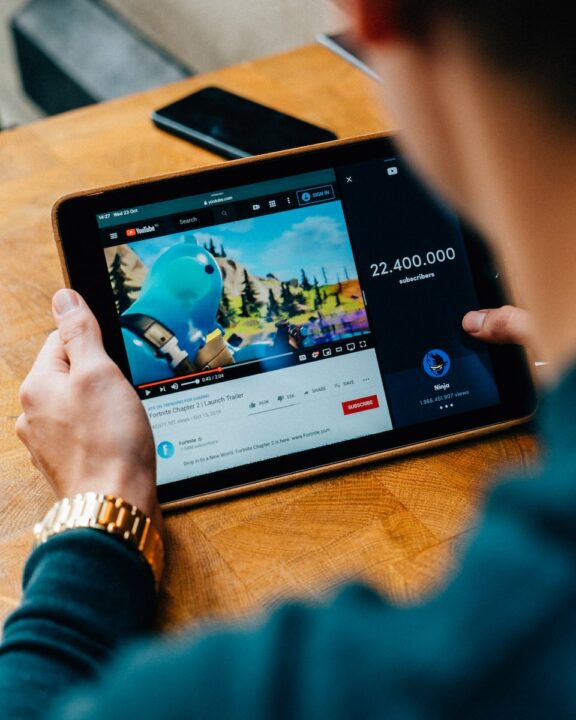
Remember, the most important thing is to create content that you are passionate about and that resonates with your audience. By finding the right content ideas and creating engaging content, you can build a loyal following on YouTube and establish yourself as an authority in your niche.
Key Takeaways
Starting a YouTube channel can be challenging, but with the right approach, you can create engaging content and build a loyal following. Here are some key takeaways to keep in mind when starting a YouTube channel:
- Find the Right Equipment: Invest in the right equipment to create high-quality videos that will keep your audience engaged.
- Research Your Competitors: Learn from your competitors and see what’s working for them in terms of content, style, and strategy.
- Find the Right Niche: Focus on a specific niche and create content that resonates with your audience.
- Promote Your Videos: Use social media and other channels to promote your videos and grow your audience.
- Subtitle Your Videos: Make your content accessible to a wider audience by adding subtitles to your videos. Consider using Amberscript to create high-quality subtitles quickly and easily.
- Pay Attention to SEO: Use best practices for SEO to ensure that your videos are discovered by viewers who are interested in your content.
- Learn How to Edit Your Videos: Editing is an essential part of creating high-quality videos. Learn the basics of video editing software to create engaging content.
- Plan Your Content Ahead: Create a content calendar to stay organized and ensure that you’re consistently publishing content that resonates with your audience.
- Be Consistent with Posting: Post on a regular schedule to keep your audience engaged and growing.
- Use Reactions for Creating Better Content: Use comments and reactions to learn from your audience and improve your content over time.
By following these tips, you can create high-quality content that engages your audience and grows your YouTube channel over time. With persistence and dedication, you can establish yourself as a trusted authority in your niche and build a loyal following of fans who love your content. And remember, when it comes time to add your subtitles, be sure to check out Amberscript.
Subtitles for e-learning: How you make online courses more engaging
Online education has grown tremendously in recent years. This can be attributed to the flexibility, accessibility, and cost-effectiveness that online courses offer students.
As eLearning continues to grow in popularity, it’s important to make sure that your online courses are as engaging as possible to retain student attention and maximize learning outcomes. But how can you make your online courses more engaging?
In this article, we will explore the benefits of subtitling eLearning courses, and explain how subtitles can be used to improve accessibility, engagement, and the overall experience for both students and instructors.
Table of contents
- What is e-learning?
- 4 ways to make e-learning courses more engaging
- How to get SRT or VTT files for your online courses with Amberscript
- Benefits of subtitling e-learning courses
- 4 tips when subtitling e-learning courses
What is e-learning?
e-Learning refers to any form of learning that takes place through electronic devices, such as computers, smartphones, and tablets. Over the past few years, e-Learning has emerged as a popular and convenient alternative to traditional classroom-based education. With the increasing availability of high-speed internet and online learning platforms, it’s now easier than ever for students to access quality education from anywhere, at any time.
At its core, e-Learning is about leveraging technology to enhance the learning experience. This can mean anything from delivering course materials through interactive multimedia platforms to incorporating virtual reality simulations and online discussions into the curriculum. By providing students with engaging and interactive experiences, e-Learning has the potential to make education more accessible, enjoyable, and effective.
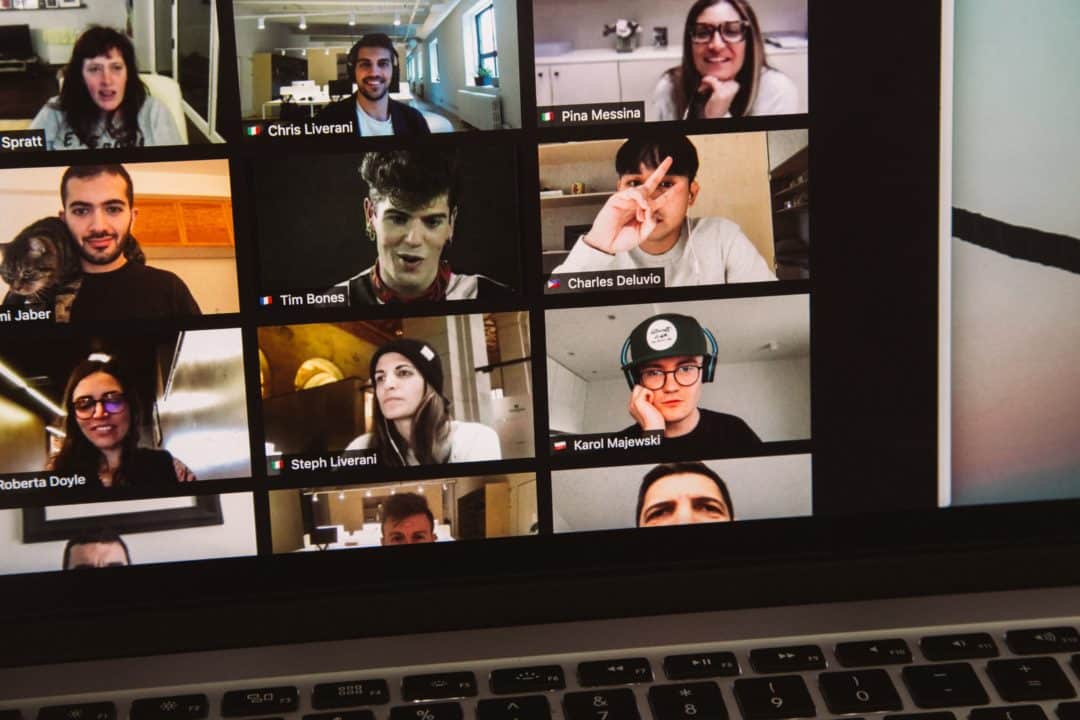
Advantages of e-learning
One of the key benefits of e-Learning is that it allows students to set their own pace. Unlike traditional classroom-based education, where everyone is expected to move at the same speed, e-Learning provides students with the flexibility to learn at a pace that works best for them. This can be especially beneficial for those who struggle with traditional learning methods or who have busy schedules that make it difficult to attend regular classes.
Another advantage of e-Learning is that it offers access to a wealth of educational resources and content. With the power of the internet, students can tap into a virtually limitless source of information and knowledge, from online textbooks and video tutorials to online forums and discussion boards. This can help students better understand complex concepts and gain a deeper understanding of the subject matter.
4 ways to make e-learning courses more engaging
To make your eLearning courses more engaging, it’s important to understand your target audience and set clear learning objectives. Interactive design and visually appealing content can also help keep your students engaged. Subtitles are another key component when it comes to improving the quality of your courses. But how do you bring these things together to enhance your course content?
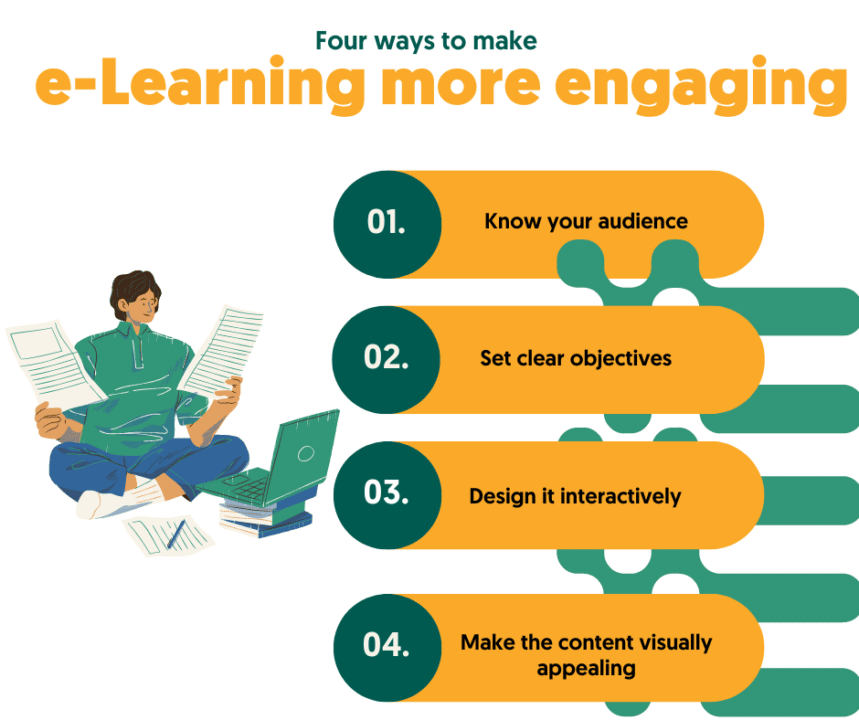
Here are four ways that you can make your online course material much more engaging for your students:
1. Know your audience
Before designing an eLearning course, it’s important to understand who the target audience is. This information can be used to tailor the content and design of the course to meet the specific needs of the students. By understanding the target audience, you can create a course that is relevant, engaging, and accessible.
2. Set clear objectives
It’s also important to set clear learning objectives for the course. This will help to ensure that the course content is focused and relevant and will help students stay engaged throughout the course. By setting clear objectives, you can also ensure that the course is meeting the needs of the students, and that they are able to achieve their learning goals.
3. Design it interactively
Designing an eLearning course that is interactive and engaging is essential to keeping students interested and focused. This can be achieved through the use of videos, podcasts, interactive quizzes, and other multimedia elements. An interactive course design can help to break up the monotony of reading long texts and can keep students engaged throughout the course.
4. Make the content visually appealing
A key aspect of making e-Learning courses more engaging is making the content visually appealing. One important aspect of this is providing subtitles for videos and audio content. Subtitles can help to make e-Learning courses accessible to all learners, regardless of their language or hearing abilities. They also provide a valuable resource for learners who need to review the content at a later time.
How to get an SRT or VTT file for your online course with Amberscript
Subtitling your e-Learning courses is an important step in making your content accessible and engaging to a wider audience. However, creating subtitles manually can be time-consuming and may not be feasible for everyone. That’s where Amberscript comes in. In this section, we’ll show you how to get a SRT or VTT file for your online course with Amberscript, the leading automatic subtitle solution.
What is a SRT or VTT file?
SRT (SubRip Text) and VTT (Web Video Text Tracks) are both types of subtitle files that are commonly used for eLearning courses. These files contain the text of the subtitles along with timing information, which allows them to be synced up with the audio of the video.
SRT files are the most widely used format for subtitles and are supported by most video players and streaming services. On the other hand, VTT files are becoming increasingly popular because they offer more advanced features, such as the ability to add styles to the subtitles and to control their display on different devices.
Both SRT and VTT files are plain text files, which means they can be easily edited and customized to meet your specific needs. For example, you could adjust the timing of the subtitles to match the pace of your video or add extra text to help clarify a particularly complex concept.

Learn more about SRT files
Read the blogThe automatic subtitle process of Amberscript
If you’re looking for an easy and efficient way to add subtitles to your eLearning courses, consider using a service like Amberscript. Amberscript is an innovative platform that uses cutting-edge speech-to-text technology to automatically generate accurate and professional-looking subtitles for your videos. With just a few clicks, you can have high-quality subtitles that will enhance your eLearning courses.
The process of creating automatic subtitles with Amberscript is simple and straightforward. First, you upload your video or audio files to the platform, and then Amberscript uses its speech recognition technology to transcribe the audio. Next, you can edit the transcript to make sure it’s accurate and matches your desired style. Finally, you can export the subtitles in either SRT or VTT (and many more) format and integrate them into your course.
What’s even better about Amberscript is that it’s fast and reliable. In most cases, you can have your subtitles generated and ready to use in just a few minutes. Plus, because the speech-to-text technology is so accurate, you won’t have to spend hours correcting mistakes. This can save you time and effort, allowing you to focus on what really matters: creating high-quality eLearning courses that inspire your students.

Request a quote
Benefits of subtitling e-learning courses
Subtitling eLearning courses offers numerous benefits, including improved accessibility, engagement, and understanding for students. Subtitling can also help you open up the course to a wider audience, boost SEO, and make the course content recyclable so that it can be used with other mediums like blogs and podcasts as well.
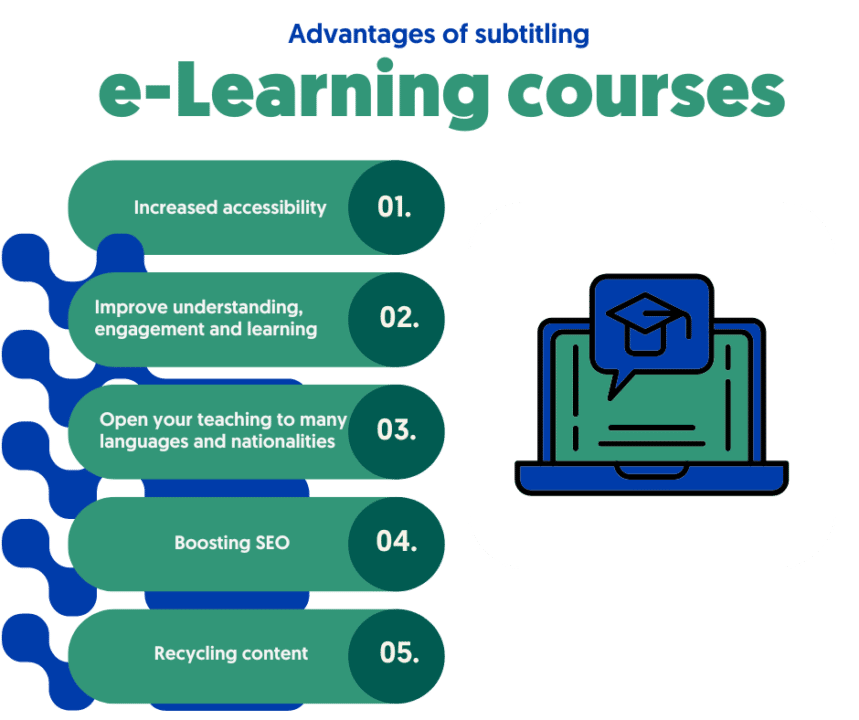
Increasing accessibility
One of the biggest benefits of adding subtitles to your eLearning course is increased accessibility. Subtitles make it possible for people who are hearing-impaired, deaf, or hard-of-hearing to fully engage with your content. This means that you are not only reaching a wider audience, but you are also making your course more inclusive and accommodating to those who may otherwise have trouble following along.
Improving understanding, engagement and learning
Another major benefit of adding subtitles to your eLearning course is improved understanding, engagement, and learning. This is because subtitles provide a visual representation of the audio content, making it easier for people to follow along and understand the material being taught. This can greatly improve engagement and learning, as well as help to boost the overall quality of your course.
Subtitles can also help to keep learners engaged by breaking up the audio content into smaller, more manageable chunks. This makes it easier for learners to focus on specific parts of the course and retain the information being taught. Plus, subtitles can even help increase retention and the recall of information because visual content provides another means of reinforcing the material being taught.
Open your teaching to many languages and nationalities
Subtitles can also be translated into different languages, which opens up your course to an even wider audience. This is especially important if you are trying to reach a global audience, as many people may not be fluent in the language your course is taught in. This can greatly increase engagement and participation, as well as help to build your reputation as an inclusive and accessible provider of eLearning content.
This can greatly increase engagement and participation, as well as help to build your reputation as an inclusive and accessible provider of eLearning content. Offering your course in multiple languages can also help increase your reach and impact, as you are able to reach a wider audience of learners. This is likely to result in more revenue from your online learning modules.
Boosting SEO
Adding subtitles to your eLearning courses can do wonders for your search engine optimization (SEO). It gives search engines a transcript of your video which can help the bots that index content better understand what your course is about. This leads to increased visibility, higher search engine rankings, and greater engagement with your eLearning courses.
Incorporating subtitles also makes your content more discoverable. Your students can easily search for specific terms within the subtitles, making it easier for them to find the information they need. This can help drive more organic traffic to your course and increase your reach, especially on eLearning platforms that use algorithms to index course content based on keywords.
Recycling content
Subtitles not only make your eLearning courses more accessible and SEO-friendly, but they also offer an opportunity to recycle your content. You can repurpose your eLearning videos by using the subtitles to create new types of content, such as written articles or social media posts. This can save you time and effort in creating new content and increase the value you get from your eLearning courses.
For example, you could take the transcript of your video and use it to create a written article that covers the same material. Or, you could use quotes from your video and turn them into social media posts. These new types of content can reach different audiences and drive more traffic to your course. So, not only do subtitles make your eLearning courses more engaging and accessible, but they also provide a way to maximize the value of your content.
4 tips when subtitling e-learning courses
When it comes to subtitling videos and e-Learning courses, there are certain key factors that can greatly impact the overall viewing experience for your learners. Whether it’s the pace of the subtitles, the contrast, the readability, or the placement, these elements can all contribute to a more engaging and accessible learning experience.

Here are four tips that will help you ensure your subtitles are the best they can be for your e-Learning courses:
1. Pace
The first tip when subtitling e-Learning courses is to ensure the pace of the subtitles matches the pace of the audio. This will help learners keep up with the content and not miss important information. To achieve this, use software that automatically matches the timing of the subtitles to the audio or use a transcribing service to create the subtitles manually.
2. Contrast
The next tip is to make sure the font and color of the subtitles provide enough contrast with the background. This will make the subtitles easily readable for learners, and they will not have to strain their eyes to understand the content. Using a high-contrast font, such as Arial or Calibri, and choosing a contrasting color such as white on a dark background, can help achieve this.
3. K.I.S.S. (keep it super simple)
The third tip is to keep the language of the subtitles simple and easy to understand. The goal is to help learners focus on the content, not the language. Avoid using complex sentences, technical terms, and jargon, and instead, use simple, everyday language that is easy to follow.
4. Placement
Finally, it is important to place the subtitles in a position that does not obstruct important visuals in the video. Learners should be able to watch and read the subtitles at the same time, without missing important information. A common practice is to place the subtitles at the bottom of the screen, but this may also depend on the specific video and its content.
Conclusion
e-Learning has become increasingly important in recent years and with the growing demand for online courses, it’s more important than ever to make sure that your courses are engaging, accessible, and effective.
Subtitling is one way to accomplish this. By providing subtitles, you not only make your courses more accessible to a wider range of learners, but you also increase engagement, boost SEO, and gain the option of recycling your content for blog posts, social media, podcasts, and so on.
Remember, pace, contrast, simplicity, and placement are all key factors when subtitling e-Learning courses. By keeping these tips in mind, you can ensure that your subtitles will help to enhance the overall learning experience for your students.
Also, keep in mind that with the help of tools like Amberscript, creating accurate and professional subtitles for your e-Learning courses has never been easier. To get started, be sure to check out Amberscript today.
Frequently asked questions
-
Can I add a glossary with specific words to the transcription job?
Yes, we also offer specialized transcription, which can include jargon or specific vocabulary. To learn more about this or discuss specifics, please contact us.
-
Do you add timestamps?
Yes, timestamps are included in the transcript.You can choose to export the transcript with or without timestamps.
-
Can I burn the subtitles directly onto my video?
If you have exported the transcript as a SRT, EBU-STL or VTT file, you can easily burn them onto your video using video-editing software.
-
Can I burn the subtitles directly onto my video?
If you have exported the transcript as a SRT, EBU-STL or VTT file, you can easily burn them onto your video using video-editing software.
-
Can I translate my subtitles and transcriptions via your app?
No, translation is not available in the automatic services but you can order translated manual subtitles services on our platform. Unfortunately, we do not offer translated manual transcriptions. Please check our prices here.
-
How do I add subtitles to a video?
Upload your video file, request the transcription and export your transcript in a subtitlle compatible file format. We have a step-by-step guide on how to create subtitles and add them to your video. You can read more about it here!
-
How do I export my subtitles?
Once your file is ready and available in your account, you can simply click on the file name and then select the “export file” button at the top left of the page. You can then select the file format, style of sutitles (between BBC and Netflix) and alignment. Please note that you can only export a file if you have validated your email address when creating an account.
The History of Subtitles: Past, Present and Future
Subtitles are a crucial aspect of the entertainment industry. They make films, TV shows, and other audio-visual content accessible to a wider audience, regardless of language barriers.
In today’s digital world, where content is being consumed by people from all corners of the world, subtitles play a crucial role in making sure that everyone can enjoy the same content regardless of their native language.
In this article, we will delve into the history of subtitles, exploring how they have evolved over time, and look at what the future holds for the subtitling industry.
Table of contents
- What are subtitles?
- The difference between subtitles, captions, translated subtitles and SDH subtitles
- The history of subtitles: the past
- The history of subtitles: the present
- The biggest changes in subtitles
- Advantages of using modern-day subtitles
- Tips for great subtitles on the Amberscript platform
- What does the future of subtitles have in store for us?
What are subtitles?
Subtitles are basically text versions of the dialogue in a video. They are designed to help audiences understand what the characters are saying, especially if the original language is different from the viewer’s language.
Subtitles can be displayed on the bottom of the screen, or they can appear as text overlaid on the video itself. In most cases, subtitles are displayed in real-time with the audio, making it easier for the audience to follow along.
The use of subtitles has become increasingly widespread in recent years, with more and more people consuming content from all over the world. Subtitles make it possible for viewers to enjoy content that they would otherwise miss out on, due to language barriers. Whether it’s watching a foreign film or catching up on the latest TV show from another country, subtitles are a crucial tool that enables us to enjoy a wider range of content.

The difference between Subtitles, Captions, Translated Subtitles, and SDH Subtitles
With so many different types of subtitles available, it’s important to understand the differences between them. In this section, we’ll take a closer look at three of the most common types of subtitles: captions, translated subtitles, and SDH subtitles.
Captions
Captions are similar to subtitles but are intended to provide additional information to the audience. They typically include not just the dialogue, but also other sounds in the scene, such as music, sound effects, and speaker identification.
Captions are usually created for the deaf or hard-of-hearing and are designed to provide as much information as possible about the audio portion of the program. Like subtitles, they are typically placed at the bottom of the screen and are usually synchronized with the dialogue and other sounds in the scene.
Translated subtitles
Translated subtitles are subtitles that have been translated from one language into another. They are typically created for international releases of films and television programs and are intended to help non-native speakers understand the content.
In most cases, translated subtitles are created by professional translators who specialize in subtitling and are carefully crafted to accurately reflect the content and tone of the original language. Like other forms of subtitles, they are most often placed at the bottom of the screen and are synchronized with the dialogue in each scene.
SDH subtitles
SDH subtitles, or Subtitles for the Deaf and Hard-of-Hearing, are a type of captioning that provide additional information to the deaf or hard-of-hearing audience. SDH subtitles typically include not just the dialogue, but also other sounds in the scene, such as music, sound effects, and speaker identification.
They are usually created for the deaf or hard-of-hearing and are designed to provide as much information as possible about the audio portion of the program. This makes it much easier for people with hearing impairments to watch, understand, and enjoy video content that would otherwise be inaccessible to them.
Learn more about the difference between the types of subtitles
Learn moreThe history of subtitles: the Past
The history of subtitles can be traced back to the early days of cinema when silent films were first screened. In those days, films were often accompanied by live music, with the audience relying on the musical score to understand the mood and tone of the film.
As films became more complex and started to incorporate dialogue, it became clear that some form of text was needed to help the audience understand what was being said. This led to the development of intertitles, which were short pieces of text that were displayed between scenes.
The first intertitles were simple, with basic text that was added to help the audience understand the story. Over time, however, intertitles became more sophisticated, incorporating graphics, animation, and other visual elements to help tell the story.
In the 1930s, the first sound films were introduced, and the use of intertitles began to decline. Instead, subtitles were used to provide a translation of the dialogue, making it possible for audiences in different countries to understand the film.
During the 1950s and 1960s, subtitles continued to evolve, with the introduction of new technologies that made it easier to create and edit subtitles. With the advent of television, the demand for subtitles increased, and new subtitling techniques were developed to help make subtitled content more accessible to the wider audience.
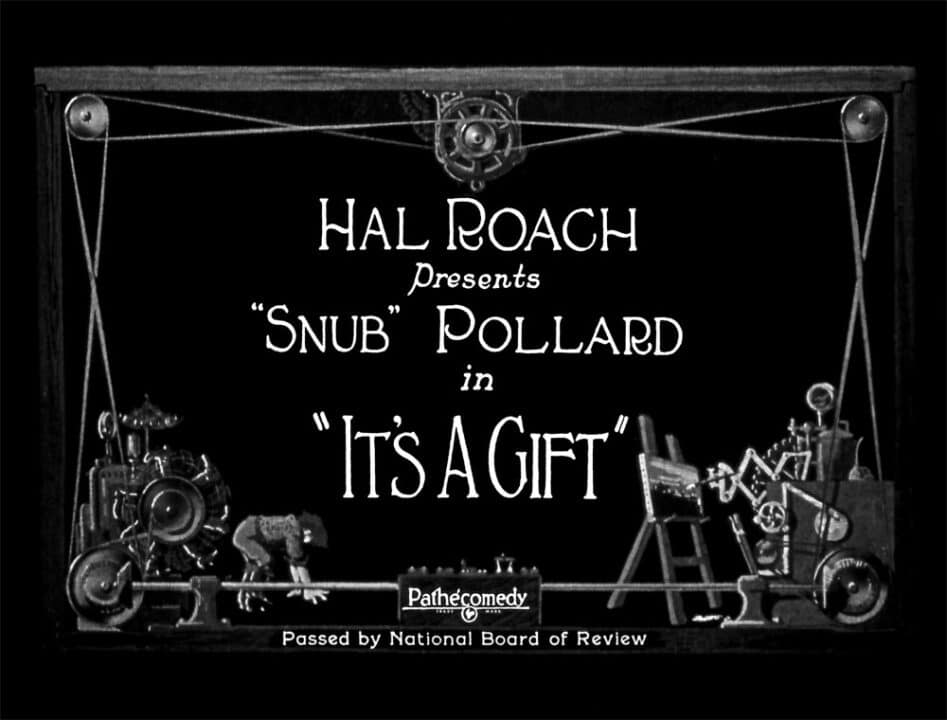
Throughout the 1970s and 1980s, the subtitling industry continued to grow, with the introduction of new technologies and tools that made it easier to create and edit subtitles. With the rise of cable and satellite television, the demand for high-quality subtitles increased dramatically, leading to the development of new subtitling techniques and standards.
The history of subtitles has been a long and interesting one, with new techniques and technologies emerging over the years to help make audio-visual content more accessible to the wider audience. From the simple intertitles of the early days of cinema, to the sophisticated subtitling techniques of today, the subtitling industry has come a long way, and continues to evolve to meet the needs audiences everywhere.
The history of subtitles: the Present
The subtitling industry has undergone significant changes in the present day, with new technology and approaches transforming the way subtitles are created, edited, and delivered to the audience.
One of the biggest changes in the present-day subtitling industry is the use of digital technology. With the increasing popularity of digital platforms, the demand for subtitles has increased dramatically. This has led to the development of new software and tools that make it easier to create and edit subtitles, as well as new methods for delivering subtitles to the audience.

Another significant change in the subtitling industry has been the increasing demand for high-quality subtitles. With the increasing competition in the entertainment industry, content creators are under pressure to produce high-quality content that appeals to a wider audience. This has led to an increase in the demand for professional subtitling services, which can provide high-quality subtitles that meet the needs of the content and the audience.
Another change in the industry has been the increasing use of cloud-based technologies. With the advent of cloud computing, it’s now possible to store and manage subtitles in the cloud, making it easier to access and edit subtitles from anywhere in the world. This has led to the development of new subtitling tools and services that can help content creators create, edit, and manage subtitles more efficiently.
The increasing popularity of streaming services has also had a big impact on the subtitling industry. With more and more people relying on streaming services for their entertainment needs, the demand for high-quality subtitles has increased dramatically. This has led to the development of new tools and services that can help content creators create and deliver subtitles more efficiently, ensuring that their content is accessible to a wider audience.
Learn more about how to create subtitles
Find out moreThe biggest changes in subtitles
One of the biggest changes in the subtitling industry has been the shift towards machine translation. With the advancements in artificial intelligence and natural language processing, machine translation has become a viable option for translating subtitles. While machine translation is still not perfect, it has made it easier for content creators to reach a wider audience, by translating their content into multiple languages.
Another change in the industry has been the increasing use of closed captions. Closed captions are subtitles that can be turned on or off, depending on the viewer’s preference. They are especially useful for people who are hard of hearing or deaf, as they provide a transcript of the audio that they would otherwise miss. With the increasing popularity of streaming services, closed captions have become an even more important aspect of the subtitling industry.
Advantages of using modern-day subtitles
With the advancement of technology, modern-day subtitles have several advantages over the traditional subtitles of the past. Let’s take a closer look at some of the key benefits of using these modern-day subtitles in your video content.
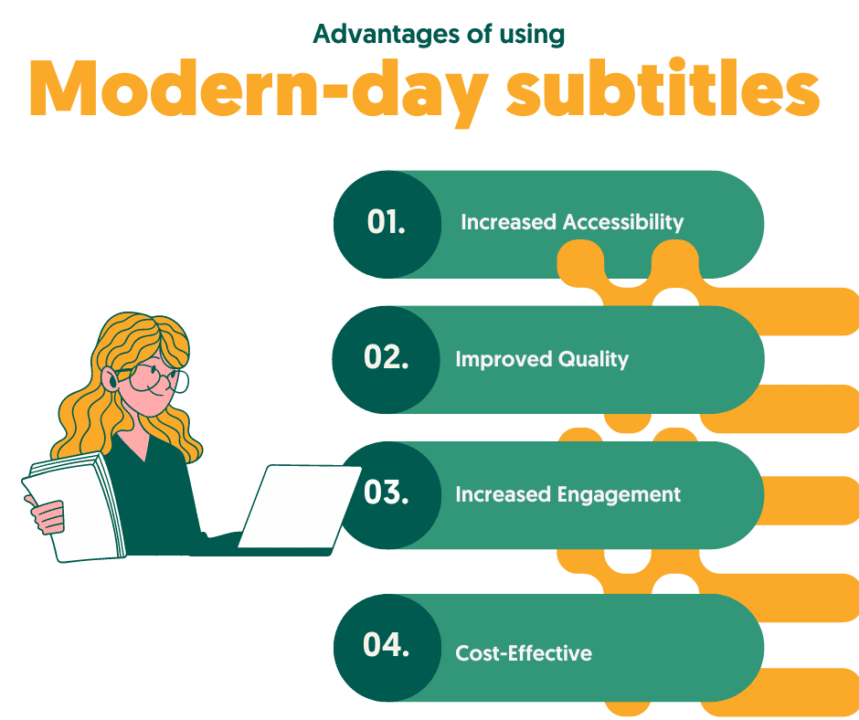
Increased Accessibility
One of the biggest advantages of modern-day subtitles is the increased accessibility they provide. With the use of closed captions and SDH subtitles, individuals who are deaf or hard-of-hearing can now enjoy television and film content without missing any of the important audio information.
Modern-day subtitles are also now available in multiple languages, making it easier for non-native speakers to understand and enjoy international content. This increased accessibility has helped to bridge the language barrier and bring people from different cultures together.
Improved Quality
Another advantage of modern-day subtitles is the improved quality they offer. With advanced subtitling software and tools, subtitlers are now able to create more accurate and precise subtitles than ever before.
Modern-day subtitles also able offer more options for customization, such as the ability to choose the size, color, and font of the subtitles. These customization options make it easier for viewers to adjust the subtitles to their individual preferences and improve their overall viewing experience.
Increased Engagement
By allowing viewers to follow the dialogue and other audio information in real-time, subtitles can help to keep viewers more fully engaged and invested in the content they are watching. This increased engagement can also help to improve the overall impact of the content, as viewers are better able to understand and retain the information being presented.
Cost-Effective
Modern-day subtitles are often much more cost-effective than the traditional subtitling methods used in the past. With advances in technology and automation, the subtitling process can now be completed more quickly and efficiently, reducing the time and costs associated with traditional subtitling methods. This allows content creators who may not have a huge budget to provide higher quality content to their audiences.
Tips for great subtitles on the Amberscript platform
Amberscript is a great choice for those who need to add subtitles to their videos. It provides a user-friendly interface, compatibility with a variety of devices, and a range of customization options to help users create engaging and effective subtitles. Here are some tips to help you create great subtitles on the Amberscript platform:
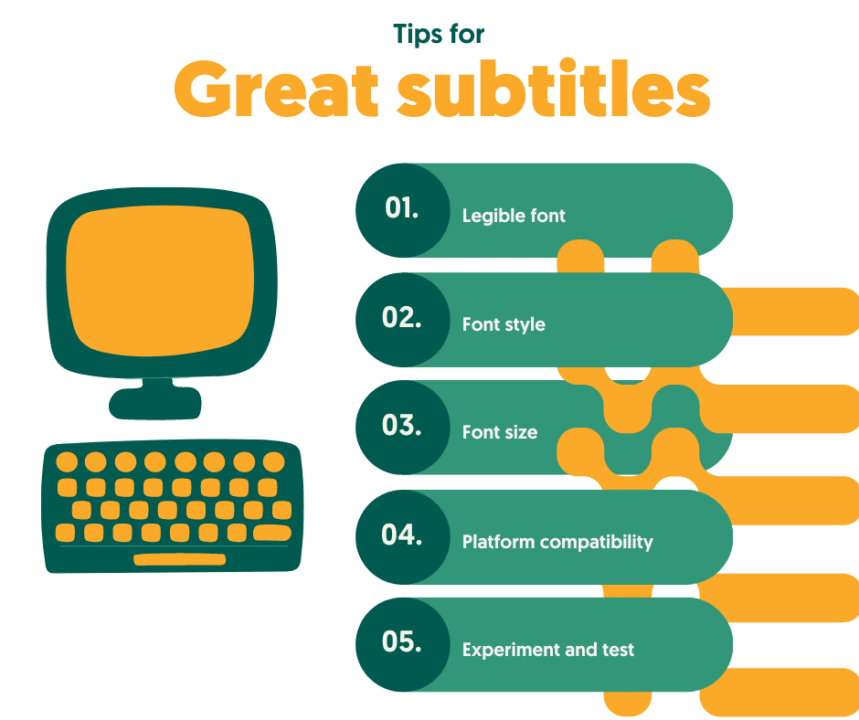
Make sure the font is legible
When choosing a font for your video subtitles, it’s important to prioritize legibility. Pick a font that is easy to read and clear, especially for non-native speakers or people with visual impairments. A font that is too decorative or stylized may be difficult to read, making your subtitles less effective. Amberscript recommends the following fonts: Arial, Roboto, Times New Roman, Verdana, Tiresias, Antique Olive, Futura, and Helvetica.
Consider the font style
Different font styles convey different emotions and impressions, so choose a font style that fits the tone and theme of your video. For example, a sans-serif font may be more modern and sleeker, while a serif font may be more traditional and formal. Consider the overall aesthetic of your video and choose a font style that complements it.
Choose the right size
Subtitle font size should be big enough to be easily readable on all screens, but not so big that it takes over the video. A font size that is too small may be difficult to read, while a font size that is too large may overpower the video. Experiment with different font sizes to find the right balance for your video.
Check compatibility with the platform
Make sure the font you choose is compatible with Amberscript, and if not, find a similar font that is. Using a font that is not compatible with the platform may result in errors or problems with the display, so it’s important to check beforehand to avoid any issues.
Experiment and test
Try different fonts and styles and ask for feedback from others to see which font works best for your video. You may also want to test how the font looks on different devices and screen sizes to ensure maximum readability. By experimenting and testing different options, you can find the perfect font for your video subtitles.
What does the future of subtitles have in store for us?
The future of subtitles looks bright, with several exciting advancements on the horizon. One of the biggest changes we can expect is the continued evolution of machine translation technology, which will make it even easier to translate subtitles into multiple languages.
Another change we can expect is the increased use of AI-powered subtitling tools. These tools will make it easier for content creators to add and edit subtitles, by using artificial intelligence to generate accurate and high-quality subtitles.
Finally, with the increasing popularity of virtual and augmented reality, we can expect to see an increased use of subtitles in these new forms of media. Whether it’s in virtual reality games or augmented reality experiences, subtitles will play a crucial role in making these new forms of content accessible to a wider audience.
Conclusion
Subtitles have come a long way. From the early days of intertitles in silent films, to the sophisticated technology of today’s subtitles, the subtitling industry has evolved dramatically. Subtitles continue to play a crucial role in making audio-visual content accessible to a wider audience, and with exciting advancements on the horizon, the future of subtitles looks promising.
If you are a content creator looking to add subtitles or captions to your video content, then be sure to check out Amberscript. With a ton of helpful tools available, Amberscript makes it easy for anyone to create, edit, and add professional and high-quality subtitles to their video content, which creates a better viewing experience for audiences everywhere.
Frequently asked questions
-
Can I add a glossary with specific words to the transcription job?
Yes, we also offer specialized transcription, which can include jargon or specific vocabulary. To learn more about this or discuss specifics, please contact us.
-
Do you add timestamps?
Yes, timestamps are included in the transcript.You can choose to export the transcript with or without timestamps.
-
Can I burn the subtitles directly onto my video?
If you have exported the transcript as a SRT, EBU-STL or VTT file, you can easily burn them onto your video using video-editing software.
-
Can I burn the subtitles directly onto my video?
If you have exported the transcript as a SRT, EBU-STL or VTT file, you can easily burn them onto your video using video-editing software.
-
Can I translate my subtitles and transcriptions via your app?
No, translation is not available in the automatic services but you can order translated manual subtitles services on our platform. Unfortunately, we do not offer translated manual transcriptions. Please check our prices here.
-
How do I add subtitles to a video?
Upload your video file, request the transcription and export your transcript in a subtitlle compatible file format. We have a step-by-step guide on how to create subtitles and add them to your video. You can read more about it here!
-
How do I export my subtitles?
Once your file is ready and available in your account, you can simply click on the file name and then select the “export file” button at the top left of the page. You can then select the file format, style of sutitles (between BBC and Netflix) and alignment. Please note that you can only export a file if you have validated your email address when creating an account.
What’s the difference between captioning and transcription?
The audio-to-text world can be a confusing place. Should you be captioning your content or providing viewers with a transcript? Even when you decide on what will work best with your content, how should you go about creating the text? What even is the difference between captioning and transcription in the first place?
In this article, we’ll explain the difference between captioning and transcription, how to create captions and transcripts for your content, the benefits of audio-to-text for different industries, and which software to use.
The difference between captioning and transcription:
Transcription is the process of converting voice or audio into a written, plain text document. The transcript will not have any time information linked to it because it is the plain-text result of transcription.
Captioning is the act of splitting transcript text into chunks (known as “caption frames”) and time-coding each frame to synchronize with video audio. Output is often displayed at the bottom of a video screen and should always portray speech and sound effects, identify speakers, and account for any sound that is not visible. The transcript is used to make the caption.
Transcription vs. Captioning in depth
What are transcriptions?
Transcription, also known as transcribing, is the process of transforming audio-to-text. When you have recorded content, whether it be audio or video, a transcript is essentially the audio written out in text format, including, who said what and at what time. Transcripts are useful for a variety of content like podcasts or research interviews.
There are two types of transcripts:
Verbatim: the text includes filler words such as uhh’s and erms, false starts, etc.
Clean read: the text has been edited slightly for readability, so it does not contain filler words or distractions.
The benefits of transcribing your content:
- It helps those who are deaf and hard of hearing experience your audio content. Your content will be more accessible and engaging to a wider audience.
- Transcripts greatly help your content rank in search engine results, and are an easy way to boost your SEO performance!
- Transcripts create a better user experience for non-native speakers or those who may not be able to listen to your content with the sound on.
- Having your audio transformed into text helps you find key fragments quickly, without having to listen repeatedly to the audio. This is beneficial to researchers and those who work in media and production.
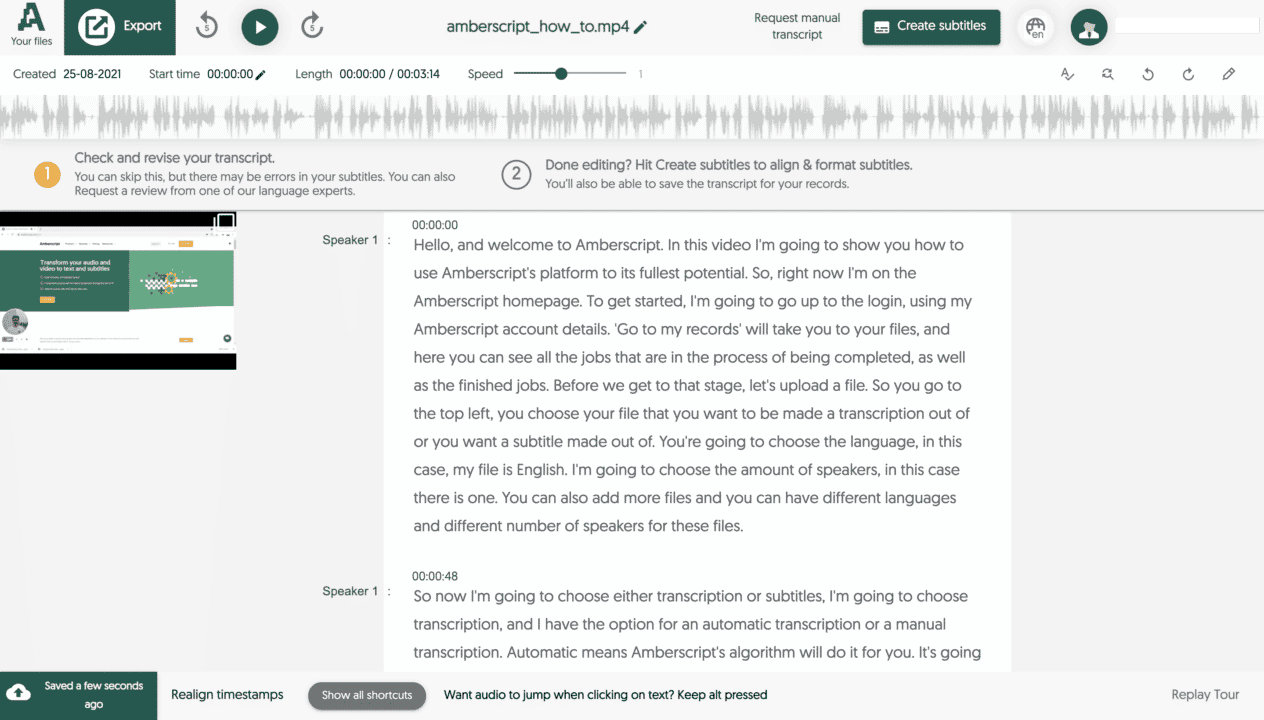
What are captions?
Captions are the text version of the audio of a video, but they are shown on the video. Captions can be in the same language as the audio or they can be translated into other languages to help those who are not native speakers, understand the content.
Types of captions
Closed captions: These captions are in a separate file from the video and can be turned on or off by the viewer.
Open captions: Open captions are burned into the video and the viewer has no control over whether to turn them off.
The benefits of captioning your videos:
- Captions help those who are deaf and hard of hearing experience your content
- Subtitles help people who may not understand the language of the audio experience the content
- Captions help to improve the SEO value of content, as it makes the video readable to search engines
- Those who cannot listen to your videos out loud in public settings can still understand what is being said

How to easily create transcripts and captions:
Creating transcripts and captions by yourself can be a time-consuming and boring process. For every minute of audio, it can take over 8 minutes to fully transcribe!
That’s why there are professional captioning and transcription services out there that can help!
At Amberscript, we’re on a mission to make all audio accessible by making the process of transcribing and captioning content a lot easier to do. We use state-of-the-art Automatic Speech Recognition (ASR) software to create high-quality audio-to-text, fast!
How to create captions and transcripts automatically with Amberscript:
- Start a free Amberscript account
- Upload your file(s)
- Choose whether you want subtitles or transcripts
- Select the audio’s language and how many speakers there are
- Choose your service:
- 5a. Human-made: Your content is created by professional transcribers and captioners. We handle the whole process, making sure that the text is 100% accurate.
- 5b. Machine-made: Your text is created automatically with our ASR. Depending on the audio quality of the file, the text will be up to 85% accurate. You can use our online editor to make changes to the text and perfect it as much as you like.
- 6. Export and share your file!
How to add Closed Captions to a YouTube video? 3 easy ways!
Table of Contents
- How to write closed captions for YouTube videos from scratch
- How to write your own YouTube captions automatically?
- How to automatically create YouTube video captions step by step
- Why use Amberscript to write closed captions for YouTube videos?
So, you’ve created a video and want to share it with the world? Before you upload your video, you should think about creating your subtitles and closed captions to appear alongside it. Luckily, YouTube helps creators to add their own captions or subtitles to their content. Closed captions help more people engage with your content and help to ensure that your content is easily searchable.
In this article, you’ll learn how to write your own closed captions for YouTube videos and which software can help to make the process easy.
How to write subtitles or closed captions for YouTube videos from scratch
If you want to write your own captions from scratch, this can be easily done in a standard text editor such as Microsoft Word or in the Notepad app. Here’s how:
- Open the text editor of your choice
- For each caption, write its number on a new line in chronological order.
- Below each number, you’ll need to add the time stamp of the audio you want your captions to appear on. Use the following formatting: in HH:MM:SS,MS. e.g. 00:00:03,10 is 3 seconds 10 milliseconds.
- After writing the time stamp add the following text –> ensuring that a space is on either side.
- After the –> write the time code that you want the text to disappear
- On the next line, in this case: (2.) write your next caption
- Repeat the process until your file looks similar to this:
1
00:00:14,000 –> 00:00:20,500
Meet Amber, our sophisticated AI transcribing assistant.
2
00:00:21,000 –> 00:00:27,500
She’s pretty clever and knows a lot about how people talk.
3
00:00:27,800 –> 00:00:31,250
Because speech comes in many different waves and shapes called waveforms.
8. Once your file is complete and you’re happy, export the file as a .TXT file.
9. You will then need to convert the .TXT file as an SRT file so that you can burn the captions into your video or upload it alongside your video when adding it to YouTube. A TXT to SRT converter can do this automatically for you.
10. Upload your SRT file to your YouTube video.
Writing your own captions for YouTube videos can take a lot of time. For every minute of audio it can take up to 10 minutes to transcribe and time stamp correctly. Writing your own captions should only be done if you are on a tight budget, have a lot of spare time, and have only short videos.
Luckily, there is technology out there that can help speed up the process for you!

How to write your own YouTube captions automatically?
With Ambercript, you can easily convert YouTube videos into text automatically and cut out a lot of the manual time of doing it from scratch.
Amberscript uses automatic speech recognition (ASR) technology to analyze your video and transform it into text,
How to automatically create YouTube video captions step by step:
- Create your free Amberscript account
- Upload your video
- Choose the langugae of your audio and how many speakers there are
- Wait for the ASR to work its magic
- A rough draft of your captions will be produced. Depending on the quality of the video’s audio, the text will be up to 85% accurate.
- Use our handy online editor to check your captions and edit any errors.
- Once you’re happy, export the file into any format that you like, including .TXT and .SRT.
As you see, the automatic process is a lot easier than creating YouTube captions yourself from scratch!
What’s even better, Amberscript also offers a professional service that takes the process completely out of your hands while ensuring 100% accurate subtitles!
After uploading your video to Amberscript or from the editor directly, you can choose to have our team of professional captioners edit the file for you. The team work to a four-eye principle, which means that the file is proofread and quality checked before being sent back to you.
Our Human-made service takes a little longer, usually around 3-5 business days depending on how much content you have. But you can rest assured that your captions are 100% accurate.
Why use Amberscript to write closed captions for YouTube videos?
1.High accuracy
We create the highest-quality captions on the market, for platforms such as Netflix and Disney+. We always ensure that viewers get the best experience, so we work with professional captioners and we’re constantly updating our automatic speech recognition engine to create accurate text. in 39 languages!
2. Easy to use
Writing YouTube captions from scratch can be boring, frustrating, and time-consuming. We aim to improve this experience by developing an intuitive editor to create your subtitles or manage the whole process for you with our team of professional captioners.
3. Speed
Sometimes content can’t wait! With Amberscript you can create YouTube captions in minutes, or within a few days if you need top-notch quality or translated subtitles.
What are you waiting for? Check out how easy it is to write YouTube captions with our free trial.
Frequently asked questions
-
What subtitle file formats are supported?
Our software allows you to export the transcript from the video or audio file as an SRT, EBU-STL or VTT file.
-
How do I order translated subtitles?
To order translated subtitles, you can upload your file like you would normally do. You can then select manual subtitling. Once you have selected this, an option will appear where you will be able to select the language the subtitles need to be translated to. If the language that you want is not one of the options you can contact us through our contact form.
-
What is the price?
For our prices, please refer to our pricing page.
-
Can I change the position of the subtitles?
That needs to be done using a video editor like VLC. Go to Tools > Preferences [CTRL + P]. Under Show settings, select the option that says All to switch to the advanced preferences. Navigate to Input/Codecs > Subtitle codecs > Subtitles. Under Text subtitle decoder set, the Subtitle justification to left, right or center.
-
How do I add subtitles to a YouTube video?
To add subtitles to your Youtube video, simply add the file you have created using Amberscript to your video in the Youtube Studio. Click on “subtitles”, then “add” and finally “upload file” and select the SRT file.
-
How do I export my subtitles?
Once your file is ready and available in your account, you can simply click on the file name and then select the “export file” button at the top left of the page. You can then select the file format, style of sutitles (between BBC and Netflix) and alignment. Please note that you can only export a file if you have validated your email address when creating an account.
-
How do I generate subtitles?
You can generate subtitles automatically using Amberscript. Our software allows you to convert your video file to text and then export the transcripts as SRT, EBU-STL or VTT files, which can easily be inserted into a video-editor.
Bringing speech-to-text to the masses: Amberscript’s co-founders on how they aim to make audio accessible accurately
Reduce costs, improved accuracy, and faster turnarounds.
Our founders Peter-Paul de Leeuw, Thomas Dieste, and Timo Behrens sat down with Silicon Canals to discuss how we combine the power of AI and humans to create accurate subtitles and transcripts.
How to Add Captions and Subtitles to a Vimeo Video
For those who enjoy using Vimeo for video sharing, it can be a great way to communicate information or share something fun. This site allows for the hosting and sharing of videos of all sorts, but using it to the fullest may mean investing in a few additional features, including the use of subtitles.
What Is Vimeo?
Vimeo is an excellent tool for those who need to uphold high-quality videos to a site that specific people or anyone can view. It provides a lot of easy-to-use tools to make sharing videos simple. It allows users to upload, host, and share those videos with their audience, often with just a few clicks.
Vimeo offers ample versatility and numerous ways to use it. It is often used by creators and artists who want to offer clients subscriptions. It packs in the features, too, including editing tools to make the entire process of sharing video easy to do.

What Are Subtitles?
One of the most important tools for today’s business, creators, or others is sharing videos. However, you have to share the video content along with subtitles if you want to get the best overall experience. Subtitles are lines of text that transcribe the information from within the video. Subtitles allow people who may not be able to hear the video or who may not want to turn on the volume to be able to understand what is taking place and what is being said within the video. It is sometimes a necessary investment.
Vimeo videos do not automatically contain subtitles. However, many video creators will want to add subtitles to these pieces to ensure that it is easy for all users to have access to that content.
The Benefits of Adding Subtitles to Your Video Content
For those who want to make and upload content, the use of subtitles may seem like an afterthought or something that they do not have to do. However, there are numerous benefits to offering this simple service.
Get better engagement
Online videos that have subtitles are more likely to get engagement from your watchers. That’s because they are able to hear and see what is happening, reading what is occurring on the screen at the same time. That gives people a better ability to connect with their audience. This is particularly important if you want your audience to truly take action after they have completed the video. If you are using motivational language or even a sales presentation, subtitles help people to really learn what is occurring in the video so they can take action.
Boost your SEO
If you are working to improve your search engine optimization (SEO) on your website, you need to include as many keywords as possible in the system. You can do that more effortlessly using subtitles because they already include many of the keywords that are relevant to your piece. That is an easy way to get the content you need in no time. You can further this by adding a transcript of all of the subtitles to your page.
Overcome challenges in language barriers
When you add subtitles to your videos, it is possible for more people to understand the content on it. That is because things like mumbling and accents that are otherwise hard to understand are far easier to manage. You can also make it possible for people to understand the content of your video without having to try to overcome the background noise in the video. A loud machine operating in the background or music that is too loud can otherwise limit the success of your video.

Learn new languages
Using subtitles like this allows people to follow along even if they do not know the language. It can even help to teach them the language in the video with ease. That makes it possible for people to communicate to a much larger group. People learn a language in many ways, including by experiencing it through listening, reading, and speaking.
Help people with disabilities participate
Another way to use video subtitles to your advantage is to allow more people the ability to connect with you. For people who are unable to hear, video is sometimes inaccessible to them. Yet, those individuals often have the same desires and interests in learning what you have to say. When you create content you want everyone to have access to, incorporate subtitles. It also helps people who have learning disabilities, attention deficits, or autism to better engage with the content in those videos. In some situations, this is necessary as it allows you to ensure you meet the requirements of the Disability Act and the Communications Act.
Connect with more cultures
When you use subtitles, you make it possible for more people around the world from various cultures to better understand what is happening within the video. That helps to extend your reach with your video and opens the door for better understanding and communication.
How to Make Subtitles with Amberscript
One of the easiest ways to add subtitles to Vimeo videos is to use Amberscript. This is one of the most efficient and easiest to use tools available for adding video subtitles, and it works on numerous platforms (with various benefits). Amberscript is not hard to do, and it only takes a matter of a few minutes to complete the process, limiting the amount of time that people have to spend during this process. Here is what the process is like.
Upload
The first step is to create your video. Once your video is ready, you will need to upload the video file to Amberscript. You can follow the on-screen steps to do this. Once the video is on Amberscript, you can begin editing it.
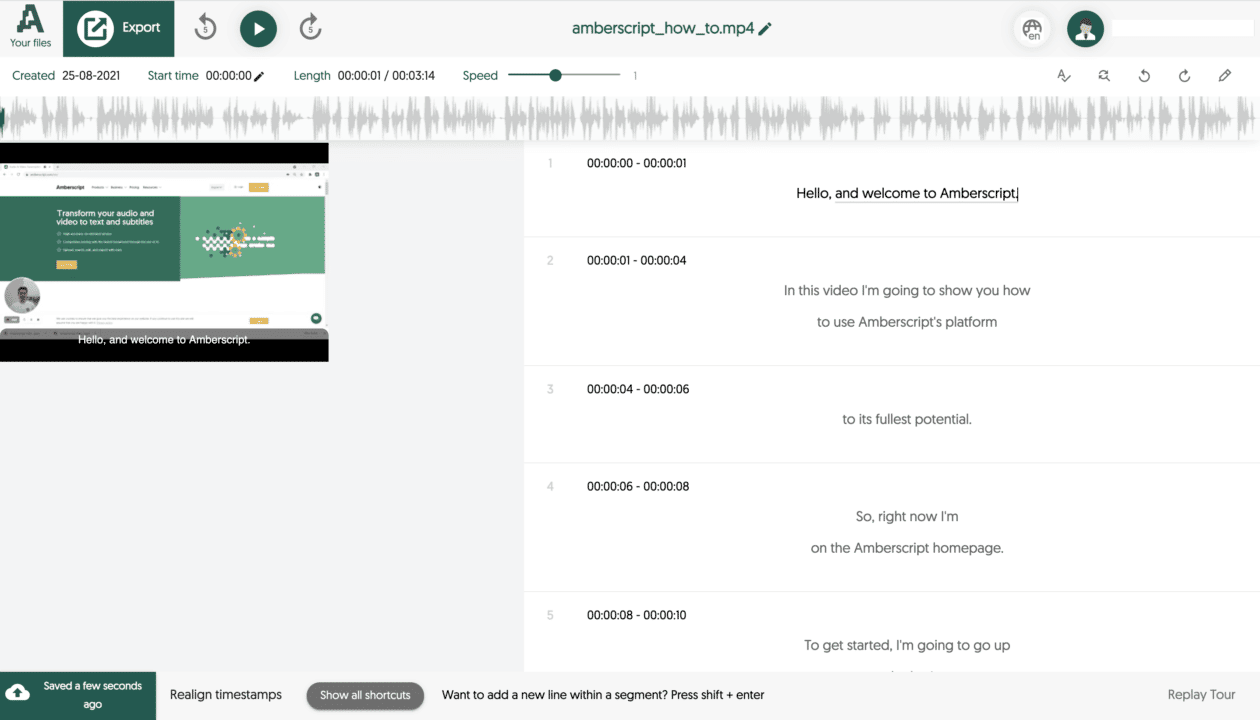
Choose Languages and Services
To do that, simply select the language that you want to use. Then, you can select automatic subtitles to be added to the video. Remember, this does all of the work for you, using tools that can help you to upload your video and add subtitles in no time.
If you want enhanced benefits of more accuracy, you can have Amberscript create manual subtitles for you. This means that our video subtitlers will watch the video and add the subtitles based on what they hear. This is a good option for those who want a fast turnaround but very accurate results.
Choose the method you desire. Then, wait for it to be completed.
Download
Now that you have your video subtitles in place, you need to download the file created for you from Amberscript. This is a very simple and straightforward process that only takes a few seconds. Download it to your laptop or computer so you can access it later.
Upload File to Vimeo
Head back over to Vimeo at this point. You just need to add the file to Vimeo in the same way you may have done before. Do this within the editing window on Vimeo. Then, click on “distribution” and then “subtitles” within the Vimeo app. You can then click on the + symbol to upload the SRT file to the site. That’s about all there is to do to get your video up on the site in no time.
About Amberscript
Amberscript is a highly effective, simple to use tool that allows you to create text and subtitles for all your video and audio files. You can do this automatically using the high-tech solutions available, or you can use the professionals who can create custom titles for your items. You can use it for many languages, too.
If you are ready to take your Vimeo videos to the next level, turn to Amberscript to get started. It’s easier – and faster – than you realize.
Amberscript vs. Otter.ai
These days there are many transcription and subtitle solutions available online. Some platforms rely on speech-to-text software, whereas others focus more on manual transcription completed by real humans. But although there are numerous options, they are not all created equally.
Some platforms are better for desktop devices, others for mobile; some are great for teams, and others for individuals. With so many different features available, it can be hard to decide which transcription service to use in 2022.
Two of the best options available are Amberscript and Otter.ai. Both of these platforms offer transcription services, but which is the better overall platform? And why? Well, we did the homework, compared the features, and crunched the numbers so that we could bring you this comprehensive comparison.
In this article, we will go over five basic categories, including automatic transcription, manual transcription, automatic subtitles, manual subtitles, and translated subtitles. We will compare both Amberscript and Otter.ai in these five areas so that you can decide for yourself which platform will work best for you and your needs.
| Feature | Amberscript | Otter.ai |
|---|---|---|
| Language support | 39 | English |
| Free trial | Yes | Yes |
| Online editor | Yes | Yes |
| Export as SRT/VTT/EBU-STL | Yes | No |
| Manual Services | Yes | No |
| Price | From $ 0.17 / minute ^ | Only monthly subscription |
| Security | GDPR + ISO27001 & ISO9001 certified | N/A |
| Automatic Delivery time | 5 minutes | 60 minutes |
| Manual Delivery time | 3 business days | N/A |
| Automatic Accuracy | Up to 85% | Up to 80% |
| Manual Accuracy | 100% | N/A |
Automatic Transcription
Automatic transcription is the most common type of online transcription service in 2022. The idea is that voice-to-text software listens to the audio and then transcribes it. This type of software is great for people who want to get a first draft down quickly and are prepared to proofread and edit the document themselves.
Automatic transcription is certainly a cheaper and quicker way to transcribe documents, but it is also more prone to errors. Both Amberscript and Otter.ai offer automatic transcription services, but which platform is better for automatic transcription?
Amberscript vs. Otter.ai
Amberscript is primarily a transcription and subtitle platform that excels at all things transcription. Otter.ai, on the other hand, is primarily a team collaboration and note-taking tool.
Amberscript can automatically transcribe audio or video files that you upload and can render the transcription into various file types for export. Amberscript also includes a built-in editor so that you can clean up the transcription yourself directly within the dashboard.
Otter.ai works a bit differently. The system can transcribe audio from meetings and lectures in real-time; in other words, it takes notes for you so that if you have to step out during a meeting, you will have a fairly accurate record of what was said while you were away.
Both services work well but are intended for different purposes. If you need to transcribe an audio or video file, then Amberscript will be the best option. If you need to take notes in an online meeting, then Otter.ai can provide that service.
Manual Transcription
Manual transcription is essentially a transcription service performed by real humans who listen to your audio file and actually write it out word for word with timestamps and speaker tags.
With manual transcription, you’ll know who said what and when they said it. Manual transcription is almost always more accurate than automatic transcription, but it is also more expensive. Let’s see how both platforms stack up in terms of manual transcription.
Amberscript vs Otter.ai
Amberscript is the clear winner in this category for the simple reason that Otter.ai doesn’t offer manual transcription services. Amberscript is able to provide manual transcription services with up to 100% accuracy.
This means that if you need a document transcribed perfectly by a real human, then Amberscript is the way to go. The service takes longer than automatic transcription, but the turn-around time is still fast, and you won’t need to spend much, if any, time editing the document.
Automatic Subtitles
Subtitles are useful when you want your audience to see what’s being said in your video via text captions. Maybe the listener is hearing impaired, or maybe they learn better by reading; in either case, adding subtitles to your video files can enhance the experience for your viewers and help you get your point across better than audio alone.
Automatic subtitles are generated by speech-to-text software in much the same way as automatic transcription. This method of adding subtitles is not 100% perfect as the machine learning software does make a mistake here and there, but the service is much faster than manual subtitles, and it’s almost always significantly less expensive as well.
Amberscript vs. Otter.ai
Both Amberscript and Otter.ai offer a version of automatic subtitles, but again, both platforms do so in a different way and for different purposes.
Amberscript allows you to upload video files directly on the platform, and the software will automatically listen to the audio and add subtitles. You can then save, edit, and export the file. The whole process is quick, easy, and a good value.
Otter.ai also has an automatic subtitle feature, but it is primarily designed for adding subtitles to meetings in real-time. So, for example, if you are in an online class and want to see the text of what your professor is saying, then the automatic subtitles generated by Otter.ai can help. With a pro plan, you can also upload pre-recorded files.
Manual Subtitles
Much like with transcription, manual subtitles are reviewed and added to your video file by a real human. This method of adding subtitles is much more accurate, but it also takes a bit longer and is generally more expensive. That said, if you need the job done right, and don’t have the time to review or edit your video file, then manual subtitles will probably be your best bet.
Amberscript vs Otter.ai
Again, there is no competition here. Amberscript is certainly better than Otter.ai when it comes to manual subtitles because Otter.ai doesn’t offer a manual subtitle service. Otter.ai is a great tool for keeping track of what’s being said in online meetings and collaborating with teammates in real-time, but that’s about it.
Translated Subtitles
Let’s say you have recorded a lecture in English, but you want to make it available to a global audience. In that case, it would make sense to add subtitles in other languages so that non-English speakers can understand what’s being said and enjoy the content. This is where translated subtitles come into play.
Amberscript vs Otter.ai
Amberscript offers a high-quality translated subtitle service, with the work being performed by real humans. Considering how much work goes into translating and then adding subtitles to a video, this service is fast and competitively priced. It’s definitely one of the best value services for translated subtitles online.
Otter.ai doesn’t offer any translated subtitle service. The platform is designed for automatic note-taking and real-time speech-to-text in online classes and meetings.

Pros and Cons
Both Amberscript and Otter.ai have their respective pros and cons. Let’s briefly go over where each platform excels and some of the limitations inherent to both services.
Amberscript Pros
- Great automatic and manual transcription services
- Accurate subtitles for uploaded video files
- Translated subtitle service
- Fast turn-around times
- Excellent user experience
- Good value
Amberscript Cons
- Real-time transcription in meetings can only be done via the iOS app.
Otter.ai Pros
- Real-time transcription in online classes and meetings
- Automatic note-taking so you never miss what was said
- Team collaboration tools for your staff or colleagues
- Integrated with meeting platforms
- Good smartphone app
Otter.ai Cons
- No manual transcription services
- No manual subtitle services
- No translated subtitle services
- Not very good for subtitles in general
- Not a good experience in browsers
Pricing
Amberscript offers both pre-paid services and subscription plans. Pre-paid transcription starts at $10 per audio hour for automatic transcription. The lowest-tier subscription service is $32 per month and includes five audio hours of automatic transcription. Manual transcription is $1.25 per audio minute. The prices are the same for subtitles; however, for translated subtitles, the price is $7 per audio minute.
Otter.ai offers a free plan that allows users to record and transcribe live. For more minutes and features, a pro plan is available starting from $8.33 per month when paid annually. The pro version includes everything included in the free version, plus Zoom, Microsoft Teams, and Google Meets integration, as well as the ability to transcribe pre-recorded files.
Amberscript vs. Otter.ai: The Verdict
Both Amberscript and Otter.ai are good services, but they work differently and have different purposes. Amberscript is great when you need fast, accurate transcription services or subtitles added to your video files. Amberscript is also the best solution when it comes to translated subtitles.
Otter.ai is good when you need to caption live meetings or generate a record of what was said on Zoom or in an online class. That said, Otter.ai can also add subtitles to pre-recorded video meetings, but this requires a premium plan, and the service is not as good as the subtitle service offered by Amberscript.
Amberscript vs. Scribie
Technology is advancing, and audio and video content is taking over the internet space by storm. With this advancement, speech-to-text service providers simplify content creation by automatically converting spoken words to texts. As a content creator, you probably know that identifying the best transcription service can be daunting. This is because there are plenty of options, and you must conduct thorough testing and comparisons to find the best.
Below, we compare Amberscript vs Scribie so you can easily make the best choice. Our comparison of these two service providers is based on security, fees, accuracy, user experience, speed, etc.
| Feature | Amberscript | Scribie |
|---|---|---|
| Language support | 39 | 35 |
| Free trial | Yes | no |
| Online editor | Yes | Yes |
| Export as SRT/VTT/EBU-STL | Yes | No |
| Manual Services | Yes | Yes |
| Price | from $ 0.17 / minute ^ | from $ 0.10 / minute |
| Security | GDPR + ISO27001 & ISO9001 certified | N/A |
| Automatic Delivery time | 5 minutes | 60 minutes |
| Manual Delivery time | 3 business days. Rush orders within 24 hours | 5 business days |
| Automatic Accuracy | Up to 85% | Up to 80% |
| Manual Accuracy | 100% | 99% |
Automatic Transcription
Transcription software automatically converts video and audio content into text. Using software saves time, allowing you to focus on creating more content. In addition, you are guaranteed increased accuracy, thus making your audience enjoy your content. Let’s see below how Ambersript and Scribie vary when it comes to automatic transcription.
Amberscript vs Scribie
Amberscript is AI-powered, one of the transcription software with the fastest turnaround. The software automatically converts your audio and video content into text. It allows you to export and edit your texts if need be. Prominent companies, including Netflix, Microsoft, Amazon, Puma, etc., are currently using Amberscript.
Amberscript transcription software is 5x faster than human effort due to its AI feature. It is also accurate when converting content to data and has a multiple-user account for large businesses. Regarding security, Amberscript complies with the GDPR’s stringent regulations and is ISO certified. The software is available in over 39 languages, including English, Dutch, Italian, Spanish, French, etc.
In contrast, Scribie is also AI-powered. Companies like Netflix, Airbnb, and Google use it to automatically convert audio and video files into texts. You will incur $0.10 per minute, and the software has over 30 hours of turnaround time to receive a finished document. This makes Amberscript a better option since it delivers results in less than an hour, depending on a file’s size.
Scribie guarantees 70% accuracy, making it reliable. Moreover, the software allows you to edit and export your files in various formats. Scribie is affordable and reliable, but we wouldn’t recommend it if you need to convert your files fast.
Manual Transcription
Although technology has brought about automated transcription services, you still need manual transcription. Unfortunately, manual transcription is time-consuming, and you get to spend a lot of money hiring transcribing professionals. If you prefer manually produced transcripts, Amberscript and Scribie both support this service. However, they vary in various elements.
Amberscript vs Scribie
Amberscript has a team of professionals dedicated to converting your video and audio content into high-quality texts. With its transcribers, you get high-quality translated texts at competitive pricing and a fast turnaround time. The team combine their extensive experience with automated transcription tools to guarantee 100% accuracy and quality texts.
Note that Amberscript’s manual transcription is secure. Besides complying with GDPR’s regulations and holding ISO certifications, it keeps your content private through a non-disclosure agreement. The service is also available in over 15 languages, including English, Swedish, Portuguese, French, Dutch, etc. Amberscript manual transcription pricing plan varies with the service you are looking for but starts as low as $1 per minute.
When it comes to Scribie’s manual transcription, it also guarantees 99% accuracy and a fast turnaround time. This software has a team of transcribers with extensive knowledge from various fields. Furthermore, Scribie has accent experts for non-native accents, including African, Indian, etc. And, if the results are unsatisfactory, Scribie will review your texts and make the necessary changes free of charge.
Unlike Amberscript, which charges manual transcription fees starting from $1 per minute, Scribie’s minimum charge is $0.8 per minute. The software is highly encrypted and has its transcribers working under NDAs for maximum confidentiality. Sadly, Scribie is only available in English, making Amberscript excel for users looking to convert their audio and video files to other language texts.
Automatic subtitles
Transcription software or tools generate automatic subtitles to ensure native viewers understand video content. Also, individuals with hearing impairment will enjoy your content, especially if your videos contain non-verbal cues and sound effects. Here is our comparison on Amberscript vs Scribie regarding Automatic subtitles.
Ambersript vs Scribie
Amberscript automatically generates subtitles in video content and provides an intuitive editor to ensure you get the best quality. Once done editing, you can export your video with subtitles or subtitles only in any of the supported formats, including Text, VTT, SRT, or EBU-STL.
Amberscript automated subtitles generator is user-friendly and features auto-captioning. The system is AI-powered, thus guaranteeing high accuracy and efficiency rates. You can generate video subtitles in 39+ languages using Amberscript, making it an excellent option if you have a diverse audience. You can either subscribe for a $25/month price plan or opt for the prepaid plan that requires you to pay $8 per hour of video uploaded.
Conversely, Scribie generates video subtitles and only allows you to export them in VTT and SRT formats. Its charge for subtitle generation is $15 per hour of video uploaded, and subtitles are available in English formats only. Amberscript takes the lead in this category since it is more affordable. It has an over 85% accuracy rate and offers services in over 39 languages.
Manual Subtitles
Generating manual subtitles using subtitlers can be time-consuming, but the results are rewarding. So, what differentiates Amberscript’s manual subtitles services from Scribie’s? Let’s find out.
Ambersript vs Scribie
Amberscript has professional subtitlers with vast experience providing high-quality subtitles for your video content. The subtitles undergo quality checks to ensure everything is to your satisfaction. Most importantly, the subtitlers speak over 15 languages, thus creating captions suitable for your preferred audience. Amberscript also features multiple export and import options in Text, VTT, SRT, or EBU-STL formats. Its accuracy rate is 99%, and the pricing plan varies starting from $1 per minute.
Regarding Scribie, you can generate video subtitles through subtitlers and have them exported in VTT and SRT formats only. Its subtitlers consist of accent speakers but do not covert your content to other languages besides English. Scribie’s price plan for manual subtitle generation is $15 per hour of video uploaded, thus making it more affordable than Amberscript in this category. However, suppose you want to convert your content into different language text and export it in multiple formats. In that case, Amberscript is the go-to transcribing software.
Translated subtitles
As a content creator, you must translate your subtitles into different languages and accents to reach a diverse audience. If you find it challenging to choose between Amberscript or Scribie for this purpose, below is a clear insight to help you make the best decision.
Amberscript vs Scribie
Translating your video content subtitles with Amberscript gives you access to all languages globally. Amberscript has a 3-day turnaround time but can deliver within 24 hours, depending on your workload. Note that expert translators do the translation, and native speakers approve of content quality. On top of that, privacy is guaranteed, so no one gets access to your content. Amberscript pricing on translated subtitles is customised based on your needs.
On the other hand, Scribie does not translate subtitles in various languages since it is only available in English. However, the software can convert your content into multiple accents, whether British English, Canadian, African, Indian, etc. Like Amberscript, Scribie is highly encrypted, and its professionals work under NDA.
Amberscript vs Scribie Final Takeaways
Based on our ultimate comparison above, Amberscript and Scribie are secure transcription platforms for converting video and audio files to texts. You can also securely use them to add subtitles to your content and translate your subtitles into multiple languages and accents. This transcription software guarantees timely delivery, thanks to its AI-powered feature. On top of that, the software host professionals who edit your work and ensure it’s up to par. Overall, Amberscript has proven to have a faster turnaround time than Scribie. It is also affordable and offers many services.
Amberscript vs Veed.io
When you need to keep track of what was said in a video or audio files, then transcription and subtitle services are your best bet. There are several good online services that can transcribe audio and video, add subtitles to your videos, and even add translated subtitles if necessary. Two of the best options are Amberscript and Veed.io. But of these two platforms which one is the best?
Well, to answer that question, we looked at both platforms in-depth and compared them across five main categories, including automatic transcription, manual transcription, automatic subtitles, manual subtitles, and translated subtitles. In this article we will reveal our findings, and explain where each platform excels, so that you can choose the transcription or subtitle service that is best for your needs.
| Feature | Amberscript | Veed |
|---|---|---|
| Language support | 39 | 30 |
| Free trial | Yes | Yes |
| Online editor | Yes | No |
| Export as SRT/VTT/EBU-STL | Yes | No |
| Manual Services | Yes | No |
| Price | from $ 0.17 / minute ^ | 38 USD per month |
| Security | GDPR + ISO27001 & ISO9001 certified | N/A |
| Automatic Delivery time | 5 minutes | 60 minutes |
| Manual Delivery time | 3 business days | N/A |
| Automatic Accuracy | Up to 85% | Up to 70% |
| Manual Accuracy | 100% | N/A |
Automatic Transcription
Automatic transcription is another way of saying AI transcription. Basically, with this service you upload an audio or video file, and speech-to-text software produces a transcription of what was said.
Automatic transcription services are great because they can transcribe audio and video files much faster than a human can, and the price is generally much cheaper than manual transcription as well.
However, automatic transcription isn’t perfect and sometimes the machine learning system will make a mistake. Therefore, if you use automatic transcription you will need to proofread and make some corrections to the finished document.
Amberscript vs Veed.io
Amberscript is a transcription and subtitle platform that does a great job of transcribing just about anything. Amberscript allows you to upload audio and video files for automatic transcription and features a built-in editor so that you can review your transcribed document and make any necessary changes from within the dashboard. The service works well, it’s fast, and it offers a great overall value for the price.
Veed also offers a similar service that allows users to upload an audio or video file and receive fairly accurate automatic transcriptions. Veed supports many different file types and also allows you to export in a variety of different formats, which is helpful when sharing files with team members who are using the files in different applications.
All things considered, both platforms offer good automatic transcriptions, but we have to give the edge to Amberscript because the platform includes a built-in editor so that you can fix any mistakes and export a perfect file that’s free from errors.
Manual Transcription
Manual transcription means that your file is transcribed by a real human being. This type of transcription is much more accurate than automatic transcription services which are performed by AI engines.
Manual transcription also allows you to add timestamps, and speaker tags, so that you know who’s talking at any given time. However, manual transcription takes longer than automatic transcription and is considerably more expensive.
Amberscript vs Veed.io
There is no competition here because Veed.io doesn’t offer manual transcription services. Amberscript is an industry leader in accurate manual transcription, and in many cases, delivers manually transcribed documents that are 100% accurate. So, if you need the job done right with perfect accuracy, then your best bet will be to use manual transcription with Amberscript.
Automatic Subtitles
Subtitles allow you to show your audience what’s being said in a video. This is helpful if your viewers are hearing impaired or are otherwise unable to watch your video with the audio turned on. Like with transcription, there are various options available online for adding subtitles to your videos, and both Amberscript and Veed do a good job in this area.
Automatic subtitles are very similar to automatic transcriptions in that they are generated by AI engines that leverage machine learning models to produce relatively accurate speech-to-text subtitles. That said, automatic subtitles are not perfect. They are fast, and relatively inexpensive, but you will still need to clean up the finished subtitles manually to ensure that no mistakes were made.
Amberscript vs Veed.io
Amberscript’s automatic subtitle service works really well, it offers a quick turn-around time, and is a great value for money compared with many of the other options available on the market.
Veed also offers a great automatic subtitle service. The best thing about Veed subtitle system is that it allows you to manually make corrections and edits in real-time from directly within the system.
Both options are good in this regard, so we have to declare it a tie. If we were forced to name a winner here we would have to give a slight edge to Veed, simply because it allows you to make real-time edits to the subtitles in your video file without leaving the application.
Manual Subtitles
As you probably guessed manual subtitles are subtitles that were created by a real human, who actually watched your video and added in each word one at a time. Like with manual transcription this sort of service is much more accurate than the subtitles added by AI computers, but it also takes much longer and is more expensive.
Amberscript vs Veed.io
Amberscript is one of the best online platforms for manual subtitles. The service is fast considering the amount of work involved, it’s reasonable priced, and most importantly, it’s incredibly accurate. In fact, many times, the manual subtitles added by Amberscript captions is 100% accurate and you simply can’t beat 100%.
Veed can’t compete when it comes to manual subtitles because they don’t offer the service. To be fair, Veed offers additional services such as the ability to add music and images to your video files, but these features don’t help people who need accurate manual subtitles. So, the clear winner here is Amberscript.
Translated Subtitles
If you want to make your content available to people around the world, then you will need to add translated subtitles to your video files. This service allows you to reach a global audience and reach new markets, but it’s also considerably more expensive than normal transcription and subtitle services.
Amberscript vs Veed.io
Amberscript is an expert when it comes to translated subtitles. The expert translators at Veed do a great job, and they do it quickly, especially when you consider how much work is involved with translating entire video files and then adding in subtitles. All things considered, the price for this service is also very reasonable.
Veed also offers translated subtitles, but the translation is done by an AI, so this is automatic translation which is far from perfect. If you have the time to double check the translations and make sure that the subtitles are correct than this might be a good option, but most people don’t have the knowledge or time required to perform this sort of review. Again, the winner here is definitely Amberscript.

Pros and Cons
Both Amberscript and Veed offer users a number of great services, but each platform also comes with a few downsides. Let’s briefly go over the pros and cons so that you can make an informed decision about which service will work best for your needs.
Amberscript Pros
- Accurate automatic and manual transcription services
- Accurate subtitles for uploaded video files
- Fast translated subtitle service
- Rapid turn-around times
- Great overall user experience
- Good value for money
Amberscript Cons
- No additional video editing features
- Can’t add music files to your videos
Veed.io Pros
- Lots of video editing features
- Good value for money
Veed.io Cons
- Veed is primarily a video editing tool
- Transcriptions and subtitles are secondary features
- No manual transcription services
- Translated subtitles are done by an AI
Pricing
Amberscript offers pre-paid services as well as monthly subscription plans. Pre-paid transcription starts from $10 per audio hour for automatic transcriptions. The Amberscript subscription service starts from $32 per month when paid annually and includes up to five audio hours each month. Manual transcription starts from $1.25 per audio minute. Translated subtitles start at $7 per audio minute.
Veed offers a free plan that allows new users to get started with limited features without having to spend any money. But to make the most of the site you will need a paid monthly subscription. The basic plan starts at $25 per month, but to make the most of the platform you will want a pro plan which starts at $38 per month. You can also save a bit of money by paying for the entire year upfront.
Verdict
Both Amberscript and Veed offer good transcription services as well as subtitles. However, Veed is primarily a video editing tool, whereas Amberscript specialized in transcriptions and subtitles. So, if you need the most accurate transcriptions, translations, or subtitles, we can confidently recommend Amberscript as the overall winner.
Amberscript vs GoTranscript
Table of Contents
- An overview
- Automatic transcription
- Manual transcription
- Manual Subtitles
- Translated subtitles
- Conclusion
The days of losing crucial information when trying to type, listen, or watch videos to transform knowledge into texts are long gone. Our speech and video conversion is now a piece of cake thanks to technological innovation and the usage of automatic speech recognition (ASR) software.
Among the numerous commonly used transcribing tools are Happy Scribe, Rev, Descript, Amberscript, TranscribeMe, and GoTranscript. Before choosing your favorite transcription software, you should consider the pricing, delivery quality, speed, security, accuracy, and user experience.
Today, we’ll contrast two popular transcription tools, Amberscript and GoTranscript, to see which offers the best transcription and subtitling services and get more bang for your buck.
An overview
| Feature | Amberscript | GoTranscript |
|---|---|---|
| Language support | 39 | 35+ |
| Free trial | Yes | No |
| Online editor | Yes | No |
| Export as SRT/VTT/EBU-STL | Yes | No |
| Manual Services | Yes | Yes |
| Price | from $ 0.17 / minute ^ | from $ 0.78 / minute |
| Security | GDPR + ISO27001 & ISO9001 certified | N/A |
| Automatic Delivery time | 5 minutes | 60 minutes |
| Manual Delivery time | 3 business days | 7 business days |
| Automatic Accuracy | Up to 85% | Up to 80% |
| Manual Accuracy | 100% | 99% |
Automatic Transcription
Automatic transcription converts audio or video using artificial intelligence and automated learning. The computerized transcription program records the sound waves and converts them into digital text.
Amberscript vs. GoTranscript
Amberscript uses automated voice recognition technology to identify many speakers, capture ambiguous words, and construct the text into a complete manuscript. GoTranscript does not use artificial intelligence to translate speech into text, making Amberscript faster and more efficient.
Amberscript, a prime example of automatic transcription software, is regarded as competent in transcribing transparent languages. However, it falls short with ambiguous talks, making it less accurate and flawless. In comparison to GoTranscript, Amberscript can transcribe lengthy human speeches more quickly.
Regarding user security and experience, Amberscript is well-known because it can provide both mechanical and automatic transcriptions and offers a secure user interface. Because companies may request unique solutions utilizing artificial intelligence and then hire a human professional transcriber to edit for correctness. In this case, many firms prefer using this platform. This doesn’t make GoTranscript less secure since it is highly encrypted and has its professionals working under NDA.
The security and privacy features in Amberscript are powerful, and you can feel secure knowing that your data and information are safe because of GDPR compliance, ISO certification and NDA signing. Audio and video transcription with Amberscript is $10 per hour.
Manual Transcription
The popularity of manual transcription is declining as technology advances. Essentially, it calls for someone to listen to an audio or video file before transcribing. The person will need to go back to specific areas of the video or audio and pay close attention to ensure they understand everything. However, manual transcription still has many benefits, and most companies still embrace it.
Amberscript vs. GoTranscript
GoTranscript is the transcription tool for you if you prefer manually produced transcripts. A group of human experts will listen to your audio and video files and convert them to text. Amberscript is a platform for automatic transcription but also a tool for manual and automatic transcribing.
On accuracy and speed of delivery used to automate transcription, GoTranscript encounters fewer errors due to linguistic ambiguity than Amberscript. Contrary to human transcription in Amberscript, which may require a second look, there is no more editing necessary after the audio conversion to ensure correctness.
Since it can take pro hours or days to convert a file, GoTranscript is substantially slower regarding delivery speed. Because of this, Amberscript is famous for being quicker and providing less expensive services than GoTranscript.
Relative to Amberscript, a platform for automatic transcription, GoTranscript receives fewer user conversion requests. Nevertheless, you may still favor manual transcribing because of its accuracy, especially when speed delivery is not a priority.
GoTranscript service provider values security and privacy policies, thus, protecting your information with 2048-bit SSL encryption and an NDA. The confidentiality of your data is respected thanks to the strict rules it has put in place. These precautions include hiring specialists who sign confidentiality agreements, managing data with care, wiping data after submission, and forbidding transcribers from downloading the material to their computers.
Which of Amberscript and GoTranscript is, therefore, more secure to use? The GDPR, ISO certifications and the ability to sign NDA’s and stricter security standards in Amberscript ensure that no data is lost. In GoTranscript, however, people tend to disregard the rules; therefore, a transcriber might violate the security policy and cause a massive problem with clients’ sensitive information.
GoTranscript is more expensive than Amberscript because its pricing starts at $0.77 per minute ($46.2) each hour, as opposed to Amberscript’s starting price of $10 per hour.
Automatic Subtitles/Captions
Even after translating your videos into various native languages, there will always be someone who cannot pick up the new language. Therefore, adding subtitles to your video can improve viewers’ comprehension in general.
Remember that captions are for viewers who cannot hear the audio and contain the dialogue and additional audio that an audience may require. Since the video provides all the acoustic sounds, such as sound effects and all the non-verbal cues, viewers with hearing impairments can still understand the content.
With automatic speech recognition technologies, captions and subtitles apply automatically. You can quickly add captions and subtitles to your content in a little while.
Amberscript vs. GoTranscript
Remember, Amberscript is a manual and automatic speech-to-text platform, and you will automatically generate captions and subtitles. Amberscript subtitlers will attempt to improve the job and make the subtitles more precise. The software produces subtitles and captions more precisely and quickly. It has an accuracy rate of 85% and costs $ 0.02 per minute.
On the other hand, GoTranscript is unreliable in automated subtitle generation since it is not AI-powered. However, the software offers experts who manually create subtitles for your audience.

Subtitles, Closed Captions, and SDH Subtitles: How are they different?
- Subtitles: text created from a transcript
- Closed captions: describe what is happening in addition to the dialogue
- SDH captions: Subtitles designed for deaf and hard of hearing
Manual Subtitles
Human professionals generate manual subtitles and captions to meet the needs of different audiences. Let’s see how you can benefit from Amberscript and GoTranscript and make a suitable choice.
Amberscript vs. GoTranscript
With the help of automatic tools, Amberscript’s subtitlers can produce your subtitles and captions for a lower cost. The ASR generates the text and the team of human subtitles will perfect the text and quality check it to ensure 100% accuracy.
With GoTranscript, human experts are in charge of the entire process and guarantee no mistakes. For captions, an expert in accessibility makes audio changes to fit the needs of people who are deaf or hard of hearing. Ultimately, However, it is more expensive than the Amberscript subtitle/caption converter because it starts charging at $1.11 per minute.
Translated Subtitles
As a content creator, you must translate your subtitles into different languages and accents to reach a diverse audience. Choosing between Amberscript and GoTranscript can be challenging for this category. Below, we help you get a clear insight to make the best decision.
Amberscript vs. GoTranscript
For several languages, Amberscript provides certified translators and language experts. These experts offer subtitle translations that are 100% accurate and adhere to quality inspectors’ standards. GoTranscript, which relies solely on human beings to translate subtitles, likewise provides its services at a competitive price and with a high rate of correctness.
If your language is not native, having subtitles in different languages can help your audience grasp the content of your video. The information communicated in the video is accessible to everyone globally.
Conclusion
Depending on the work’s urgency, you can use the GoTranscript or Amberscript transcription platforms since they are all secure and reliable. Use them to translate your audio or video files into various languages to reach a diverse audience. Amberscript is a good option if you need quick content transcriptions since it is AI-powered and has editing resources. Moreover, the software supports over 39 languages, which will help you expand your audience. However, consider GoTranscript if you want the accuracy of human transcribers but are willing to wait longer and spend more.
Frequently asked questions
-
What subtitle file formats are supported?
Our software allows you to export the transcript from the video or audio file as an SRT, EBU-STL or VTT file.
-
How do I order translated subtitles?
To order translated subtitles, you can upload your file like you would normally do. You can then select manual subtitling. Once you have selected this, an option will appear where you will be able to select the language the subtitles need to be translated to. If the language that you want is not one of the options you can contact us through our contact form.
-
What is the price?
For our prices, please refer to our pricing page.
-
Can I change the position of the subtitles?
That needs to be done using a video editor like VLC. Go to Tools > Preferences [CTRL + P]. Under Show settings, select the option that says All to switch to the advanced preferences. Navigate to Input/Codecs > Subtitle codecs > Subtitles. Under Text subtitle decoder set, the Subtitle justification to left, right or center.
-
How do I add subtitles to a YouTube video?
To add subtitles to your Youtube video, simply add the file you have created using Amberscript to your video in the Youtube Studio. Click on “subtitles”, then “add” and finally “upload file” and select the SRT file.
-
How do I export my subtitles?
Once your file is ready and available in your account, you can simply click on the file name and then select the “export file” button at the top left of the page. You can then select the file format, style of sutitles (between BBC and Netflix) and alignment. Please note that you can only export a file if you have validated your email address when creating an account.
-
How do I generate subtitles?
You can generate subtitles automatically using Amberscript. Our software allows you to convert your video file to text and then export the transcripts as SRT, EBU-STL or VTT files, which can easily be inserted into a video-editor.
Amberscript vs Trint
Searching for the top audio to text software can be challenging due to the abundance of options available. To make your task easier, Amberscript has emerged as a popular choice among users due to its advanced technology that guarantees outstanding results. To provide an impartial comparison between Amberscript and Trint, we evaluated different aspects such as security, cost, accuracy, user experience, and speed. This guide will help you make an informed decision.
Table of Contents
- An overview
- Machine-made transcription
- Human-made transcription
- Machine-made subtitles
- Human-made subtitles
- Translated subtitles
- The Verdict
An overview
| Feature | Amberscript | Trint |
|---|---|---|
| Language support | 39 | 32 |
| Free trial | Yes | Yes |
| Online editor | Yes | Yes |
| Export as SRT/VTT/EBU-STL | Yes | No |
| Manual Services | Yes | No |
| Price | from $ 0.17 / minute ^ | Only monthly subscriptions |
| Security | GDPR + ISO27001 & ISO9001 certified | N/A |
| Automatic Delivery time | 5 minutes | 60 minutes |
| Manual Delivery time | 3 business days | N/A |
| Automatic Accuracy | Up to 85% | Up to 70% |
| Manual Accuracy | 100% | N/A |
Machine-made transcription
Automatic Speech Recognition (ASR) makes transcribing your audio and video files easier and less time-consuming. With the availability of numerous machine-made transcription softwares, you don’t need to be intimidated. This automation will save you both time and money, giving you more opportunities to focus on other important tasks, such as producing engaging content to attract your target audience.
Amberscript vs. Trint
Amberscript and Trint are AI-driven transcription tools that provide efficient and high-quality results. Both can be accessed through the web or mobile devices, enabling you to keep track of your transcription projects on the go. They offer features beyond simply transcribing audio and video files, including editing and the ability to share content in multiple languages.
Amberscript supports 39 languages and includes a team account for larger businesses. The tool boasts 5 times faster transcription speed compared to the average, and includes an online text editor for making adjustments if needed. With a focus on security, Amberscript uses strong encryption and complies with strict GDPR regulations. The software guarantees a minimum of 95% accuracy for clearly audible files.
Regarding Trint, this AI-powered transcription software offers support for 32 languages. It provides fast conversions of audio and video files to text with a claimed accuracy of 90%. Trint offers three different account options: individual, team, and enterprise, so you can choose the one that best suits your needs for optimal results and experience.
While Amberscript has a mobile app for both Android and iOS users, Trint is only available on iOS devices. Amberscript’s pricing starts at $8 per hour of uploaded content or a monthly subscription fee of $25, while Trint’s pricing starts at $48 per month, making it more expensive than Amberscript.
Human-made transcription
You probably know that automatic transcription software does not guarantee 100% accuracy, and you still need to edit your work before using it. For this reason, you can use a human-made transcription service, which many transcription softwares provide. Here, professional transcribers will do all the work for you, guaranteeing quality and efficiency.
Amberscript vs. Trint
Amberscript employs professional transcribers to convert your audio and video files into well-written transcripts. The combination of transcriber expertise and technology ensures quick delivery of high-quality transcripts at a reasonable cost. The software includes a quality checker to give you peace of mind and allow the transcribers to handle the job.
Amberscript takes into consideration your needs by ensuring its transcribers are native speakers from various regions. You can take advantage of their manual transcription service in 15 languages, starting at $1 per minute.
In comparison, Trint prioritizes automatic transcription due to the belief that manual efforts are both costly and overwhelming. This puts Amberscript ahead in this category, as it also offers educational resources such as eBooks, articles, webinars, and case studies for those looking to expand their knowledge about transcription services.
Machine-made subtitles
Automatic transcription software can help you create subtitles for your audio or video files, making them accessible to a wider audience, including individuals with hearing disabilities. To enhance the viewing experience for your audience, consider including sound effects and non-verbal cues in your videos.
Amberscript vs. Trint
Amberscript is a cost-effective option for automatically generating subtitles with a price starting from $25 per month for a subscription or $8 per hour for a video you upload. It is widely used by global companies like Netflix, Amazon, Givenchy, and Microsoft and has a reputation for delivering quality results.
The AI technology in Amberscript makes it fast and efficient in creating subtitles for your video content. The software claims to be 10 times faster than the average speed, ensuring you receive your subtitles quickly. It also has an easy-to-use editor that you can use to improve the quality of your subtitles before sharing them with your audience. You can export your subtitles in various formats such as Text, SRT, VTT, and EBU-STL, and generate subtitles in 39 different languages. If you run a large business, you can take advantage of the multiple-user account feature.
In comparison, Trint also has the ability to automatically generate subtitles and captions for your video files. It also provides a caption editor to give you control over the quality of your video content. However, it is relatively more expensive than Amberscript, with its price plan starting from $48 per month for the individual account and $60 per month for the advanced platform.
Benefits of using Amberscript
Amberscript’s subtitle services are:
Edit your own text within minutes or leave the work to our experienced subtitlers.
Our experienced subtitlers and thorough quality controls ensure 100% accuracy of your transcriptions and subtitles.
Thanks to a variety of integrations and API interfaces, you can fully automate your workflows.
Your data is in safe hands. We are GDPR compliant + ISO27001 & ISO9001 certified.
Human-made subtitles
Generating subtitles manually for your video content can be a time-consuming process, but connecting with professional subtitlers through transcription software can simplify the task. These tools provide access to experienced subtitlers who will create high-quality subtitles for your video files, reducing the need for editing on your end. All you have to do is share the final product with your audience.
Amberscript vs. Trint
If you want to create subtitles manually, Amberscript is the way to go. With a team of professional subtitlers and its in-built technology, Amberscript offers high-quality captions and subtitles at a reasonable price. With a 99% accuracy rate, you are sure to engage your audience and receive positive feedback.
Amberscript’s human-made subtitle service is available in 15 different languages and starts at just $1 per minute. On the other hand, Trint does not offer this type of subtitling service, making Amberscript the better option for those looking for obtaining subtitles by an external source.
Subtitles, Closed Captions, and SDH Subtitles: How are they different?
- Subtitles: text created from a transcript
- Closed captions: describe what is happening in addition to the dialogue
- SDH captions: Subtitles designed for deaf and hard of hearing
Translated subtitles
Reaching a diverse audience can be easy if you translate your video subtitles into various languages. Subtitle translation services has made things easy for content creators by offering this service.
Amberscript vs. Trint
With Amberscript, you can translate your subtitles into any language worldwide. Our software features professionals from diverse regions who are fluent in all the languages you want to use in your content. You can also customise your audio and video sounds to match different accents and have native speakers review the content quality. Amberscript is fast and efficient, with a delivery time of up to three days, or even 24 hours for smaller workloads.
Trint offers translation of your video subtitles or captions into 34 supported languages. Make sure to check the availability and see if it aligns with your marketing strategy.
The Verdict
Both Amberscript and Trint are top-notch transcription softwares, but they offer diverse services. It’s essential to choose the one that fits your specific transcription needs. For human-made transcription or subtitle creation, Amberscript is the ideal choice. However, if speed is a priority and you have a high volume of work, Trint may be a better option for you, though at a higher cost. In our opinion, Amberscript offers the most comprehensive transcription services all under one roof, making it the leading choice.
Frequently asked questions
-
What subtitle file formats are supported?
Our software allows you to export the transcript from the video or audio file as an SRT, EBU-STL or VTT file.
-
How do I generate captions?
You can generate captions automatically using Amberscript. Our software allows you to export transcription based on audio/video files as SRT, EBU-STL or VTT files, which can easily be inserted into a video-editor. Want to know more? Here is a step-by-step guide.
-
How do I generate subtitles?
You can generate subtitles automatically using Amberscript. Our software allows you to convert your video file to text and then export the transcripts as SRT, EBU-STL or VTT files, which can easily be inserted into a video-editor.
-
How do I order translated subtitles?
To order translated subtitles, you can upload your file like you would normally do. You can then select manual subtitling. Once you have selected this, an option will appear where you will be able to select the language the subtitles need to be translated to. If the language that you want is not one of the options you can contact us through our contact form.
-
What is the price?
For our prices, please refer to our pricing page.
-
Can I adjust the formatting?
From your account, you can export the transcript in different formats. So if you require both a Word file and an SRT file, you can simply export the file twice.
-
Can I burn the subtitles directly onto my video?
If you have exported the transcript as a SRT, EBU-STL or VTT file, you can easily burn them onto your video using video-editing software.
Amberscript vs. Sonix.ai
Table of Contents
- An overview
- Automatic subtitles
- Manual Subtitles
- Translated subtitles
- Amberscript vs Sonix.ai: which one is best?
Amberscript and Sonix.ai are similar since they are both AI-powered software tailored to convert audio and video files into text through speech recognition. However, some critical differences between the two service providers are worth noting. This is to help you identify your requirements and choose an option aligning with them.
As professional researchers and transcribers, we did our research on Amberscript and Sonix.ai by testing them and analyzing user reviews. Below we share our findings and thoughts explaining what distinguishes Amberscript from Sonix.ai. Some factors we consider during the research and comparison procedures include fees, security, reliability, accuracy, and speed.
An overview
| Feature | Amberscript | Sonix.ai |
|---|---|---|
| Language support | 39 | 40 |
| Free trial | Yes | Yes |
| Online editor | Yes | Yes |
| Export as SRT/VTT/EBU-STL | Yes | Yes |
| Manual Services | Yes | No |
| Price | from $ 0.17 / minute ^ | From $10/hour |
| Security | GDPR + ISO27001 & ISO9001 certified | N/A |
| Automatic Delivery time | 5 minutes | 5 minutes |
| Manual Delivery time | 3 business days | N/A |
| Automatic Accuracy | Up to 85% | Up to 80% |
| Manual Accuracy | 100% | N/A |
Automatic subtitles
Subtitles are paramount in video files to ensure viewers who are not native understand your content. Also, viewers with hearing impairment will enjoy your content, especially if your files contain sound effects and non-verbal cues.
Amberscript vs. Sonix.ai
Amberscript will generate subtitles for your video files and allow you to edit them using its in-built intuitive text editor. This is to ensure your text is of good quality so that your diverse audience will understand and enjoy it. Plus, the transcription service provider allows you to export your videos and subtitles in various formats, including Text, VTT, SRT, or EBU-STL.
As mentioned earlier, Amberscript’s automatic platform is user-friendly and features auto-captioning. Its artificial intelligence integration guarantees accuracy and quick delivery. On top of that, the fees for automatic subtitles are competitive; you can choose a $25 monthly subscription or pay an hourly fee of $8. Plus, you can generate subtitles in up to 39 languages and attract a diverse audience to your content.
In contrast, Sonix.ai offers a free trial that includes 30 minutes of free transcription. The tool prides itself on generating subtitles at lightning speed without spending much money. Moreover, you can split subtitles by time or character count and drag them to adjust start and finish times.
Regarding Sonix.ai pricing, you can choose between standard, premium, and enterprise subscriptions starting from $5 per hour. The software also features multi-user access. You can share your content on social media platforms like Twitter, Facebook, Instagram, and LinkedIn. Like Amberscript, Sonix.ai is highly encrypted and has two-factor authentication for secure login.
Manual Subtitles
You may prefer generating your files subtitles manually using subtitlers with vast experience in this field. Regardless of their expertise, note that they are slower than automatic tools but guarantee quality results.
Amberscript vs. Sonix.ai
Like manual transcriptions, Sonix.ai does not feature manual subtitles. This leaves Amberscript excelling in this category since its subtitlers provide quality subtitles and check them for quality to your satisfaction. Amberscript subtitlers have extensive experience and speak 15 languages. Therefore, they not only generate captions and subtitles for your files but also verify their quality through native speakers. Most importantly, you benefit from multiple import and export options available in Text, VTT, SRT, or EBU-STL formats. Its accuracy rate is 99%, and the pricing plan varies starting from $1 per minute.
Translated subtitles
Translating your files’ subtitles into multiple languages can help you reach a wider audience and receive positive feedback. With transcription software, you can easily translate subtitles within a shorter duration.
Amberscript vs. Sonix.ai
Amberscript can translate your subtitles into various languages to reach your target audience. It has a 3-day turnaround, but you can have your translated subtitles within 24 hours, depending on your workload. Expert translators will do the translation while native speakers approve the quality before you share it with your audience. As mentioned earlier, the software guarantees privacy and has customizable pricing based on your requirements and workload.
Sonix.ai also translates subtitles and captions in over 40 languages at competitive pricing. It is accurate and efficient, making your transcripts ready in minutes. You can also edit, split, customize, and burn subtitles and captions to share with your audience easily. The caption and subtitling formats Sonix.ai supports are SRT and VTT.
Amberscript vs Sonix.ai: which one is best?
Amberscript and Sonix.ai are among the best-automated transcription software. They are AI-powered, making them fast and accurate. However, Amberscript is suitable if you like incorporating manual and automatic transcription services. Amberscript is the best since as it combines speed, accuracy, affordability, and users globally highly rate it. Overall, the best transcription service provider must suit your requirements and let you transcribe and translate comfortably. Remember, technology is advancing, and with many individuals searching for information online, you should ensure your content reaches a diverse audience.
Frequently asked questions
-
What subtitle file formats are supported?
Our software allows you to export the transcript from the video or audio file as an SRT, EBU-STL or VTT file.
-
Can I burn the subtitles directly onto my video?
If you have exported the transcript as a SRT, EBU-STL or VTT file, you can easily burn them onto your video using video-editing software.
-
Can I change the position of the subtitles?
That needs to be done using a video editor like VLC. Go to Tools > Preferences [CTRL + P]. Under Show settings, select the option that says All to switch to the advanced preferences. Navigate to Input/Codecs > Subtitle codecs > Subtitles. Under Text subtitle decoder set, the Subtitle justification to left, right or center.
-
How do I generate captions?
You can generate captions automatically using Amberscript. Our software allows you to export transcription based on audio/video files as SRT, EBU-STL or VTT files, which can easily be inserted into a video-editor. Want to know more? Here is a step-by-step guide.
-
How do I generate subtitles?
You can generate subtitles automatically using Amberscript. Our software allows you to convert your video file to text and then export the transcripts as SRT, EBU-STL or VTT files, which can easily be inserted into a video-editor.
-
How do I order translated subtitles?
To order translated subtitles, you can upload your file like you would normally do. You can then select manual subtitling. Once you have selected this, an option will appear where you will be able to select the language the subtitles need to be translated to. If the language that you want is not one of the options you can contact us through our contact form.
-
What is the price?
For our prices, please refer to our pricing page.
Amberscript vs Happyscribe
When it comes to audio and video content, transcriptions and subtitles are becoming more important. Instead of spending all your time manually listening to and typing out all your content, lean on transcription services for all your subtitling needs.
Transcription services are becoming easily accessible and there are more options than ever before! However, not all services and platforms are equal. It’s important to make sure that you’re getting subtitles and captions that are accurate, timely, and affordable.
You’ve likely spent a lot of time producing content, so it’s important to make sure you’re choosing a platform that’s easy to use and secure.
In this article, we’re breaking down the differences between two of the top transcription services, Amberscript and Happyscribe. So you can decide which service is the right fit for you.
| Feature | Amberscript | Happyscribe |
|---|---|---|
| Language support | 35+ | 39+ |
| Free trial | Yes | Yes |
| Online editor | Yes | Yes |
| Export as SRT/VTT/EBU-STL | Yes | Yes |
| Manual Services | Yes | Yes |
| Price | from $ 0.17 / minute ^ | from $ 0.20 / minute |
| Security | GDPR + ISO27001 & ISO9001 certified | N/A |
| Automatic Delivery time | 5 minutes | 60 minutes |
| Manual delivery time | 3 business days | 3 business days |
| Automatic Accuracy | Up to 85% | Up to 80% |
| Manual Accuracy | 100% | 99% |
Automatic Transcription
Automatic transcriptions turn speech and audio directly into text. Transcripts can be used to create a written record of what was said and by who. Transcription services can be used to get text from videos, meetings, or even audio recordings. These are often a separate document or resource that you can refer to. You can often also find transcripts with timestamps so you know who said what and when.
Automatic transcriptions are typically handled by AI technology. While not always perfect, automatic transcriptions are pretty close to accurate. Any minor imperfections can be resolved with quick revisions. Automatic transcription services are great for helping save you time and money.
Amberscript vs Happyscribe
Amberscript uses cutting-edge technology to create automatic transcriptions that are pretty close to error-free. Their AI means you’ll enjoy some of the fastest turnaround times in the industry. Draft texts are available instantly. Any tweaks that are needed can easily be completed in Amberscript’s advanced dashboard and online text editor. You’ll have accurate and full transcription files downloaded within minutes.
For confidential content or meetings that require transcripts, Amberscript is also GDPR compliant. You can feel confident that your videos and audio are in the safest hands possible.
The best part about Amberscript’s Automatic Transcription software is that it’s also available on mobile, so you can get transcripts on the go. Starting at $10 per hour, each minute of transcription is only $0.16.
Happyscribe also offers competitive turnaround times with most automatic transcriptions being delivered within around 5 minutes. Starting at €0.20 a minute, Happyscribe can generate audio and video transcripts in a wide range of languages with around 85% accuracy.
Automatic Subtitles
Subtitles and captions are a bit different from transcriptions. They are typically text versions of the dialogue and audio that are displayed during playback – often superimposed on the video. Automatic captions are displayed in the same language as the speaker while subtitles are typically displayed in a different language.
Like automatic transcriptions, automatic captions and subtitles are typically created with automatic speech recognition technology.
Amberscript vs Happyscribe
Amberscript’s high-end AI engines automatically convert your video and audio into text. Automatic alignment and multiple speaker distinction features mean that your automatic subtitles are basically ready-to-upload.
If minor adjustments are required, Amberscript’s online text editor and subtitle preview window helps you align, adjust, and search through text with ease. Once you’re ready to export you can quickly download your caption files in Text, SRT, VTT or EBU-STL, and many other formats. There are also options to export with your new subtitles burned in.
With Automatic Subtitles for as low as $0.16, Amberscript is one of the best value captioning services available.
Happyscribe also offers automatic subtitling. Similar to their transcription service, the turnaround time is approximately 5 minutes and costs €0.20 a minute. Enjoy their personalized vocabulary feature, which makes it easy to adjust certain names and text in advance!
Manual Transcription
Manual transcriptions are very similar to automatic transcriptions. However, they benefit from the help of human transcribers. Some services have these transcripts produced completely by humans. Others will have technology take the first pass, with a human reviewing the content afterward for accuracy.
Amberscript vs Happyscribe
For transcriptions with unparalleled accuracy, Amberscript’s Manual Transcription service is the way to go. With all transcripts being perfected by an Amberscript language expert, you can expect text that is 100% accurate. You can even choose between Clean Read and Verbatim options, to filter out filler words, stutters, and repetitions.
Amberscript’s Manual Transcriptions are extremely affordable, offering top-of-the-line transcripts for as low as $1.25 per minute. Your Amberscript transcripts are available in a wide variety of formats transcript including Word, JSON, or text file
Happyscribe refers to manual transcriptions as 100% Human-Made Transcription. Pricing runs a bit higher than Amberscript at €1.75 per minute. With the service available 24/7, Happyscribe’s manual transcriptions are available starting as quickly as 24 hours.
Manual Subtitles
Just like automatic subtitles, manual subtitles are designed to be paired with video to help users better understand the content that is being shown. However, manual subtitles are completed with the help of a human to ensure accuracy. Manual subtitles can often take into account nuances in speech that often can’t be discerned by technology.
Amberscript vs Happyscribe
Amberscript uses a mix of automatic and manual subtitling to ensure every customer receives highly-accurate subtitles as quickly as possible. With quick turnaround and volume discount options, Amberscript is easily one of the best options if you need to generate large volumes of perfect subtitles. From $1.25 per minute and available in 11 languages, you’ll receive Manual Subtitles for your video with up to 100% accuracy.
Happyscribe’s manual subtitling service is known as their Human-Made Subtitles product. Being able to pull in videos from platforms such as Youtube and Vimeo, Happyscribe can help generate subtitles without having to download the original files. Boasting 99% accuracy, Happyscribe offers manual subtitles for €2.00 per minute.
Translated subtitles
Translated subtitles are designed for users to enjoy videos in a different language. Instead of the language that the dialogue is originally spoken in, translated subtitles can be in any language. This makes it possible for users around the world to enjoy your content.
Amberscript vs Happyscribe
With Amberscript, translated subtitles are completed with care by a language expert. Available in over 11 languages, Amberscript’s manual translations are completed by native speakers so you can feel confident you’re getting subtitles with the highest level of accuracy. Plus, they’re making translated subtitles more accessible with pricing starting at $7 a minute.
If you need subtitles with audio in a different language, Amberscript’s automatic subtitling service is available in over 39 languages.
Happyscribe’s Translated Subtitles are only available through their Human-Made service. While they also offer native translators and subtitlers, the cost is significantly higher at €20.85 per minute.
Amberscript vs Happyscribe, which is the best?
While transcribing audio to text seems simple, there are a lot of factors that can make one service better than another. From accuracy and delivery time, to even file security, there are many things you should consider before choosing the right platform for you.
Both Amberscript and Happyscribe certainly top our list of top transcription services. They each offer a wide selection of transcription and subtitling solutions to suit a range of users. However, when it comes to competitive pricing, quality, and security – Amberscript comes out on top. Amberscript is trusted by some of the world’s biggest companies like Amazon, Microsoft, Disney+, and Netflix. So you can’t go wrong choosing Amberscript for your next audio to text project!
How to Create Captions for Twitch Streams?
Did you know that the gaming industry has grown larger than the movie and music industries combined? Each and every day, there are millions of people who are not just gaming but also watching other people gaming.
Gaming streams are a fantastic way to create an audience for your business or just to build your own platform. If you are a streamer and want to increase your service’s access to more people and help others connect with you, consider the importance of using subtitles and captions on your streams. It’s easier to do than you realize and provides exceptional connectivity.
What is Twitch?
Twitch is perhaps one of the easiest to use video tools for many of today’s streamers. It is designed specifically to meet your individual needs as a streamer to create engaging content and then display it to the world.
Twitch is a location where millions of people come together to interact, including watching videos but also chatting, and interacting.
For streamers, Twitch is super easy to use and creates a fun environment for sharing content. The site is rather easy to use overall, and there is such a strong following of people using the site to share videos that your audience is already there. You just need to have an effective way of reaching them.

What Are Subtitles and Captions?
One way to engage with your audience more fully is with the use of subtitles and captions. These are ways to communicate what is happening within the video in words so that people can follow along with it.
Today, many people using Twitch want and need captions and subtitles.
Though these terms are sometimes used interchangeably, they are actually a bit different. Captions are designed to help people that are unable to hear the audio in a video hear it. This could include people who are hard of hearing.
Subtitles are a bit different in that they are designed for people who have the ability to hear but do not understand the language or do not want to listen to the content.
How Adding Captions in Twitch Can Help with Increasing Engagement
Why should you add subtitles and captions to your content? On Twitch, you may see a lot of people doing this.
Sometimes, these are some of the best channels. What you may not realize is that adding these to your account is a super easy and highly effective way of helping you to get more content in front of your viewers that they can actually use.
Here are some reasons why you may want to do that:
Accessibility for deaf and hard of hearing
By far, this is one of the most important reasons to do so. For people who are deaf or hard of hearing, watching a video is much more difficult. They are unable to hear the commentary or otherwise engage with that content.
While they can watch the video, most people know it is the commentary that you provide during the game that keeps people interested and engaged.
Localization
You can also benefit from using captions and subtitles because it creates more localization benefits. That is, you can make sure your content is available to people from all areas of the globe.
You can include more foreign languages as you go, allowing you to reach more people with your content who may not speak your language.
This is a great way for those who want to take advantage of Twitch’s international audience to increase views.
SEO reach
For those who are looking for a way to boost search engine optimization (SEO) so that your content shows up when people Google it, you should try adding subtitles.
Most often, what you are saying within the video is going to provide people with what they are looking for when they search.
You can get more people coming in from search engines to watch your video then, and not just people already using the Twitch platform.
For algorithm
It can be hard to get your content in front of a large enough audience thanks to the Twitch algorithm, which favors those who are creating more content and already have a lot of viewers.
With subtitles, you get a bit of a boost in your rankings, and that means more viewers.
Most people watch with sound off
Finally, there are a lot of people that would watch content if they did not have to hear it. That includes people who may be watching at night or those who may want to catch a stream of gaming but may be at work or in a setting where they cannot listen to it.

Steps of Adding Closed Captions to Twitch
Now that you can see the benefits of adding subtitles and captions to your content, you will need a bit of help to do so.
The process is a bit easier than most people realize, especially when you use Amberscript for the process from start to finish.
Amberscript enables you to add those subtitles and captions quickly without having much delay in the process. To do this, you will need to follow the following steps.
1. Record your stream
The first step is to do what you love to do. Record your stream. Create the content that you always do. You do not have to do anything else at this point than to create the content that you want to share with others around the world. That is the easiest part because there are no added steps to the process.
2. Upload to Amberscript
Once you have your content created, upload the file of it to Amberscript. This only takes a few seconds, and even large files can be added to the system with ease and with speed.
Once you get the video on the site, you can then make some decisions about what to do with it.
3. . Choose services to use
The biggest decision you have to make is this one. What type of service do you want to use? For example, many people who want to get their videos uploaded fast to Twitch will use automatic subtitles.
This method allows you to let the system automatically create the subtitles for your videos. It only takes a matter of minutes, and your new video is created with the subtitles added.
You can also use the manual subtitles. This is a bit more in-depth and requires Amberscript’s team to handle the process for you.
That is because the subtitlers working for Amberscript will do this manually. This is the best option for those who want captions that meet the needs of those who are hearing impaired.
In addition, we recommend using the manual service for subtitles if you want to translate them into a different language.
Choose the method that is best suited for your needs. Then, let the system go to work for you.
4. Receive File
Once the work is done, you will be able to download the newly created file to your computer. Again, this takes just a few seconds to do.
5. Import the SRT or VTT file to your stream
Once you do this, you can then upload your SRT or VTT file to your Twitch account. You can follow the same basic process you have used to upload your videos to Twitch. It is super simple to set up and takes very little time to complete.
About Amberscript
Amberscript is a super tool for streamers who want to communicate clear information in a simplified manner to their watchers. The tool is quick and can be used for just about any type of content, not just gaming. You can use either of the services without having to worry about high costs, either. Amberscript is super versatile to meet the needs of most users. Without a doubt, it may be one of the easiest ways for you to add captions and subtitles to your content.
How to Add Captions and Subtitles To a Moodle Video
Especially after the pandemic, online learning became a big part of most schools, as it made it possible for students to access learning resources from home without having to attend physical classes. Even now, students still enjoy the conveniences of supplementing their learning with online courses from platforms such as Moodle.
With numerous people offering online learning videos. Standing out in the industry can be difficult. Fortunately, there are ways to increase the effectiveness of your videos and attract more willing learners.
In this post, we’ll look at one such idea: Adding subtitles to your Moodle videos.
What is Moodle?
Moodle is a free, open-source LMS (learning management system) that has been a front-runner in providing access to online education. It facilitates blended learning, flipped classroom, distance education and an array of other remote-learning features such as:
- Modern, user-friendly interface
- Straightforward file management
- Easy tracking of assignments
- Automatic notifications
- All-in-one calendar
- Intuitive text editor
- Collaborative tools
Moodle is a favorite among educators as well because of its top-notch administrative features, including:
- Customizable site design
- Bulk course creation and backup
- Secure authentication
- Detailed activity logs
- Easy integrations for plugins and other apps
- Multilingual options
Therefore, with Moodle, educators are already allowed to access students from all over the globe. However, this may make educators overlook their videos. Education videos also need to be accessible to students in as many languages as possible, regardless of their physical abilities. So, you need to add subtitles and captions.

What are Subtitles and Captions?
Subtitles are lines of text that show the audience what is being said by the people in the video. If you have ever watched a foreign language film, then you have seen them at the top or bottom of the screen translating what is being said. They are usually used interchangeably with captions, but they are a little different.
Captions may appear in films, but even in ones recorded in a language, you understand. This is because captions are for people who may understand the language being spoken, but cannot perceive the audio used in the video.
A unique characteristic of captions is that they don’t only interpret spoken words and conversations, but also speakers, background noises and even emotions. All these are added because captions are meant to make the audience experience the video in the same way as someone who perceives the audio perfectly.
Although the two are intended for different things, there is no rule against using either to suit an individual’s unique needs! Therefore, people can choose to watch subtitles on videos recorded in languages they understand.
With education videos, captions and subtitles play many crucial roles beyond preference. Here is why you should prioritize adding them to your Moodle video content.
What Are the Benefits of Adding Subtitles to Moodle Courses?
Due to all the competition faced by online educators, working smart to stand out is the best move. You only need to change something impactful; something that will bear several advantages for your students. Here is why subtitles and captions are the secret ingredients you are looking for:
Inclusivity for Learners who are Deaf or Hard of Hearing
Everyone should have access to resources, making this the most important reason to consider adding captions to your videos. Many students with hearing difficulties often struggle to find resources they can use. However, this should not be the case.
The good thing is, that it is never too late to make your course accessible to deaf and hard-of-hearing learners, nor is it difficult. With the right software, it’s also easy. It’s a win-win situation.
Access an International Audience
With more than 7,000 languages spoken in the world, it can often feel like a hopeless dream to get our ideas and knowledge out to everyone. But the world is massive. Billions of people have access to the internet and limiting yourself to people who speak your language is a grave mistake.
The best way to gain access to more people all over the world is to overcome language barriers by the use of subtitles. Again with the right software, speaking to people who would normally not understand you is made possible. If the quality of your work is good, then going global could elevate your relevance, and revenue, to unprecedented heights.
Subtitles Enhance Students’ Focus and Retention
Listening can be difficult. It requires simultaneous concentration and processing. The best way to understand this is to imagine a parent trying to boost their CV by taking an online course. They mishear a word and then take a few seconds to decipher what it could mean in the context of the video. They finally realize what the word means, but then the video has moved forward several seconds and they have to rewind, thus wasting precious time.
Then, imagine the same parent fully concentrating on their video, and then noticing something distracting. They could either be distracted by something on the video, or something about their children in the next room. The cycle then repeats itself throughout the video.
Adding subtitles or captions will solve this issue. The student will be using two powerful senses to perceive what is happening in the video: hearing and sight. This multi-sensory approach is highly engaging and has the added effect of helping learners avoid distractions.
Compensation for Poor Audio Quality
The internet is a great tool, but it can also be unreliable. Anything can happen to connectivity when a student is watching a video. Subtitles are the perfect safety net in such cases unless they too are affected.
Often, it isn’t just transmission that can affect audio, maybe the student has to watch a video in a noisy place. Other times that noisy place is the only one the student can watch the video in. Captions and subtitles help students catch up on their classes regardless of their environment.
Subtitles and captions also help when the speaker’s voice is too low or has an accent that is too heavy or unfamiliar. They are the perfect backup for poor audio.
How to Add Subtitles with Amberscript
Subtitles and captions have countless benefits for educators and students alike, for sure. But how do you get a piece of that cake on Moodle?
Amberscript is the most efficient and easy-to-use captioning and subtitling software for LMS. Subtitling may seem like tedious work, and it can truly be disastrous if done poorly. But with Amberscript, this is all you need to do:
1. Record Your Class
Record your course content as you normally would. Making sure the audio quality is impeccable, to begin with, goes a long way. Speak as clearly as you can.
It also helps to use professional-grade equipment. These will allow you to get the best result.
2. Upload Video to Amberscript
Upload your video or videos to Amberscript. The speech recognition engine will generate the first draft for subtitles of your video. You will then be allowed to edit these according to your preference.
3. Choose Automatic or Human-Made Subtitles
In the next step, you can choose to either add the subtitles manually or automatically.
You may want to add subtitles manually to your video to have a greater sense of control over the outcome and even add a personalized touch to it. On Amberscript, there are features top help with syncing the subtitles or captions with sound so you do not have to struggle with that. Regardless of what option you choose, Amberscript will make it a pleasant experience.
4. Upload File to Moodle
In the next and final step, you can choose to either add the subtitles manually or automatically.
You may want to add subtitles manually to your video to have a greater sense of control over the outcome and even add a personalized touch to it.
About Amberscript
On Amberscript, there are features top help with syncing the subtitles or captions with sound so you do not have to struggle at any point of the process. Regardless of what option you choose, Amberscript will make adding captions and subtitles a pleasant experience. Your students will love it too.
How to Add Captions and Subtitles to Canvas Online Courses and reach more students!
More people than ever before are taking online courses. With many companies slowly but surely recognizing online certification, we will see even more people take on these courses.
This influx of curious people looking to improve their skills has in turn created a surge of online educators. The number of online courses is overwhelming. Therefore, simply having an online course does not mean there will be people rushing to sign up for it. You need to find a way to stand out.
In addition to having invaluable content, a good marketing team, and being on the right platform, you should consider adding one simple thing: subtitles. If used correctly, subtitles will even contribute to the qualities listed.
Let’s discuss how all this is possible and why you should consider it. But first, we need to talk about the best environment for all this: Canvas.
What is Canvas?
Canvas is an innovative learning management system (LMS) that revolutionized online learning. The platform allows educators to create courses and post learning resources for their students. Educators can track, document and report student activities with user-friendly administrative functions.
Canvas is also convenient for students. Apart from accessing their learning classes, they can access all of their:
- Assignments
- Course calendars
- Peer review assignments
- Analytics
- Custom learning paths
These courses do not have to be exclusively online; they can even be hybrid online-physical classes. That is one of Canvas greatest strengths. By assigning more of the traditional classroom activities to online platforms, educators free up classroom time for collaborative activities and practically engage with taught concepts. This is known as the ‘flipped classroom’ and has better outcomes for students.
However, not everyone can attend classes nor wants to attend physical classes due to time constraints, among other things. So educators who are limited to online videos on Canvas need to add something extra so that their courses can have the same effect. They also need to find a way to appeal to even more students to compensate. One solution is subtitling.
What are Subtitles?
If you have ever watched a foreign language film, you have seen subtitles.
Subtitles are the lines of text at the bottom (and sometimes top) of the screen that show the audience what is being said. However, there is usually confusion over how they are related to, or differ from captions.
In the case of captions, you have probably seen them in films, but not necessarily foreign language ones. This is because captions are for people who may understand the language being spoken, but for one reason or the other, cannot hear the audio.
Another thing you will notice with captions is that they will include background sounds, tone and even speaker changes. They are intended to help people experience the video, without hearing what is going on.
Of course, you can watch subtitles in your native language. In this case, they will primarily help in concentration, or even in cases where you can’t quite decipher a certain speaker’s words.

Benefits of Adding Subtitles to Online Courses on Canvas
Can subtitles and captions create the kind of impact online educators need to keep their courses relevant? Adding subtitles to your online course videos has several benefits. All of these positives combined create a powerful effect that sets your content apart from the rest:
Increase Students’ Focus and Retention
Listening is not always simple. It requires a lot of concentration and processing. Now imagine a situation where a student is processing information, but they mishear a word. They then start trying to figure out what the word means in the context of the video. They finally realize what it is, but then the video has already moved on.
Another scenario is where the student is watching the video, and then notices something distracting. They could either be distracted by something on the video, or something in their environment. The cycle then repeats itself throughout the video.
Adding subtitles or captions will solve this issue. The student will be using two powerful senses to perceive what is happening in the video: hearing and sight. This multi-sensory approach is highly engaging and has the added effect of helping learners avoid distractions.
Inclusivity for Learners with Hearing Disabilities
Everyone should have access to resources, and this is why captions are often a compulsory requirement on several platforms. Many students with hearing difficulties often struggle to find resources they can use.
If you have never considered it due to the platform you are on, then it’s never too late to start. Providing access to deaf and hard of hearing learners does not only allow you to be inclusive but also expands your market. Therefore, there will be a higher ROI on your course content.
Access an International Audience
There are several languages spoken in the world, but knowledge remains the same in each of them. All that needs to be done is to overcome the knowledge barrier. Subtitles allow us to do this.
Few people often consider the idea of going global. There are several reasons for this but the most prominent is the fear of cultural differences. With subtitles, you do not have to worry about being understood; you only need to make the information you’re passing across is true. Expanding to a global audience will increase your revenue and relevance in your respective field.
Compensation for Poor Audio Quality
If we are going to discuss international audiences, we need to take into account different internet speeds. Transmission can be unreliable even in the same time zone, so it’s not far-fetched to make accommodations for any issues.
Subtitles and captions also help when the speaker’s voice is too low or has an accent too heavy for them to easily decipher. They, therefore, act as backups for poor audio.
How to Get Subtitles with Amberscript
All this sounds great, but how exactly do you get subtitles and captions?
Thankfully, you do not have to manually add and sync them! Well, at least not always. You can use Amberscript to automatically create subtitles for you, or use our services to make the process easier. Here is what to do:
1. Record Your Course
Record your course content as you normally would. Making sure the audio quality is impeccable, to begin with, goes a long way. Speak as clearly as you can.
It also helps to use professional-grade equipment. These will allow you to get the best result.
2. Upload to Amberscript
Upload your video or videos to Amberscript. The speech recognition engine will generate the first draft for subtitles of your video. You will then be allowed to edit these according to your preference.
3. Select Manual or Automatic Subtitles
In the next step, you can choose to either add the subtitles manually or automatically.
You may want to add subtitles manually to your video to have a greater sense of control over the outcome and even add a personalized touch to it. On Amberscript, there are features top help with syncing the subtitles or captions with sound so you do not have to struggle with that. Regardless of what option you choose, Amberscript will make it a pleasant experience.
Or Select Translated Subtitles
If you want to have translated subtitles, you will need to indicate the language of the source file and then the required language of subtitle. The subtitles will be automatically generated, and then perfected by human subtitlers. A quality checker will also review the translation and subtitles for the best result.
4. Receive Your File
You will then receive your file with subtitles or the subtitles separately in an SRT, VTT or EBU-STL format. These can easily be added to the video at the learners’ discretion.
5. Upload to Canvas
Finally, upload the video, or video and subtitles to Canvas. Your students will thank you for it!
How to add closed captions to TikTok videos?
When you think of TikTok, viral dance videos may be the first thing that comes to mind. TikTok has actually also had a big influence in making the use of video closed captions popular on social media.
Closed captions have become an important part of engagement strategy for TikTok video performance. To make the most of your TikTok videos, you actually have powerful tools you can take advantage of to add closed captions that are engaging, accurate, and fast to create.
What are closed captions?
Closed captions are the transcription of any audio speech in a video. They’ve become a very popular feature on TikTok and other video platforms, to the point where having them on your TikTok videos has become somewhat of an expectation.
On TikTok, captions can either transcribe what a person is saying in their videos and/or the lyrics of music that’s placed in the background of a video.
How can adding closed captions to your TikTok video increase engagement?
Adding captions to your TikTok videos isn’t just a smart strategy to increase video engagement, it’s become a necessity. Studies indicate that the majority of people are more likely to watch a video in full if the video has captions.
Of course, the more people who watch your TikTok videos in full, the more it’s promoted in the platform’s algorithm. Captions have proven effective in capturing audience attention, better conveying information, and making videos more memorable.
Captions capture attention
TikTok content is all about the visuals, including captions. Captions are a large part of the visual experience on TikTok, especially when it comes to capturing and keeping attention to a video.
One research study described captions as “glasses for your ears,” referring to the added clarity that captions offer viewers. Considering that the average person has an attention span of only eight seconds, you have a very limited window to convince people to continue watching your videos. The added clarity of captions makes it easier to capture that attention in those eight seconds.
Many TikTok users watch without sound
TikTok definitely prioritizes the audio content added to videos, but it also prioritizes the importance of videos with captions. A large number of TikTok users watch videos without the sound. One study found that 70-percent of people watch videos without sound when they’re in public. TikTok users still want to watch videos while they’re commuting, at work, or waiting in line in public places, but they’ll skip videos that they can’t understand without the sound on.
The habit of watching TikTok videos without sound is also common at home. Younger generations especially tend to scroll TikTok videos without sound while they watch TV, other video content, or while hanging out with friends.
Data shows that a majority of people leave their phones on silent throughout the day. That means that when those people open TikTok, videos are on silent by default. The impetus is on you to engage them with the sound off or inspire them to turn the sound on because you’ve captured their attention. Either way, you’ll need captions to help you do both.
Turning captions on is becoming the norm
For a number of reasons, turning on closed captions while watching TV, movies, and other video content is becoming the norm among viewers (especially younger ones). One study even found that 80-percent of people who watch with captions on are not doing so because of a hearing impairment.
The more that people become used to watching videos with captions, the less likely it is that they’ll want to watch videos without them.
This habit goes beyond personal preference. Audiences that primarily watch content with captions become used to engaging with it in that way. When videos don’t offer that experience, they won’t be able to engage with the video to the same extent that they do when captions are available.
That’s part of the reason why TikTok videos with captions are more likely to be watched to the end than those without.
Better conveys your message
If you’re putting effort into creating TikTok videos for your brand, you don’t want them to be forgettable. Adding captions to your TikTok videos is actually one of the most effective ways to ensure that they’re not.
It’s been shown that captions and subtitles help leave a more lasting impression on viewers, including better awareness and recall. Videos with text stand out more and are more memorable than those without it.
All this goes to show that captions play a crucial part in communicating your message to your audiences, especially to the younger generations who are TikTok’s primary users.
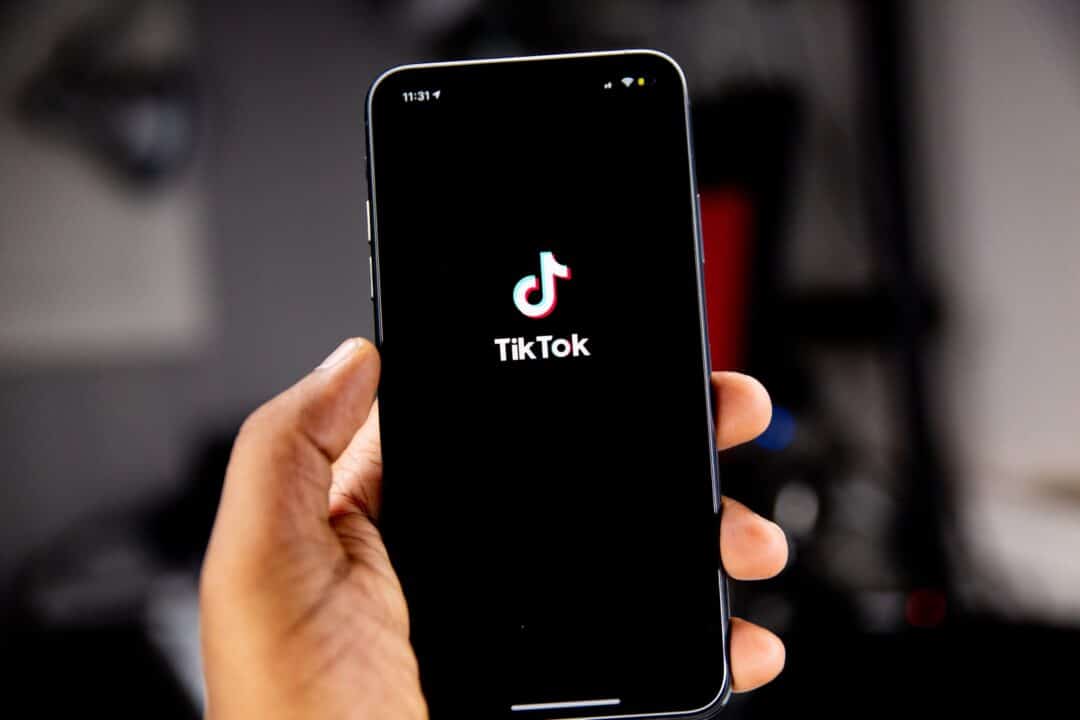
Steps for adding closed captions to an TikTok video
TikTok can be a demanding platform for publishers. If you’re focused on producing consistent video for your TikTok account, you have enough on your plate without trying to caption them yourself.
You can take advantage of Amberscript’s accurate and fast caption tools to make sure that you’re making the most out of your TikTok videos without adding more work for yourself.
1. Upload your video to Amberscript
Captioning your TikTok video starts by simply uploading it to Amberscript, which takes minutes. You have the option of sending us your TikTok videos in a wide range of file formats of your choice.
2. Generate captions for TikTok videos with Amberscript
Once you’ve uploaded your TikTok video, you have a few different options for captioning your video. For day-to-day video content, our powerful automatic AI caption generator gives you an on-demand option for adding captions quickly and efficiently.
When you want to add other languages or add more complex, technical captions, our expert transcribers take care of business for you.
Automatic subtitles
Our powerful Automatic subtitles platform is available to you anytime you need with high accuracy transcription. We use advanced automatic speech recognition and alignment technology to process the speech in your TikTok videos into captions.
Captions are automatically lined up in your video while you wait. Once the video captions are placed, you have the opportunity to view the product and make edits before finalizing it.
Manual subtitles
If you’re looking to offer your TikTok video with different language caption options for audiences around the world, you can take advantage of Amberscript’s Manual Translated subtitles. You specify the languages you want your videos captioned in and our team will caption your video in them.
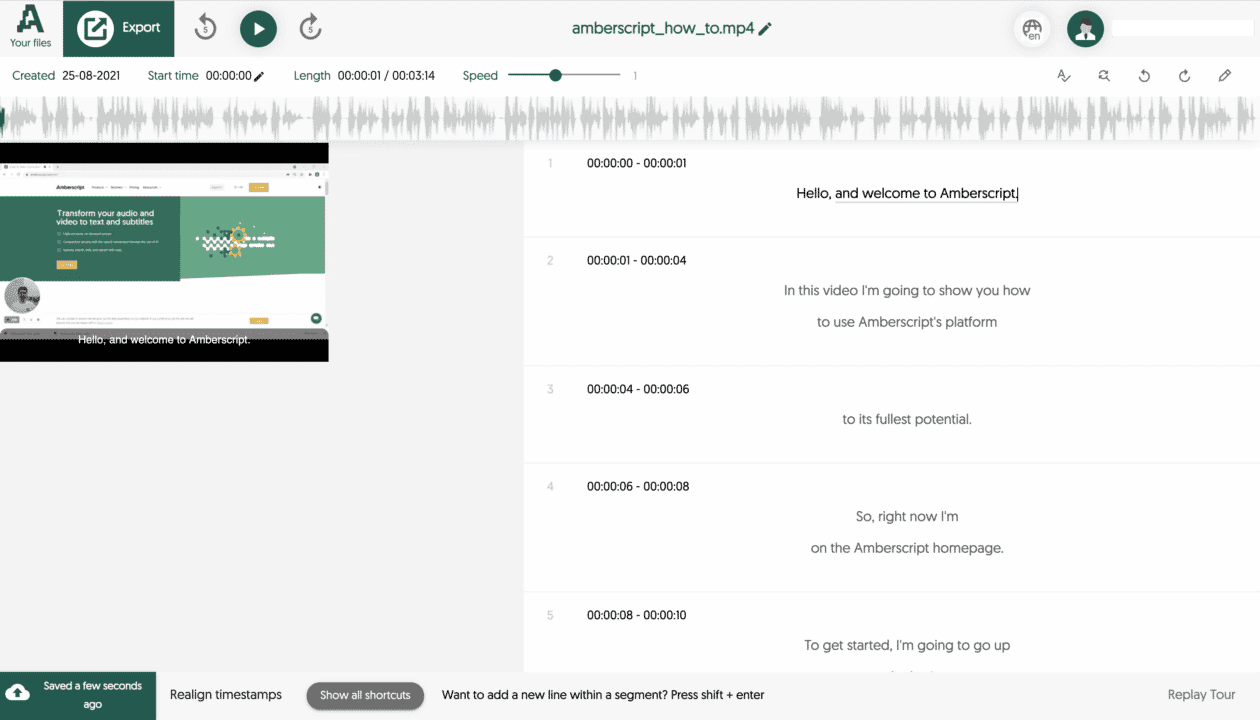
3. Customize the subtitles
Amberscript’s AI caption generator allows you to make adjustments and edits after your video is processed. That includes adjusting the timing of the captions on your TikTok videos. Automatic captions have very high accuracy, but there may be slight changes you want to make out of preference.
To do so, make use of our online editor. The editor intuitively displays timestamped captions alongside your video so you can easily navigate through the video and make adjustments as you go. You can directly make edits to text as well.
4. Download the finalized video and upload to TikTok
Once the final version of your TikTok video is approved by you, you can export it in the video file format of your choice. Export the video with captions and upload it directly to TikTok for publishing.
In addition, you have the option to download the captions as text separately. Download them as Text, SRT, VTT, or EBU-STL files, or any number of other formats available to you.
The process is designed to make it easy to produce captions for your TikTok videos quickly, efficiently, and affordably.
How to add subtitles to Udemy courses and increase engagement
The global eLearning market has tremendously grown in recent years, and it is projected to continue in the future. More institutions are utilizing the internet through eLearning platforms like Udemy to disseminate knowledge and teach new skills to millions of people from all over the world.
This means that there are numerous resources made available every day by different educators. This makes it hard for your content to stand out, especially if it’s similar to everything else available online. That’s where captions and subtitles come in! Your online video viewing can go up by as much as 40% by simply adding subtitles.
What is Udemy?
Udemy utilizes online video courses to make the learning experience as immersive and interactive as possible. They also publish new videos in their libraries every month, meaning that the modules are up-to-date.

What are Subtitles and Captions?
Most people use the terms subtitles and captions interchangeably. Even though both captions and subtitles are the text version of the spoken audio in a video, there is a distinction between the two. Subtitles often involve translating the video’s language into an alternative language. On the other hand, captions are usually in the same language as spoken in a video.
When included, subtitles allow people to watch your video even if they don’t speak the native language in the video. This makes your online learning videos accessible to a larger (international) audience. Captions help hard-of-hearing students to comprehend and experience the video. This is because captions include background noises and speaker changes.
What Are the Benefits of Adding Subtitles to Udemy Courses?
Adding subtitles to your Udemy Courses is more than just functional. Captions and subtitles have been proven to significantly improve engagement and boost the performance of your eLearning videos. Here are some ways that your online learning videos will benefit from adding subtitles and closed captions:
Better User Experience
Sometimes your students find themselves in situations where they need to watch your videos when muted. This could be because they are in a library or sharing a workspace and don’t have headphones, or they are simply in a noisy environment and can’t clearly listen to the audio. Whatever the case, learning doesn’t need to stop.
When you add subtitles to Udemy, your learners can take notes, get exact spellings of words spoken and continue the learning process regardless of whether the audio is on or not.
Increases Video Accessibility
Your Udemy learning videos are more inclusive with captions. It makes it possible for individuals with hearing impairment to enjoy your content. Inclusive videos also help widen your user base. You could miss out on millions of learners around the world by not adding captions and subtitles to your videos.
In 1990, the American Disability Act (ADA) – a law to accommodate persons living with disabilities – was passed. Public and private institutions must offer captioning to support deaf or hard-of-hearing individuals to be ADA compliant. Ensure that the captions are not just a summary of the audio. For all your users to enjoy the exact experience as those watching with audio, you should caption every word and sound in the video.
Improves Information Retention
Sometimes a lot is going on from audio to visuals, such as several voices talking at once or construction noises in the background. Perhaps you are using a lot of technical terms, or your students hear a homonym and get confused. Whatever the case, viewing whatever the speaker is saying on screen dispels any confusion and distraction.
When creating an eLearning module, you want your learners to trust your material. This is possible only when there are no comprehension problems. Captions not only improve comprehension but also information retention. Research shows that adults are more likely to remember technical terms when videos include subtitles or captions. Eventually, learners will choose your eLearning modules over competitors’.
Optimize for Search Engine Algorithms
Adding subtitles can improve your SEO (Search Engine Optimization) and boost the reach of your eLearning materials. Search engines such as Google can crawl through your eLearning materials if they have captions or subtitles included. The search engines will then display your videos to the relevant audiences.
Remember that subtitles and captions are tools to improve your video experience. This means that you should not use them to stuff keywords and irrelevant information which will create a poor experience for your audience.

How to Add Subtitles and Captions with Amberscript?
By now you have realized how including subtitles and captions can improve your videos and are considering it. Udemy has auto-generated captions available in English, Spanish, and Portuguese. However, this is rarely accurate meaning that you might have to upload your own subtitle files.
You work hard to create your eLearning modules, meaning that your students should get the correct captions with exactly what you are saying. Well, you will first need to create a file with accurate timestamps and subtitles that you can upload to Udemy.
Seems too complex? Well, adding captions to your Udemy courses is easier than you might think thanks to Amberscript. Instead of sitting for hours subtitling your videos, you can let us do that for you. You can concentrate on making amazing eLearning modules while sure that you will have accurate subtitles with minimal time and effort.
Here is how to add captions and subtitles to your Udemy videos with the help of Amberscript.
1. Record your Course
The first step is to create the learning material by recording the video of the course. Use a neutral accent and record the video in a quiet environment. This not only gives your audience a great experience but also makes it easier to accurately caption your video.
2. Upload Video to Amberscript
Once the video is ready, you then upload it to Amberscript in just a few clicks. Amberscript supports multiple video formats.
3. Choose Automatic or Human-made Subtitles
We offer two options to generate your Udemy course subtitles. You can either opt for our automatic subtitle service or our human-made (manual) subtitles service.
Automatic Subtitles:
Once you upload your video, our speech recognition engine creates the first version of your captions. This has been proven to save up to 10x the time that it would take you to caption it yourself. Automatic subtitles are a fast and budget-friendly way to generate your Udemy course subtitles.
Our AI and speech recognition software is extremely accurate and you can expect the captions to be on point. However, even machines sometimes make small errors from time to time. You can fix any spelling errors for proper nouns or adjust the timestamps using our online editor.
Human-made (Manual) Subtitles:
For more technical videos, we recommend using our manual subtitles service. Although it takes a bit longer compared to automatic subtitles, it offers up to 100% accuracy. With manual subtitles, one of our language experts will perfect and quality check your captions before delivering your subtitle files. We also offer translation services to help you reach a wider audience.
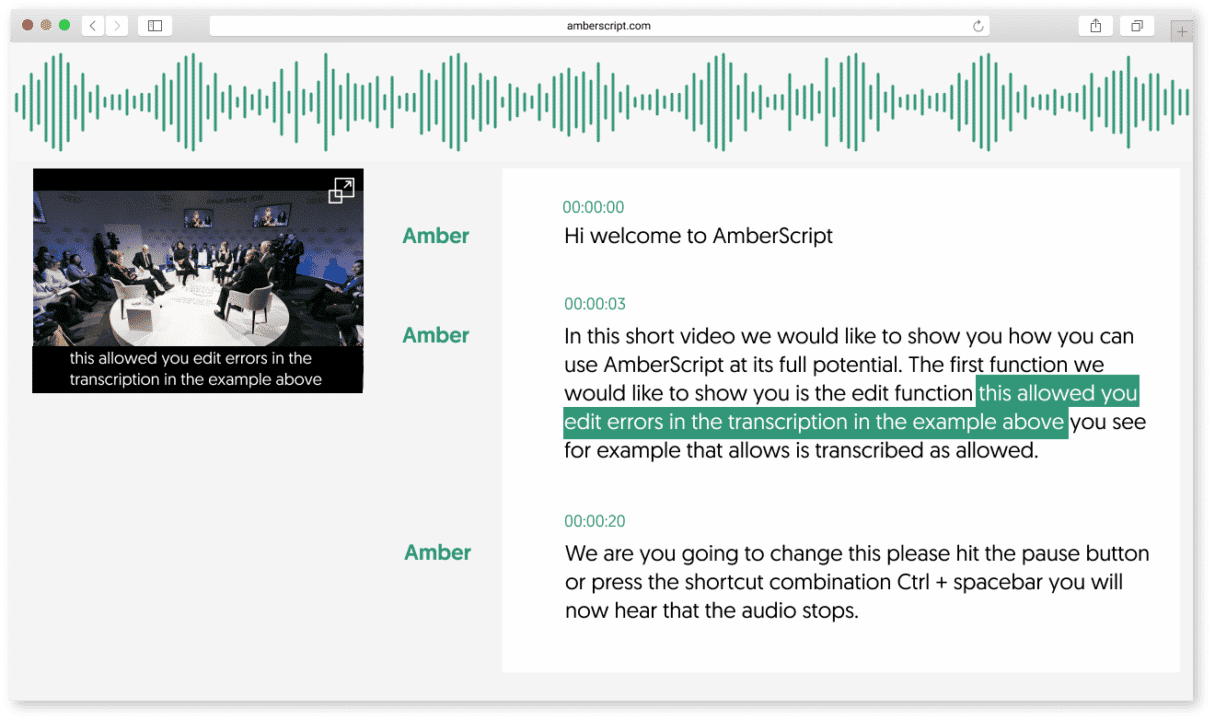
4. Export Your File in .vtt
Once you’ve finalized your captions, Amberscript generates a caption file for you to download. There are several format options to choose from, but for Udemy the best file format is .vtt.
5. Upload to Udemy
Once you have downloaded the caption file, you can then upload it to Udemy in a few easy steps. You can follow the specific up-to-date guidelines highlighted here to add the subtitles to your eLearning videos.
About Amberscript
We combine the best talents in technology, language, and science to create the most accurate speech-to-text tool. We also ensure lightning-fast service without compromising on the quality of your subtitles. Consider us the solution that you can count on when it matters most.
We understand that creating online learning videos is time-consuming and prioritizing captions and subtitles can feel like a tedious task. Amberscript allows you to focus on making your eLearning modules while you get accurate captions for the same at an affordable price. Try it out today, and you will see that it is definitely worth every penny.
How to add subtitles to Instagram videos and reels?
Instagram is one of the world’s top video content platforms. On a platform with plenty of quantity, it’s even more important to make sure that you’re putting out the quality of video people want to earn their views.
Subtitles and captions have become an essential part of Instagram videos and Reels for effectively connecting with audiences. Placing subtitles on your videos increases engagement, views, and the length of time that people watch your videos.
Adding high-quality subtitles to your Instagram videos doesn’t need to be a complicated process and will help you make the most of your social media presence. Here’s what you need to know about Instagram Reels and how you can easily add accurate, engaging subtitles to them.
What are Instagram Reels?
Instagram Reels are short, scrollable videos that are quickly becoming the main media type on people’s profiles. Reels were created in response to the popularity of TikTok videos, and are now the way that many people and brands engage with and produce content on Instagram.
Reels can be up to 60 seconds long. You can add music or audio to the video, AR effects, adjust the speed of the video, and apply other fun edits directly in Instagram’s editor.
Reels are fullscreen videos, which is one reason why they have the best engagement on Instagram — they dominate the screen. The other reason is that Instagram prioritizes Reels content in its algorithm. But even though Reels have exciting options to add popular sounds and music, using text is still one of the most effective and easy ways to improve your videos’ performance.
How can adding closed captions to your Instagram video increase engagement?
Most people are aware that adding captions and subtitles to videos increases accessibility and inclusivity. Nowadays, having subtitles on Instagram videos has many other benefits that boost engagement, watch time, and other important performance metrics.
Captures attention quicker
Around 65-percent of people are visual learners, giving you a real opportunity to pull viewers in. That being so, Instagram users are seeing your Reels as they scroll through a sea of other Reels.
If they’re not immediately sure of what’s happening in the video and if it’s of interest to them, they’re likely to scroll past it. After all, the average person has an attention span of only eight seconds.
When you include subtitles, viewers have more information to quickly understand what’s going on in the video. You may not have been able to capture that attention with your visuals alone.
Engage users without sound
For many, audio is an important part of video content. The problem is, you can’t rely entirely on great audio to attract and engage viewers. Nearly 70-percent of people watch videos with the sound off when they’re in public.
If people can’t understand what’s going on in your video with the sound off, they’re likely to skip it. Most people are more likely to finish videos that include closed captions or subtitles.
Younger generations prefer subtitles
The use of subtitles isn’t limited to social media. Studies show that up to 80-percent of young people prefer subtitles some or all of the time when they watch TV. That’s a preference that extends to social video content like Reels.
Over 78-percent of Instagram users range from 18-34 years old, which is the same demographic that chooses to put on subtitles when they watch videos. Instagram audiences are exposed to a wide range of video content, and subtitles offer a standard comfortable way for them to engage with and understand all of those different videos.
Videos are easier to understand
Subtitles ultimately make your Instagram videos easier to understand and engage with. Similar to how you can more quickly capture attention with captions, you can also more effectively communicate your message.
It’s proven that videos with text stand out more and are more memorable than those without it. Information that’s communicated by text is easier to remember and process for many audiences, especially the younger generations that make up a large part of Instagram’s user base.

Steps for adding closed captions to an Instagram video
Generating captions can definitely be time consuming when you do it yourself. Luckily, you can add captions and subtitles within minutes when you use Amberscript. Here’s how it works.
1. Upload your video to Amberscript
When you’re ready to caption your video, simply upload it to Amberscript. Uploading is fast and easy, and you can send your video to us in most any file format.
2. Generate captions for Instagram Reels with Amberscript
You have options for adding captions to your video once it’s uploaded. Amberscript gives you the flexibility to add subtitles automatically on demand within minutes. You can also take advantage of language translations and technical transcription by using Amberscript’s manual transcription service.
Automatic subtitles
For a quick turnaround, you have our Automatic subtitles platform at your fingertips anytime you need. Amberscript uses advanced automatic speech recognition and alignment technology that does all the work for you.
Upload your Instagram Reel and our AI delivers an accurate transcription automatically while you wait.
Manual subtitles
With over a billion Instagram users in the world, you may want to add subtitles to your Reels in multiple languages. Send your video to us and our language experts will add subtitles in the languages of your choice.
3. Customize the subtitles
When you use Amberscript’s AI subtitle generator, you have the opportunity to make any adjustments you want to the text after it’s generated. Once it’s finished processing, you have full access to our text editor to make those adjustments with ease. If you choose our Manual service, you can go ahead and skip this part.
Our Automatic subtitles are delivered with high accuracy. Even so, you may want to realign the timing of some of the text in your video. Subtitles are timestamped, so you can use the online editor to make any changes you want before finalizing it and exporting.

Download the finalized video and upload to Instagram
You have many different options for exporting your video once it’s ready to go. Download your Reel as a video file with the subtitles burned in so you can upload it to Instagram directly. If you want the subtitles in a separate file, you can download them as Text, SRT, VTT, or EBU-STL files. Several other formats are available as well.
From there, it’s just a matter of rinse and repeat. With Amberscript, you have access to high-quality, fast transcriptions that you can produce at scale.
How to add captions & subtitles to a LinkedIn video step by step
More and more companies and professionals are choosing LinkedIn as a networking platform. With the growth in popularity, social media trends like video, are making their way to the platform.
As a brand or individual looking to improve your LinkedIn video content, you might be surprised by captions and subtitles. Both are an easy way to improve your engagement.
In this article, we’ll cover the benefits of captions and subtitles and how you can add them to your LinkedIn videos.
What is LinkedIn?
LinkedIn is a social media platform that helps professionals connect with one another. Unlike platforms like Facebook or Instagram, LinkedIn is designed to focus more on careers. Users can use LinkedIn to share their thoughts and professional insights. The platform also has features to help individuals search for jobs, learn about companies, and get industry news.
Like many other social media platforms, LinkedIn allows users to share videos. Helping brands and users connect with their communities through more than just text.
What are subtitles and closed captions?
Subtitles and closed captions are similar but have slightly different purposes. Both are text that is displayed at the bottom of the screen that reflects the audio in the video.
Subtitles are primarily to help users understand audio in a different language. These are typically translations of the audio. This makes a video accessible to users, even if it’s not originally in their native language.
On the other hand, captions are designed to be used by individuals who are hard of hearing or deaf. They will often include more details such as background noise, sound effects, and music.
Video content continues to grow in popularity across platforms. As a result, subtitles and captions are gaining traction as well.
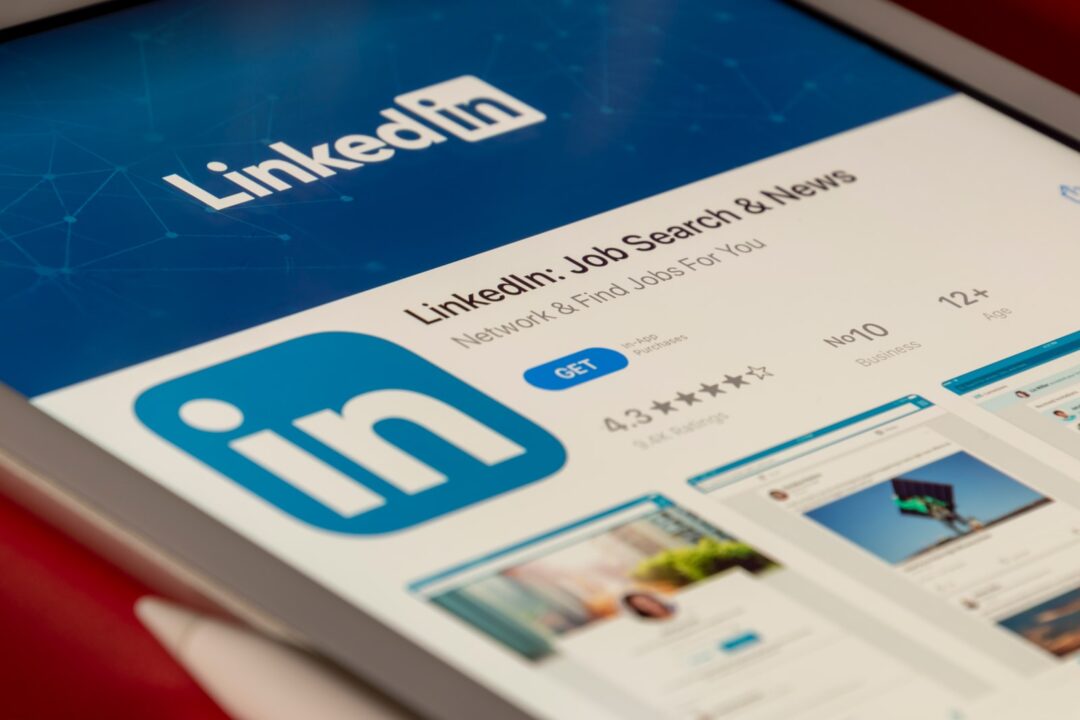
How can adding closed captions to your LinkedIn video increase engagement?
There are many practical reasons to add closed captions or subtitles to your LinkedIn videos. But one of the biggest benefits is increasing the engagement of your videos.
Increases accessibility
Closed captioning in particular, was designed as an accessibility feature for the deaf and hard of hearing. Build a foundation of accessibility by prioritizing accessible content on LinkedIn.
Approximately 15% of American adults report some hard of hearing. By including closed captions in your videos, you’re making your videos available to a much wider audience. Not only will this help more LinkedIn users enjoy your content, but it will also result in better engagement.
Boosts understanding
LinkedIn is a wealth of knowledge for professionals in any industry. With that in mind, LinkedIn videos can often include complex topics or industry jargon.
Add closed captions to your video to help your audience understand your content. This can make it easier for more users to engage with your videos and help them absorb the content faster. If users struggle with comprehension, it’s unlikely that they’ll want to watch or engage any further.
Improves SEO
Social media platforms, like LinkedIn, suggest content and videos based on their understanding of the topics. AI is becoming increasingly good at interpreting videos and audio. But most platforms still rely heavily on text interpretations. Having captions makes it easier for the algorithm to display your LinkedIn content to the right users.
Search engines such as Google, will also often pick up videos from LinkedIn in search results. Which makes it possible to reach even wider audiences.
While there are many SEO benefits to including closed captions and subtitles, you should still be using them correctly. It is not appropriate to stuff captions with keywords as they should be direct transcriptions of the audio in the video. Search engine and platform algorithms consider these tactics to fall into the category of ‘black hat marketing’. Platforms understand that misuse provides a poor experience for users who rely on captions and subtitles. As a result, they disapprove of improper use.
Reach a wider audience
Closed captions can help make your LinkedIn video content accessible to more users, Meanwhile subtitles can help users across the world engage with your content. Subtitles are designed to be offered in many languages. This makes it possible for users who speak different languages to enjoy your videos.
Offering subtitles in different languages is particularly important if you have a global LinkedIn network. Platforms like Amberscript make it simple for you to translate your captions so you can make your content available to a larger audience.
Improves watch rates
Many LinkedIn users are at work or in an office, which means they’re likely scrolling their feeds without sound. By including subtitles and closed captions, they’re more likely to watch more of their video. Even users who are off the clock are more likely to browse without audio.
If there’s no way to understand the video without sound, the user is likely to move on. Making captions even more important to bolster engagement rates.
Over 80% of consumers say that they would be more inclined to watch a video in full if there are captions available. This means you could be losing on a huge viewer base by skipping out on captions.
Steps for adding closed captions to your LinkedIn video
There are many benefits to adding closed captions to your LinkedIn videos. Fortunately, adding captions is simpler than most people think!
Transcription platforms like Amberscript help generate captions and subtitles quickly and affordably. There’s no need to manually scrub through your content to create your captions.
Here’s how you can generate captions and subtitles for your LinkedIn videos in 4 easy steps.
Upload your video to Amberscript
Once you’ve finalized your LinkedIn video, you can easily upload your file to Amberscript.
Generate captions with Amberscript
Once you’ve uploaded your video, Amberscript can help turn your audio into text for captions. Amberscript’s easy-to-use platform offers two ways to generate captions. Depending on your content, you can choose between Manual subtitles or Automatic subtitles.
Manual subtitles are the perfect solution for technical LinkedIn videos. When choosing our Manual subtitle service, you get a language expert who takes the time to perfect your captions. We also check your captions for quality before we deliver your files. While this service takes a touch longer, this guarantees captions that are 100% accurate and ready to upload.
If you require a faster turnaround or are looking for a budget-friendly solution, Amberscript’s Automatic subtitle service is the way to go. Our speech recognition technology carefully scans your content to generate an initial set of captions. Amberscript’s AI is extremely accurate, helping you save up to 10x the time when compared to captioning your own videos.
Customize the captions
Whether you choose our Manual or Automatic services, you’ll always have an opportunity to review and customize your captions. Our cutting-edge technology means you can always expect captions that are pretty close to error-free.
However, we’ve made it easy for you to make any tweaks if necessary. Using our online editor, you can make changes such as adjusting names or updating timestamps. You can also add any custom captions for audio or other details within your video.
If you need more options, our language experts can also help translate your subtitles to reach even more LinkedIn users.
Download the finalized video and upload it to LinkedIn
There are a few ways for you to add subtitles and captions to your LinkedIn videos.
If you’re looking to upload a video with captions burned in, you can download your video with the embedded captions right in Amberscript. This video file will include all your captions and is ready to upload to LinkedIn.
If you’d like to take advantage of LinkedIn’s closed captioning features, you can also download the SRT files. This file will include all the text and the relevant time stamps. Once you upload your video from your LinkedIn homepage, you can click ‘Edit’ in the top right corner of your video settings. Click ‘Select Caption’ to attach your Amberscript SRT file. Follow the remaining prompts to save and post your video.
For the latest details on uploading captions to your LinkedIn video, you can visit LinkedIn Help.

From improving accessibility to increasing engagement rates, adding captions to your LinkedIn video has many benefits,
However, generating captions doesn’t need to be rocket science. Instead of spending your time writing captions, let Amberscript do the heavy lifting.
Whether you choose our Automatic or Manual subtitle service, you can feel confident knowing you’ll receive precise and accurate captions at an affordable price – every time.
How to add subtitles and captions to Panopto?
When businesses and schools were forced to switch to digital content, video became one of the most popular methods of instruction and communication. It’s now easier than ever to create and share videos, but there’s still one hurdle that can prevent them from being as effective as possible – adding captions and subtitles.
At Amberscript, we’re all about ensuring everyone can enjoy the content they want, which is why we’re excited to show you how to add subtitles and captions to your Panopto videos! Read on for a quick breakdown.
What is Panopto?
Panopto is a leading video management system. They help businesses and universities improve how they train, teach, and share knowledge via video content. As millions of people upload their video content to Panopto, they want to make sure that everyone can enjoy and understand their videos.
Their main selling point is the security and privacy of their videos. They use a secure HTML5 player, meaning your video content is protected and can only be viewed by those with the link. There are also live streaming capabilities and password protection for certain videos.
The interface is very user-friendly and offers a wide range of features to help you manage your video content. You can easily upload videos, add subtitles and captions, create playlists, and embed your videos on your website or blog.
What are subtitles and captions?
Subtitles are a written representation of the spoken dialogue in a video. They usually appear at the bottom of the screen and include timely information so that viewers can follow along. Whatever is said in the video is written out in the subtitles so that viewers can follow along. You’ve most likely seen subtitles in foreign films or TV shows.
On the other hand, captions are a written representation of all the audio in a video, including dialogue, sound effects, and music. They usually appear at the bottom of the screen and include timing information so that viewers can follow along. Captions might consist of descriptions of sound effects, such as “phone ringing” or “doorbell.”
Both subtitles and captions are essential for viewers who are deaf or hard of hearing and for viewers who don’t speak the language of the video.

The benefits of adding subtitles and captions to Panopto videos
There are many benefits to adding subtitles and captions to your Panopto videos. First and foremost, it makes your videos accessible to a wider audience. This is especially important for businesses and universities who want to make sure that their video content is inclusive. They also:
Help viewers understand your videos better
Subtitles and captions help viewers understand your videos better by providing them with written context for the spoken dialogue and audio. This is especially helpful for viewers who are watching your videos in a noisy environment or for those who are not native speakers of the language. Studies have shown that viewers retain more information when they can read and listen to it simultaneously.
Improve search engine optimization (SEO)
Adding subtitles and captions to your videos improves their SEO because search engines can index the text. Your videos are more likely to appear in search results for certain keywords, which can lead to more views.
With Panopto’s robust search features, viewers can easily find the videos they’re looking for. And with subtitles and captions, they can understand your videos better too!
Make your videos more engaging
Subtitles and captions can make your videos more engaging by providing viewers with additional information about the content. For example, subtitles can help viewers follow along and understand the key points if you’re giving a presentation. If you’re sharing a story, captions can help describe the emotions and atmosphere.
Translate your videos into other languages
Adding subtitles and captions to your videos makes translating them into other languages easier and faster. You can either use automatic translation services or hire professional translators to create accurate subtitles and captions in another language. With Panopto, you can reach a global audience with your video content, but only if it’s accessible to viewers who don’t speak your language.
By making your videos accessible to a broader audience, you’re also more likely to get positive engagement.
Convey Professionalism
Subtitles and captions give your videos a more polished, professional look. They convey to your viewers that you care about making your content accessible and inclusive. Most importantly, they show that you’re willing to go the extra mile to ensure that everyone can enjoy and benefit from your videos.
Big-budget productions always include subtitles and captions, and there’s a good reason for that. Even if you’re just sharing a lesson with your school, it’s always best for your videos to look and feel like the real deal.

How to add subtitles to your videos with Amberscript.
Fortunately, Panopto makes it easy to add subtitles and captions to your videos if you already have the text. If you don’t have the text, you can either transcribe your videos or create subtitles from scratch.
Here’s a step-by-step guide to adding subtitles and captions to your Panopto videos:
1. Upload to video to Amberscript
First, you’ll need to upload your video to Amberscript. Amberscript is a subtitling company that provides both software and manual subtitles. Our subtitles are 100% accurate, and we can translate them into 39 languages.
To upload your video, simply go to our website to create a free trial account. Once you’ve created an account, login and click “Add new project.” Then, select the video file that you want to add subtitles or captions to. We accept all major video and audio formats, so you shouldn’t have any trouble uploading your file.
2. Choose manual or automatic subtitles
Next, you’ll need to choose whether you want us to create your subtitles and captions manually or automatically. If you choose our automatic option, we’ll use speech recognition technology to create subtitles from your video. This is a great option if you’re short on time or if you don’t have a transcript of your video. However, we recommend choosing the manual option if you want 100% accurate subtitles.
If you choose the manual option, one of our certified subtitle editors will watch your video and transcribe it into text. We’ll then create the subtitles and captions from that text. This option is more time-consuming, but it’s the only way to guarantee accuracy. Of course, a mix of both automatic and manual subtitles is also an option.
Creating subtitles with Amberscript is easy and affordable regardless of which option you choose.
3. Export your file
The final step is to export your file. Once your subtitles and captions are complete, you can download them in any major text format, including SRT, VTT, and DOCX. Panopto accepts all these formats, so you can easily upload your subtitles and captions to their platform.
That’s all it takes to add subtitles and captions to your Panopto videos! As you can see, the process is quick and easy with Amberscript.
How to burn closed captions in Panopto
Adding closed captions to your Panopto videos can make them more accessible to viewers who are deaf or hard of hearing, as well as those who speak a different language or are watching in a noisy environment. It’s a simple but effective way to improve the accessibility of your content.
- Open Panopto and navigate to the video you want to add captions to.
- Click on the Edit button to open the video editor.
- Click on the Captions tab in the left-hand menu.
- Click on the Create button to start creating your closed captions.
- Choose your caption format. Panopto supports SRT, WebVTT, and DFXP.
- Select the language you want to add captions for.
- Start typing your captions into the text box provided. You can also copy and paste captions from a pre-existing document.
- Sync your captions to the video by playing the video and adjusting the timecodes.
- Once you’ve finished adding your captions, click Save.
- You can now view your captions by clicking on the Captions button in the video player.
Panopto also offers the option to upload pre-existing caption files, which can save time if you’ve already created captions in a different program. To upload pre-existing captions, simply click on the Upload button on the Captions tab and choose the file you want to upload.
It’s important to note that closed captions are different from open captions. Closed captions can be turned on and off by the viewer, while open captions are permanently burned into the video. Panopto only supports closed captions, so if you need to add open captions to your video, you’ll need to use a different program. If you want more information about closed captions, you can find a detailed explanation on our blog.
About Amberscript
Amberscript is an AI-powered subtitling and captioning company. We provide accurate, affordable, and fast subtitles in a multitude of languages. Our platform is easy to use, and we offer both automatic and manual subtitle options. Our solution is perfect for businesses and universities that want to improve the way they train, teach, and share knowledge.
If you’re looking for a way to make your Panopto videos more accessible and inclusive, look no further than Amberscript. From Netflix to Warner Bros., our clients trust us to provide them with high-quality subtitles and captions. And we’re proud to say that we always deliver.
Our customer service team is available from Monday to Friday to answer any questions you may have. So, what are you waiting for? Sign up for free today and see how Amberscript can help you take your video content to the next level!
How to quickly add captions and subtitles to Skillshare courses
The global pandemic caused a massive surge in the popularity of online courses. People were looking for new ways to learn, and Skillshare provided an excellent platform for educators to share their knowledge.
However, with so many courses available, it can be hard to stand out from the crowd. One way to do this is by adding captions and subtitles to your lessons. This blog post will explain why you should add captions and subtitles to your Skillshare courses and how to do it better with Amberscript.
What is Skillshare?
First, let’s clarify what Skillshare is for anyone who’s not familiar. Skillshare is an online learning platform with classes taught by industry experts. Classes are available on a range of topics, from design and programming to business and entrepreneurship. For example, Seth Goden can teach you about marketing through a series of Skillshare classes.
While Skillshare is mostly aimed at adults, it’s also becoming increasingly popular with students. In fact, many universities are now using Skillshare as a supplement to their curriculum. This is because Skillshare offers a more hands-on, practical approach to learning than traditional lectures.
Skillshare is also convenient and flexible, as students can learn at their own pace and fit learning around their busy schedules. And with new courses added every week, there’s always something new to learn.
What are subtitles and captions?
Subtitles and captions are text that appears on the screen to accompany the audio of a video. They usually appear at the bottom of the screen and are used to provide translations or to make the content accessible to those who are deaf or hard of hearing. These text transcriptions can also be useful for viewers who are not native speakers of the language in which the video is narrated.
Captions are slightly different from subtitles, as they also include information about sound effects and other non-verbal audio cues. This makes them even more helpful for those with hearing impairments. For example, a caption might read: “SOUND OF A CAR HONKING.”
Subtitles and captions were originally developed for television and movies, but they are now widely used online. You’ve most likely seen them on Youtube videos or even paid to advertise. Ideally, the subtitles and captions should be synced with the video’s audio so that viewers can follow along easily.

What are the benefits of adding subtitles to Skillshare courses?
You might be wondering if it’s worth the effort to add subtitles to your classes. The answer is yes! There are several benefits to adding subtitles and captions to Skillshare courses.
The first is that it makes the content more accessible. This is especially important for those with hearing impairments, as they will be able to follow along with the course more easily. It’s also helpful for viewers who are not native speakers of the language in which the video is narrated.
In addition, subtitles and captions can be used to provide translations into different languages. This means that educators can expand the reach of their courses and make them accessible to a global audience.
You can also use subtitles and captions to improve the SEO of Skillshare courses. They provide an opportunity to include keywords that viewers might search for. For example, if a class is about marketing, the subtitles and captions could include keywords such as “digital marketing” or “social media marketing.” It will make the course more likely to appear in search results and attract more students.
Finally, subtitles and captions can make the content more engaging. They provide a way to break up the text on the screen and make it easier for viewers to follow along. They can also be used to highlight key points or add additional information that might be helpful for viewers.
Overall, adding subtitles and captions to Skillshare courses can be a great way to improve the reach, accessibility, and engagement of the content.
How to add subtitles and captions with Amberscript
As you may know, submitting a course to Skillshare requires a video. You have the option to upload your own video or create one using Skillshare’s built-in video editor. If you’re creating your own video, you’ll need to make sure that it includes subtitles and captions. The best way to do this is to use a subtitling service like Amberscript.
Of course, you could manually transcribe the video and create the subtitles and captions yourself. However, that is a time-consuming process, especially if you have long lessons or multiple modules. It’s also likely that you’ll make mistakes if you overwork yourself.
This is where Amberscript comes in. We provide both software and manual subtitle services to create accurate and synchronized subtitles and captions for your Skillshare course. We also translate into 39 languages, so you can reach a global audience. Our team of subtitle experts will ensure that your subtitles and captions are of the highest quality.
Here are the main steps involved in adding subtitles and captions to your Skillshare course with Amberscript:
1. Record your course
If it’s not already, your course must be in video or audio format. The video can be recorded using a webcam, smartphone, or another device. If you’re unsure how to record a video for education purposes, Skillshare has a helpful guide that walks you through the process. Make sure to articulate clearly so that your words can be easily transcribed.
You also want to avoid speaking too fast, as this can make it difficult for listeners to keep up. A good rule of thumb is to speak at a rate of about 150 words per minute. This may seem slow, but it will help to ensure that your words can be transcribed accurately.
2. Upload video to Amberscript
The next step is to upload your video to the Amberscript website. We accept most major video/audio formats, including MP4, MP3, and MOV. You’ll need to create an account if you don’t already have one. Uploading your video is free, and we don’t have any hidden fees.
Once your video has been uploaded, you’ll need to select the language(s) into which you want it to be translated. Our features are available on both desktop and our mobile app, so you can create subtitles and captions anywhere, anytime.
3. Choose Automatic or Human-made subtitles
Next, you’ll need to decide whether you want automatic or human-made subtitles. Automatic subtitles are created using speech recognition software and are typically less accurate than human-made subtitles. For this reason, we recommend choosing human-made subtitles for your Skillshare course.
Our team of subtitle experts will use the software for speed, but they’ll also listen to the audio and edit the subtitles by hand to ensure that they’re accurate. This process usually takes 24-48 hours, but we can often deliver the subtitles sooner if you need them urgently.
4. Export your file
Finally, you’ll need to export your file to upload it to Skillshare. We provide subtitles in the following formats:
- .docx
- .json
- .srt
- .vtt
- .EBU-STL
- .Txt
These are all standard subtitle formats that you can upload to Skillshare. Once you’ve exported your file, you’re ready to upload it to Skillshare and start reaching a global audience!

About Amberscript
Why choose us? AmberScript is the leading provider of subtitles and captions. We offer both software and manual subtitle services to create accurate and synchronized subtitles and captions for your Skillshare course. We’ve worked with big industry names like Netflix, Disney, and the Government of Quebec.
Our subtitlers are all native speakers of the target language, meaning they can create accurate and sound natural subtitles. They’re also experts in subtitling conventions, so you can be sure that your subtitles meet all the necessary standards.
If you have any more questions about how to add subtitles and captions to your Skillshare course or about our services, please don’t hesitate to contact us. We’re always happy to help!
Try Amberscript for free today.
How to Add Subtitles to TikTok Videos and increase engagement!
TikTok is one of the most popular social media applications today, and millions of users are using it daily. If you want to maximize your exposure on TikTok, you need to make sure that your content is appealing and engaging enough to keep viewers interested in it. This means that you need to include subtitles in your TikTok videos so that viewers know what they’re watching. However, not all TikTok users understand how important subtitles are or how to add them to TikTok videos.
So, if you’re interested in learning how to add subtitles to TikTok videos and how having subtitles can help increase engagement, then this article is for you!
What is TikTok?
TikTok (also known as Douyin in China) is a social video platform developed by ByteDance that has over 1 billion users as of September 2021. If you’ve never heard of TikTok, here’s what it is: It’s like Snapchat or Instagram, except it’s for video rather than still images. It lets you create short videos up to ten minutes long and then share them with your followers. You can also follow other users on the platform, who will then be able to follow you back.
TikTok is becoming popular all over the world because it’s easy to use and fun as well as useful for sharing short clips with friends or strangers around the world. You can create an account free and start making videos with all sorts of fun filters and effects. You can also chat with friends who are on TikTok and share your videos with them.

What are Subtitles on TikTok videos?
Subtitles are text overlays that appear over the TikTok videos. They provide translations, descriptions, and other information about the video. You can use them to add clarity to your TikTok videos.
Subtitles are great for people who struggle with hearing or processing audio because they let you read along with the video without having to strain your eyes or ears! They also increase comprehension by providing additional information about what is being said during a video.

How Can Adding Subtitles Increase Engagement on Your TikTok Videos
Makes Your Content Accessible to More People
Using your smartphone to record a video and upload it on TikTok is easy. But, finding a massive audience to watch video on the platform is a little bit more complicated. However, subtitles are one of the most powerful tools you have at your disposal when it comes to increasing engagement on your TikTok videos. Here’s how.
In today’s world, a lot of people want to watch videos with subtitles! Subtitles are a great way to make sure that everyone can get the most out of your content, regardless of their ability to hear or understand what’s being said.
Deaf or hard of heard people can often get a lot out of subtitles because they can’t hear the dialogue as well as others. When you have a video with subtitles, it will be easier for these users to access and enjoy, which will increase engagement in your TikTok videos.
Overcome Language Barriers
Subtitles can be used to overcome language barriers by translating words or phrases into the user’s preferred language. This is especially helpful for content creators who may not have an interest in learning foreign languages but want their content translated into other languages so that it can be viewed by audiences around the world!
Moreover, your audience will appreciate this as well because it shows you care about them and want them to be able to understand everything that’s being said.
Improve User Watch Time:
People who are watching your video will be able to understand the message better and get more out of it. If people who are watching your video are having trouble understanding what’s happening, they may just give up on your video – but if they know exactly what’s going on, they might be more likely to stick around and watch until the end.
In fact, research has shown that subtitles can improve users’ watch time by 40%, and it also increases their chances by 80% of watching your entire clip – which means you’ll have more opportunities for engagement if you include them in your videos!
Improve SEO and Google Ranking
Subtitles are a great way to improve your SEO because they are indexed by search engines. When someone searches for a specific word or phrase, the search engine will look at the words that it finds in the subtitles of your video and return results for those particular words. This means that if you have subtitles in your videos, users can find them more easily, and this can improve their search engine rankings which means more traffic for you and more views for all of your videos!
User Experience
Adding subtitles to your TikTok videos is a great way to add more depth to your content and make it easier for your audience to understand what they’re watching.
It will also help you create a more inclusive experience for your viewers, as well as make it easier for them to interpret what they’re seeing. Your video will still be engaging even with the sound off, and your viewers won’t have to strain their ears while trying to make out what’s being said.
How to Add Subtitles to a TikTok video with Amberscript
Amberscript is a powerful subtitle tool that can help you add subtitles to your TikTok videos. It offers a lot of features, and the best part is that it’s really simple to use. Here’s how to use Amberscript to add subtitles to your TikTok videos:
1. Upload Your Video to Amberscript
Go to the Amberscript, click on upload file, and select the file you want to add subtitles for. The file must be in one of the following formats: MP3, MP4, AAC, M4A, M4V, MOV, WMA, OPUS, FLAC, MPG, and WAV.
2. Generate Captions with Amberscript
Once you’ve uploaded your video to Amberscript, it will automatically detect the audio track and generate captions for your video using advanced speech recognition technology.
If you prefer a manual approach, there are also professional translation and captions services available. Our language experts will manually translate or create the subtitle into the language of your choice. Please note that automatic subtitles work with 35 different languages, and manual subtitles work with 11 different languages (though you can request a language by contacting our support). You can also manually type or edit the captions in our online text editor if you’d like.
3. Customize the Captions
Sometimes it’s just not enough to just add subtitles. You might want to personalize them, too. Using our online text editor, you can set up your own captioning style. You can customize the captions by selecting a specific font, size, color, and style. Some TikTokers prefer italic or cursive captions, whereas others prefer normal or bold texts. Customizing the captions is a great way to add some value and make your TikTok videos stand out.
4. Download the Finalized Video and Upload It to TikTok
Once you’ve customized your captions, download your subtitle file. You can choose from a variety of subtitle export options, including SRT, VTT, or EBU-STL files. After you’ve got your video ready, embed your subtitles into your video using any decent video editor tool. After that, just upload it back to TikTok!

Conclusion
TikTok has taken the internet by storm and become one of the most popular apps out there. People are filming their day-to-day lives and uploading funny or silly things on TikTok. People are also adding subtitles to those videos to make them funnier and easier to understand for the viewer.
Adding subtitles to your TikTok videos takes just a few minutes, but it’s well worth the time if you have a lot of non-English speakers following you or if you want to make sure that your message gets through on every video. It may seem like a small thing, but subtitles can help you reach more people and grow your audience.
How To Add Captions & Subtitles To A Twitter Video?
What is Twitter?
Twitter is a popular social media platform that makes it easy for individuals and brands to connect with their audiences. Users primarily communicate through short 280-character messages called ‘tweets.’ However, Twitter supports other forms of media such as photos, audio, and video.
Video is one of the best ways for your brand to reach your audience through Twitter. Unlike the text in tweets, there are no limits on the length of videos. While we love short and snappy content, sometimes it’s easier to communicate through longer and more personal media.
How can adding closed captions to your Twitter video increase engagement?
Adding closed captions to your Twitter videos is more than just functional. Captions and subtitles are proven to improve engagement and boost the performance of videos across social media platforms.
Here are some ways you’ll benefit from adding closed captions and subtitles to your videos:
Improves accessibility
Closed captions make your Twitter videos more inclusive. It makes it possible for those who are deaf or hearing impaired to enjoy your content. Inclusivity and accessibility tend to fall to the wayside for many brands. But having accessible content is important and helps you overreach a larger user base! Without captions, you could be missing out on connecting with millions of Twitter users around the world.
When it comes to accessibility make sure your captions are more than just summaries of the audio. You should be captioning every word, so users can enjoy the exact same experience as those watching with audio.
Better user experience
Most social media users tend to watch videos without sound. This is particularly true for a platform like Twitter, where the primary medium is text.
If users are silently browsing their Twitter feeds, they’re more likely to engage if the captions provide some context for the video. Otherwise, the video might make no sense or seem less interesting. As a result, they’ll scroll past your video without a second thought.
80% of consumers say they’re more likely to finish a video if there are captions available. Instead of forcing your audience to turn on their audio, make it easy for them to enjoy the video without it.
Help your videos stand out
Your audiences have never been more stimulated. We’re all being bombarded with content from the moment we wake in the morning. This doesn’t just include Twitter, we’ve got platforms like Tiktok and Instagram making it possible to scroll through endless amounts of videos and information.
On average, you have three seconds to capture the attention of a user. By adding captions, you have more than just the visuals to help generate immediate interest in your Twitter video. Once you’ve captured their interest, they’re more likely to complete and engage with your video.
Easier to understand
From audio to visuals, sometimes there’s a lot going on in a video. Maybe there are several voices talking at once. Perhaps you’re using a lot of technical terms.
Twitter captions provide an alternative way for users to absorb your content. Many users find it easier to understand the information they read versus through audio. Even the simplest of videos can benefit from captions to improve understanding. The more users understand your content, the more likely they are to engage, share, or re-watch.
Not only do captions improve comprehension, they also improve retention. Adults are more likely to remember brand names when videos include subtitles or captions.
Optimize for the algorithm
Many platforms have machine learning that helps the algorithm understand the audio and visual effects of a video. This is how they know who to best show your video to. You can help Twitter (and other platforms) understand your video through captions.
This can also help search engines, like Google, index your content. They’ll crawl your captions for relevant keywords and phrases to display your video to relevant users.
Many social platforms have denied that captions have any impact on results and rankings. However, Twitter video captions are still an effective way to ensure your videos are reaching the right audiences. You can also optimize your titles, descriptions, and title tags to boost your performance.
However, remember that closed captions and subtitles are tools to improve your Twitter videos. You should be using them as intended – to caption your videos. Do not use them to stuff keywords or add irrelevant information. This will create a poor experience for your audience and leave them feeling frustrated.
Steps for adding closed captions to a Twitter video
Once you’re ready to upload closed captions to a Twitter video, you’ll first need to generate the captions. Once you have a file with the accurate time stamps and subtitles, you can upload this to Twitter.
Sounds complicated? Adding closed captions to your Twitter videos is actually easier than you might think. Instead of spending hours subtitling your videos, you can get your captions through Amberscript.
Amberscripts does the heavy lifting so you can have accurate subtitles with minimal time and effort. Here’s how you can add captions and subtitles to your Twitter video with the help of Amberscript.
1. Upload your video to Amberscript
Once your video is ready to go, you can upload it to Amberscript in just a few clicks.
2. Generate captions for Twitter with Amberscript
We offer two ways for you to generate captions for your Twitter videos. You can use our Automatic subtitles service or our Manual subtitles service.
Automatic subtitles:
Once you upload your video, our speech recognition engine creates a first version of your captions. This could save you up to 10x the time it would take to caption it yourself.
Automatic subtitles are a quick and budget-friendly way to generate captions for your Twitter videos.
Manual subtitles:
For more serious and technical videos, choose our Manual subtitles service. Manual subtitles take a bit longer but offer up to 100% accuracy. One of our language experts will perfect and quality-check your captions before delivering your files. We can also translate your subtitles to help you reach an even larger audience.
3. Customize the caption
Amberscript’s AI and speech recognition software is extremely accurate. You can expect your captions to be pretty close when it comes to text and time alignment.
However, everyone makes mistakes from time to time (even computers!). When using Amberscript’s automatic subtitle service, you’ll be able to make any necessary edits before downloading your files. This includes fixing any spelling errors for any proper nouns or adjusting the time stamps. You’ll also be able to add custom captions. Our online text editor makes it easy for you to preview your video and make any changes.
Amberscript Manual subtitles go through several quality checks, so there is no need for any detailed editing. However, if you want to polish the final captions, you can still do so using our online editor.
4. Download the finalized video and upload to Twitter
Once you’ve finalized your captions, Amberscript will generate a caption file for you to download. For Twitter, the best file format is SRT.
When uploading your video to a Tweet, you’ll be able to select ‘Upload caption file’ directly below the video. Upload your Amberscript .srt file. Once you’re happy with your text and video, you can publish your Tweet.
Another option for adding captions and subtitles to a Twitter video is to download your video with embedded captions. However, this method means Twitter may not be able to scan for keywords within your videos.
You can find up-to-date information on uploading caption files to a Tweet here.
—
Creating content for your social media channels is time-consuming. Prioritizing captions and subtitles can feel like a challenge. However, closed captions and subtitles are one of the easiest ways to improve the performance of your Twitter videos.
Amberscript makes it easy for you to get accurate captions, quickly and at an affordable price. So you can spend more time engaging with your audience, instead of writing captions.
How to Transcribe Your Microsoft Teams Meeting
For many individuals, video conferencing has become an everyday aspect of their lives and work. From corporate meetings to remote training to virtual get-togethers with clients and colleagues, more and more people rely increasingly on tools such as Microsoft Teams.
In this blog, we’ll discuss the importance of Microsoft Teams transcription and how easy it is to transcribe your next MS Teams session with Amberscript.
What is Microsoft Teams?
Microsoft Teams is a free multi-channel corporate communications platform and virtual workspace. It’s designed to help you connect and collaborate more effectively with your coworkers, so you can get more done faster.
Teams offers a range of tools to help you get the most out of your meetings: whiteboards, screen sharing, audio, and video conferencing are just some of the many great features available.
If you have a major team meeting coming up—whether at home or in the office—Microsoft Teams makes it feasible to get up close and personal with your coworkers no matter how far away they are!
What is a Transcript?
Do you need to keep track of what was said during a discussion or interview? Do you want to make sure that everyone who needs to know about the meeting can read it? If so, a transcript is the answer.
A transcript is a word-for-word written record of what was said during a conference or consultation, and it’s used for various purposes. It may be requested for those with a hearing impairment, who don’t speak the language being spoken, or for those unable to attend the meeting in person. In addition, transcripts help keep track of who said what and at what time.
Why Transcribe Teams Meetings?
Your employees are busy. They’re working on projects, taking care of clients and customers, and keeping up with the latest news in their industry. So when you call a meeting in Microsoft Teams, it’s not always possible for every employee to be present at the time of your call. But what if that information is important?
That’s where transcription comes into play. A lot of critical information gets lost in translation in the corporate world—and those lost moments could be costing your company money. Luckily, Microsoft Teams meetings may be transcribed so that all those moments are available for review at any time.
There are several benefits to transcribed corporate meetings: boosting productivity, enhancing call quality, and making employees more accountable for their actions, just to name a few!
Let’s go more in-depth with these eight additional advantages of expert Microsoft transcription:
1. More Clarity From Meetings
Transcription services can help you evaluate meeting records to find growth opportunities. It’s easy to miss essential meeting points when they’re talked over one another or spoken too quickly. With expert transcription, you can read exactly what was said and when—no more missed points!
2. Serves As a Pro SEO Hack
Search engines can index your website’s content more efficiently if you upload your Microsoft Teams meeting transcriptions. Transcripts keep your readers on the page longer (which boosts your quality score) and allow you to publish more data-rich keywords and phrases (which improves your page ranking). This enables potential customers to search and locate your company online faster.
3. Boosts Corporate Transparency
Transcripts increase corporate openness and accountability. When asked why corporations transcribe their meetings, over 70% said it promotes honesty and integrity. Thoroughly documenting your Microsoft Teams sessions shows consumers and stakeholders that you respect candor and transparency. It also aids in building a more confident work environment by encouraging individuals to speak out and share their thoughts during meetings.
4. Personalizes Employee Evaluations
Meeting transcripts can be used for staff evaluations. Transcripts provide an accurate record of employee performance during group meetings or one-on-one interviews, allowing for more personal, subjective appraisals. This will ultimately enable more meaningful and effective feedback sessions, making staff feel genuinely appreciated and heard.
5. Meets Legal & Industry Regulations
MS Teams transcripts help maintain industry compliance by providing a comprehensive record of what was said during meetings or interviews (and when). They give legal protections if something goes wrong later on by equipping your firm with a word-for-word record of what transpired, so nothing is misread or misunderstood.
6. Supports Accessible Workplaces
Transcribing Microsoft Teams discussions is one approach to make your firm more accessible to folks who can’t speak or hear properly. It gives those with severe impairments, such as acute deafness or mobility loss, access to vital company information. This creates an inclusive workplace where everyone has equal job opportunities despite physical limitations.
7. Consumer Research You Can Trust
MS Teams transcriptions allow you to review discussions, find significant points and phrases, and generate more compelling content. This greatly improves sales and customer service because companies learn what clients really want. It helps businesses grow by showing them how to enhance their products and services based on real-time customer feedback.
8. Improves Company Archives
Transcriptions of your Microsoft Teams meetings assist in documenting and preserving corporate records. Compliance officers, supervisory counsels, and senior executives often refer to official transcripts of former client or colleague interactions at yearly board meetings. Also, a dedicated Microsoft Teams transcript of meetings folder will take up much less space on your local server than a collection of video files would.
How to Get Your Next Microsoft Teams Session Transcribed
Transcribing a Microsoft Teams meeting is simple using Amberscript. Follow these four steps to get started:
- Record Your Microsoft Teams session
- Upload the recording to Amberscript
- Specify a language
- Choose human or AI-powered transcription
And done! We’ll handle it from here
Recording Teams meetings is simple! First things first: join or initiate a meeting. To record the session, you must be its organizer or a member of the same organization. If you’re wondering how to record a Teams meeting, simply click “Start Recording” under “More Actions” (only one participant may record the session). Press “Stop Recording” when the meeting is finished, then wait for the file to render. The download link will be available in the chat or channel conversation once the recording has been processed. And that’s how to record on Teams!
Next, upload your files to Amberscript’s dashboard and pick the Microsoft Teams transcription style and language that best suit your needs (several languages are available, including English, Spanish, and French). Thanks to our language specialists being native speakers, they can write with the maximum degree of accuracy in “clean read,” where the text is made more understandable, or “verbatim,” where every word is copied precisely as it was uttered.
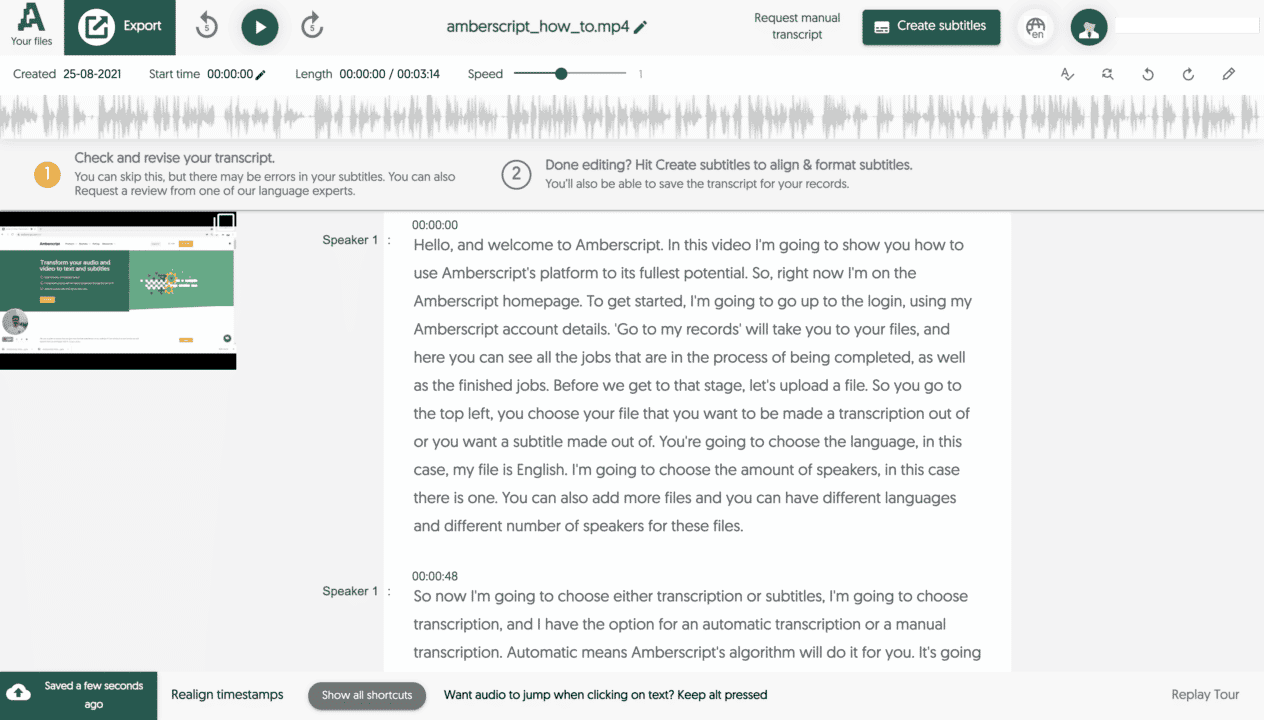
Now just determine whether you would like an automated or manual transcript. Here’s a closer look at each option in more detail.
Automated: Our highly advanced voice recognition AI makes automated transcripts speedy and 90% accurate. In about 5 minutes, your transcript will be prepared, and you can use our online Transcript Editor to make any necessary changes.
Manual: Our human-powered transcripts, produced by skilled experts, are more accurate but take longer to complete—typically 12 hours from request to delivery. Although they cost more, this can be your best option if accuracy is your top priority.
Mission complete! You’ll be able to download your expertly transcribed text in no time. It’s just that simple!
Amberscript: Top-Notch Microsoft Teams Transcriptions
If you’re looking for the highest-quality Microsoft Teams transcripts, Amberscript is here for you. We know that when a transcription service is done well, it can be a game-changer for your business—enabling you to gain insights into your meetings and make more informed decisions.
That’s why, at Amberscript, we are committed to providing our clients with fast, reliable, and easy-to-read transcripts from top to bottom. Now you can spend your energy where it matters most: your company!
And the best part? Amberscript is free to try! Sign up today if you’re ready to make the most of your MS Teams meetings.
How to Get French Subtitles For TV Shows and Movies
Placing French subtitles in your favorite TV shows and movies is essential if you’re learning French.
In addition, what if you’re watching English movies and French is your native language? Either way, you’ll want subtitles in French.
Thankfully, with the introduction of technology, it’s possible to add French subtitles to any video. In this article, we’ll show you how!
What are Subtitles and Captions?
Many people use the words subtitles and captions together. However, this shouldn’t be the case. Both phrases have different meanings and purposes.
You use subtitles when you can hear the language but don’t fully understand it.
You can use captions when you cannot hear the audio in a video. For example, deaf people and people who struggle to hear audio may use captions.
Let’s look at both words in a deeper context:
Captions
If you’re young, you’re probably used to seeing or using captions. However, media companies have only used captions to help deaf and hard-of-hearing people since the 1970s.
By the 1980s, captions became mandatory in the United States on all broadcast TV. However, you couldn’t initially turn the captions off.
By the 1990s, broadcast TV companies started using closed captions, whereby users could turn the captions on or off.
In 2022, most media companies can provide captions in their videos. These companies include Netflix, Amazon, cable networks, movie theaters, YouTube, etc.
Subtitles
Subtitles have been around much longer than captions. Media companies first started using subtitles in the 1930s.
During the 1930s, silent film moved into spoken audio to help foreign audiences understand the content.
However, subtitles aren’t appropriate for deaf or people who struggle to hear in most cases because they don’t include the aforementioned non-speech sounds required for anyone with hearing difficulties.
Today, subtitles are readily available on many videos, including YouTube videos and some streaming platforms.
However, subtitles aren’t available on all videos, which is why you need a captioning service.
How French Subtitles Can Help You Learn French
French is a beautiful yet sometimes challenging language to learn. Therefore, you’ll want to speed the learning process up and make it more comfortable.
Using French subtitles on English videos or French movies is one of the best ways to learn French.
Here’s how French subtitles can help you learn French:
1. Expands Your Vocabulary
You may hear slang, idioms, and constructions when listening to people speak French. Often the difference between a fluent speaker and a non-fluent speaker is understanding these phrases in general conversation.
When using subtitles in French, you’ll hear more slang, idioms, and constructions. As a result, you’ll learn and understand these phrases quicker.
In addition, if you watch French movies with subtitles, you can learn more conversational expressions and understand them in context.
2. Increases Your Reading Speed and Listening Comprehension
Is there anything worse than locals talking fast when learning a new language? It makes learning French far more challenging.
If you watch French movies with subtitles, you’ll hear locals often speak the language quickly, but you’ll also have subtitles on the screen.
Therefore, it can boost your reading speed and listening comprehension over time.
3. Helps Pronunciation
When learning a new language, it’s essential to grasp the pronunciation of specific words.
Watching French movies with subtitles allows you to see people speak the language while reading the words through the subtitles. As a result, you’ll improve your understanding and pronunciation of words.
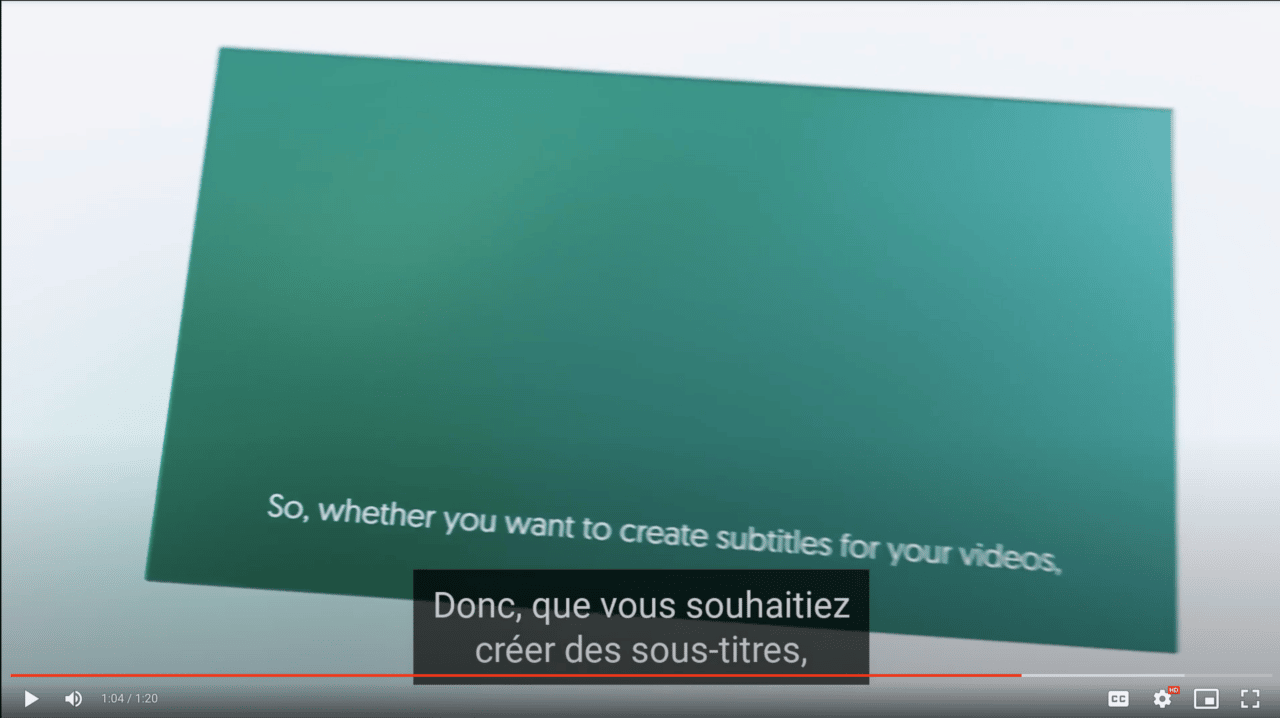
Tips for Finding French Videos with Subtitles
Suppose you’re trying to learn French like millions of people worldwide? The best way is to watch French videos with subtitles.
Still, where do you find such content? With modern technology, there are many ways you can watch videos with French subtitles.
Here are some of the best ways:
YouTube Videos
YouTube has various superb videos and channels for anyone looking to learn French. One of the most popular channels is Cyprien. His videos are often comedy sketches. He has over 10 million subscribers and over 1.5 billion views. Cyprien – School is an excellent French video with subtitles.
His videos typically use conversational French language, including slang and everyday nouns. Most importantly, many of his videos offer captions in French to help you learn.
Natoo is one of France’s top comedic YouTubers and an excellent singer. Natoo uses various common French slang words that are essential for grasping the modern French language.
Many of this channel’s videos provide subtitles in English and French. Therefore, you can learn to read French words specific to the bathroom and hygiene.
Kevin Tran 陈科伟 is one of France’s top YouTube comedy channels built by two brothers of Asian descent. It’s one of the best YouTube channels for learning French slang and grasping Parisian culture. However, their channel is more suited to advanced learners.
Unlike the other channels mentioned, the subtitles are only available in French. Still, it’s an excellent way to learn conversational French.
Nota Bene is a terrific channel with French subtitles. Suppose you want to learn about French history and the French language at the same time? Then this is the perfect channel for you.
Unfortunately, not all YouTube videos have subtitles to help you learn French. However, you can filter out videos that don’t have subtitles during your search.
For example, find the small ‘filters’ box near the top left of the search results’ Click features, and then select ‘subtitles.’
In addition, you can switch on the subtitles by clicking the “CC” box if you’ve already started watching a video. Some videos may have additional subtitles that are not in French or English.
Streaming Services
Do you use streaming services to watch your favorite movies and TV shows? Millions of people do. The phrase ‘Netflix and Chill’ has become commonplace in Western culture.
Did you know it’s possible to watch French movies with subtitles through a VPN? It allows you to use subtitles on Netflix for French TV shows and movies.
However, Amazon Prime is another superb option. They offer a similar streaming service to Netflix and allow you to use French subtitles.
Using a VPN is illegal in some countries; it also goes against the terms of use of many streaming companies. Therefore, take note of this before using a VPN service.
TV5Monde
One of the best ways to learn French is through the TV channel TV5Monde. You can watch completely free movies or TV shows with French subtitled content from levels A1 to B2 on the CERF.
Initially, the TV5Monde website was text and video only. However, all video series now come with interactive quizzes and notes on culture to boost your language skills.
There are even hilarious and free subtitled music videos on the website. Therefore, you can use the French subtitles to enjoy French karaoke.
FluentU
If you’re looking for a vast resource of French movies and TV shows, FluentU is an excellent website. Their website also includes news segments, blogs, and music videos with subtitles to help you learn French.
In addition, if you want to remember specific French words, place them on the flashcard decks in the video player. You can then resume watching the video and come back later.
Steps for Creating Your Own French Subtitles
It’s challenging to find French subtitles on many videos despite growing options for French subtitles. However, you can now create your French subtitles without relying on YouTube or streaming services.
At Amberscript, we can automatically convert any audio and video to text. Our service is available in 39 languages—including French. Therefore, you’ll never have to worry about finding French subtitles again. You can also put English subtitles on French videos.
Here’s how you do it:
Upload Video Into Amberscript
Upload any video into Amberscript. If you find videos on YouTube that don’t provide subtitles, download them and upload them to Amberscript. Our speech engine recognition builds the first draft from your audio.
Let Our AI Create Your Subtitles
Is there anything worse than waiting ages for your subtitles? When you use Amberscript, we use our super-fast AI service for a fast turnaround. In addition, you can edit the text in our online editor—which allows you to revise, highlight, and scroll through the text with ease.
Export Into Multiple File Formats
Once our AI has created your subtitles, we can export your transcript into Word, JSON, Text, and various other formats. We can even add speaker distinction and optional timestamps.

How to Get German Subtitles For TV Shows and Movies
Including German subtitles on your favorite movies and TV shows is vital if you’re a German speaker or want to learn German.
After all, it’s more straightforward to understand a language if you can see and read the words as the characters talk.
Thankfully, there are ways you can place German subtitles on your favorite movies and TV shows. In this article, we’ll show you how to use subtitles on German videos.
What are Subtitles and Captions?
You may have heard of the terms subtitles and captions. Many people use them interchangeably; however, both terms have different meanings and purposes.
You can use captions when you cannot hear the audio in a video.
You can use subtitles when you can hear but don’t understand the audio in a video.
Let’s take a deeper look at the two words:
Subtitles
Media companies first introduced subtitles in the 1930s. During this period, silent film transitioned into spoken audio to accommodate foreign audiences that didn’t understand the local language.
Today, the primary goal of subtitles is still to translate spoken audio into words that a foreign audience will understand.
In most cases, subtitles are not appropriate for deaf or hard-of-hearing viewers.
That’s because subtitles don’t include the aforementioned non-speech sounds that provide a viewing experience for those who can’t hear audio.
Captions
Until the 1970s, deaf and hard-of-hearing people struggled to understand TV shows and movies. However, media companies introduced captions in the 1970s to accommodate them.
By the 1980s, captions became mandatory in the United States for broadcast TV. Initially, you could not turn off captions; they were always part of the video.
However, media companies developed closed captions to allow users to control whether captions were on or off.
Today, most media companies offer captions to their viewers—including movie theaters, cable networks, YouTube, streaming services, Vimeo, and Brightcove.

How German Subtitles Can Help You While You Learn German?
So you’re learning or want to learn German? It’s a fantastic language that can be challenging to learn.
Still, you can speed up the learning process by using subtitles in German. Here’s how:
1. Builds Your Vocabulary
The main advantage of using German subtitles on your favorite movies and TV shows is building your German vocabulary.
Whenever you hear slang words and constructions, you’ll see them translated into German on-screen. Therefore, you’ll understand the phrases quicker.
If you watch German movies with subtitles, you’ll build efficiency with various colloquialisms and conversational expressions. However, you’ll also encounter them in context.
If you don’t understand the expressions, you can replay the video as much as you want.
2. Advances Your Reading Speed and Listening Comprehension
The most challenging part about learning another dialect is listening to native speakers talk fast.
When a local speaker talks, the sound units connect rapidly. As a result, it can be difficult for the untrained ear to understand.
Thankfully, German movies with subtitles play at the same speed as a general German conversation.
Although this may feel quick for you, it will increase your reading speed and listening cognizance over time.
3. Improves Your Pronunciation
A visual connection to a new dialect is vital when learning a new language.
When you watch German movies with subtitles, you’ll witness the characters speak the words as you read them on-screen.
Therefore, you’ll improve how you pronounce words and understand the terms in a greater context.
Tips for Finding German Videos with Subtitles
If you’re looking to learn German, there’s no better way than watching German videos with subtitles.
However, where do you find them? Since the introduction of modern technology, there are many options:
1. YouTube Videos
YouTube has many excellent videos geared toward learning German. Some videos even offer closed captions and subtitles, which you can switch on and off.
BookBox is a popular YouTube channel featuring speakers reading German children’s stories. The speakers read the stories slowly to help kids learn the language.
BookBox is also superb because its videos are under seven minutes long. As a result, you can effortlessly fit them into your daily schedule.
EasyGerman is an excellent YouTube channel if you’re an intermediate to advanced learner. Their videos tackle cultural topics, specific grammar, and everyday street talk.
Learn German with Herr Antrim is another terrific YouTube channel for learning German. Many of his videos include subtitles in German to help you understand the language. He has aimed much of his content at beginners, so it’s excellent if you’re just starting.
Germany’s public broadcaster—Deutsche Welle—has an excellent YouTube channel for learning German with subtitles. Their topics are shopping, grammar, and daily life in Germany.
WALULIS STORY – SWR3 is another superb YouTube channel with subtitles. It covers everything from politics to popular culture.
However, not all YouTube videos have subtitles. When you search for videos on YouTube, use the filter to show only videos with subtitles; this can save you time and effort.
For example, find the small box near the top left of the search results saying ‘filters.’ Click features and then select ‘subtitles.’
You can switch on the subtitles by clicking the “CC” box at the bottom of the video window. Some videos may have additional subtitles that are not in German or English, which is excellent for learning other languages.
2. Streaming Sites
Streaming sites can be an excellent resource for finding German movies with subtitles.
Using a virtual private network—commonly called a VPN—can be excellent for using streaming services. They offer a selection of German TV shows and movies. You can often use German movie subtitles on Netflix for German films and TV shows.
Another option is Amazon Prime. They offer a similar steaming service to Netflix. They even allow you to access German movie subtitles, which can help you learn German.
However, using a VPN is illegal in some countries, and it’s also against Netflix’s terms of use. So keep that in mind before you use a VPN.
3. FluentU
FluentU is an excellent resource for watching native German movies and TV shows. Their website has various videos in German—such as music videos, news segments, and blogs.
Many of the videos offer interactive subtitles to help you learn the language.
If you want to remember specific German words, you can place them on your flashcard decks in the video player, resume watching the video and come back later to revise.
4. Public Broadcasting Channels
Another superb option is WDR Mediathek (WDR Media Center). It’s one of the top public TV networks in Germany, and they produce a vast range of content.
However, WDR creates its content for the German market instead of German learners. That doesn’t mean you can’t use it to your advantage. The website can still provide subtitles to help you learn German.
ARD Mediathek (ARD Media Center) is also an excellent option. Unlike WDR, they focus their content on intermediate to advanced learners with made-for-TV movies. Ensure you watch videos marked in the search results with UT.
ZDF Mediathek (ZDF Media Center) is another outstanding choice for learning German. However, you may need a VPN to access their content because it’s limited to specific areas.
The videos on ZDF are mostly TV shows, news shows, and documentaries for the German market. However, you can learn German subtitles on many of their videos.

Steps for Creating Your Own German Subtitles
It can be tricky to find German subtitles on many videos despite increasing options for German subtitles on the internet.
However, you can now make your own subtitles in German without relying on streaming services, public broadcasters, or popular YouTube channels.
We can automatically convert any audio and video to text at Amberscript. Our service is available in German and 38 other languages. As a result, you won’t have to worry about finding German subtitles ever again!
Here’s how you do it:
1. Upload Video Into Amberscript
Upload any video from your computer or mobile device into Amberscript. Our speech engine recognition builds the first draft from your audio.
2. Let Our AI Create Your Subtitles
At Amberscript, our super-fast AI service ensures a rapid turnaround. In addition, you can edit the text in our online editor—which allows you to scroll through the text, revise, and edit.
3. Export Into Multiple File Formats
Once our AI has created your subtitles, we can export your transcript into Word, JSON, Text, and various other formats. We can even add speaker distinction and optional timestamps.

How to transcribe a Google Hangouts meeting like a pro
Looking for a way to transcribe a Google Hangouts meeting but don’t know how or where to start? You’re not alone!
When running a company, time is money: you need to get the most out of every minute. If you’re spending your time doing the work that somebody else could do for you, that’s a huge waste of resources. That’s why we’ve created Amberscript: a platform that allows you to get transcripts from your meetings and calls quickly and easily.
Amberscript helps millions of people and organizations to effortlessly obtain transcripts. Whether it’s by using our cutting-edge AI or by working with an experienced human transcriber, we’ll get the job done quickly and accurately.
Want to learn how to improve the quality of your company’s transcriptions? Keep reading!
What is Google Hangouts?
Whether you’re looking for a cost-effective collaboration platform for your business or just want to connect with family and friends, Google Hangouts is a great choice.
Set up is simple, and it comes with free call minutes, so you can use it to conduct unrestricted calls worldwide. In addition to real-time text, phone, and video chats, Hangouts also allows participants to share screens, whiteboard tools, Google Docs, and more.
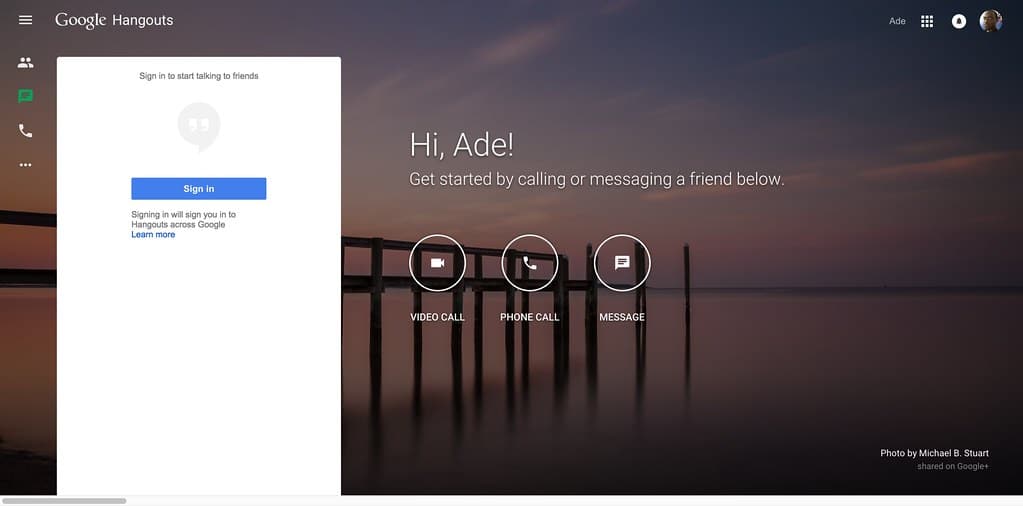
What is a Transcript?
Transcripts are a fantastic way to ensure that everyone on your team is on the same page—figuratively and literally!
With Hangouts, getting all of your employees together for a Google video conference call is easy. But what if there’s someone who missed the meeting? Or what if you want a way to review everything that was said to gain a better understanding?
That’s where transcription comes in. With transcripts, you won’t have to worry about miscommunication—you’ll be able to look back at what was said in your recordings and see exactly who said what, and when.
Transcribing involves the process of translating an audio or video recording into writing. Simply put, it’s a clear record of what was said during a meeting or conversation.
You can use your hangouts transcript for all sorts of things: training sessions, product demos, board meetings, sales calls, employee reviews—the possibilities are endless!
The Benefits of Transcribing Google Hangouts
There are tons of obvious benefits to using business transcription software: no more hastily taking notes throughout meetings, increased call attentiveness, and employee accountability are just a few advantages of Knowing there will be detailed records to review in the future.
Imagine the number of meetings you could reduce when you’re able to squeeze more out of the ones you currently hold. But the positive perks don’t stop there! Having your Hangouts transcribed can offer many additional advantages.
Here are eight more occasions where professional transcription makes a difference:
1. Reviewing Meetings
Playing back recordings to extract specific information can take a substantial amount of time, not to mention create undue annoyance, given that Google Hangouts chats often last more than an hour.
But if you have a written record of your session, it’s easy to find the exact part of the conversation you need to go back to. In addition to searching for keywords or phrases, you can also utilize the speaker identification tool to sort by who is speaking.
While saving you crucial business time, this approach also guarantees that nothing is overlooked, especially when it comes to things that require immediate attention.
2. Boosting Website SEO
Content is king. It’s a phrase you’ve probably heard before, and it’s easy to understand why. The more data-rich content you can provide on your website, the better it will perform in search engines and the more traffic you’ll get.
But what if there was another way to boost your content marketing and search engine optimization game?
If you’re uploading conference transcriptions on your website, you’re already doing something right! Not only does this practice keep readers on your web pages for longer (which improves your SEO score), but it also provides you with the opportunity to include more keywords in your website’s text.
3. Promoting Corporate Transparency
As a business, you want to be transparent. You want your customers, shareholders, board members, and other stakeholders to know that you are open and honest with them.
One way to foster a sense of corporate transparency is by making your transcriptions available to the public. When meeting notes and highlights are pulled straight from the transcript, they are easy to share instantly if needed.
This not only enhances your reputation but also gives your audience a sense of worth and involvement. With this much transparency, you can avoid misunderstandings or quickly clear them up if they happen.
4. Employee Assessments
Employees do better when they know what’s expected of them, and reviewing transcripts is a great way to get that information across.
For example, if you’re looking for someone who can solve problems quickly and thoroughly, transcripts can show you who those people are. If you need someone who’s able to understand clients’ needs and give them the information they require, transcripts will help you find that person too.
A transcript gives you a personal look at your employees and shows you things that numbers and statistics alone can’t. As a result, call transcripts are a great way to find leaders in your company who might be overlooked otherwise.
5. Industry Compliance & Legal Safeguards
If you’re in the legal or financial industries, it’s likely that your business is required to record and transcribe all Google Hangouts sessions. This is because of the sensitive nature of what’s being discussed and the need to preserve accurate records.
Even if you’re not lawfully bound to do so, transcribing your online chats so you can have them on hand to read later is a solid way to safeguard yourself against any conceivable legal situation.
6. Encouraging Accessibility
In today’s market, your business’s promotional materials, website, video meetings, and other parts should be as accessible as possible. Transcripts are one of the best tools for ensuring your company is genuinely accessible to everyone.
By having your company’s meetings and conversations typed up, you make sure that people who are deaf or can’t make it to meetings because of a disability can still take part.
This means they get the same information as everyone else and can make decisions based on what they’ve learned. It also enables them to sufficiently understand the context of discussions and guarantees they’re not left out of any decisions.
7. More In-depth Consumer Research
You can also discover a lot about your customers from the transcripts of their Google Hangouts. As part of your market and consumer research, you should read the transcripts of client conferences and internal team meetings. This will give you a clear notion of what your customers need, what they want, and what they expect.
These transcripts are also a great way to learn more about the types of clients you have, how to improve your sales pitches, and how to train your employees to better serve them.
8. Better Record-Keeping
As a final benefit, when it comes to corporate archives and recordkeeping, meeting transcripts are an excellent resource. Compliance officials, advisors, and upper executives will always be able to reference these transcripts, which prove especially useful during board meetings.
In addition, publishing transcripts to the cloud or your personal server will require far less storage space since their file sizes are often significantly smaller than video files.
How to transcribe your Google Hangouts meeting with Amberscript
With Amberscript, it’s easy to transcribe a Google Hangouts meeting. Here are the four steps you’ll need to take to get started:
- Record Your Google Hangouts meeting
- Upload Google Hangouts recording to Amberscript
- Select a language
- Choose human or AI-powered transcription
And presto! We’ll take care of the rest
To begin, start a Google Hangouts meeting and record it. Next, upload your recorded file to Amberscript and choose your meeting’s language.
Next, decide if you want an automated or manual transcript (experienced transcribers are more meticulous, but AI is quicker and more affordable).
That’s it! Your professional transcription will be ready for you to download in no time. It really is that easy!

Amberscript: Expert Google Hangouts Transcriptions
At Amberscript, we’re committed to ensuring that every one of our customers gets the 100% accurate transcripts they deserve, from start to finish. We’ll work closely with your files to ensure that everything goes smoothly so that you can focus your energy on what’s most important: getting results.
Connect with our friendly team today to discover more about making the most of your Google Hangouts sessions.
Ultimate Guide to Adding Subtitles in Davinci Resolve
If you’d like to edit programs and videos, Davinci Resolve is the perfect software to use. It’s equipped with the latest tech tools that help video editors easily integrate graphics, render images, customize colors, optimize sound features, and add audio subtitles to videos. As a result, it’s a perfect solution for professional video editors. In this step-by-step guide, we will tell you how to add subtitles to Davinci Resolve.
Table of Contents
- What are subtitles
- Adding Subtitles with Davinci Resolve
- Manual Creation of Subtitles
- Add SRT Subtitles to Davinci Resolve
- How to add your subtitles to Davinci Resolve
- How to Burn Closed Captions in DaVinci Resolve
- A Couple of Tips to Consider
- Conclusion
What are subtitles?
The definition of subtitles
Subtitles are text that is usually positioned at the bottom of your video and are created from the dialogue of videos or movies. Thanks to the subtitles, members of the Deaf and Hard of Hearing community or users who don’t want to turn up the volume can understand what’s happening and what’s being said in the video.
The benefits of subtitles
- Your video content will be discovered by more people on social media
- Reach a potentially wider audience
- Improve SEO
- Attract more foreign viewers to your content
Adding Subtitles with Davinci Resolve
Subtitles are one of the primary requirements from video makers these days. Whether a short video or a full-length program, content creators like to target a wider audience by providing video subtitles for non-native language speakers.
So, you can communicate with those who are deaf or hard of hearing, or the ones unable to understand the language used in the video. As a result, tools like Davinci Resolve let you target a global audience, enhancing your brand outreach.
Working with Davinci Resolve makes adding subtitles to your videos more straightforward and quicker. Therefore, this tool adds to your efficiency as a video editor. Whether creating video subtitles or exporting them for other videos, it’s all possible through Davinci Resolve.
How to Add Subtitles
Davinci Resolve offers several ways to add subtitles to your videos. There are both manual and automatic methods to do it. So, let’s find out more.
Manual Creation of Subtitles
Let’s say that you have completed your video editing and you are only left with the subtitles. In this case, you can add the subtitles manually by following these steps:
1. Select Subtitle Track
Go to your video track timeline in the Davinci Resolve software and click the ‘Add Subtitle Track’ option. Doing this will add the track containing your video subtitles.
2. Add Subtitle Track
Now, move your cursor to the point where a dialog starts. Next, right-click on the subtitle track. Then, select the ‘Add Subtitle’ option.
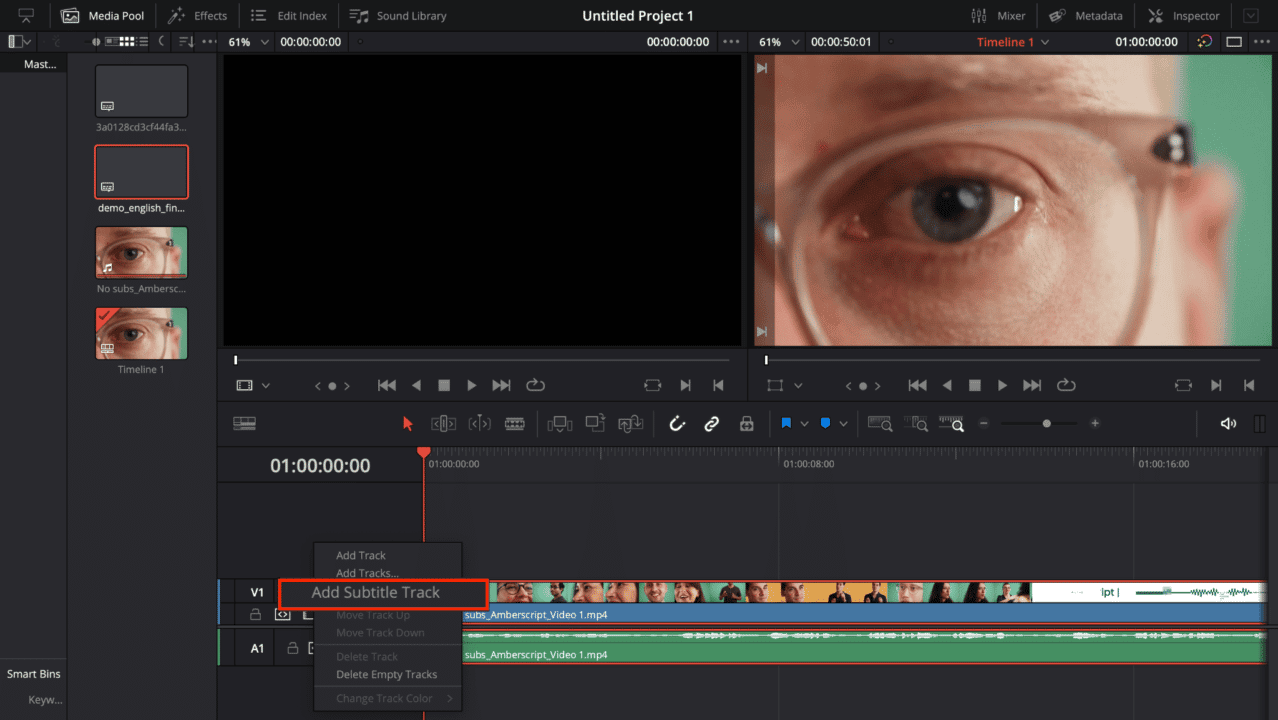
3. Type In the Caption
Once you have selected the subtitle, you can now type your caption in the new panel. Next, fill in the caption in the Inspector.
4. Adjust Subtitle Length
Match the section of the audio to your subtitle and adjust its length.
5. Listen to the Audio
Listen to the audio section and type it into the caption space. This will add the subtitle and start appearing in the video.
6. Styling Subtitle Font
In the inspector window, you can also see the Style tab. Use this tab to modify how your caption appears in the video. You can customize the font, size, color, background, etc. Moreover, you can keep the same style for all your subtitles by clicking the ‘Use Track Style’ checkbox. Make sure to use an easily readable font to make it easier to read at a faster pace.
7. Add Next Subtitle
Now, move the cursor to the point where the following audio line begins. Then, in the inspector window, click ‘Add New .’ Alternatively, you can right-click on the subtitle track and add another title. Now, repeat the process to add subtitles throughout the video.
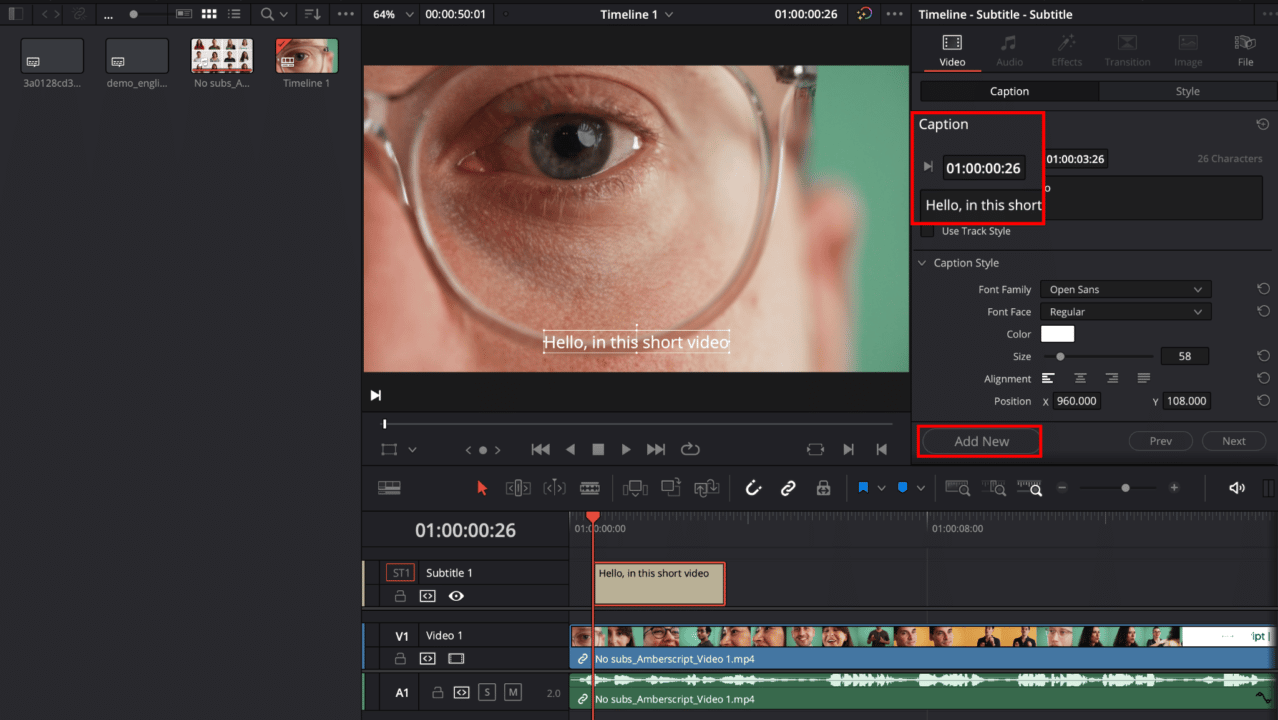
Add SRT Subtitles to Davinci Resolve
While manual addition of subtitles is a simplified process, it is quite laborious. Therefore, there must be a much faster option to shift the subtitles to the video quickly. There are a couple of ways to do it if you want to import the subtitles to your video.
Getting SRT Subtitles with Amberscript
Platforms like Amberscript, are an easy way to get subtitles for your videos. All you need to do is upload your video content and then choose to get machine-made subtitles, have our team of professional subtitlers take the lead or reach a wider audience by using our human-made or translated subtitling services.
After you have uploaded the video, Amberscript starts to transcribe your video. With the help of their machine-made subtitle generator, this process doesn’t take long, and within minutes you would get your text draft. Then you will be able to download the first draft which has gone through its online text generator.
You can edit the first draft of your subtitle on their online text editor to suit anything you want. The editing includes correcting grammar structures, such as punctuations and align them to your video perfectly. As a plus, you even get the chance to annotate and highlight parts of the text (subtitle edit).
Afterwards, if you are happy with the edited subtitles, you can download them in Text, SRT, VTT or EBU-STL and many other formats, with optional timestamps and speaker distinction. You even have the chance to download your video together with your subtitles.
Alternatively, if you have more complex, or a large amount of video content, you can have our team of professional subtitlers manually edit the text. The added value is that it’s 99.9% accurate and you can convert speech to text in over 15 languages. As our team of freelancers are from different part sof the world, we make sure to transcribe jargon or accents accurately.
For more details on our subtitling services, start your free trial now.
Once you have the .srt file, it will be imported to your video. Here’s how to add your capions to Davinci Resolve.
Add your subtitles to Davinci Resolve
1. Import and Select
Go to the ‘File’ menu in your Davinci Resolve software and click on ‘Import.” Next, click “Subtitle.’ Then, navigate to your .srt file and select it to import. Once imported, the .srt file should appear in the media pool on your Davinci Resolve software.
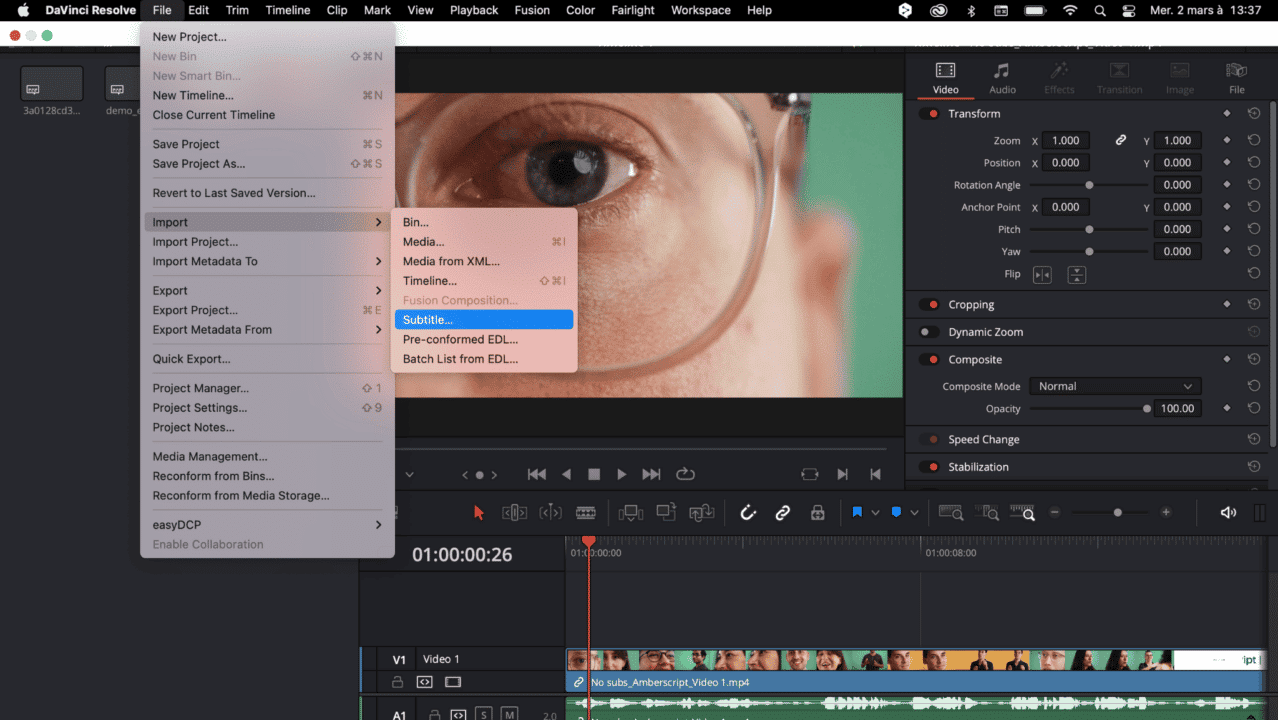
2. Drag and Drop
Once the .srt file is in the media pool, you can drag and drop the files to your current timeline. Just place the file where your dialogues start and make minor syncing adjustments.
3. Stylize Subtitles
The subtitles do not retain the styles, so you must restyle them. However, it can be done in the same way as mentioned earlier.
4. Modifying Subtitles
Generally, the subtitles are correct, but YouTube automatic transcriptions may have a few mistakes. Make sure to correct the errors and finalize your subtitles. You can do it in the Captions section in the Inspector.
Export Subtitles
Once you have your subtitles in place, you can export the entire video along with the subtitles. First, go to the delivery page in the Davinci Resolve software. You can find this option in the ‘Subtitle Settings’ option. There are three ways to export your subtitles.
- Exporting as a Separate File
When you export the subtitles file as a separate file, it is more convenient for the users to turn the subtitles on or off. Especially when they are watching it on YouTube, the users can view or block the subtitles. If you want to use this option, you must upload the subtitles file separately on YouTube.
- Burn Subtitles into the Video
This option permanently places the subtitles into your video, and you cannot remove them. Moreover, the viewers don’t have the opportunity to turn them off either. This option suits specific platforms like Facebook or Instagram, where the videos autoplay on mute.
However, if you are putting the video on YouTube, it’s always a great option to let the users decide whether they want the subtitles or not.
- Video Embedding
The embed option is mainly for broadcast use. Moreover, it only works if there is a supported file format. To export the subtitles, follow these steps:
Step 1- Selecting the Export Format: Go to the delivery page and choose your export format. Also, configure all the settings you want before starting the export process. Check the bottom left of the window, and you should see the Subtitle Settings option. The dropdown menu should have the Export Subtitles option. Click it and proceed to selection.
Step 2– Pick Your Export Method: Now, select your export method. For instance, if you want to export as a separate file, choose your file and then check the ‘include the following subtitle tracks in the export’ option. Next, start rendering the video, and it will export your subtitles according to your preference
Benefits of using Amberscript
Amberscript’s subtitle services are:
Edit your own text within minutes or leave the work to our experienced subtitlers.
Our experienced subtitlers and thorough quality controls ensure 100% accuracy of your transcriptions and subtitles.
Thanks to a variety of integrations and API interfaces, you can fully automate your workflows.
Your data is in safe hands. We are GDPR compliant + ISO27001 & ISO9001 certified.
How to Burn Closed Captions in DaVinci Resolve
DaVinci Resolve is a professional video editing software that offers robust features for creating closed captions for accessibility purposes. To create closed captions in DaVinci Resolve, follow these steps:
- Import your video: Start by importing the video you want to add closed captions to into DaVinci Resolve.
- Create a new subtitle track: In the timeline, right-click and select “New Track > Subtitle” to create a new subtitle track.
- Add subtitles: On the new subtitle track, click on the “Add Subtitle” button and enter the subtitle text for each line. You can also adjust the timing of each subtitle by dragging the subtitle marker on the timeline.
- Customize subtitle appearance: DaVinci Resolve allows you to customize the appearance of your subtitles, such as font style, size, and color. You can do this by selecting the subtitle track and opening the “Inspector” panel.
- Export your video with closed captions: When you’re done creating your closed captions, you can export your video with closed captions by selecting the “Deliver” tab, choosing your desired export format, and selecting the “Burn In” option for subtitles.
By following these steps, you can create closed captions in DaVinci Resolve for accessibility purposes, ensuring that your video content is accessible to all viewers. If you want to learn more about what closed captions are, and how closed captions are different from subtitles, you can read our extensive blogpost about it.
A Couple of Tips to Consider
While you’re adding subtitles to your video with Davinci Resolve, here are a couple of considerations to make your work smoother.
- Make sure that you add the subtitles at the very end of your video rendering. If you do it earlier, new video edits would mean shuffling the subtitles. Hence, you’re doing the same thing from the start.
- Use the industry standards for the number of characters per line. The standard duration of the title depends on the number of characters in it. Generally, it’s around 12 to 17 seconds.
Conclusion
Working with Davinci Resolve to add subtitles to your videos is a seamless process, and it can give you high-quality results within no time. Besides subtitling, Davinci Resolve is a comprehensive software offering tools for color enhancement, rendering, and audio processing. Therefore, it can be a standalone software for all your professional video editing needs.
As you deploy Davinci Resolve for subtitling, it gives you a better chance to export quality content to your social media platforms. Moreover, your video content gets an international appeal, allowing you to showcase your art to a global audience.
Frequently asked questions
-
Can I burn the subtitles directly onto my video?
If you have exported the transcript as a SRT, EBU-STL or VTT file, you can easily burn them onto your video using video-editing software.
-
Can I change the position of the subtitles?
That needs to be done using a video editor like VLC. Go to Tools > Preferences [CTRL + P]. Under Show settings, select the option that says All to switch to the advanced preferences. Navigate to Input/Codecs > Subtitle codecs > Subtitles. Under Text subtitle decoder set, the Subtitle justification to left, right or center.
-
How do I order translated subtitles?
To order translated subtitles, you can upload your file like you would normally do. You can then select manual subtitling. Once you have selected this, an option will appear where you will be able to select the language the subtitles need to be translated to. If the language that you want is not one of the options you can contact us through our contact form.
-
What subtitle file formats are supported?
Our software allows you to export the transcript from the video or audio file as an SRT, EBU-STL or VTT file.
-
How do I generate captions?
You can generate captions automatically using Amberscript. Our software allows you to export transcription based on audio/video files as SRT, EBU-STL or VTT files, which can easily be inserted into a video-editor. Want to know more? Here is a step-by-step guide.
-
How do you keep my files secure and confidential?
Amberscript’s IT infrastructure is built on the server infrastructure of Amazon Web Services located in Frankfurt, Germany. All data that is processed by Amberscript will be stored and processed on highly secured servers with regular back-ups on the same infrastructure.
-
In which formats can I export my subtitles?
Our software allows you to export the transcript from the video or audio file as an SRT, EBU-STL or VTT file.
-
What is the price?
For our prices, please refer to our pricing page.
-
What is the turnaround time?
Our state-of-the-art speech AI delivers results in less than an hour (depending on the size of the file, it can take only takes a few minutes). Just upload your audio into our system and we will notify you as soon as the file is ready! if you would like to learn about turnaround times for our manual subtitling services, click here.
Closed Captioning Services – what are the benefits?
What are closed captioning services?
Closed captioning services are providers that transform audio-to-text. Captions are shown at the bottom of the video, like subtitles, but are in the same language as the audio and also describe what audio is being played, for example: “there was a knock at the door”.
Amberscript’s closed captioning services include:
- Video closed captioning services
- Broadcast closed captioning services
- Television and film closed captioning services
- Marketing and advertising closed captioning services
- Higher education closed captioning
- Media production closed captioning
- Closed captioning for governments
Why Use Closed Captioning Services?
Some people will watch your videos in crowded places or quiet places like libraries. These people can’t raise the volume on the video, making it impossible for them to hear the audio. Closed captions services provide text at the bottom of the video. This text acts as word-for-word verbatim of the video, helping these viewers stay engaged.
Closed captions also help your content rank better on SEO. Algorithms also need help with understanding your video without audio. Algorithms will pull into closed captions when deciding how to rank videos. They will look for keywords and other information to determine what your video covers.
Amberscript provides closed captioning services for individuals and companies worldwide. Our competitive pricing structure and quality service provide reliable closed captions at an affordable price.
What are Subtitles and Closed Captions?
Subtitles and closed captions are similar, making them easy to mix up. We offer services for subtitles and closed captions. Both show up as text at the bottom of a video.
Subtitles translate the video’s language into the viewer’s native tongue. Many Japanese anime shows come with subtitles for people who don’t know Japanese. Subtitles provide the translation for character dialogue so viewers can still follow the story. Subtitles have various uses that extend beyond anime shows. What’s even better is that, subtitles help businesses communicate with more customers and shatter the language barrier.
Closed captions help people follow the video even if they can’t hear the audio. Viewers who are deaf or hard of hearing, read the closed captions to understand what is happening. Other people find themselves in environments where it’s best to keep the volume off. These viewers will read the closed captions while watching the video to fully grasp the content.
Amberscript’s Closed Captioning Process
Our closed captioning software generates closed captions for your videos. It saves you the time and pain of manually adding closed captions to your videos. Our intuitive editor helps you improve closed captions yourself.
After uploading your video into our software, we provide the closed captions. You can easily search through the text to find what you want to edit. Amberscript will save you plenty of time while making it easy to review your closed captions.
Our software will save you time on editing. You can save even more time with our closed caption writers. After you upload your file, our expert writers do their magic. They will edit the closed captions for you. We conduct a quality check to ensure everything is smooth before delivering the closed captioned video. We then provide you with a file with optional timestamps and speaker distinction.

Video Caption File Formats
Amberscript delivers your video captions in multiple file formats. Our range of formats ensures your captions get provided based on format requirements.
- .docx — Microsoft Word file format
- .json – JavaScript Object Notation
- .srt – SubRip Subtitle file
- .vtt – Web Video Text Tracks
- EBU-STL – European Broadcast Union subtitles
- .txt – Plain text file
Benefits of Professional Captions Over AI
Amberscript lets customers choose between AI-generated and professional captions. You can either edit the captions yourself or hand off the responsibilities to one of our expert writers. AI makes our lives easier and provides quick captions.
However, these captions are not perfect. They will come with errors, making it essential to review AI-generated captions. Some speakers talk too fast for a robot or use vocalizations the robot cannot understand.
Errors can confuse viewers and cause them to click off your videos. The closed captions need to read like human sentences. AI provides the rubric, but you should not consider it as the final product.
Our language experts can edit the captions for you, creating that professional touch. We only hire native speakers who can create the highest accuracy texts for captions. Professional captions come at a quick turnaround. Instead of scheduling time to review and edit AI-generated captions, a language expert focuses on your closed captions until the job is finished.
Industries that Benefit from Closed Captions
Amberscript works with many individuals and corporations. We happily serve clients like Amazon, Netflix, and Disney+, providing them with accurate closed captions. Various industries use closed captions to improve their messaging and reach more people. Here are some of the industries and people we help.
Marketers
Marketers create audio and video content to reach their customers. Not all of these customers can listen to the audio. Closed captions retain viewers by providing the text for the video at the bottom.
Converting video and audio content into text will enhance their SEO. Search engine optimization is a primary focus for many marketers and their clients. Closed captions help marketers, and their clients rank higher than the competition for their keywords.
Marketers can also use Amberscript to assist with their research. Market research involves many interviews and promotional videos. These long-form pieces of content can feel drawn out. Automatic transcriptions help marketers skip to the essential insights from these interviews and videos. Saving time on market research allows marketers to shift their attention to more productive activities.
Media and Broadcasting
Amberscript provides accurate closed captions in minutes. Your video content will become searchable across search engines, helping you attract new viewers. Our transcription services ensure you no longer waste time coordinating transcribers and video-loggers yourself. We do the closed captioning for you so you can focus on other tasks.
You’ll still save time with our AI. Sky-high TV lowered their transcribing from 10 hours per interview to 20 minutes using our tool. They’ve saved hundreds of hours of work using our software.
Our batch-upload functionality helps media and broadcasting personnel upload several videos simultaneously. This feature makes it easier to manage large volumes of video.
Media Producers
Filmmakers, YouTubers, and vloggers often get overwhelmed with deadlines. They have to stay on pace with their content and produce it at a reliable schedule. Adding closed captions to your videos helps your viewers understand the content. It also helps with search engine visibility.
However, some media producers forgo closed captions because they take too much time. They’re already stressed about meeting their deadlines. Amberscript makes it easy to keep up with closed captions. We help creators save time and boost productivity. Our software helps them keep up with deadlines while providing their viewers with accurate closed captions.
Governments
Amberscript helps governments achieve affordable and accurate closed captions with our human transcribers. We have speech recognition models trained explicitly for political terminology. Our AI-generated closed captions are fully GDPR compliant and support 12 European languages. We have the largest transcriber network in Northern and Central Europe.
Closed captions allow citizens with hearing disabilities to fully grasp your videos. Our automatic first-draft transcripts get generated within minutes. These automated transcripts come with 90% accuracy. Our human service guarantees 99% accuracy and adherence to accessibility guidelines.
Universities and Education
Closed captions help universities reach broader audiences. They can cater to students with hearing disabilities and make their content more accessible. Our software can distinguish between speakers, making it easier to dissect interviews.
Universities deploy many resources to educate students. Amberscript gives them more affordable access to closed captions and subtitles. Our quick service and robust software help universities allocate more time and resources to other objectives.
Most transcribers need four hours to transcribe a single hour of audio. We do the transcribing in a few minutes instead of a few hours. You can either polish the closed captions through our editor or use our manual closed captioning services to cross the finish line.
Closed captions help various corporations and individuals reach broader audiences. Amberscript makes it easy for these entities to obtain accurate closed captions at an affordable price.
How to Add Subtitles in Final Cut Pro X – the ultimate guide
Table of contents
- Subtitles and Captions: What’s the Difference?
- Creating an .SRT file
- Creating Subtitles in Final Cut Pro X
- The advantages of adding subtitles in Final Cut Pro
- Some more features that may be useful
- How to customize your subtitles
- How to make your subtitles accessible and inclusive
- How you can create your subtitles with Amberscript
Subtitles are an important tool to engage with your viewers and ensure your video content makes an impact. If you want to learn how you can add subtitles into your Final Cut Pro X editing software, then this guide is for you!
Keep reading to learn more about captions and subtitles, how to add them into videos, and the benefits of doing so. We’ll also review how you can automatically create .SRT files by using the power of AI with Amberscript.
Subtitles and Captions: What’s the Difference?
Before we get into the steps you need to take to add subtitles in Final Cut Pro X, it’s necessary to address an important question: what’s the difference between subtitles and captions? While you may think that they are the same thing at first glance, captions and subtitles serve distinct purposes.
The term subtitle refers to the text you see on your screen while watching a video. Their purpose is to translate all the spoken dialogue into written text so viewers can watch content in another language. Videos with subtitles assume that the person viewing them can hear audio cues but still need to translate the dialogue.
Although captions also translate the dialogue in the video, they also describe things like sound effects, audio cues, and music. This means that they can give additional context to the viewer even if they don’t have their sound on at all.
Creating an .SRT file
When you create video content in Final Cut Pro X, you must add subtitles to your final product. Follow this easy step by step process to get started:

1. Create an SRT File and Import It
The first step is to create a .SRT file. This unique file type includes a time-coded transcript for the video content so that you can import everything into Final Cut Pro X with minimal rearrangement or effort.
The good news is that you don’t need to create the .SRT file by hand – instead, use the automatic subtitle software provided by Amberscript! The platform includes a subtitle generator that helps you create the .SRT files from audio and video clips in minutes.
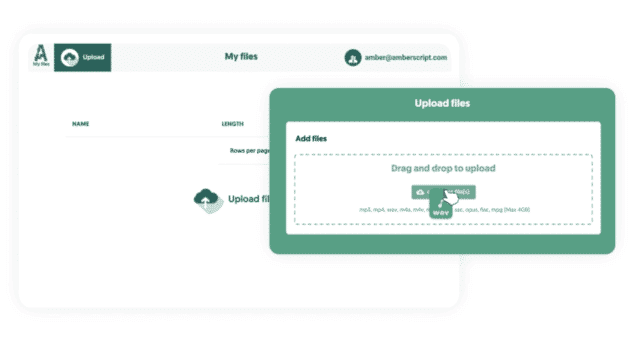
2. Generating automatic subtitles with Amberscript
Start by uploading the audio or video you want to add subtitles to and hit upload. Next, the artificial intelligence tool will start to create your transcript. Once it is complete, you can edit the file, add punctuation, and adjust grammar. When you are satisfied with the result, export it to your computer.
Additionally, you can export the subtitle in any format you want. Since you want your subtitle in the SRT file format, you pick that with optional timestamps or annotation. Learn more about different types of subtitle file formats
Creating Subtitles in Final Cut Pro X
1. After you have a completed .SRT File, it’s time to upload it into Final Cut Pro X
2. Once you uploaded the file, edit it based on your preferences
• Adjust the Subtitles as Needed
Although Final Cut Pro X will use the .SRT file as a starting point for the subtitles, you’ll likely need to make some adjustments. When you load the titles and text into your project, you must arrange the timing to ensure that everything lines as desired for your viewers.
To trim the subtitles, all you need to do is grab the block and crop it to the appropriate length. Drag and drop the titles to move them around – just do so with caution as they will overwrite existing captions when you place them on top.
• Format your Video File
So, you’ve got the subtitles uploaded and everything is in place – now what? At this point, you can choose to stylize the text or add some custom formatting to the video.
Remember that the goal of subtitles is to provide a simple solution for translating dialogue spoken in the video. However, there are times it makes sense to choose the font or the text color for the subtitles to help the viewer understand the additional context.
You can also emphasize specific parts of the subtitles by underlining them or using bold and italic formatting.
• Export your video
The last step to add subtitles in Final Cut Pro X is to export the video. There are two ways you can do this: a regular export or a caption role.
If you choose a regular export, you simply need to click File > Export and save the file accordingly. Note that the captions will not be included in the final product if you use this option.
To ensure that the video track includes the subtitles in the final export, you need to complete the following steps:
- Select Roles in the export window
- Click the Captions icon and select Burn in Captions
- Once you hit OK, it will close the window
- Choose File then Export as normal
Benefits of using Amberscript
Amberscript’s subtitle services are:
Edit your own text within minutes or leave the work to our experienced subtitlers.
Our experienced subtitlers and thorough quality controls ensure 100% accuracy of your transcriptions and subtitles.
Thanks to a variety of integrations and API interfaces, you can fully automate your workflows.
Your data is in safe hands. We are GDPR compliant + ISO27001 & ISO9001 certified.
The advantages of adding subtitles in Final Cut Pro X
Now that you’ve learned how to add subtitles in Final Cut Pro X, you may be wondering, how can they be used to boost engagement? Including subtitles in your video content can improve overall engagement by connecting with users that keep their sound off, making your content accessible, and enhancing your SEO efforts.
1. Connect with Viewers that Keep Their Sound Off
You may be surprised to learn that most people that watch videos on their mobile devices do so without turning the sound on. Whether they are in a public place and can’t turn up the audio or simply do not have access to headphones, these users need subtitles to understand the context of your videos.
2. Make your Content Accessible
Another way that subtitles increase engagement is that it makes your content accessible to everyone. Individuals who are deaf or hard of hearing won’t be able to enjoy your videos to the fullest without the help of subtitles.
In other words, if you want to comply with accessibility requirements and ensure that everyone can engage with your brand, you should add subtitles to your videos.
3. Enhance your SEO
SEO, or search engine optimization, refers to creating content that allows your website to rank higher on the search engine results pages. You want to be the first result when someone Googles a topic you have shared a video about, right?
Unfortunately, search engine algorithms are not able to index video content alone. However, they can if you have subtitles and an attached transcript! Use that as an opportunity to improve your SEO efforts and engage with a broader range of viewers.
Some more features that may be useful
How to sync your subtitles with the video
Syncing subtitles with video is an important step in creating professional-looking videos, and Final Cut Pro X offers several tools and techniques to make the process easier and more accurate. One of the most effective methods for syncing subtitles with video is by using timecode. Timecode is a way of measuring the duration of a video based on a specific time format, such as hours, minutes, seconds, and frames. In Final Cut Pro X, you can use the timecode of your video and subtitle tracks to align the two and ensure that your subtitles appear at the correct moment. This can be done manually by entering the timecode values for each subtitle, or you can use Final Cut Pro X’s built-in synchronization tools to automatically match the timecode of your subtitle track with that of your video. With a little practice and attention to detail, syncing subtitles with video using timecode in Final Cut Pro X can be a straightforward and effective way to add professional-looking subtitles to your videos.
How to export your video and subtitles
Once you’ve added subtitles to your video in Final Cut Pro X, it’s important to export your video in a format that is compatible with different devices and platforms. Here’s a step-by-step guide to exporting subtitled videos from Final Cut Pro X in various formats and resolutions:
Step 1: Select your video in the timeline and go to File > Export.
Step 2: Choose the desired format and resolution for your exported video. You can select from a wide range of formats, including MP4, MOV, and ProRes.
Step 3: Click on the “Add Captions” checkbox to include the subtitles in your exported video.
Step 4: Choose the desired subtitle format, such as SRT or WebVTT.
Step 5: Adjust the settings, such as video and audio quality, and frame rate.
Step 6: Click on “Next” to choose the location where you want to save your exported video.
Step 7: Click on “Export” to begin the export process.
By following these simple steps, you can easily export subtitled videos from Final Cut Pro X in a variety of formats and resolutions. This will ensure that your content is accessible and compatible with different devices and platforms, making it easier for viewers to enjoy your videos with subtitles.
How to import and work with different formats (SRT, SCC)
Importing and working with subtitle files in different formats is an essential part of the subtitling process. Final Cut Pro X supports a variety of subtitle file formats, including SRT, and SCC, which can be imported and edited within the software.
To import a subtitle file, navigate to the “File” menu, select “Import,” and then choose the subtitle file you wish to import. Once imported, the subtitles will appear as a separate subtitle track in the timeline.
To edit the subtitles, double-click on the subtitle track to open it in the viewer window. From there, you can adjust the timing, duration, and text of each subtitle as needed.
It’s important to note that different subtitle file formats may have different formatting requirements, such as font size, color, and position on the screen. It’s important to ensure that the imported subtitle file is formatted correctly to ensure legibility on different types of screens and devices.
In summary, importing and working with subtitle files in different formats is an essential part of the subtitling process. Final Cut Pro X supports a variety of subtitle file formats, and it’s important to ensure that the imported subtitle file is formatted correctly to ensure legibility on different types of screens and devices.
Adapting your video to a vertical format
Final Cut Pro X is a powerful video editing tool that can be used to add subtitles to vertical videos for social media platforms like TikTok and Instagram. Here’s a step-by-step guide on how to add subtitles using Final Cut Pro X:
- Open Final Cut Pro X and create a new project with a vertical aspect ratio.
- Import your vertical video and subtitle files into the project.
- Drag the subtitle file onto the timeline and adjust the timing so that the subtitles appear at the right moments.
- Use Final Cut Pro X’s text tools to adjust the font size, style, and color of your subtitles.
- Position the subtitles so that they are not blocking important visuals in the video.
- Preview the video and make any necessary adjustments.
- Export the video with subtitles in the appropriate format and resolution for the social media platform.
By following these steps, you can add subtitles to your vertical videos for social media platforms like TikTok and Instagram using Final Cut Pro X. Adding subtitles can enhance the accessibility and engagement of your content, as well as increase the reach of your content to viewers who are deaf or hard of hearing. If you wanna know more about the specific platforms you can read our guide on TikTok closed captions, TikTok subtitles or Instagram subtitles.
How to use the role feature
Final Cut Pro X’s role feature is a powerful tool for organizing and managing subtitle tracks for multilingual projects. Here’s a step-by-step guide on how to use the role feature to streamline your subtitle workflow:
- Create a new project in Final Cut Pro X and import all of your video and subtitle files.
- Assign different roles to each language’s subtitles, for example, “English” and “Spanish.”
- Select the video clip and use the “Assign Roles” option in the “Modify” menu to assign the appropriate language role to the clip.
- Once the roles are assigned, create a new subtitle track for each language by clicking on the “Add Subtitle” button in the timeline and selecting the appropriate role.
- Add subtitles to each track and adjust the timing as necessary.
- Preview the video and make any necessary adjustments.
- Export the video with subtitles in the appropriate format and resolution.
By using Final Cut Pro X’s role feature to organize your subtitle tracks, you can streamline your workflow and ensure that each language’s subtitles are properly assigned and easily manageable. This can be especially useful for multilingual projects, where keeping track of multiple subtitles tracks can become overwhelming without proper organization.
Adding captions while live streaming
Creating subtitles for live video streaming events is a critical aspect of ensuring that your audience can fully engage with your content. Fortunately, Final Cut Pro X provides robust tools for creating and managing subtitles in real-time.
To create subtitles for live streaming events using Final Cut Pro X, you’ll first need to set up your project with the appropriate settings, including video and audio inputs, resolution, and aspect ratio. Once you’ve done that, you can use Final Cut Pro X’s built-in subtitle editor to create and edit your subtitles on-the-fly.
To make the process even smoother, you can use a dedicated hardware device, such as a subtitle encoder, to capture and stream your subtitles in real-time. These devices allow you to input your subtitle text and timing information directly into Final Cut Pro X, which can then be sent to your streaming platform.
When creating subtitles for live streaming events, it’s also essential to consider the placement and design of your subtitles. Be sure to use a font and color that are easy to read on a range of devices, and avoid obscuring any important visual elements in your video.
With these tips and Final Cut Pro X’s powerful tools, you can create professional-quality subtitles for your live streaming events that enhance accessibility and engagement for all viewers.
How to create and use templates
Subtitle templates in Final Cut Pro X are a great way to save time and maintain consistency across multiple videos. Here’s how to create and use subtitle templates in Final Cut Pro X:
- Create a new project and add the subtitles you want to use in your template.
- Once you have the subtitles in place, select them and go to Edit > Copy.
- Next, open the Titles and Generators panel by clicking on the Titles button in the top right corner of the screen.
- Select the template you want to use as a base and drag it onto your timeline.
- Click on the template to select it, and then go to Edit > Paste. This will paste the subtitles onto the template.
- Adjust the position and size of the subtitles as needed to fit the template.
- Once you’re happy with the layout of the subtitles, go to Edit > Save as Template.
- Give your template a name and description, and select the category where you want to save it.
- Click Save to create your new subtitle template.
To use your new subtitle template in a future project, simply select it from the Titles and Generators panel and drag it onto your timeline. Then, copy and paste your subtitles onto the template and adjust the position and size as needed. This will help you save time and maintain consistency across all of your videos.
How to customize your subtitles
Adding and using custom fonts
Adding custom fonts to use for subtitles in Final Cut Pro X can enhance the look and feel of your videos and make them more engaging and visually appealing. Here’s a step-by-step tutorial on how to do it:
Step 1: Download the font file that you want to use. The file should be in a supported format such as .ttf or .otf.
Step 2: Open the Font Book application on your Mac.
Step 3: Click on the “+” button at the bottom left corner of the Font Book window.
Step 4: Navigate to the location where you downloaded the font file, and select it.
Step 5: Click “Open” to install the font.
Step 6: Once the font is installed, open Final Cut Pro X and create a new subtitle text box.
Step 7: Click on the “Font” dropdown menu in the Inspector panel and select your custom font.
Step 8: Adjust the size and style of your subtitles as desired.
That’s it! With these simple steps, you can add custom fonts to use for subtitles in Final Cut Pro X and take your videos to the next level. If you are unsure which fonts to use, we have you covered with a list of he best fonts for subtitles.
Animating your subtitles
Creating stylized subtitles can add a unique and creative touch to your video, while also enhancing its visual appeal. Here are some tips for creating subtitles that match the tone and style of your video:
- Choose a font that matches the style of your video, such as a modern or vintage font for a contemporary or retro look.
- Experiment with different font sizes, colors, and styles to create a visual hierarchy and make the subtitles stand out.
- Consider adding background colors or outlines to the subtitles to make them more visible against different backgrounds.
- Use animation or motion graphics to add movement and interest to the subtitles.
- Keep the subtitles consistent throughout the video to maintain visual coherence.
- Avoid using too much text on the screen at once, as this can be overwhelming and distracting.
By following these tips, you can create stylized subtitles that match the tone and style of your video, adding an extra layer of creativity and visual interest. This can help to engage your viewers and enhance the overall viewing experience, making your video more memorable and impactful.
Detailed customization with advanced text tools
Final Cut Pro X provides a range of advanced text tools that allow you to customize the look and feel of your subtitles. Here are the steps to use Final Cut Pro X’s advanced text tools:
- Import your video and subtitle files into Final Cut Pro X.
- Select the subtitle file on the timeline and click on the “Text” button in the top toolbar.
- Use the text tools to customize the font, size, color, and style of your subtitles.
- You can also add outlines, drop shadows, and background colors to make the subtitles stand out.
- Use the “Transform” tool to adjust the position and size of your subtitles on the screen.
- Add animations or effects to your subtitles using Final Cut Pro X’s motion graphics tools.
- Preview your changes and make any necessary adjustments.
By using Final Cut Pro X’s advanced text tools, you can create customized subtitles that enhance the look and feel of your video. These tools can help to engage your viewers and make your content more visually appealing, while also making the subtitles easier to read and understand.
How to make your subtitles accessible and inclusive
Burning closed captions with Final Cut Pro X
Closed captions are essential for making video content accessible to viewers who are deaf or hard of hearing. Final Cut Pro X provides several tools for creating closed captions, making it easy to add captions to your videos. Here’s how to create closed captions in Final Cut Pro X:
Step 1: Create a new project and import your video.
Step 2: In the timeline, select the clip you want to add captions to.
Step 3: Click on the “Captions” button in the toolbar to open the captions editor.
Step 4: In the captions editor, select “Add Caption” and type in the text for your first caption.
Step 5: Use the timeline to set the in and out points for each caption.
Step 6: Adjust the caption style, font, and color to your liking.
Step 7: Export your video with the closed captions embedded.
By following these simple steps, you can create closed captions in Final Cut Pro X and make your videos more accessible to a wider audience. Closed captions are an essential tool for ensuring that everyone can enjoy and understand your content, regardless of their hearing ability. If you want to learn more about how closed captions work and why they are important, you can visit our blogpost where we explain this thoroughly.
Translating accurately and effectively
Please keep n mind that, to ensure accurate and effective subtitle translation, use a professional translator with experience in subtitle translation, consider cultural differences, keep text concise, adjust subtitle timing, ensure legibility and proper grammar, and double-check translations for accuracy and synchronization with video. Proper subtitle translation can increase accessibility and break down language barriers for a global audience.
If you want to know more about this topic you can read all about in our extensive subtitling guide.
Staying culturally sensitive and respectful
The best practices for creating culturally sensitive and respectful subtitles include working with qualified translators, using appropriate language and terminology, respecting cultural norms and diversity, considering visual presentation, and providing context. This approach will enhance the viewing experience and resonate with a global audience.
If you are working with a project for a global audience, we recommend you to check our subtitling guide for a detailed explanation.
How you can create subtitle for your videos with Amberscript?
Human-Made Subtitles
We already described how easy and fast it is to generate subtitles with the Amberscript software. On the other hand, in many cases you need 100% accurate transcripts. Luckily, Amberscript also offers professional services provided by native speakers in more than 15 languages.
Translated Subtitles
Our newest product is Translated Subtitles. Our team of native speakers will translate your audio into 15 languages ensuring up to 100% accuracy, so you can scale your content for a global audience.After uploading your files into your dashboard on our platform, our software will automatically generate your subtitles. This will be translated by our freelancers and our quality checker will make sure that everything is of the highest quality. You can export your file as a video with subtitles or the subtitles separately in Text, SRT, VTT or EBU-STL and many other formats.
Frequently asked questions
-
Can I burn the subtitles directly onto my video?
If you have exported the transcript as a SRT, EBU-STL or VTT file, you can easily burn them onto your video using video-editing software.
-
Can I export my files with timestamps?
Yes, you can. The transcript always includes timestamps in our online editor and you can choose to export the file with or without timestamps.
-
Do you add timestamps?
Yes, timestamps are included in the transcript.You can choose to export the transcript with or without timestamps.
-
Do you offer services in other languages?
For our human-made subtitling services we work with a network of language experts in 15 different languages. Find out which here. If the language you want is not on the list, please contact us through our contact form.
-
How do I add captions to a video on Vimeo?
To add captions to your Vimeo video, simply add the file you have created using Amberscript to your video in the editing window on Vimeo. Click on “distribution”, then “subtitles” and finally click on the + symbol to upload the SRT file.
-
To which languages can you translate subtitles?
For our human-made subtitling services we work with a network of language experts in 15 different languages. Find out which here. If the language you want is not on the list, please contact us through our contact form.
-
What subtitle file formats are supported?
Our software allows you to export the transcript from the video or audio file as an SRT, EBU-STL or VTT file.
-
Can I burn the subtitles directly onto my video?
If you have exported the transcript as a SRT, EBU-STL or VTT file, you can easily burn them onto your video using video-editing software.
-
How do I generate captions?
You can generate captions automatically using Amberscript. Our software allows you to export transcription based on audio/video files as SRT, EBU-STL or VTT files, which can easily be inserted into a video-editor. Want to know more? Here is a step-by-step guide.
-
How to become compliant with the WCAG 2.1?
To become compliant with the WCAG 2.1, it is important to ensure that all audio and video files and features on your website have a textual alternative and vice versa. Do you need to convert audio/video to text? Or do you want to generate captions/subtitles? You can use Amberscript to do so!
Why transcription and closed captioning are important in media
Broadcast media is an industry of information and entertainment. They exist with the sole aim of distributing various contents to interested viewers and the general public. These contents could be broadcasted through auditory or visual means. The goal is simple; communicate, spread information, and make sure it is done easily for a diverse audience to understand and receive. While communication is one of man’s daily activities, it is not exactly the easiest to pull off. This is why there are a few things to take note of if broadcast media aims to communicate effectively. Two services that aid communication and help make things better for broadcast media are transcription and closed-captioning. What important role do these two services play in broadcast media? How do they help to improve coverage and boost ratings? Let’s answer these questions and more.
Why do you need transcription and closed captioning?
Here are some reasons why broadcast media need transcription and closed captioning.
Broadcasting Regulations
By order of various broadcasting bodies, there is a directive that closed captioning must be provided for most programs broadcasted on television. The Federal Communication Commission has given a clear directive on this. Failure to comply would lead to sanctions. Broadcast media have to comply with these regulations. Some of the regulations include the following.
1. High-Quality Captions
It is not enough to provide captions on the screen; they have to be of high quality. High-quality captions must be provided throughout the length of the program. This is compulsory for all programs except short news and announcements. They should capture words, gestures, and signs as much as possible.
2. Accurate Captions
Sometimes, it is better and safer not to have information than have a misinterpreted version or an incomplete version. This is why the captions also have to be accurate. The accuracy should be in text and also in time. Synchronization is essential. The caption has to appear on the screen when appropriate. Failure to do so would lead to inaccurate closed captioning.
3. Proper size and placement
It should also be placed on the screen to make it easier for the viewers reading the caption without playing over the essential part of the broadcast.
What transcription services are offered for television?
They are two basic transcription services available for television broadcast media. These are transcription and closed captioning. Let us elaborate on the meaning of these two services and explain how the two are different.
1. Transcription
Transcription, in simple terms, is the conversion of recorded video content to text that is made available for others. Editors, analysts, and interested audiences tend to use a transcript at one point in time. Some programs are produced without a script. The audio version of these programs is transcribed into text. Then they are made available online for viewers.
When journalists and other broadcasters gather information through research, reporting, and interviews, they often have to sit through the research to summarize it and extract the necessary information. Transcription is needed for this important step. This is why it is a major service for television broadcast media.
Closed captioning
Closed captioning, in broadcast media, involves converting what is being broadcasted to text and made available on screen for the viewers. It is quite different from the subtitles. Subtitles are prepared along with the program before broadcasting. And they are embedded in the video. Closed captioning is mostly done with live programs. The caption has to be provided simultaneously as the speakers speak. This is why closed captioning is different and takes a level of expertise. The input has to be immediate and instantaneous, just like the program.
Television broadcast media now have to include closed captioning in their services to include the diverse audience in the scheme of things. Programs like reality shows and debates are broadcasted live and without a script. These are examples of situations where closed captioning comes in handy for television broadcast media.
It is important to note that closed captioning is not a replacement for transcription. Broadcast media houses can provide transcription and closed captioning for the same television program. The two are made available for different purposes.
What benefits does transcription offer for broadcast media
Transcription and closed captioning do more than just provide text to read or display. They contribute immensely to the growth of broadcast media. Here are some benefits of using these services.
1. Growing your audience
The goal of broadcast media is to increase their audience and spread information to all. Some of these audiences do not have the opportunity to tune into a program at the time of broadcasting. Transcription makes it possible for them to enjoy the program in text format. This is available online, and they can read it at any time. If one should miss their favorite show of the week, transcription ensures that all is not lost. One can still read the recap and get the necessary information before the time for the next series.
Those that have hearing issues will also be able to enjoy the information provided due to transcription. They can read the program and enjoy the information or entertainment provided like the rest of the world—another simple way of increasing your audience.
2. Content analysis
For programs that are pre-recorded, there is a need to analyze the content before broadcasting. Without transcription, analysts would have to watch the program several times before they can analyze and give a report. This issue is nonexistent, thanks to transcription.
3. SEO boost
Today, the internet provides search engine features that make it possible for the audience to search for their favorite programs from options numbering up to thousands. When a program is transcribed, the use of keywords makes it easy for the audience to search for such a program. This will boost search optimization, making it easier for people to find.
How to transcribe your television media
The importance of transcription and its benefits are reasons why a broadcast media should employ the services of experts in transcription and closed captioning. It needs to be accurate and efficient. Employ our professionals at Amberscript and enjoy the best quality services available.
The steps involved in transcription are as follows.
- Log onto our Amberscript website and select your preferred services.
- Upload your pre-recorded program
- The transcription starts immediately by means of an automatic text generator.
- The transcription is provided in minutes.
- Download or export the text in your preferred format.
In these simple steps, you have the accurate, high-quality text ready to serve various purposes.
Radio broadcast media is another section of the media industry that continues to evolve. Radio broadcasters also make use of transcription services for several reasons.
How transcription helps radio broadcasters
1. Hard of Hearing Audience
There are no screens in radio broadcast media, which means there are no subtitles or closed captioning. Transcription is the only means available for those with hearing issues to enjoy the information and entertainment provided by radio broadcasters. This makes transcription very important for this type of audience. Transcription helps them to engage with the programs and enjoy every bit of it. It also increases the number of audiences and boosts the ratings of the radio broadcast media.
2. Search Options
Transcription helps the audience to search through various radio programs using keywords. It also gives the audience the opportunity to read through a new program and get an idea of what is discussed.
3. Convenience
Transcription provides convenience for a wide variety of audiences. It makes it easier for them to enjoy what is being broadcasted at a time that is convenient for them. You can read the transcript of your favorite program if you miss it. Transcription also makes it possible to revisit a program and clarify misconceptions.
What services are offered for radio broadcasts?
Transcription is the major service available for radio broadcasters. They are available in two different formats. Automatic transcription – which makes use of AI text generator software to provide text in minutes. The second is manual transcription. This service makes use of professionals to help transcribe the audio programs.
How to transcribe radio media
Transcription services for radio media are something we do expertly at Amberscript. We are readily available to convert your audio content to text.
Here are simple steps to transcribe your audio
- Visit our website and select the service offer of your choice
- Upload your audio file on the platform provided
- Transcription starts automatically through an AI software system.
- The text is ready in a few minutes.
- Download the file in any of the available formats.
As simple as that, you have a complete transcription of your files ready to be uploaded for users and the general audience.
Amberscript
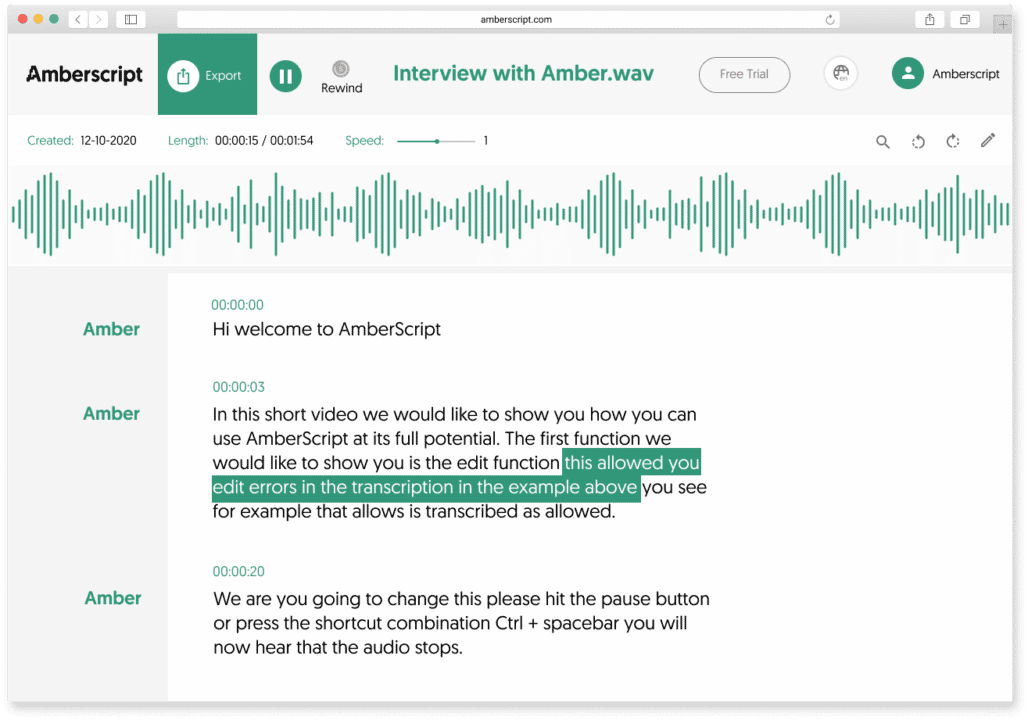
More about us
We at Amberscript aim to make communication more efficient across different platforms. We make use of experts and professionals to give you the best services available.
Here are some reasons why you should make use of our services
- We offer security for your audio and video content
- Our transcription services are fast and accurate. Making it possible for you to transcribe urgent contents without delay.
- We work with different audio and video formats. We also provide various text formats for download.
Today, broadcast media have to do all they can to stay ahead of the curve and continue to increase their audience. The use of closed captioning and transcription makes this possible. As a broadcast media house, you must employ professionals to help with these services. Here at Amberscript, we offer you the best.
Want to make your subtitles look good? Try our new AI-powered alignment and formatting solution
Subtitles are crucial in making media content more accessible and in improving user-friendliness in general. Primarily, it enables people who are deaf or hard-of-hearing to consume the content. Furthermore, it improves comprehension of proper names, foreign words as well as regular speech in the presence of strong accents or background noises. It also enables content creators to expand their reach via translated subtitles. You can read more about the advantages of subtitling here.
Creating subtitles from audio
The creation of subtitles is however not trivial and needs to follow certain rules that improve its readability. There are constraints on the number of characters in a subtitle line, the number of lines in a subtitle frame, the duration of the subtitle frame, and the positioning of line breaks within a subtitle frame.
Subtitle rules can vary between different entities. For example, BBC and Netflix have slightly different guidelines. It is recommended to insert line breaks such that they occur at natural points. For instance, inserting a line break between an article and a noun (e.g., the + book, a + tree) or a pronoun and a verb (e.g., he + runs, they + like playing) hurts the reading flow. Line breaks after punctuation marks such as a comma and a full stop are good since they indicate natural pauses. Therefore, the creation of subtitles involves a careful insertion of line breaks while obeying all the other constraints.
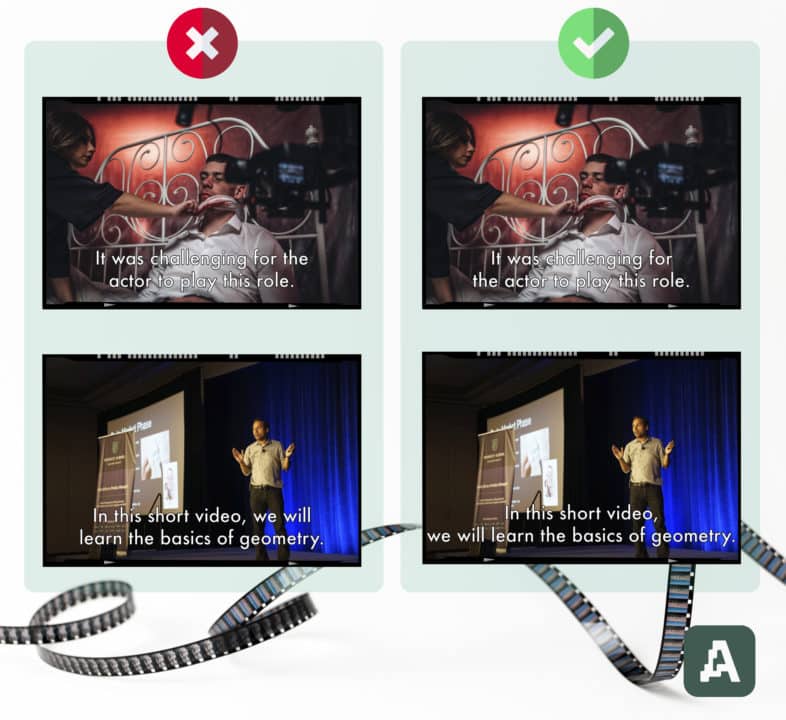
Making subtitles is not always easy
Traditionally, subtitling is done manually by humans. Automatic speech recognition (ASR), which is one of Amberscript’s offerings, assists subtitle creators by automatically converting speech to text. In this case, the mistakes in the ASR transcript are first manually corrected to be perfect. Next, subtitlers use the transcript to generate the subtitles. This process is cumbersome and involves a lot of manual effort trying to conform to the subtitle rules. As a result, subtitling takes a lot more time and costs more money than a simple transcription.
Automatic or manual subtitles from Amberscript
With the growing amount of media content, the demand for subtitling has increased tremendously. At Amberscript, an increase in subtitling jobs means an increase in turnaround times given the limited number of subtitlers. We thus wanted to reduce the human effort in subtitling by automatically formatting subtitles.
While the other rules can be satisfied programmatically, the subtitles rules regarding line breaks indicate that they should rely on linguistic features of the text. Hence, we designed an approach based on deep learning and natural language processing (NLP). We trained models to automatically determine the best position to insert a line break, using high-quality subtitles as training data.
Our models are trained to deliver accurately aligned subtitles in 13 different languages: Dutch, German, English, Swedish, Finnish, Norwegian, Danish, French, Spanish, Italian, Portuguese, Polish, and Romanian. Rather than hard-coding all the rules regarding line breaks, we trained the models to learn to determine when to insert a line break from human-generated subtitles. Our final subtitle formatting algorithm utilizes these models for line breaks while satisfying all the other constraints. The algorithm also runs fast, producing formatted subtitles in just a few seconds for most files. A 12-hour file, for example, requires under two minutes.
Subtitle alignment
An important prerequisite for automatic subtitle formatting is the alignment of speech to the corresponding text. Transcripts from ASR are often edited to add missing words and remove/edit incorrect words. After a transcript is edited and finished, we would need to realign the words to the corresponding speech segments so that the word-level timestamps are accurate. We built an automatic forced alignment algorithm that can perform this step. We currently support forced alignment in three languages – Dutch, German, and English, with more to come in the future.
New workflow for creating subtitles
In order to facilitate the creation of subtitles, we also built a subtitle editor where users can directly edit the formatting of subtitles. When a subtitle job is requested, the ASR first converts speech to text in the form of a transcript. The mistakes in the transcript can be corrected in our transcript editor. Once the transcript is perfected, users can click on the ‘Create Subtitles’ button and set the subtitle rules. The job is then queued for forced alignment followed by subtitle formatting. Once it’s ready, the file can be opened in the subtitle editor, which includes a preview window that shows the subtitles overlayed on the media. Users can adjust the formatting if required and finally export the subtitles in the desired file format.


Faster, cheaper subtitles
The combination of ASR and automatic subtitle formatting enables us to offer subtitles much quicker than before. The final result is highly accurate. What’s more – users can decide whether generated subtitles should meet either BBC or Netflix standards.
Additionally, the lower amount of subtitler engagement required means that we can also offer subtitles at a reduced cost. We believe that takes us one step closer to our mission of making all audio accessible.
Transcription in broadcast journalism: uses and importance
The role of broadcast journalism in society today goes beyond getting the right information. The need to get the information across to the general public is equally important. It could mean life for some. Since journalism is associated with ‘truth,’ it is necessary for broadcast journalism to get information across to the audience without misinterpretation or misunderstanding. It is also vital that the news or the information is made accessible to as many people as possible. Transcription is one way to achieve all of this without problems. This begs the following questions. What is the use of transcription services in broadcast journalism? What important role do subtitles play in broadcast media? This article will focus on these questions. It will also elaborate on the importance of transcription services in the media industry in general. Let’s start with transcription in media.
What is transcription in media?
Transcription in media is the conversion of audio and video content in the media industry to text for analyzing and editing. Transcription services play a major role in the media industry. Its importance continues to be appreciated by all involved. Also, the media world continues to expand and the competition grows every day. This expansion, coupled with some media and broadcasting regulations rules and directives is why transcription is important in successful broadcast media.
Several media programs – both audio and video – are produced with a script and are pre-recorded. It is easier to analyze these programs before recording. However, many other programs are also pre-recorded but without a script. It could be a show, or a documentary, or any other interesting program. There is a need to analyze every part of these programs to ensure that they do not violate any broadcasting regulation. In this situation, transcription comes in handy. How? To analyze the video, an editor might need to watch and rewatch it several times. This is stressful and time-demanding. A transcription provides a detailed text of what has been recorded, making it easier to analyze. This is the major role of transcription in broadcast media.
What is transcription in journalism?
Journalism today requires resilience and expertise. Journalists have to do all they can within the frame of the law to get the right information at the right time. Research has also shown that many do not feel comfortable talking to a journalist at the sight of pen and paper. What’s more? Using pen and paper to note down points from the field is slow and stressful. Journalists now use recorders, other audio devices, and video devices to get information during interviews, research, and many others. The conversion of these audio recordings and video recordings to reports for broadcast journalism requires transcription. Transcription in broadcast journalism helps journalists to convert to reports that are read to the general public. Simply transcribing the recordings is not enough, it has to be efficient. The use of transcription services in broadcast journalism is important for the following reasons.
Inaccurate Reporting
One of the many interesting features of language is seen in the use of words. The context or idea of a sentence can be altered simply by omitting or adding a single word. The entire information and the reporting become inaccurate. The journalist loses reputation because of an inaccurate report due to bad transcription.
Libel Cases
Accurate transcription helps to prevent cases of libel. One can sue a journalist if what is said is different from what was reported. Without transcription, it is hard to report people’s comments without mixing words. Cases of libels could cost as much as million in dollars and they also affect the credibility of the journalist. It is another reason why the use of transcription services in broadcast journalism is very important.
Transcription services for broadcast media
Broadcast media can make use of various transcription services to promote their content and broadcast to a wider audience. Here are some reasons why transcription services for broadcast media are quite important.
SEO features
The use of internet search engines is one reason why transcription for broadcast media is important. People today have to shuffle through hundreds of TV channels and thousands of programs to find their favorite. With transcription, one can easily use keywords to find their preferred program. Transcribed text increases the SEO features of a program, giving it a wider platform and audience.
Varieties in information format
The viewers and audience have unique ways of digesting the information being shared through broadcast media. Research has shown that some love to read through the programs instead of watching, as they can absorb the information faster this way. Transcription in broadcast media makes it possible for them to have access to a text version of the program.
The importance of transcription in broadcast media continues to grow. It is an interesting fact to note. Transcription services have continued to play a major role in various sections of the information world.
Subtitles for broadcast media
Subtitles for broadcast media are more than just transcription. It takes a step further. The transcribed text is embedded in the video and made available on-screen to make it available for viewers. Based on requirements by the various broadcasting commissions, the use of subtitles or captions is important in broadcast media. This is especially true for some programs such as live news, and important announcements. The Federal Communication Commission has directed that all broadcast media should include subtitles and captions to their programs. But what is the use of subtitles in broadcast media?
Here are some reasons why the need for subtitles is paramount.
Hard of Hearing or Deaf audience
Subtitles reveal what is being said and make it available to those who have hearing issues. The subtitle text is added on a part of the screen that makes it easier for viewers to read the text and watch the actions conveniently. This helps them to get the needed information or expected entertainment from the program. The audience also appreciates the fact that they are considered in the scheme of things. This would greatly boost the ratings and reputation of this broadcast channel.
Accents or fast talkers
Even those who do not have a hearing impairment can sometimes have a hard time hearing a program. This happens when the presenter or the guest on the program has a thick and unusual accent or perhaps a fast talker. Subtitles or captions would ease things up for the listeners.
Homonyms
Words that sound alike might give room for confusion. The audience perceives something entirely different from what is being said. The use of subtitles helps to remove that confusion.
These are some of the reasons why the use of subtitles in broadcast media is very important. However, there are technicalities involved in both transcription and subtitles. If a broadcast media wants to do it right, the need to use an efficient transcription service is more than important.
This is where we at Amberscript come into the discussion. Here is a little insight on services.
Amberscript
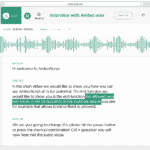
Amberscript is a transcription service provider that gives its client and users quality transcription with the highest accuracy. We aim to bridge the gap that exists in communication as a result of dynamics in language making it easier for you to pass your information across without the fear of misinterpretation. Our goal is to make language and communication more effective using science and technology.
Why Us?
Advanced Technology and Experts
We make use of AI speech recognition software that helps to generate texts from audio and video content with the highest accuracy. We also have seasoned experts that ensure that the transcription is in order. The use of AI technology and our experts guarantees the best services.
Security
Broadcast media understands the need to secure information and avoid leakage until the news is officially broken. Therefore, there is a need for security during transcription. This is exactly what we offer our clients. Our server is built on a secure network. What’s more? Every step of transcription is handled by a professional. Your security is assured when you use Amberscript.
Fast Delivery
The broadcast media world is a fast one and there is a need for a constant flow of information. This also means there is a need for transcription that can offer the best services in the shortest time possible. Our next-generation system only needs a few minutes to provide the most accurate transcription.
Multiple Formats
We accept and work with multiple formats including MP3, MP4, AVI, MOV, and many others for both audio and video. We also provide the transcription and subtitles in various formats of your choosing.
Our services
We offer the best in any of the following.
Journalism is not complete and efficient if the information is not passed across efficiently. This is why broadcast journalism has to use all the means necessary to pass the information across to others. The use of transcription in broadcast journalism helps to solve the issues that arise from communication. Make use of our services to enjoy the best bit of broadcast media.
Transcription vs translation in language: Uses and technology
There are many forms of communication. It is one of the distinct features of human language. It allows speakers and listeners from different cultures and languages to communicate effectively without misinterpretation of any sort. Transcription and translation are some of the tools used in ensuring this ease of communication. However, it is quite important to know the unique differences between transcription and translation. Hence, we take a look at transcription vs translation in language: where it is used, how it is used, and when both can be combined for effective communication. Let’s get down right to it.
Transcription vs Translation in Language
What is transcription?

Transcription is the process of converting audio or video content to a written format of the same language. Transcription deals with two forms of language; the spoken or recorded voices and the written form. However, it deals mainly with just one language. The goal is to supply the voice notes in text. Transcription also deals with non-verbal language forms. This includes sign language. What’s more? Language forms like gestures, emotions, feelings can also be transcribed. This depends totally on the preference of the owner of the transcript file. Transcription produces the most accurate results when the conversion is by a native speaker of the language.
What is translation?

The translation is quite different but could be easily confused with transcription. Translation also involves the conversion from one language to another. However, it only deals with text. A good translator should be able to understand the differences that exist in both languages. He should have a detailed knowledge of the original language and the target language. A translator is better suited to the process if he or she is a native speaker of the original language. More information about transcription can be found in our other article.
Similarities between transcription and translation
Though they are different and used for various purposes, some similarities exist between them:
- The two are ways of converting one form or type of language to the other.
- Both aim to breach the gap that exists in communication.
- They are used to widen the range and spread of research contents, either written or spoken.
The difference between transcription and translation in language

Having described the two-mode of conversion, we take a look at the differences in transcription vs translation in language. This would help us to understand the purpose of both types of services and what they involve. Here are some basic differences between transcription and translation.
Mode of conversion
Transcription is mainly concerned with what is being said. It has little regard for the meaning and message of the recorded content. The goal is simple; convert to text, make it available to readers. It makes transcription relatively straightforward. Because this process only involves one language type, there is little need for consideration of culture. Transcription also involves nonverbal clues like sighs, gestures, emotions, and the likes.
Translation involves two or more languages. Conversion is from one language to the other. A good translator must note the differences between the languages. This is because some expression needs to be written differently if it is to maintain the original idea. Therefore, in-depth knowledge of the original language is needed. This helps if the translator understands various idioms or expressions that are unique to both languages.
Number of languages involved
Transcription deals with one language. Audio or video content is converted from one form of a language to another form of the same language. An example is an audio interview in English. It is transcribed to text in a bid to provide the interview in written format for those who prefer it. The whole process is in English.
Translation on the other hand involves two languages. The language of the original text and the target language. One example is the translation of a text from English to Spanish. So we have two different languages involved.
Language form
Transcription deals with the conversion from one language form to the other. Spoken words, either audio or video are converted to text. It also includes a transcription from sign language to text.
Translation deals with one form of language. It is from text to text. No other form of communication is involved.
These basic differences between transcription and translation in language give both a wide range of use. People tend to ask: when is translation needed? When is transcription needed? When do combined services make sense? Let’s answer those questions.
When is transcription needed?
Now that we have discussed what the two-mode of conversion entails. It is important to answer the next question many tend to ask, “When is transcription needed?”
Various scenarios in language and communication involve the use of transcription. Let’s take a look at the most common ones.
Hard of Hearing Issues
Transcription is used to help those that are better at understanding texts. Interviews recorded in conferences, and lecturers can be transcribed to aid those who are deaf or have hearing issues.
Medicine
In medical practices, some diagnostic doctors might present their findings, solutions, and prescriptions in voice notes. Transcription helps to convert those recordings to text that is easily accessible by all.
Incident report
Audio reports of an incident also need transcription services to get a written version of the event.
When is translation needed?

Translation as a language conversion tool can come in handy in various situations. Here are some examples of when translation is required.
Research works
These are prime examples of documents that require the use of translation. The research work might be needed by a researcher from another part of the world. Before he can understand the components and result of the research, there is a need to translate it to a language that he understands better.
Literature
When is translation needed in literary works? Writers of literature also enjoy the services of translators to help provide their works in different languages. This is to help attract a larger audience.
Using transcription and translation
Some might ask the question; when are both needed? Of course, there are situations where using both transcription and translation is very necessary. It however depends on what the owner of the documents or recording wants. Here are some examples of when the combined services would be fitting.
Video Subtitles
Providing subtitle files for video content in another language would require the use of both transcription and translation. The video is transcribed to produce the original message in written form. The generated text is then translated to the target language. The translated text is provided as the subtitle file for the video.
International Forums
International forums and conferences require the use of both transcription and translation. A report of the conference has to be provided in different languages. This would require transcription to text, then translation to those languages.
Interpretation
Interpretation is often confused with translation. However, there is a difference, while translation involves converting text from one language to the other, interpretation only involves the use of spoken words. They are mostly spontaneous. An example of where interpretation would be useful is during a live international conference. The language of the speaker is interpreted directly by the listener. This is to aid communication within the conference. This is known as simultaneous interpretation. Other types include consecutive interpretation and whispering.
Technology in transcription and translation services
While the use of human translators and transcribers remains important till today, technology is being used to give better quality translation with reduced error. Some machines can translate words from one language to another.
The use of Computer Assisted Translation has advanced the role of technology in translation and transcription. It provides ease and comfort for the translator.
Using both the available technology in transcription and professional transcribers’ help, achieving the best quality translations is guaranteed.
Amberscript
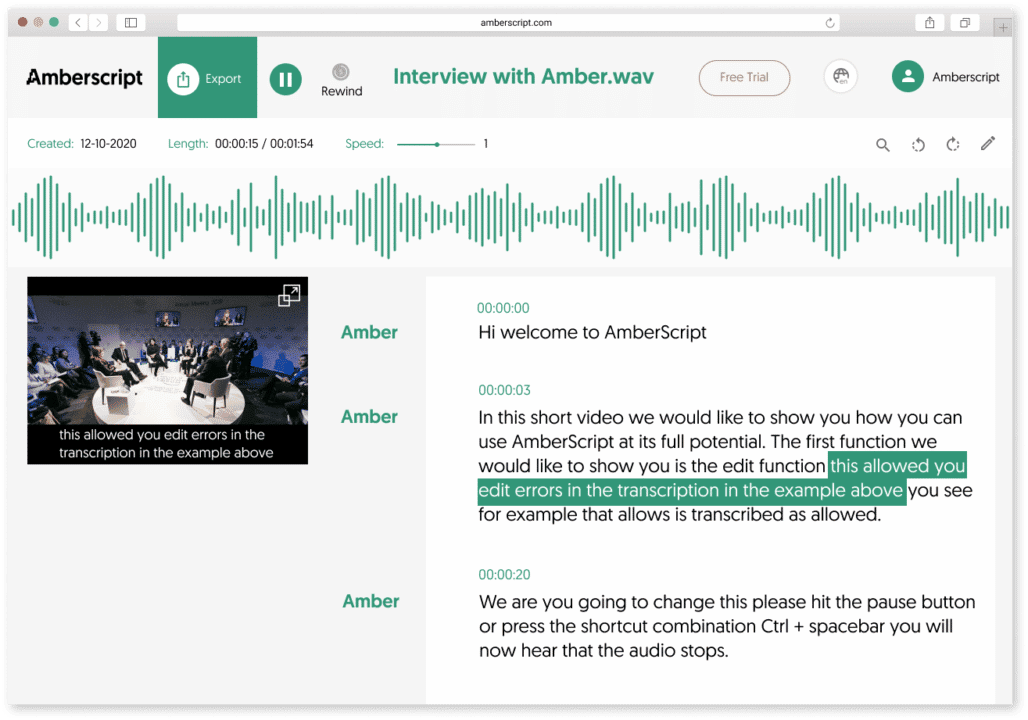
Amberscript provides transcription services with the use of both professionals and advanced technology to give users the best quality transcription. We use a combination of experts in different languages and an AI speech engine software to transcribe audio and video content.
We have a team of experts that can transcribe and translate in more than 30 languages. This is why we are trusted by many to provide the best quality of language services available.
Why Us?
Here are some reasons why we are the best at what we do.
- We use AI speech recognition software to give our client the most accurate and reliable transcription in minutes. Hour-long videos are accurately transcribed in a few minutes.
- Our infrastructure is also built on a secure server. All data is processed by our team. This ensures data security. There is nothing to worry about.
- We accept different file formats for your audio and video content. These include MP3, MP4, WAV, WMA, and others.
Our Services
We offer expert services in any of the following.
- Automatic transcription: This service makes use of our speech recognition software to generate text for recorded content.
- Manual transcription: The service option makes use of our professionals to transcribe your file. Manual transcription combines the effort of the experts and our software
- Automatic subtitles: We use advanced technology to generate subtitle text for your videos. You also have multiple options for downloading the file.
- Manual subtitles: Using our expert to transcribe and translate your video to any of the multiple language options available.
Join us and enjoy our expert services in the various options available.
Transcription vs translation in language are important tools to getting your message across to a wider audience. What is needed is based on the goal and target of the content owner. The target audience also determines which or when you get to use both. Technology has also made things easier and more effective for many translators around the world. Make use of these advancements and enjoy the grand benefits.
Convert your VHS tape to digital – file, DVD, or Blu-ray
The wedding ceremony of a 60-year-old marriage. The recording of the birth process of a now-grown son. The naming ceremony of a dear son. The graduation ceremony of one’s dad. The list is endless. What list? This is a list of memories that one might decide to keep individually or as a family for generations to come. Alternatively, it might be the perfect gift from a doting child to his parents on the celebration of their wedding anniversary. It is important to keep the memory alive, either as a gift for a loved one or a personal collection.
However, most of these videos are old, and most likely, they are only available in videotape recordings known as VHS. This poses a longevity problem because, after some years, these recordings are lost in mold infection or complete decay. If you still have some stored in good condition and want to preserve the memories for generations to come, what you need is a VHS to digital converter or a capture card. Using a VHS to digital converter or capture card helps you digitize the recordings and safely keep them on different storage platforms. There are two available methods available to anyone that wants to convert their VHS to a digital file.
How to use a VHS to Digital Converter
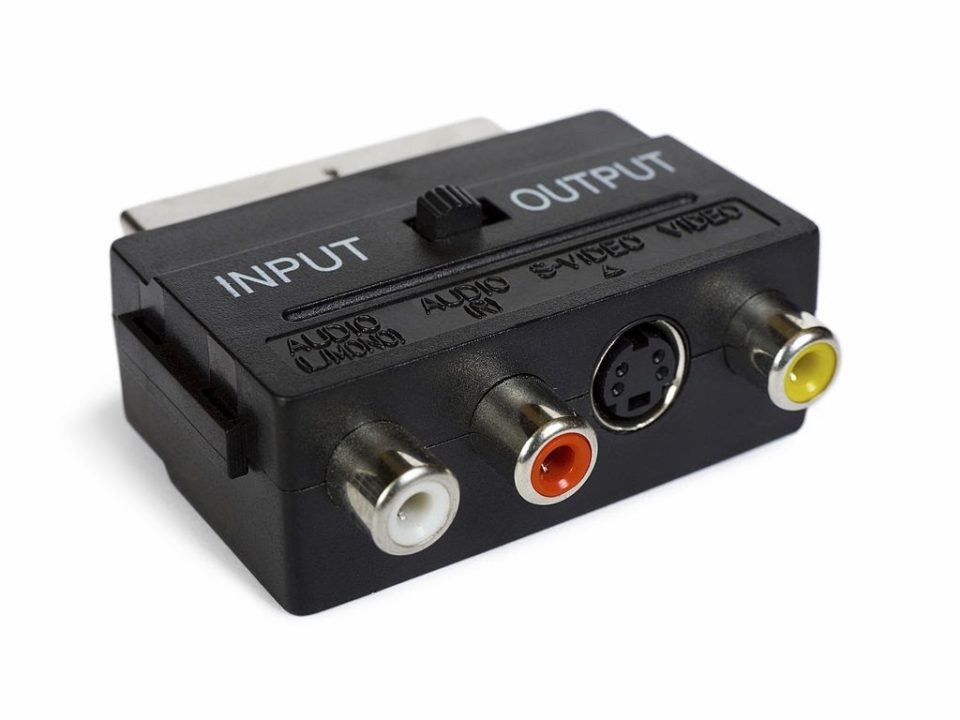
The process of using a VHS to digital converter is a simple one that doesn’t require much expertise. Though the steps involved are straightforward, the whole operation takes time and might require hours depending on the length of the video. However, time is just a small price to pay for saving the memories from eternal extinction.
For digitization, you need a VCR. It might be challenging to get a new one, but if you can get a second-hand VCR in good shape, then it is all fine. Alternatively, if you remember keeping a VCR in the attic, it might be time to get the brush and do some digging. If the VCR is still in shape, then you are in luck.
Next, you need a VHS digital converter. It is a simple device that you can get online at a tech store. There are some VHS to digital converters available for sale. Your budget and the importance of this project would determine the VHS to digital converter of your choice. This converter should have a converter cord as part of the package.
The cord is RCA phono output and S-Video with a USB connector at the other end. Some VCRs have the S-Video output face; you should use this for video output. It is better than the yellow composite jack at video output quality. If your VCR does not have the S-Video output and you don’t care for top quality, you can go ahead with the digitization.
A laptop or desktop computer is only optional here. Some VHS to digital converters have built-in screens. This means that you can complete the whole process without a computer. What you need in this case is a flash drive where the digitized recordings are saved and stored. Once you have everything, you are ready to go. Now we go through the steps involved.
What you need:
- A working VCR.
- The VHS(s) in working condition.
- A VHS to Digital Converter.
- A laptop or desktop (depending on the type of converter)
Steps involved:
- Clean your VCR lens: It is advisable to clean the VCR with a cleaner to make sure the lens is working optimally.
- Next, test your VHS and your VCR by playing the video. Make sure the play is smooth and without issues.
- If you are using a converter that requires computer software, install the software and open it. The software installation is always easy.
- Rewind the VHS and press play, press record on your converter. If you are using a computer-linked converter, press record on the menu of the software.
- The recording occurs in real-time, so you might want to do other things while the process is going on. However, you should stay during the process to inspect for issues or glitches.
- Once the recording is done, you can save it in the most common format, which is MP4. You can also upload directly to your movie folder or YouTube depending on the type of VHS to digital converter used.
- As an option, you can decide to trim some parts of the video and edit it as you wish.
What is the best VHS to digital converter?
When looking to buy a converter, most people would like to buy the best type for their operations. While there are a lot of options out there, few have stood out based on customer’s reviews and recommendations.
Based on the types, we have two different categories. Those that require a computer for digitization and those that do not.
For converters that do not require a computer:
- ClearView VHS to Digital Converter
For converters that need a computer for software installation:
- Elgato VHS to Digital Converter
- DigitNow VHS to Digital Converter
These are the top converters, according to research and reviews. There are many other options available for personal use. If you don’t have a large budget, you can still get other cheap options that fall within your preferred budget.
Capture Card

The use of a capture card is another method that is available to you. Capture card allows your computer to work as a VHS converter. The process of using a capture card is almost the same as using the VHS to Digital Converter. However, some steps are involved in using a capture card that is not exactly needed when using the converter.
What you need
- Capture card with accompanying cord and software.
- A suitable computer. Note that capture cards have minimum requirements for installation. Not to worry, your laptop would most likely meet those requirements.
- A working VCR and the VHS.
Steps involved
- Set up the capture card by connecting it to the computer.
- Install the accompanying software. The software installation is usually straightforward. The software is usually available as CD-ROMs. If your computer does not have a CD drive, you can always check the manufacturer’s website to download the software on your computer.
- Insert the VHS and configure your software before recording starts. The process should be automatic. If it isn’t, check below for instructions on how to do this.
- After configuration, press play on the VCR and press “Record” on your computer.
- Do not fast-forward the video as the recording is done in real-time.
- After the recording is complete, save the files using the preferred format. That is it! You are good to go.
Configuration instructions
- Open a new project on the installed software.
- Set the canvas size. For personal use, the canvas size should be 320 x 240. This will give you a better picture output.
- Next, turn on interlacing. Interlacing emulates how tapes are displayed on the TV. You might have to repeat this process at the start of each conversion.
- Refresh Rate. The refresh rate option is NTSC or PAL. If you are in North America, set the rate to 60Hz (NTSC). If you are outside North America, set the rate to 50Hz (PAL).
- After doing this, your software is ready for recording. You can refer to the steps above to continue.
Tips
Here are some tips that can help you go through the process without or with minimal issues.
Dust up your VHS
- The VHS would mostly be more than a decade old. It is important to dust it up before inserting it into the VCR. A simple brush could do the trick.
Check the tape for crunch
- Check the tape by opening the cover on it. Press the button on the side to reveal the black tape. Turn one of the sprockets (the two grind-like circles) with your hand to reveal the inner part of the tape. If there is any part that is crunchy or bent, straighten it out.
Add subtitles to your videos
Now that you have your video digitized, there is just one step to complete the project. You can add subtitles to the videos. The videos are probably more than a decade old, and you are wondering how it is possible to add subtitle files to the video.
Well, here comes the good part. With a trusted digital platform and online software, you can do this without stress. There are other options like manually writing the subtitles, but that would be stressful, especially if the video lasts for hours.
Amberscript
To get the best subtitle for your old video, you should use the Amberscript AI speech engine to generate automatic subtitles for your video. Amberscript offers services that include automatic subtitles. We also help to transcribe your video and audio to text, if that is what you need. Unlike the digitization process that is as long as the video, generating subtitles is as fast as it gets. The whole process takes minutes.
Visit Amberscript and upload your video.
The speech recognition engine starts to transcribe your video. This process takes just a few minutes. The online text generator provides the first draft. You can download this draft if it is to your satisfaction. The online text editor option allows you to edit the text. Editing includes grammatical structures, punctuations, highlighting, and many more.
You can download the file by exporting it in the format you want. For subtitles, the format would be SRT file format.
Add your download subtitle to your video, and you are set. Alternatively, some formats allow you to burn the subtitle directly into the video. That way, it would be a single file. The formats include SRT, EBU-STL, and VTT.
Try Amberscript’s solution
Amberscript is fast and saves time. Our AI-based engines give the best accuracy in speech-to-text conversion. You do not have to worry about the security of your uploaded video; the whole process is through a secured network.
Digitization is needed for the obvious reason of preserving old tapes and the memories they bring. This process is straightforward with the right steps and tools. A VHS to Digital Converter is one of the pieces of equipment needed for this operation. With that and the use of Amberscript to generate the automatic subtitles, you have everything necessary to enjoy a wonderful experience. You will be glad to have digitized your video.
The Best Font for Subtitles : our top 8 picks!
Table of Contents
- Arial
- Roboto
- Times New Roman
- Verdana
- Tiresias
- Antique Olive
- Futura
- Helvetica
- Amberscript
- Open Sans
- Final tips for the perfect subtitles
Great digital content requires more than just creating or recording videos. You have to take the needed step to make sure your videos reach the target audience with ease. One way to ensure this is to have readable subtitles for your videos. If part of your target audience is speakers of another language, then a subtitle file in their language would be great. Subtitle font is an important part of your video. This is especially true if you have a wide audience, including those that are not native speakers of the language used to record the video. However, adding subtitles is meant to add simplicity and understanding to your video, not take it away from it.
A good subtitle would be clear for all to see, and at the same time, it would not draw attention away from the video. A viewer should be able to focus on your video while reading the subtitle easily. So, what is the best font for subtitles? This is a question many content creators have been asking. Many, through trial, have come to stick to the one that they feel is readable for all.
The good news is that there are many options available to you when choosing the best font for subtitles. The many options come in different styles and designs. Choosing a unique font gives your video a different feel and adds to your originality.
Let’s take a look at the best types of subtitle fonts.
1. Arial

We start off with the most widespread font in the world. Arial guarantees safety and readability. How? Almost everyone has come across the font at one point in time; it is ubiquitous. So, there is a guarantee that your viewers are familiar with it. Arial is a generic sans serif style, and it is used for various purposes.
One reason why Arial is a good choice is seen in the use of numbers and symbols. You might need to add symbols and numbers to your subtitle; Arial has them in a clear and simple design. There are variations like Arial Black, but this might not be suitable for long sentences.
If you want a font that is safe to use, then pick Arial. However, it doesn’t add any distinction or uniqueness to work. If you want something more unique, continue down the list.
2. Roboto

Roboto is the official subtitle font for Google. Roboto Medium (one of the variations of the original Roboto) is the default subtitle font for YouTube users. There is a reason for this. Roboto is one of the best fonts for subtitles. It has a wide range of styles and lengths and you can use it based on preference and length of sentences.
Roboto is generally better when dealing with long sentences in your subtitles. The fact that it is seen everywhere makes it easier to read for your audience.
Thanks to its open-source license, Roboto is free for all.
3. Times New Roman

This is another font that promises excellent readability. It was formed for the famous British Magazine, The Times. Times New Roman has come a long way from its days of being the popular font of the older version of Microsoft Word. It might not be the favorite font for some back then, but this font has its level of uniqueness that makes your work look sophisticated. It is another serif typeface with a note of simplicity.
Times New Roman is best for subtitles with short sentences on the screen at a time. If you are the audacious type looking for something different, this might just be your needed breakthrough.
4. Verdana

Verdana offers something different to users. This font is a condensed style, and this makes it suitable for small screens. So, if your target audience is those with mobile phones or small tablets, this option is a great one for you. It also brings a touch of freshness to your video.
The font is also suitable for users with larger screens. It takes up a very small space at the bottom of the screen while still being clear. That way, the focus is on your video and nothing else.
5. Tiresias

Tiresias is another great option when looking for the best font for subtitles. This font was created for vision-impaired people. It is clear and readable, so much so that it has become the standard font for BBC subtitles. It is a font that is best used when your viewers must read to grasp the information on the screen.
It is, in fact, one of the most legible fonts in the san serif category. It has up to six different styles. One more reason to consider Tiresias; it is unique and different. So, you have clarity and uniqueness.
6. Antique Olive

Antique Olive is formed specially for video content. It is a classic style of lettering and subtitles, another san serif with unique characters. Antique Olive is best fitted for content that would appear on the big screen. So, if a digital board is what you have in mind for your developed content, then Antique Olive is the way to go.
One common thing with Antique Olive is the use of black box-like background. This is to help make the font stand out. Though some might argue that this draws attention to the font, it is still a good way to make the font clearer.
7. Futura

Want something uniquely designed for a promotional video? Futura is one of the best options for you. Another sans serif font and with its level of flexibility. The regular version is great for subtitles. You can also use the condensed type for your text when you want longer sentences to fit the small mobile screens. It is great for just about any letter or character. It is readable and clear. What’s more? It gives your content a futuristic sense of appeal.
8. Helvetica

This font takes you to the media scene. It is popular among many broadcasting companies and some top advertising companies. Helvetica is one famous font; it has a documentary to its name. It has a full fill and looks concrete. Helvetica comes in different typefaces: Condensed Bold, Condensed Black, Thin, Thin Italic, Light, Light Italic, UltraLight, and many more. This gives a wide range of options in terms of design and styling. It also gives your work a modern touch.
Now that you have a comprehensive list of the types of subtitle font available to you. Questions like: “what is the best font for subtitles?” should be easy to answer by now. However, how do you generate a customized subtitle for your video? YouTube, for example, has a default subtitle font. If you don’t want to use this default font or your video is intended for some other platforms, you need to customize your subtitle.
There are many options available, but one that really stands out is our automatic subtitling and manual subtitling service.
9. Open Sans

To further enhance our list of the best fonts for subtitles, we’re excited to include Open Sans. Known for its exceptional readability, Open Sans is perfect for a variety of screen sizes, from mobile devices to large displays. This font was designed with digital use in mind, ensuring consistency and clarity across all devices and browsers. Its clean, neutral design makes it a versatile choice that seamlessly fits into both casual and professional settings, providing a modern and reliable option for your subtitles.
Benefits of using Amberscript
Amberscript’s subtitle services are:
Edit your own text within minutes or leave the work to our experienced subtitlers.
Our experienced subtitlers and thorough quality controls ensure 100% accuracy of your transcriptions and subtitles.
Thanks to a variety of integrations and API interfaces, you can fully automate your workflows.
Your data is in safe hands. We are GDPR compliant + ISO27001 & ISO9001 certified.
Amberscript
This is an online AI speech recognition software that helps to transcribe your videos and audio. They convert the result of the transcription process to text or subtitle. Their services include automatic transcription and automatic subtitles. Amberscript does more than just generate subtitles for your video. The online editor feature allows you to edit this subtitle to your preference.
Another reason why Amberscript is the best for your subtitle generation and editing is the speed of operation. The whole process lasts for just a few minutes. You have a video with an accurate subtitle with your preferred font in no time, and you are good to go. Here are the simple steps involved in the process.
- Visit the Amberscript website.
- Select the preferred services under the products. Amberscript offers machine-made subtitling services, human-made subtitling services and translated subtitles. In this case, machine-made subtitles would be the perfect option.
- Upload your video on the online software
- The speech recognition software detects the language and starts the transcription process. As mentioned earlier, it only takes a few minutes.
- Next is the online text generator, which helps generate the first draft of text with time stamps.
- You can download the text directly if it is to your satisfaction.
- If it is not, there is an online text editor that allows you to edit the text. This option allows you to change the font, font size, background, and many more. You can also change punctuation, highlighting important parts of the text.
- After editing, you can export the file using various formats.
- You have two options here. One, You can decide to download the subtitle as a separate file. SRT would be the saving option for this. Two, you can decide to burn the subtitle into the video and make it a single file. The formats for this option include SRT, EBU-SLT, VTT.
- You are set to save and download your video. Amberscript also gives you the option of uploading the video directly to different platforms of your choice, including YouTube.
Final tips for the perfect subtitles
| Font | Strengths | Screen Size Suitability | Design Aesthetics |
| Arial | Familiarity, clear readability | Small to large | Clean, modern |
| Roboto | Modern, designed for digital screens | All sizes | Contemporary, versatile |
| Times New Roman | Classic, high readability in small sizes | Small to medium | Traditional, professional |
| Verdana | Excellent legibility, wide spacing | All sizes | Clear, informal |
| Tiresias | Designed for TV, highly legible | Small to large | Functional, simple |
| Antique Olive | Unique, distinct appearance | Medium to large | Retro, stylish |
| Futura | Geometric shapes, clear readability | Medium to large | Futuristic, bold |
| Helvetica | Widely used, clean lines, neutral appearance | All sizes | Timeless, versatile |
| Open Sans | Highly legible, versatile, web-optimized | All sizes | Clean, neutral, modern |
When editing your subtitle, here are some tips that can help you decide.
- Color
Most people use sharp and contrast colors like white or black for subtitles. However, depending on the video, you might want to consider some other options. If it is a video with extremely dark scenes and extremely light scenes, a colored font might be advisable. Remember, it should be something cool and nice.
- Size
You should not just select the font; you should also adjust the size to fit the video. You don’t want a size so big that it blocks out vital information on the screen. It should not be too small that readers find it hard to read.
You should align your text to the left or middle if you prefer, but not to the right.
One concern many expresses is in terms of security. Amberscript is excellent in this regard. Your video is processed through a secure network. So, if the uploaded video is something you want to keep private, then you are at the right place.
Frequently asked questions
-
What is the difference between subtitles and closed captioning?
Subtitles are for viewers who are unable to understand the language spoken, whereas captions are for viewers who are not able to hear the audio.
Captions, which can be closed or open captions, incorporate both the conversation and any other relevant sounds. They are used to assist the deaf by showing all auditory sounds. That is, they include environmental sounds as well as changes in speaker and speaker tone.
Captions can also be used by hearing people who cannot hear the audio in a noisy place or who do not want to disturb the other people in their environment. Subtitles can also be used for this purpose if the viewer just wants to follow a conversation.
-
How do I export my subtitles?
Once your file is ready and available in your account, you can simply click on the file name and then select the “export file” button at the top left of the page. You can then select the file format, style of subtitles (between BBC and Netflix) and alignment. Please note that you can only export a file if you have validated your email address when creating an account.
-
What file formats are supported?
Our software allows you to export the transcript from the video or audio file as an SRT, EBU-STL or VTT file.
-
How to add subtitles to a video?
To add subtitles to a video:
- Import the video to be subtitled.
- Choose the clip in the movie or video to which you want to add subtitles.
- The viewer will then display a title sign at the top. Tap the Title sign.
- After clicking the title sign, select the title style you want.
- There are title variations for the bottom of the screen. Examples are lower, lower third, and reveal lower third. You may select any of them.
- To add a title (subtitle) style, double-click it.
- Go up to the observer. There is a text box at the top of the viewer where you may enter your text.
How to add subtitles & captions in iMovie?
If you are stuck and don’t know how to add subtitles to your video or you are curious about how to add auto-generated subtitles to your movie with iMovie, then this article is for you!
Have you ever wanted to subtitle a video on your iMovie and don’t know how to do it? This comprehensive guide will explain to you the whole process as well as describe what subtitles and iMovie are, how to add subtitles to your videos, and how to get SRT files with Amberscript.
Table of Contents
- What are Subtitles?
- Is it possible to add subtitles to videos using iMovie on your Apple products?
- How to add subtitles to videos using iMovie on Mac?
- How to edit and customise subtitles on iMovie on Mac?
- How to add subtitles to videos using iMovie on iPhone and iPad?
- How to edit and customise subtitles on iMovie on iPhone and iPad?
- How to get SRT files
- How to burn closed captions in iMovie
- How Amberscript can help in creating subtitles for iMovie
What are subtitles?
Subtitles are texts created either on the basis of the transcript or the script of the dialogue or commentary of films, television programmes, video games, etc. They are also called captions. They are usually displayed at the bottom of the screen in a pyramid-like manner. Subtitles have various advantages, the biggest being that they make content accessible to people who are deaf or hard of hearing. To find out more about subtitles and their advantages, check out our step-by-step subtitling guide.

Is it possible to add subtitles to videos using iMovie on your Apple products?
Definitely! Subtitles can be added to videos using the title tool. This process is a manual one, and it works this way; you add the individual block of texts into the iMovie timeline, edit it and tweak it to resemble the subtitle you want it to be.
You should note that the subtitles are open captions and would always appear on the video, which means they can’t be turned off.
Tip: What are open captions? They are an essential component of a video and cannot be turned off. As a result, their quality is closely related to the calibre of the video (e.g if the video file is pixelated, this will also apply to the subtitles).
How to add subtitles in iMovie?
Firstly, as it applies to every other thing, you have to open iMovie.
- Now that you are in the software, import the video you wish to subtitle.
- Select the clip in the movie or video you wish to add the subtitles to.
- Next, you will see a title sign on the viewer at the top. Click the Title sign.
- After you have clicked the title sign, pick the title style you desire. Since you are looking towards having a subtitle, there are title options for the screen’s bottom. They include lower, lower third, or reveal lower third. You can pick any of them.
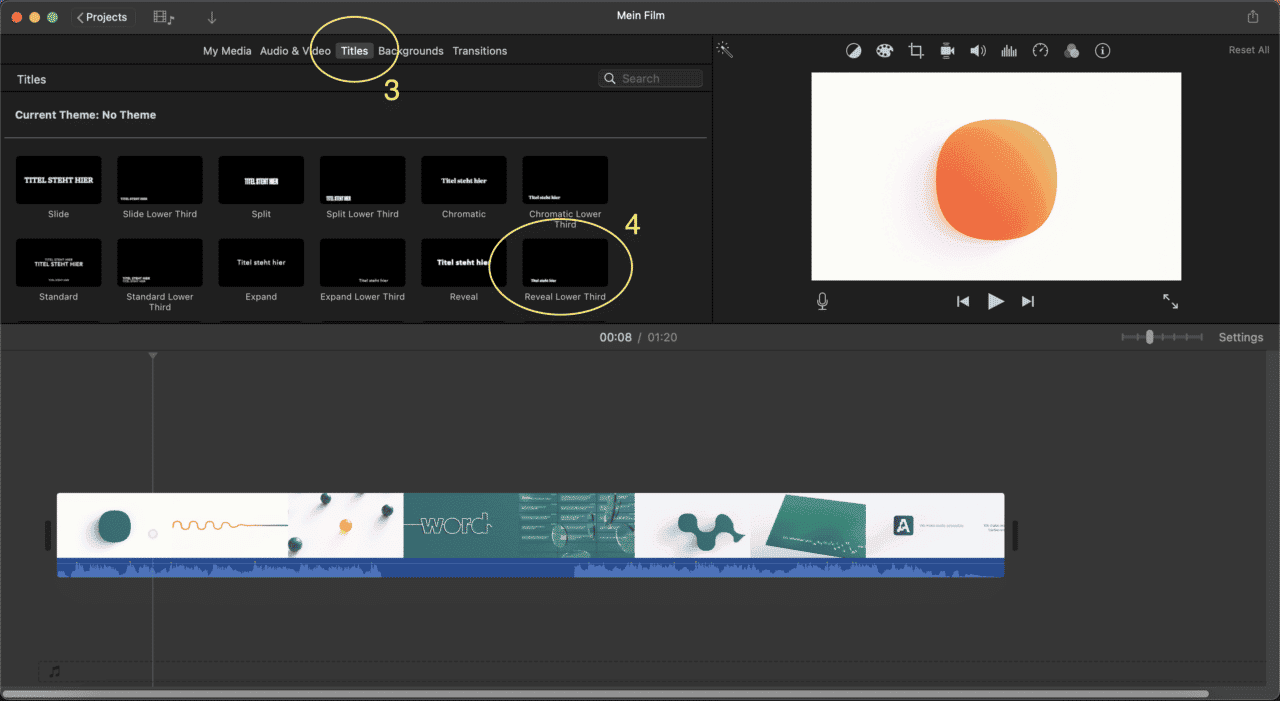
- Since your clip is selected on the timeline, double click the preferred title (subtitle) style to add it. However, you can do it alternatively by dragging the option chosen to your desired location on the clip.
- Now it is time to add your text. To do this, go up to the viewer. At the top of the viewer, there is a text box and that is where you enter your text. You can simply copy and paste.
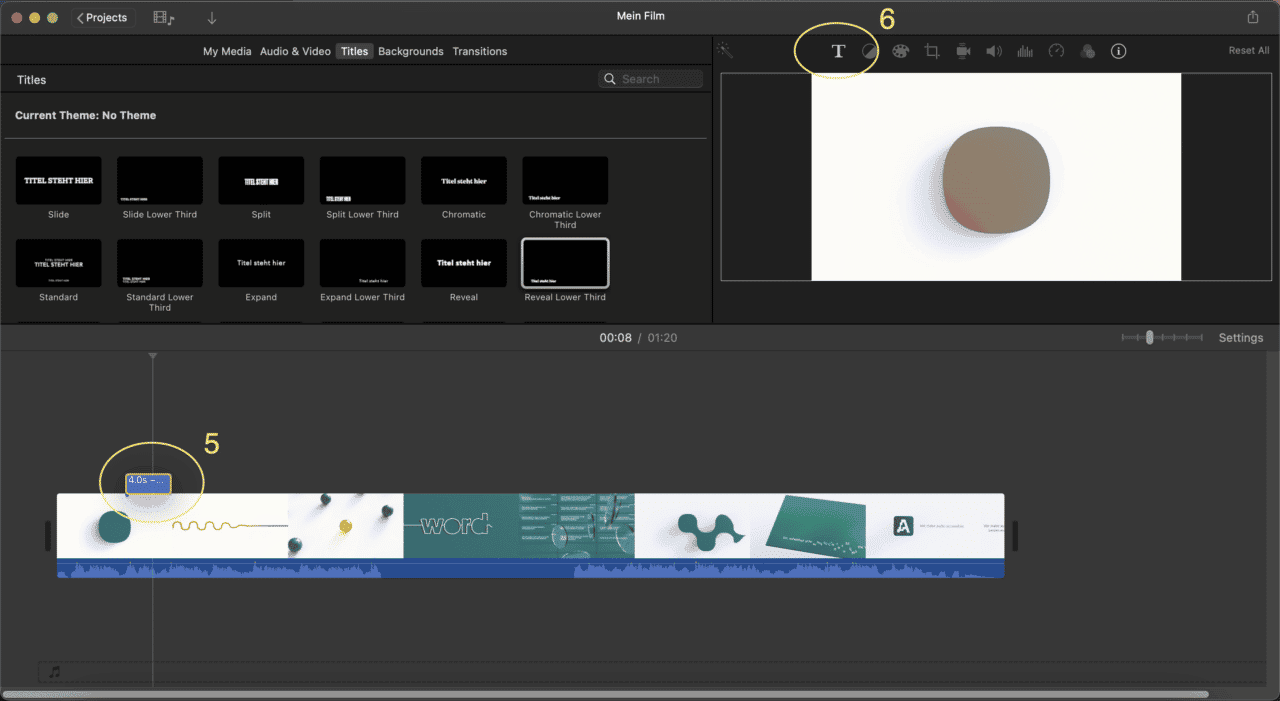
Tip: If you want to see how the option would look on the video. You would drag the option onto the clip. For example, if you want a lower third, you will click the option and drag it left to right. The program will present a preview to you.
How to edit and customise subtitles on iMovie?
You might want to adjust the duration of the shown subtitles (title), add more captions or subtitles or customise the look of the text that you are adding. For example, if you have a one-minute video clip and want to add about seven subtitles within that one minute, you can do that.
5.1 How to adjust the duration of your subtitles in iMovie?
If you want to either extend or shorten how the subtitles would appear on the screen, all you have to do is select the subtitle (title) in the timeline and do any of the following:
1. Drag any of the edges
To lengthen or shorten the duration, drag one of the edges. As you do this, the duration will start to change.
2. Click the Clip information
The clip information is an “i” icon above the viewer. When you have clicked this, you can enter the number of seconds you want the duration to be.

5.2 How to change the text style of your subtitles in iMovie?
With iMovie on a Macbook, you can also change the text style of your subtitles (title). The colour, font, style, and even alignment of your auto-generated subtitle can be adapted. All you need to do is:
- click the title clip in your timeline
- click the title setting icon at the top of your viewer
After you have done that, all the options that allow you to adapt your text will appear and you can pick the one you want.
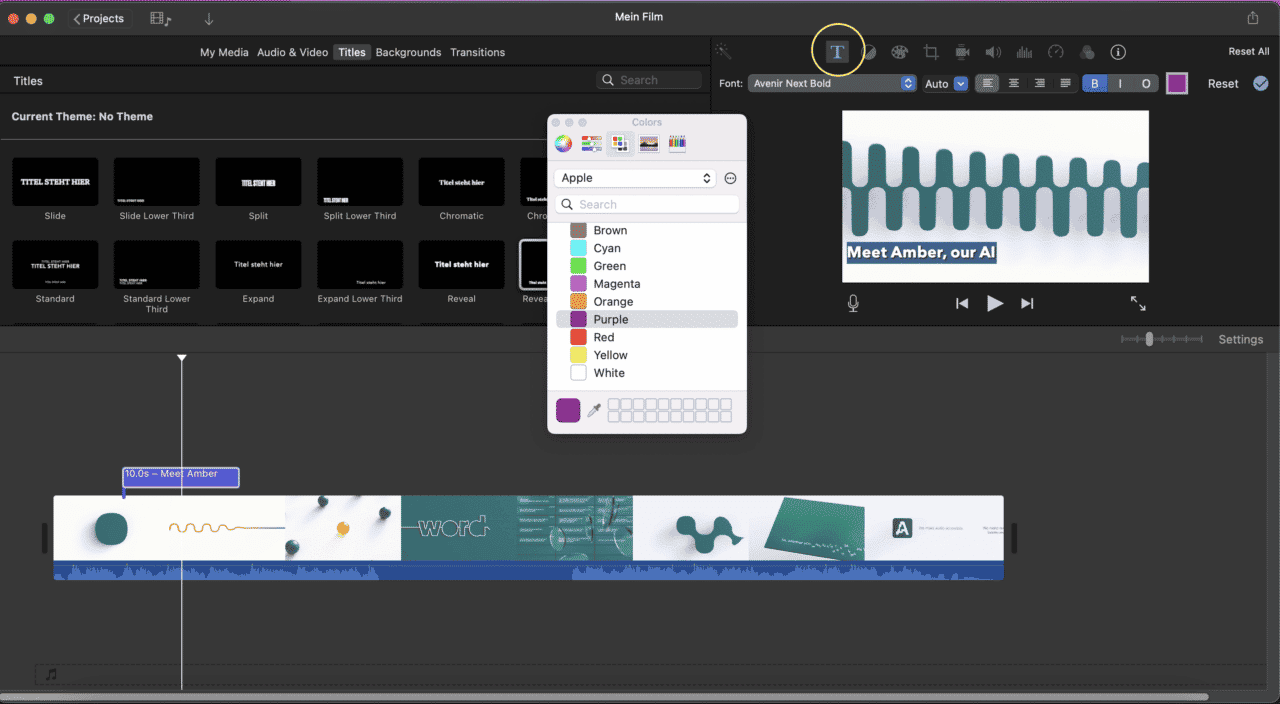
5.3 How do you trim your subtitles to the audio’s dialogue?
After you have inputted the subtitles (titles) using all the tips above, flow is also an important aspect to consider. You will have to listen to the dialogue to type the corresponding text in each correct segment of the video. This is rather simple. All you have to do is:
- Drag and drop the subtitle (title) to the frame that starts the dialogue you are working on
- Trim this subtitle (title) to end with the end of the dialogue
If the sound isn’t dialogue but is somehow meaningful to the video, you can put it in brackets within the subtitle. This way it will become similar to closed captions, describing the scenery of the video.
In order to start your next clip, all you have to do is copy and paste your current subtitle to the new clip to start. This helps you retain the text style and saves you the stress of having to start editing every time you begin a new clip.
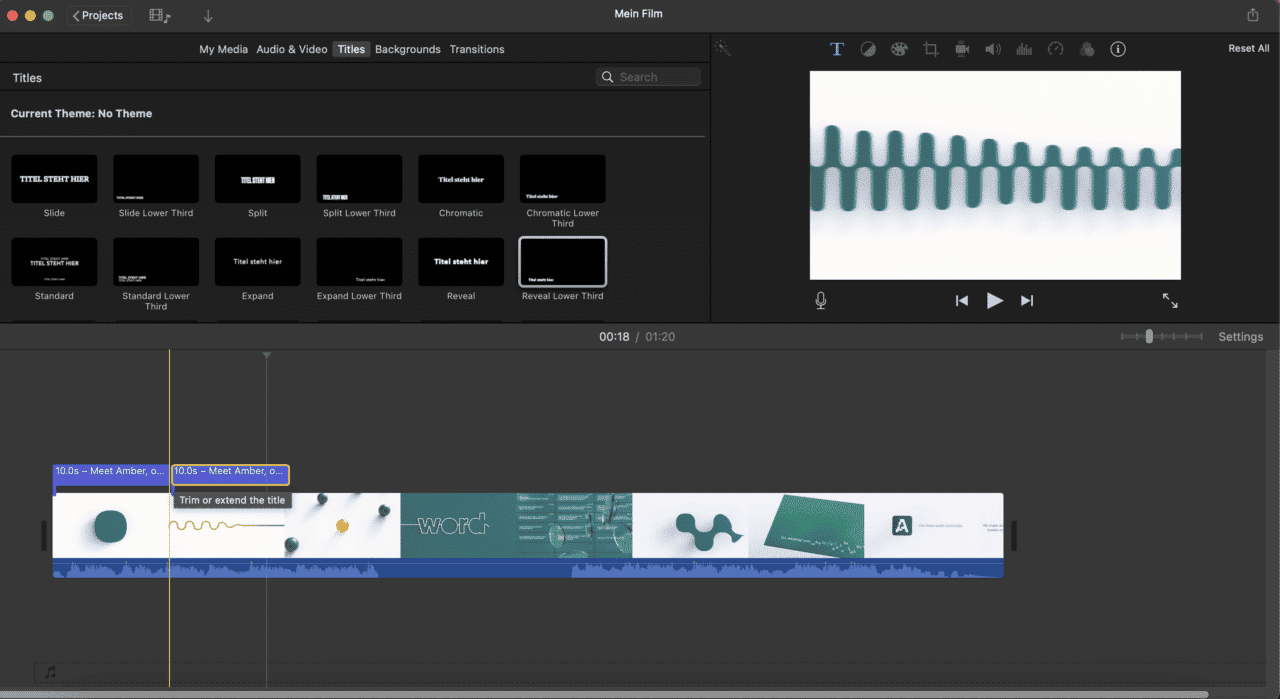
5.4 How do you align your subtitles to the audio’s dialogue?
To prevent subtitles (titles) from going on top of each other, you will have to align them. This can be done by moving the play head that is shown to you to the part in the timeline where the title doesn’t exist.
5.5 Export your file from iMovie
After you have typed in all the subtitles and edited the fonts, style, and everything aligns with what you propose your subtitle to be, you can now share the file you have made. You can decide to export it as a file or send it into the iMovie theatre, share it on Facebook, Vimeo, iTunes, or YouTube. There is a small share icon at the top right corner of the app. Click on it, then share the file.
Fortunately, iMovie does not need or require any special settings for you to be able to export your videos with the open subtitles you have. As a matter of fact, they are titles rendered onto the video. Note, however, for the best experience, export at the best resolution, quality, and compression.
After you export the file, open it. Now, you would be able to see all your captions during playbacks.
6. How to Add Subtitles or Captions in iMovie on iPhone or iPad?
Not everyone has a Mac, but you can still add subtitles or captions to your video using an iPhone or iPad. Follow these steps to get started:
Step 1: Launch iMovie
First, launch iMovie on your iOS device. If you don’t have the app, download it from the App Store. Tap the iMovie icon on your screen to open the app. You’ll see a bar labeled “Start New Project” with options below it. Select the “Movie” option.
Step 2: Import the Video
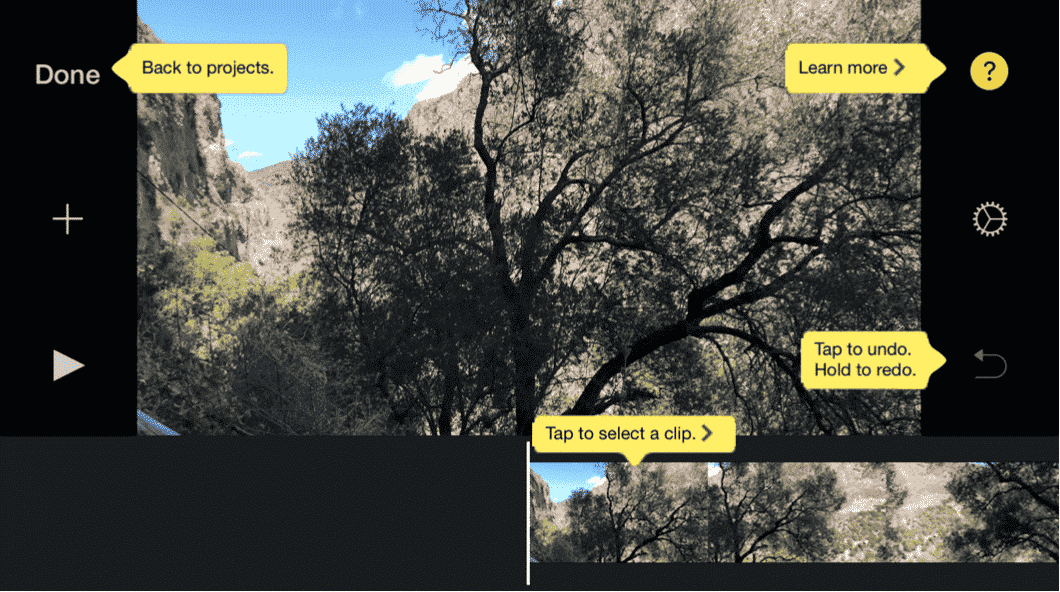
Next, import the video you want to add subtitles to. Ensure you have the video saved on your iPhone or iPad. After selecting the “Movie” option, the app will display the videos stored on your device. Choose the video by tapping it, then press the “Create Movie” button.
Step 3: Add the Text
Now, click the video clip in the timeline and select the “T” button at the bottom of the screen. A range of Title styles will appear beneath the timeline. Pick a style that suits your needs and position the timeline to the point where you want the text to appear.
Step 4: Type Out Your Captions
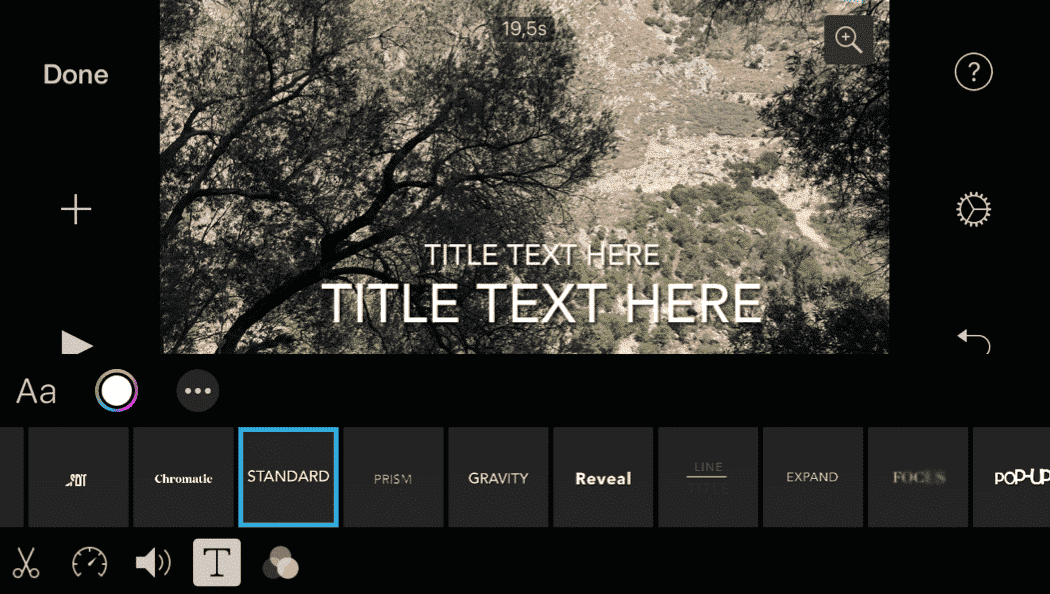
The text will overlay on the video at the top of the screen. Tap on the text and select “Edit.” Type your desired text into the box. When you press “Play,” the text will display on the video clip at your chosen point.
Step 5: Repeat the Process
To add multiple captions, repeat the above steps for each segment. You can use the same Title style or choose different ones for variety.
Step 6: Save the Video
Once you’re satisfied with your captions, tap the “Done” button in the top left corner of the screen. To save your video, tap the “Share” icon at the bottom of the screen. You can share the video via apps like WhatsApp or Messenger, transfer it using AirDrop, or click “Save Video” to store it on your device.
By following these steps, you can easily add subtitles or captions to your videos on an iPhone or iPad using iMovie.
7. How to edit subtitles in iMovie on iPhone and iPad?
7.1. How to adjust the duration of your subtitles in iMovie?
If you are editing your video on your phone or iPad, the process of editing the subtitle duration is relatively easy. Just like in case of iMovie on your Macbook, it is possible to edit the duration of your subtitles.
1. Find the ‘ timer’ icon
First, you need to click on the ‘timer’ icon, next to the previously mentioned ‘Title’ icon. This will allow you to select a clip in your video that you’d like to add subtitles to.
2. Select the preferred duration
At this point, you have two choices to edit the duration:
- You can either drag the yellow bar manually or
- You can select the preferred speed of you subtitles by clicking on a point on the scale at the bottom

7.2 How to change the text style of your subtitles in iMovie?
On iPad and iPhone, the style of your subtitles can be changed similarly to how you would do it on your Macbook.
- You need to select the ‘Options’ (icon showing three dots) under the ‘ Titles” icon. By doing this, the app will allow you to change the following settings:

You can also change the colour and the font of your subtitles, by selecting the corresponding icons under the ‘Titles’.
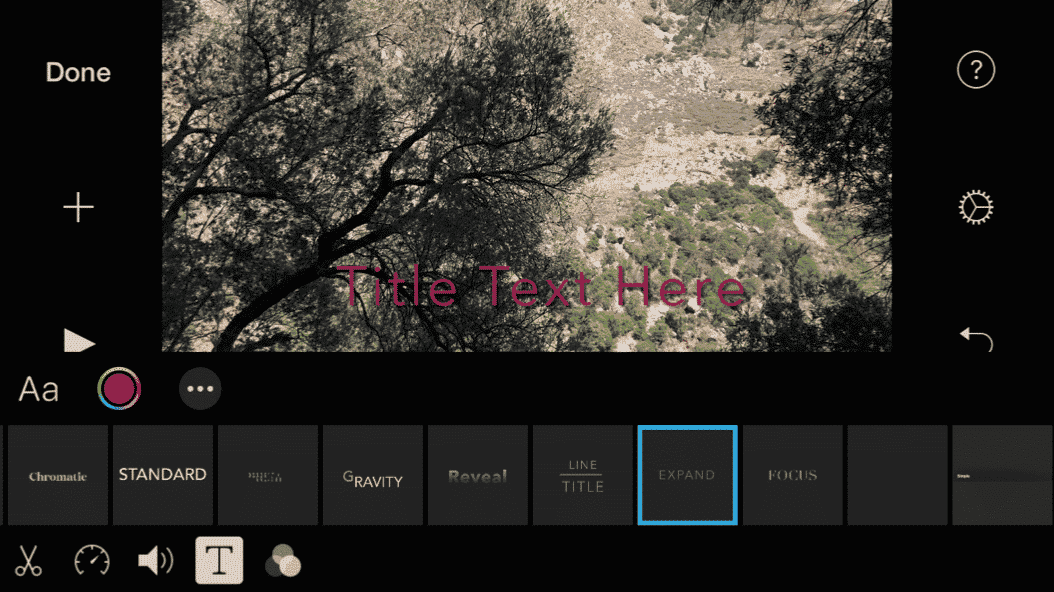
7.3 Export your file
Exporting your subtitled video is really easy on iPhones and iPads. After clicking ‘Done’, you simply need to click on the ‘Export’ icon just like in case of any other image, video or other file type. This will allow you to share your video with your friends, on social media or save your masterpiece for later.
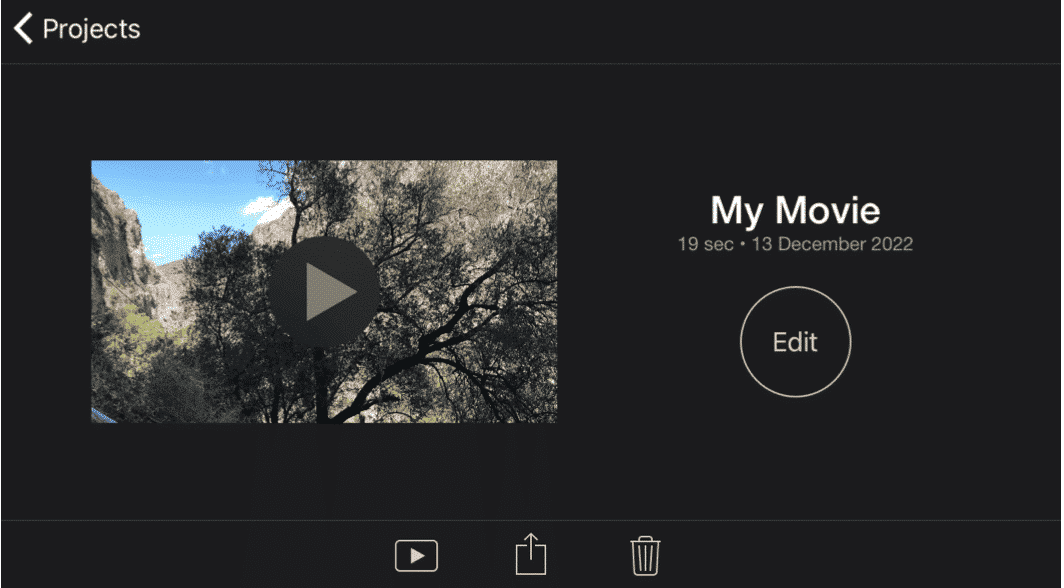
8. How to get SRT-files
Though you can use open captioning to make subtitles (titles) in iMovie as explained above, you can do the same with SRT files, and in fact, it proves to be a more time-efficient alternative.
Nevertheless, you would have to get an SRT file for your video before you can do this.
There are several ways you can get SRT files, from using a manual process, hiring a freelancer, to using software. However, over the years, a means has proved more effective in the regard of creating subtitles (.srt file), and the means is using Amberscript.
9. How to burn closed captions in iMovie
Closed captions are an important accessibility feature for videos, as they provide a text-based alternative for viewers who are deaf or hard-of-hearing. iMovie makes it easy to create closed captions for your videos, and the process is quite similar to adding regular subtitles.
To create closed captions in iMovie, start by opening your project and selecting the video clip that you want to add captions to. Then, go to the menu bar and click on Window > Show Closed Captioning. This will bring up the Closed Captioning window.
Next, type out the caption text in the text box provided. You can also adjust the timing and duration of the captions by dragging the blue markers in the timeline. Once you’ve added all of your captions, click on the Export button to save your video with closed captions.
It’s important to note that iMovie supports several different closed caption formats, including CEA-608, CEA-708, and iTT. Before exporting your video, be sure to select the appropriate format in the Closed Captioning window.
Overall, creating closed captions in iMovie is a straightforward process that can greatly improve the accessibility of your videos. By taking the time to add captions, you can ensure that your content is accessible to a wider audience and meets accessibility standards. If you wanna learn more about what closed captions are and how they work you can view our explanatory blogpost about it.
10. How Amberscript can help in creating subtitles for iMovie
Amberscript is a reliable AI-based transcription service and tool that creates subtitle files using the audio transcription. It also possesses the machine-made subtitle generator that helps it get the best subtitle files you want in the quickest time possible. So here is how you get your SRT files using Amberscript.
1. Upload your video to the Amberscript Platform
To get SRT files, the very first step is to create a free account at Amberscript and upload the video you wish to create subtitles for.
2. Let the AI generate your transcript for you
After you have uploaded the video, Amberscript starts to transcribe for you. With the help of their machine-made subtitle generator, this process doesn’t take long, and within minutes you will get your draft. You will then be able to download the first draft which has gone through its online text generator. If needed, you can edit the first draft of your subtitle on the online text editor. The editing includes things like correcting grammar structures and punctuations. As a plus, you even get the chance to annotate and highlight parts of the text (subtitle edit).
3. Export your file
Afterward, if you are happy with the edited subtitles, you can download them into an SRT file. Although you can’t necessarily upload your SRT file onto iMovie, you can copy and paste the formatted texts onto your video to ease the editing process.
Benefits of using Amberscript
Amberscript’s subtitle services are:
Edit your own text within minutes or leave the work to our experienced subtitlers.
Our experienced subtitlers and thorough quality controls ensure 100% accuracy of your transcriptions and subtitles.
Thanks to a variety of integrations and API interfaces, you can fully automate your workflows.
Your data is in safe hands. We are GDPR compliant + ISO27001 & ISO9001 certified.
Conclusion
Tersely, all of what is above is how to add subtitles in iMovie. The process of adding subtitles to iMovie videos is not easy and it involves a lot of effort. However, the effort pays off and you can create nice subtitles that look good in your video and that flow very well with the video’s audio. iMovie is not particular about subtitling. However, it is really convenient to be able to use the title feature and create subtitles directly on your MacBook or other Apple products.
Hopefully down the road, Apple will bring in a better option that makes creating and adding subtitles to your content way easier than this. But for now, using the title feature works just fine. Not to forget, when partnered with Amberscript, it works best. Amberscript is a reliable AI-based transcription service and tool that creates subtitle SRT-files. It’s easy, fast and you can even edit your subtitles.
Frequently asked questions
-
Can I burn the subtitles directly onto my video?
If you have exported the transcript as a SRT, EBU-STL or VTT file, you can easily burn them onto your video using video-editing software.
-
Can I change the position of the subtitles?
That needs to be done using a video editor like VLC. Go to Tools > Preferences [CTRL + P]. Under Show settings, select the option that says All to switch to the advanced preferences. Navigate to Input/Codecs > Subtitle codecs > Subtitles. Under Text subtitle decoder set, the Subtitle justification to left, right or center.
-
How do I add subtitles to a YouTube video?
To add subtitles to your Youtube video, simply add the file you have created using Amberscript to your video in the Youtube Studio. Click on “subtitles”, then “add” and finally “upload file” and select the SRT file.
-
How do I add subtitles to a video on Vimeo?
To add subtitles to your Vimeo video, simply add the file you have created using Amberscript to your video in the editing window on Vimeo. Click on “distribution”, then “subtitles” and finally click on the + symbol to upload the SRT file.
-
How do I order translated subtitles?
To order translated subtitles, you can upload your file like you would normally do. You can then select manual subtitling. Once you have selected this, an option will appear where you will be able to select the language the subtitles need to be translated to. If the language that you want is not one of the options you can contact us through our contact form.
-
To which languages can you translate subtitles?
For our human-made subtitling services we work with a network of language experts in 15 different languages. Find out which here. If the language you want is not on the list, please contact us through our contact form.
-
What subtitle file formats are supported?
Our software allows you to export the transcript from the video or audio file as an SRT, EBU-STL or VTT file.
Can I add SRT files to videos in iMovie?
No. You cannot import SRT files directly into iMovie.
However, you can copy and paste the text from the SRT file – this is much faster than typing directly into the text box.
Tip:
You can also retrieve your SRT file from iMovie. After opening subtitles, you can request the subtitle file. How to do it:
- First, export a QuickTime file of your project to a video file on your computer.
- Next, arrange the subtitle files along with your export.
What is an SRT file, how to create it and use it in a video?
Ever wondered how SRT subtitles are created? Ever thought about how to use .srt subtitles perfectly with videos and all the processes it requires? A guide is no longer afar. In this article, we will cover how to make and use SRT subtitles and all it entails.
What are SRT files, and what do they contain?
Firstly, SRT(.srt) is an acronym for SubRip subtitle. In simple words, they are plain texts that have subtitle information in them. They entail the start and stop time, the time a subtitle is required to move to the next, and they ensure that there is congruence with the written text and spoken word so that they move seamlessly and are displayed at the appropriate time in the video.
Why SRT files?
There are different kinds of subtitle files out there; some examples include VTT and EBU-STL. So, why SRT then? Why is SRT so preferred?
To begin with, SRT files are often seen on social media apps that permit uploading captions. You can upload a single file to the video you have created.
Adding .srt files to your videos can increase your viewer’s retention rate and ensure more engagement level. Also, it gives your videos SEO benefits. When you upload/post videos on social media platforms like Instagram and Facebook, Google indexes them and considers them scalable. Most, if not all, of the keywords you have added to your video become searchable and this, in turn, helps your video appear on more search results.
To go further, with SRT files, you get absolute control over your subtitles. Though audio transcriptions are good, they aren’t perfect. With these SRT files, you get full control over your subtitles.
Lastly, its simplicity. SRT has aged well since the DVD times and is still preferred because of its simplicity.
How to make SRT subtitles?
Just as there are several ways to make a pie, there are also several ways one can make SRT files.
However, there are three main ways you can do it:
1. Create the subtitles yourself
There is a lot of software you can use to create subtitles this way. These applications allow you to lock a time frame and write/type in the corresponding subtitle. However, you should keep in mind that this method is slow and time-consuming. Moreover, you will have to invest more time figuring out how the software you have chosen works and the best way to use it.
2. Outsource for creating subtitles
If you don’t have the resources or time needed to make subtitles for yourself, you can always hire a person or an agency to do the work for you. Though this saves you a lot of time and is an easier way out, it could sink a deep hole in your budget. To give you a little bit of what you will be going into, the price for subtitling a one-minute video is about €10.
3. Use a speech-to-text service
You can automatically create subtitles using the proper software. And no doubt, this is the best of all the three options as it is time-efficient and cheap. You might have heard or been acquainted with the fact that YouTube can automatically generate subtitles. Nevertheless, the product is about 60% accurate. It is no new titbit that accuracy is a highly prized asset in subtitling. However, there is a transcription platform, Amberscript, that has come up with a speech recognition tool to make your search for the perfect subtitles for your video way easier. And guess what, as a plus, subtitles are embedded to a particular time frame by default, thereby saving you a lot of unnecessary stress. But how is this done?

Creating subtitles using Amberscript
With Amberscript, making .srt subtitles is a straightforward process. Amberscript does this subtitling via their automatic .srt file generator. Below are five steps you have to follow to make your SRT file:
- Upload the video file to AmberscriptVisit the Amberscript website, upload your video, specify the language you want the video to be transcribed in. Amberscript takes over the rest, and in the space of minutes, your video is transcribed.
- Correction of subtitlesAmberscript goes further to correct the grammar errors that might appear during the transcription. This site does this using their built-in text editors.
- Exportation of subtitleYou pick the style of text you want. Also, you choose the alignment you want.To add, this is the determining stage, where you pick if you want a .SRT file. You are given the option to export the subtitle file to the format you want, and in this case, it would be a .SRT file. Nevertheless, it doesn’t stop there. You can decide to edit your subtitles to suit your preference. This is called formatting.
- Personal editsThis is making local changes to individual lines in a .SRT subtitle. You select the line and make the changes you desire. For example, you can italicize text in the subtitle.
- Export the fileEnsure you leave your subtitle in a default format so your changes are applied.
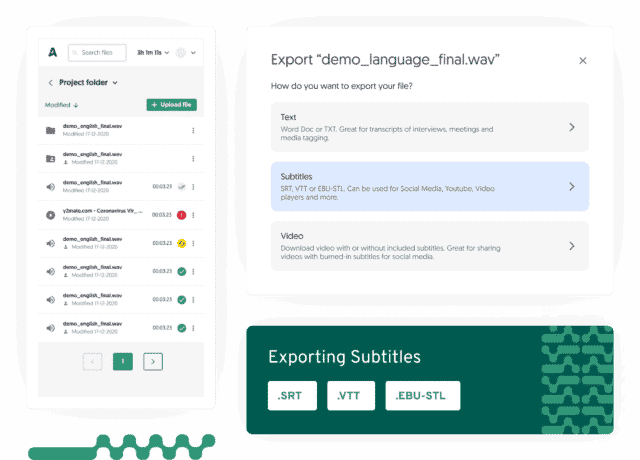
How to use SRT subtitles?
Though you have made your SRT file, it doesn’t stop there; you will have to use it.
After you have made your SRT file, you have to apply. Use it in your video. This is the next and final step after getting your SRT file, and it is quite easy. You have to find a media player to play the video and .srt subtitle. Some subtitles are required embedded in the video for those who want to post on any social media platform. For this, you will have to take a different route to use these subtitles.
To embed the subtitle in the video itself, there is a way you can do it, and this process is called open captioning. This can be briefly described as;
To add open captions to your video file, you need the application, Handbrake, the video file, and a .SRT file.
Firstly, launch Handbrake, and open the video file. Next, you will go to the subtitle tab and import the SRT file. After you have done this, you will select the corresponding language and offset setting. Click browse and select the file name and location. Also, don’t forget to tick the Burn in checkbox. After you have done this, click encode.
When you are done with all the above steps, you will wait till handbrake renders your footage.
After all of the above, you have your SRT file, with little or no stress and the best accuracy ever. However, why use Amberscript? Why not any other means? Here are three reasons you made the best choice by using Amberscript.
- High accuracy
Amberscript is all about accuracy. Since we don’t want viewers getting the wrong idea when they see our subtitles, accuracy is very vital. With Amberscript, after automatic transcription gets the spoken part of the video, It is perused repeatedly to ensure there are no flaws. Let’s also not forget the inclusion of text editing, which helps to go over the grammatical aspect. - The large variety of languages
You have access to over ten different languages. Some of these languages are Danish, Chinese, Spanish, English, among others. The highly impressive thing about this is that the computers are not left on their own to handle these transcriptions. There are also numerous native speakers who help to make sure you get the best subtitles. - It is inexpensive
Comparatively and even taken individually, Amberscript is not expensive.Tersely, subtitling is an art that only the best hands should perform, and that is why Amberscript is the option you should be looking for and should be your .srt file generator. With them, you have assured accuracy and ease while creating your .srt subtitles.
Every Country’s Highest Rated Movie
IMDb (the Internet Movie Database) rates every film out of 10, according to the public vote. Here at Amberscript, we scoured the online database to create a map showing the best-rated movies either produced, filmed, or credited in each country around the world.
Top-rated films include modern masterpieces like BAFTA winning “1917” for Spain and Oscar-winning “Parasite” for South Korea, whereas for America and New Zealand, the highest-rated movies are classics: “The Shawshank Redemption” and “The Lord of the Rings: The Return of the King”, respectively.
The highest rated films
The film with the highest rating is The Shawshank Redemption (America) – a film based on the novella by Stephen King – with an IMDb rating of 9.2 stars. It beat other well-known movie titles, like The Dark Knight (9 stars) and The Lord of The Rings: The Return of The King (8.9 stars), to the top spot.
Other highly rated films on the list include:
- Mirror Game (2016), Bangladesh – 9.1 stars
- Zana (2019), Kosovo – 9.1 stars
- Aloko Udapadi (2017), Sri Lanka – 9 stars
The lowest rated films
The lowest rated film on the list is Wrong Cops (Angola) – a 2013 French-American independent comedy film – which came in with just 6 stars out of a possible 10.
Other less popular films on the list include:
- Half of A Yellow Sun (2013), Nigeria – 6 stars
- Viva Riva! (2010), Democratic Republic of Congo – 6.2 stars
- Africa United (2010), Rwanda – 6.2 stars
The most popular film genres
We also sought to find out which genres seem to be the most highly rated by users on IMDb. Drama films make up the majority of the top-rated movies around the world — 49 to be exact, which works out to be almost 4 in 10 movies! Drama is followed closely by comedy (19) and biographies (15). Interestingly, no horror movies featured on the list.
The full breakdown:
- 49 drama films (average rating: 7.7 stars)
- 19 comedies (average rating: 7.5 stars)
- 15 biographies (average rating: 7.6 stars)
- 13 action films (average rating: 8 stars)
- 10 adventure films (average rating: 7.7 stars)
- 7 crime films (average rating: 7.8 stars)
- 5 animations (average rating: 7.8 stars)
- 4 documentaries (average rating: 8.2 stars)
- 3 war films (average rating: 8.2 stars)
The following only had one film representing each genre:
- Fantasy – Pan’s Labyrinth (2006), Mexico, 8.2 stars
- History – The Soviet Story (2008), Latvia, 8.1 stars
- Romance – Paris Je T’aime (2006), Liechtenstein, 7.2 stars
- Thriller – A Seperation (2011), Iran, 8.3 stars
- Western – The Good, the Bad and the Ugly (Il buono, il brutto, il cattivo) (1966), Italy, 8.8 stars
Which films are the highest rated per genre?

Photo credit: Willrow Hood / Shutterstock
The full breakdown:
Which films are the highest rated per genre? We have the answers:
The most popular action films:
- The Dark Knight (2008), United Kingdom – 9 stars
- The Lord of The Rings: The Return of The King (2003), New Zealand – 8.9 stars
- Seven Samurai (1956), Japan – 8.6 star
The most popular adventure films:
- Interstellar (2014), Canada – 8.6 stars
- Mudras Calling (2018), Myanmar – 8.5 stars
- Fitzcarraldo (1982), Peru – 8.1 stars
The most popular animation films:
- The Pinchcliffe Grand Prix (1975), Norway – 8.5 stars
- Finding Nemo (2003), Australia – 8.1 stars
- Bilal: A New Breed of Hero (2015), United Arab Emirates – 7.9 stars
The most popular biography films:
- The Pianist (2002), Poland – 8.5 stars
- Lion of the Desert (1980), Libya – 8.4 stars
- Downfall (2004, Austria), Green Book (2018, China), The Message (1976, Egypt) – 8.2 stars
The most popular comedy films:
- Parasite (2019), South Korea – 8.6 stars
- 3 Idiots (2009, India), When I Grow Up, I’ll Be A Kangaroo (2004, Serbia) – 8.4 stars
- Underground (1995, Czech Republic, Federal Republic of Yugoslavia, Hungary), Black Cat, White Cat (1998, Greece) – 8.1 stars
The most popular crime films:
- Mirror Game (2016), Bangladesh – 9.1 stars
- City of God (2002), Brazil – 8.6 stars
- The Bandit (1996), Bulgaria – 8.2 stars
The most popular documentary films:
- Samsara (2011), Ghana – 8.5 stars
- Inside Job (2010), Iceland – 8.2 stars
- Waltz with Bashir (2008), Israel – 8 stars
The most popular drama films:
- The Shawshank Redemption (1994), America – 9.2 stars
- Zana (2019), Kosovo – 9.1 stars
- Aloko Udapadi (2017), Sri Lanka – 9 stars
The most popular war films:
- 1917 (2019, Spain), Come and See (1985, Russia) – 8.3 stars
- Before the Rain (1994), Macedonia – 8 stars
Do you need captions for your videos? Read our guide on How to Generate Automatic Subtitles with Amberscript!
An oldie but a goodie?
Interested to find out whether the world prefers contemporary films or the classics, we found out which decade has the highest rated films, and which film is the “best”, per decade.
The oldest film on the list is Albania’s Skanderbeg, released in 1953, followed by Seven Sumarai (1956) from Japan, and The Seventh Seal (1957) from Sweden. The newest highest rated films from 2019 include Kosovo’s Zana, South Korea’s Parasite, and Spain’s 1917.
Film breakdown by decade:
- 1950s: 3 films
Highest rated film of the decade: Seven Sumarai (1956), Japan
- 1960s: 4 films
Highest rated film of the decade: The Good, the Bad and the Ugly (1966), Italy
- 1970s: 4 films
Highest rated film of the decade: The Pinchcliffe Grand Prix (1975), Norway
- 1980s: 5 films
Highest rated film of the decade: Lion of the Desert (1980), Libya
- 1990s: 17 films
Highest rated film of the decade: The Shawshank Redemption (1994), America
- 2000s: 34 films
Highest rated film of the decade: The Dark Knight (2008), United Kingdom
- 2010s: 63 films
Highest rated film of the decade: Mirror Game (2016, Bangladesh) and Zana (2019, Kosovo)
Methodology
Using data from the IMDb website, we sought to find out the most popular film to come out of each country. The site’s search option enables you to filter film titles by country to see a list of all films produced, filmed or credited in that location. Only films with a minimum of 1,000 votes were considered, bringing the total number of locations considered to 130. Amberscript then sorted the movies by the number of public votes on IMDb. The film with the highest rating for each country was taken as their highest-rated movie. All data was collected between September 29th and October 1st, 2020.
Why captions are important? 8 good reasons
It is widely known that captioning a video not only promotes digital inclusion for those viewers with hearing impairments but that it also greatly improves the user-friendliness of your content. But why captions are important? This is our takeaway in 8 points.
1. Make your content easier to understand
To be honest – this point would actually already be enough to stop what you’re doing right now and start captioning your videos immediately. Because captions and subtitles improve the comprehension of your content in more than just one way:
- Specific terms and proper names can be – thanks to subtitles – absorbed and understood the first time they are heard or read.
- Content including foreign languages or strong accents can be followed a lot easier on subtitled videos. Obviously it is also possible to provide subtitles in more than just one language for a video to reach a wider audience.
- Background noises and poor video or audio quality can be compensated by adding subtitles since they make sure that it is still possible to follow the content or the story line.
2. Engage your audience everywhere
Regardless of the time and place, subtitled videos not only make your content accessible for everyone – but everywhere and at any time! Probably you have already experienced it yourself – you are in a noisy location like in the public transport or at the office, you forgot your headphones or own those kinds of headphones that equally entertain the people around you, but you still want to watch a video!
It’s quite simple. By adding captions to your videos, your audience can keep on watching, without them there is no point in watching the video since you probably wouldn’t pick up a single thing. And that’s a loss on both sides: the provider does not reach as many people as he could (research has shown that over 80% of the videos on social media are watched on mute!) and the users miss valuable and enriching content.
3. Improve SEO score and Searchability
By adding captions you make not only all your archives searchable but also each and every video! And that’s not only an internal advantage. Every search engine works text-based. With subtitles you will significantly improve the SEO of your videos, meaning that search engines can find and rank your content and thus increase the traffic of your videos.
Transcripts and subtitles for content marketing optimization
4. Improve your language skills and train your competence
Nowadays it’s quite common to learn a new language online or via an app. Did you know that the learning effect can be additionally increased by watching videos in the language you are learning with corresponding subtitles? But not only that: Studies also show that subtitles are extraordinarily helpful to students or people that are diagnosed with learning disabilities, attention deficits, or autism. The following links provide further information and results on that topic:
- Closed Captioning matters: Examining the value of Closed Captions for ALL students
- Student uses and perceptions of Closed Captions and Transcripts
5. Interculturality
Subtitled videos give access to a whole new world: The world of foreign cultures. Only a fraction of movies or videos are translated into more languages – and without subtitles, we definitely miss out! With subtitles, everyone has access to these movies or videos – regardless of the O-tone.

6. Repurpose of content
With captions and transcripts, you can easily give your content a new purpose: You can for instance create a blogpost on your video content or write a summary, an article, etc.. – everything is possible!
7. Farewell concentration fatigue
Very long videos or movies with over-length are prone to be tiring at a certain point. The consequence of that is a lack of concentration and missing a lot of the content. Adding subtitles to your videos can help with that! Because they help to stay focused and to relax the brain even when it’s confronted with strong accents, complicated content, disturbing background noises, or tiring lengths. The following link leads you to an interesting article on concentration fatigue in connection with deafness: https://hearmeoutcc.com/concentration-fatigue-affects-deaf-people/
8. Translations are based on captions and transcripts
Once you have a transcript or captions of your content, you can easily translate it or let it be translated (which, by the way, increases your geographical reach significantly!)
Looking for a step-by-step? Read our guide on How to Generate Automatic Subtitles with Amberscript!
Top 4 digital transformation trends in education for 2024
The COVID-19 crisis sped up some existing trends in the digital transformation of education. The good news is, even before students went on lockdown, 60% of students felt that digital learning technology has improved their grades, with a fifth saying it “significantly” improved their grades – according to the Digital Study Trends Survey by McGrawHill
Table of Contents
The impact of digital transformation trends in education
Even before the coronavirus crisis, digital technologies were transforming education at an incredibly high pace. All stages of the learning process changed dramatically thanks to digitalization. These digital transformation trends can be leveraged to help students who were suddenly pushed to remote learning.
Traditional classrooms, print books, and the “one size fit all” approaches to learning are history now. Modern universities adopt more and more innovative digital solutions to improve the students’ learning experience.
Let’s have a look at top digital transformation trends in education:
1. Gamification & Game-based learning
What was a dream for many 10 years ago is now becoming increasingly common – playing games as a part of a learning journey. And it’s not limited to schools, you can also see how universities and corporates use games for educational purposes.
Textbook reading is often criticized as being a passive learning method that mainly requires memorization. Game elements in education are meant to foster active learning through experimentation and competition.
Gamification refers to solely adding game elements to traditional learning methods (leaderboards, badges, point-ranking systems), while game-based learning is literally learning through playing a game.
CodeCombat is a great example of game-based learning. It’s meant to teach you how to code while playing an RPG game. No surprise that this game is so popular among beginner coders in the US.
Duolingo is an example of the gamification of a learning process. Duolingo makes learning new languages fun by introducing game elements to it, that only entertain, but also motivate you to try harder.
Part of the success of Duolingo is that it relies on microlearning – another trend in education. Microlearning refers to studying in short bursts instead of long hours. This way of learning is not only effective but also fits the digital era – you decide when you want to study.
Learning a new language in public transport was beyond imagination 50 years ago, but today it’s nothing extraordinary.
2. Audiovisual Media
Text-based content is not necessarily dead, students are still expected to read a lot.
However, visual content is taking over and replaces textbook reading more and more.
Professors already show movies and YouTube videos in their lectures. And.. the lectures themselves are getting recorded.

P.s – captioning greatly benefits your video lectures and is required by the EU law.
Universities like Wageningen University already use Amberscript to create accurate captions.
3. Remote Learning
This trend has been coming for a long time and it’s becoming bigger than ever. Lectures are recorded, workshops are not mandatory, all of the homework materials are accessible online and the list goes on…

Flexibility is an ongoing trend in the learning and it’s not going to disappear anytime soon. Whether e-learning will entirely replace traditional learning in the future remains to be seen.
4. Peer-to-peer learning / social learning
Social elements of learning have been given a lot of attention in the last few years. Group-based projects have already become an essential component of many courses taught in Universities.
What does it have to do with digitalization? Student portals, as well as social media channels, are used to promote peer-to-peer learning and collaboration among students. This is done by means of creating specific forums, Facebook groups, and so on.

We hope that now you’re aware of what impact digital technologies have on our current educational system. Feel free to come across our blog for more thought-provoking content!
Frequently asked questions
-
Can I burn the subtitles directly onto my video?
If you have exported the transcript as a SRT, EBU-STL or VTT file, you can easily burn them onto your video using video-editing software.
-
Can I change the position of the subtitles?
That needs to be done using a video editor like VLC. Go to Tools > Preferences [CTRL + P]. Under Show settings, select the option that says All to switch to the advanced preferences. Navigate to Input/Codecs > Subtitle codecs > Subtitles. Under Text subtitle decoder set, the Subtitle justification to left, right or center.
-
What subtitle file formats are supported?
Our software allows you to export the transcript from the video or audio file as an SRT, EBU-STL or VTT file.
-
Are there mandatory working hours and do I have to work a minimum amount of hours each month?
No. You determine when you work and how often you work. However, keep in mind that when you accept a job, it needs to be submitted before the set deadline.
-
How do I add subtitles to a YouTube video?
To add subtitles to your Youtube video, simply add the file you have created using Amberscript to your video in the Youtube Studio. Click on “subtitles”, then “add” and finally “upload file” and select the SRT file.
-
How can transcription be used to make subtitles?
Using Amberscript the video file can be transcribed, either by humans or our AI. We automatically create a subtitle from the text, in which you can change some parameters. The subtitles and parameters can be seen by clicking next to the text on ‘show subtitle preview’. Then the transcript can be exported in any of the popular subtitle formats, such as SRT, EBU-STL or VTT and the file can be played with the video.
-
How do I generate captions?
You can generate captions automatically using Amberscript. Our software allows you to export transcription based on audio/video files as SRT, EBU-STL or VTT files, which can easily be inserted into a video-editor. Want to know more? Here is a step-by-step guide.
How to Add Open Captions with HandBrake
You just exported your subtitles and looking for a way to add open captions into your video? It’s actually super easy to do!
Today we’re going to show you how to add open captions with HandBrake, a simple and free online tool.
TIP – If you’re still looking for a way to create and download subtitles for your video file, you can use our online automatic subtitling tool. You can export your subtitles in SRT, JSON, VTT, and other formats.
Table of Contents
How to Add Open Captions with HandBrake – Where to start?
1. Prepare your video file and export it
HandBrake is a fantastic tool partly because it can be applied to any video, regardless of its format or editing software. It doesn’t matter if you use Filmora, Adobe Premiere or iMovie. Find the full video you want to add subtitles to and then export it.
Make sure the video is of good quality. While exporting can take a while, it’s a good idea to use to convert your audio to text , and then to subtitles.
2. Choose a subtitle file format
Order your 100% accurate human-made subtitle file from Amberscript and download it in SRT format (the recommended format for Handbrake).
3. Download the Handbrake application
Now that your video files and subtitles are ready, you’re ready to use Handbrake. If you don’t have it yet, download and install it on your computer.
With Handbrake , it’s easy to add subtitles, closed captions, or translated captions to your videos. In this guide we will show you how to do it on Mac.

4. Upload your video and SRT file to Handbrake
Once you open the tool, you will be prompted to add your video file.
Once your video is uploaded, add your SRT file.
Start by clicking on the “Subtitles” tab. Then click the “Tracks” drop-down menu, choose “Add External Subtitle Track”, find your SRT file and click “Open”.
Once entered, start considering whether you want your subtitles to be available in multiple languages. HandBrake allows you to add as many subtitle tracks as you like.

5. Choose “Burned-In” for subtitles and skip this step if you want CC subtitles
You can skip this process if you want your video to have CC subtitles. The viewer has the option to turn on or off the CC captions, which are encoded into the video file. Subtitles will appear over the video when a track is enabled. If they are disabled, subtitles are not displayed.
NOTE : Subtitles embedded in video are encoded directly on the video screen and cannot be turned on or off.

How are they different
Subtitles, Closed Captions, and SDH Subtitles
- What are subtitles?
- What are closed captions?
- What are subtitles for the deaf or hard-of-hearing (SDH)?
- How to create subtitles with Amberscript
6. Make sure the settings are correct
Make sure the video and audio settings match those of the source file or finished product for export. These parameters can be saved for future projects.
7. Export the final video
Once completed, you can export your video with subtitles. To select the destination to export the video file to, click on the “Browse” option in the lower right corner of the screen. Enter the name of the export next to the “Save As” tab.
The export will begin when you click the green “Start” button at the top of the screen.
How to add subtitles with Amberscript
There is an easy way to convert your videos to text and subtitles: Amberscript. Amberscript will allow you to get accurate and simple subtitles of your audios to help you better understand your data. Here’s how to create subtitles with Amberscript.
- Upload your video to our easy to use platform.
- Choose whether you want machine-made, human-made or translated subtitles to turn your video into text
- Edit the subtitles to make them more accurate. You can easily make any changes in our cloud-based editor.
- Export the file. Whatever format you need, we’ve got you covered: docx, .txt, .srt, .json, .vtt, or EBU.STL
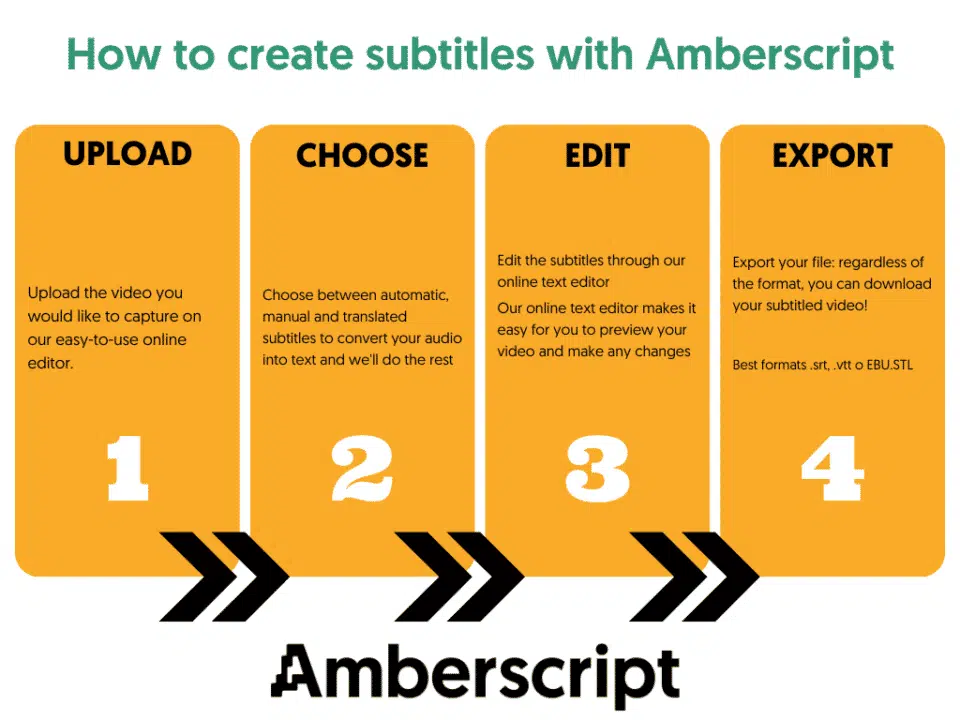

How to subtitle your videos
Find out more
Read our detailed guide on how to add subtitles to your videos.
Learn moreBenefits of using Amberscript
Amberscript’s subtitle services are:
Edit your own text within minutes or leave the work to our experienced subtitlers.
Our experienced subtitlers and thorough quality controls ensure 100% accuracy of your transcriptions and subtitles.
Thanks to a variety of integrations and API interfaces, you can fully automate your workflows.
Your data is in safe hands. We are GDPR compliant + ISO27001 & ISO9001 certified.
Frequently asked questions
-
Can I burn the subtitles directly onto my video?
If you have exported the transcript as a SRT, EBU-STL or VTT file, you can easily burn them onto your video using video-editing software.
-
Can I change the position of the subtitles?
That needs to be done using a video editor like VLC. Go to Tools > Preferences [CTRL + P]. Under Show settings, select the option that says All to switch to the advanced preferences. Navigate to Input/Codecs > Subtitle codecs > Subtitles. Under Text subtitle decoder set, the Subtitle justification to left, right or center.
-
How do I add subtitles to a YouTube video?
To add subtitles to your Youtube video, simply add the file you have created using Amberscript to your video in the Youtube Studio. Click on “subtitles”, then “add” and finally “upload file” and select the SRT file.
-
How do I add subtitles to a video on Vimeo?
To add subtitles to your Vimeo video, simply add the file you have created using Amberscript to your video in the editing window on Vimeo. Click on “distribution”, then “subtitles” and finally click on the + symbol to upload the SRT file.
-
How do I order translated subtitles?
To order translated subtitles, you can upload your file like you would normally do. You can then select manual subtitling. Once you have selected this, an option will appear where you will be able to select the language the subtitles need to be translated to. If the language that you want is not one of the options you can contact us through our contact form.
-
To which languages can you translate subtitles?
For our human-made subtitling services we work with a network of language experts in 15 different languages. Find out which here. If the language you want is not on the list, please contact us through our contact form.
-
What subtitle file formats are supported?
Our software allows you to export the transcript from the video or audio file as an SRT, EBU-STL or VTT file.
How to Make Subtitles for a YouTube Video
Have you recorded a nice video that you want to share with millions? Thought of uploading it on YouTube? That’s great! But did you know that having subtitles or a transcript can seriously boost the potential reach of your videos?
This happens for a reason. Search engines – such as Google – use crawlers to find content online. These crawlers can only understand text, so providing your video with subtitles or a full transcript of your content can bring your work to light. In this blog post, there is everything you need to know about how to add subtitles to a YouTube video. Let’s start!
4 Ways to Add Subtitles to a YouTube Video
- Generate them automatically on YouTube
- Create subtitles manually, then upload an SRT file on YouTube
- Create them automatically with Amberscript, then upload them on YouTube
- Hardcode the existing subtitles into your video, then upload the video on YouTube
Let’s get started and discuss each of them.
1 YouTube Can Automatically Generate Subtitles for You.
- First, you need to upload a video on YouTube
- Log in to your account → Create a video or a post → Upload a video file

- Go to your channel (or YouTube Studio) → Select your video → Go to Advanced Settings
- Choose a video language
- By default the subtitles will be auto-generated, you just need to click on CC button to turn them on when you watch the video

P.s. if you click on properties, you can also edit those subtitles in Classic Studio, but their accuracy is far from perfect, so you’ll have to dedicate a lot of time to it.
2 You Can Create Subtitles Yourself and Upload Them on Youtube
- You can use any text editor for this, including notepad. Just be prepared to spend 4 minutes for captioning each minute of your video. (in other words, an hour-long movie will take 4 hours to caption). If you have a lot of time and patience to do it, check out this article on how to add subtitles to both the video and audio players for some tips.
- Go to your channel (or YouTube Studio) → Select your video → Go to Advanced Settings
- Upload your subtitles/cc → With timing
- Done

3 How to Create Subtitles with Amberscript in 5 minutes
- Learn how to create very accurate subtitles with our tool and make final -adjustments in our intuitive editor. Our engines can reach up to 90% accuracy, leaving you with small adjustments to make.
- After you have done that, export your document in SRT format
- Go to your channel (or YouTube Studio) → Select your video → Go to Advanced Settings
- Upload your subtitles/cc → With timing
- Voila!
P.s. all of your files exported from Amberscript include timestamps, so make sure to select “with timing”. If you select “without timing” your subtitles will lose their specific time codes and will be spread evenly across the whole video.
4 You Can Also “Burn in” Subtitles into Your Video and Then Upload it on YouTube.
That’s not something we’d recommend, but if it benefits your content – there is an easy way to do it.
- Create subtitles using any method described above (automatically or manually)
- Download a free video transcoder, such as HandBrake
- Install the software and open it
- Upload your video file

- Go to subtitles tab → Import SRT
- Choose the correct source → Press “Burn in”

- Click on “Save as” → Choose a location and a name for your file
- Press “Start Encode” and wait for your video to be exported
- There you have it, now subtitles are merged into your video
- Now you can upload it on YouTube
Here we are at the end! You should by now know how to add subtitles to a youtube video! We are certain that subtitles can be very beneficial for your video content.
If you want to know more about subtitles you might also want to read:
– How to Create Subtitles with Amberscript
– Subtitles, Closed Captions and SDH: How are they different?
What is speech to text software and how does it work?
- Definition: What is speech to text software?
- What is the current state of Speech Recognition?
- Why do we need speech to text software?
- How is voice to text software used in different industries?
- How does speech to text software work?
- What makes Amberscript’s speech to text model the best?
What is speech to text software?
Speech to text software that’s used for translating spoken words into a written format. This process is also known as speech recognition or computer speech recognition. There are many applications, tools, and devices that can transcribe audio in real-time so it can be displayed and acted upon accordingly.
What is the Current State of Speech Recognition?
Recent technological developments in the area of speech recognition not only made our life more convenient and our workflow more productive, but also open opportunities, that were deemed as “miraculous” back in the days.
Speech-to-text software has a wide variety of applications, and the list continues to grow on a yearly basis. Healthcare, improved customer service, qualitative research, journalism – these are just some of the industries, where voice-to-text conversion has already become a major game-changer.
Why Do We Need Speech to Text software?
1. It reduces the time to transcribe content
Professionals, students, and researchers in various industries use high-quality transcripts to perform their work-related activities. The technology behind the voice recognition advances at a fast pace, making it quicker, cheaper and more convenient than transcribing content manually.
Current speech to text software isn’t as accurate as professional transcriber, but depending on the audio quality – the software can be up to 85% accurate.
2. Speech to text software makes audio accessible
Why is Speech to Text Recognition currently booming here in Europe? The answer is quite simple – digital accessibility. As described in the EU Directive 2016/2102, governments must take measures to ensure that everyone has equal access to information. Podcasts, videos and audio recordings need to be supplied with captions or transcripts to be accessible by people with hearing disabilities.

How is speech to text software used in different industries?
Speech to text technology is no longer just a convenience for everyday people; it’s being adopted by major industries like marketing, banking, and healthcare. Voice recognition applications are changing the way people work by making simple tasks more efficient and complex tasks possible.
Customer Support call analytics
Machine-made transcription is a tool that helps you understand customer conversations, so you can make changes to improve customer engagement. This service also makes your customer service team more productive.
Media and broadcasting subtitling
Speech to text software helps to create subtitles for videos and allows them to be watched by people that are deaf or hard of hearing. Adding subtitles to videos makes them accessible to wider audiences.
Healthcare
With transcription, medical professionals can record clinical conversations into electronic health record systems for fast and simple analysis. In healthcare, this process also helps improve efficiency by providing immediate access to information and inputting data.
Legal
Speech to text software helps in the legal transcription process of automatically writing or typing out often lengthy legal documents from an audio and/or video recording. This involves transforming the recorded information into a written format that is easily navigated.
Education
Utilizing speech to text can be a beneficial way for students to take notes and interact with their lectures. With the ability to highlight and underline important parts of the lecture, they can easily go back and review information before exams. Students who are deaf or hard of hearing also find this software helpful as it caption online classes or seminars.
How Does Speech to Text Software Work?
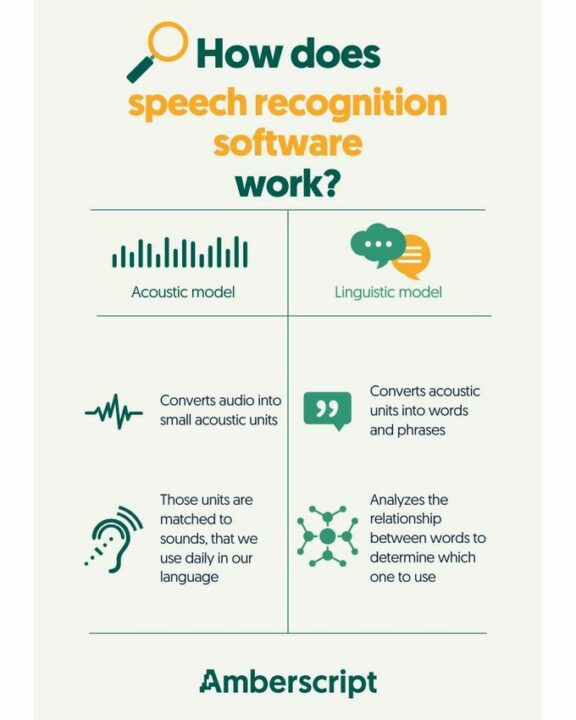
The core of a speech to text service is the automatic speech recognition system. The systems are composed of acoustic and linguistic components running on one or several computers.
What is speech to text acoustic model?
The acoustic component is responsible of converting the audio in your file into a sequence of acoustic units – super small sound samples. Have you ever seen a waveform of the sound? That’s we call analogue sound or vibrations that you create when you speak – they are converted to digital signals, so that the software can analyze them. Then, mentioned acoustic units are matched to existing “phonemes” – those are the sounds that we use in our language to form meaningful expressions.
What is speech to text linguistic model?
Thereafter, the linguistic component is responsible of converting these sequence of acoustic units into words, phrases, and paragraphs. There are many words that sound similar, but mean entirely different things, such as peace and piece.
The linguistic component analyzes all the preceding words and their relationship to estimate the probability which word should be used next. Geeks call these “Hidden Markov Models” – they are widely used in all speech recognition software. That’s how speech recognition engines are able to determine parts of speech and word endings (with varied success).
Example: he listens to a podcast. Even if the sound “s” in the word “listens” is barely pronounced, the linguistic component can still determine that the word should be spelled with “s”, because it was preceded by “he”.
Before you are able to use an automatic transcription service, these components must be trained appropriately to understand a specific language. Both, the acoustic part of your content, that is, how it is being spoken and recorded, and the linguistic part, that is, what is being said, are critical for the resulting accuracy of the transcription.
Here at Amberscript, we are constantly improving our acoustic and linguistic components in order to perfect our speech recognition engine.
What is a speaker dependent speech to text model?
There is also something called a “speaker model”. Speech recognition software can be either speaker-dependent or speaker-independent.
Speaker-dependent model is trained for one particular voice, such as speech-to-text solution by Dragon. You can also train Siri, Google and Cortana to only recognize your own voice (in other words, you’re making the voice assistant speaker-dependent).
It usually results in a higher accuracy for your particular use case, but does require time to train the model to understand your voice. Furthermore, the speaker-dependent model is not flexible and can’t be used reliably in many settings, such as conferences.
You’ve probably guessed it – speaker-independent model can recognize many different voices without any training. That’s what we currently use in our software at Amberscript
What Makes Amberscript’s Speech to to Text Engine the best?
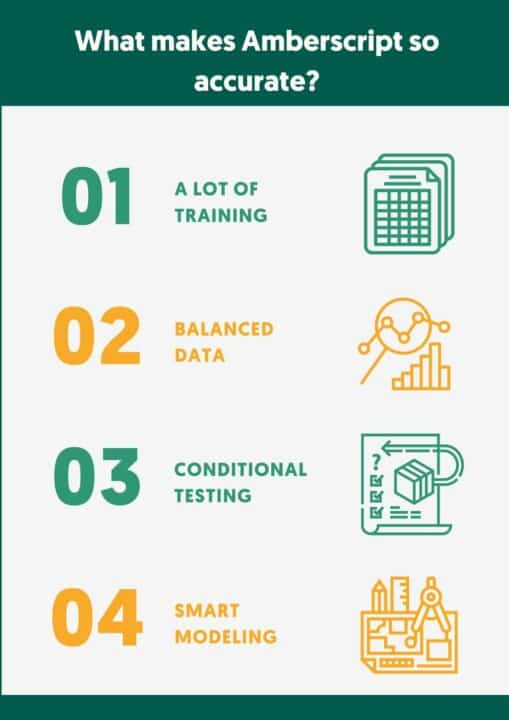
Our voice recognition engine is estimated to reach up to 95% accuracy – this level of quality was previously unknown to the Dutch market. We would be more than happy to share, where this unmatched performance comes from:
- Smart architecturing and modelling. We are proud to work with a team of talented speech scientists that developed a sophisticated language model, that is open for continuous improvement.
- Big amounts of training material. Speech-to-text software relies on machine learning. In other words, the more data you feed the system with – the better it performs. We’ve collected terabytes of data on the way to get to such a high quality level.
- Balanced data. In order to perfect our algorithm, we used various sorts of data. Our specialists obtained a sufficient sample size for both genders, as well as different accents and tones of voice.
- Scenario exploration. We have tested our model in various acoustic conditions to ensure stable performance in different recording settings.
Natural Language Understanding – The Next Big Thing in voice to text
Let’s discuss the next major step forward for the entire industry, that is – Natural Language Understanding (or NLU). It is a branch of Artificial Intelligence, that explores how machines can understand and interpret human language. Natural Language Understanding allows the speech recognition technology to not only transcribe human language but actually understand the meaning behind it. In other words, adding NLU algorithms is like adding a brain to a speech-to-text converter.
NLU aims to face the toughest challenge of speech recognition – understanding and working with unique context.
What Can You Do with Natural Language Understanding?
- Machine translation. That’s something that is already being used in Skype. You speak in one language, and your voice is automatically transcribed to text in a different language. You can treat it as the next level of Google Translate. This alone has enormous potential – just imagine how much easier it becomes to communicate with people who don’t speak your language.
- Document summarization. We live in a world full of data. Perhaps, there is too much information out there. Imagine having an instant summary of an article, essay, or email.
- Content categorization. Similar to a previous point, content can be brought down into distinctive themes or topics. This feature is already implemented in search engines, such as Google and YouTube.
- Sentiment analysis. This technique is aimed at identifying human perceptions and opinions through a systematic analysis of blogs, reviews, or even tweets. This practice is already implemented by many firms, particularly those that are active on social media.
Yes, we’re heading there! We don’t know whether we’re gonna end up in a world full of friendly robots or the one from Matrix, but machines can already understand basic human emotions.
- Plagiarism detection. Simple plagiarism tools only check whether a piece of content is a direct copy. Advanced software like Turnitin can already detect whether the same content was paraphrased, making plagiarism detection a lot more accurate.
Where is NLU Applied These Days?
There are many disciplines, in which NLU (as a subset of Natural Language Processing) already plays a huge role. Here are some examples:
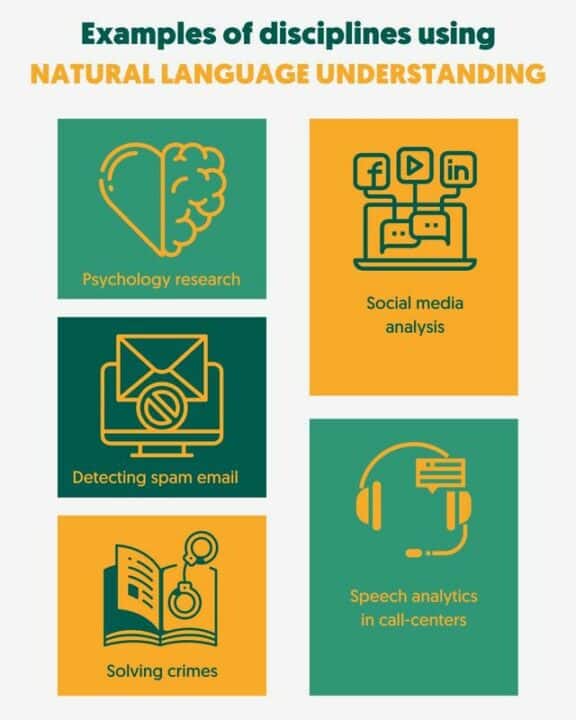
What’s the future of Natural Language Processing?
We’re currently integrating NLU algorithms in our speech to text software to make our speech recognition software even smarter and applicable in a wider range of applications.
We hope that now you’re a bit more acquainted with the fascinating field of speech recognition!
3) The ultimate level of speech recognition is based on artificial neural networks – essentially it gives the engine a possibility to learn and self-improve. Google’s, Microsoft’s, as well as our engine is powered by machine learning.
Subtitles, Closed Captions, and SDH Subtitles: How are they different?
Subtitles are a text created from the transcript of a video. However, captions offer added value by describing what is happening in addition to the dialogue, such as any music or background noises. Finally, SDH are subtitles that replicate captions and are specifically designed for deaf or hard of hearing persons.
Table of contents
- What are subtitles?
- SDH Subtitles vs. Closed Captions
- Why should you create subtitles (SDH or CC)?
- Amberscript’s subtitling services
- How to create subtitles with Amberscript
- Learn more about what we do at Amberscript
What are subtitles?
Subtitles are text that are typically displayed at the bottom of the screen and are taken from a transcript or screenplay of the dialogue in movies, television shows, or videos. Oftentimes, translated subtitles are used when the original audio is in a different language than the viewer’s mother language. This allows a broader audience to enjoy your video content.

What are closed captions?
They not only provide the dialogue in written form but also supplement information about background noises, soundtracks, and other noises that are part of the scene. Closed captions are mostly written in the language that is set for the video. For instance, if you have Netflix and turn on subtitles, what you see is a good example of closed captions.
Good to know: In essence, subtitles are targeted towards people who can hear the audio but also need the dialogue in written form. Closed captions on the other hand are targeted to an audience that cannot hear the audio and need a text description of sounds.
What are subtitles for the deaf or hard-of-hearing (SDH)?
SDH captions are subtitles which combine the information of both captions and subtitles. While normal subtitles assume the viewer can hear the audio but doesn’t know the spoken language,
SDH assumes that the viewer cannot hear the audio (like with captions). In this case, SDH is intended to emulate closed captions on media that does not support closed captions, such as digital connections like HDMI. SDH can also be translated into foreign languages to make content accessible to the deaf and hard of hearing individuals who understand other languages.
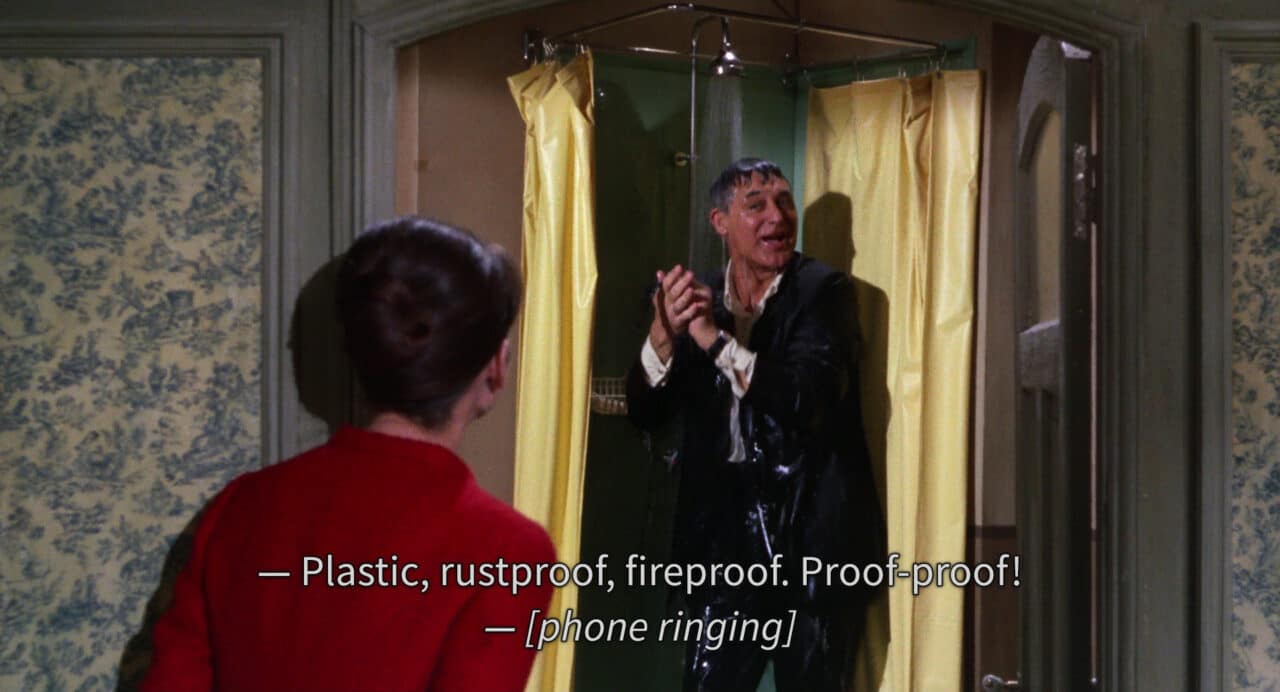
SDH Subtitles vs. Closed Captions
Appearance
SDH captions differ from closed ones in a number of ways. The first difference is in appearance. Closed captions are typically displayed as white text on a black band, whereas SDH are usually displayed with the same proportional font of translated subtitles. More and more often, however, both subtitles and closed captions have user control options that allow the viewer to change the font, color, and size of the text.
Placement
SDH and closed captions also differ in terms of placement. Closed captions can usually be aligned to different parts of the screen which is helpful for speaker identification, overlapping conversation, and avoiding interference with important on-screen activity. SDH text is usually centered and locked in the lower bottom third of the screen.
Why should you create subtitles (SDH or CC)?
Adding subtitles, SDH or CC to your video has multiple advantages.
1) Your video content will be discovered by more people on social media/
As it turns out, 85% of Facebook videos are watched without sound. Adding subtitles to your videos will not only capture the attention of potential viewers but will also allow them to get your take-home message, even with no audio. Sometimes circumstances don’t allow viewers to watch videos with sound (e.g – count how many times you forgot your headphones and then had to travel by bus/ attend an event/ stand in the waiting line, etc). The true value of your subtitles lies in the additional convenience they provide to your audience.
2) Reach a potentially wider audience
There are over 400 million people worldwide who are deaf or have partial hearing disabilities. They either can’t or have a hard time consuming audio content. By creating subtitles, you ensure that your message is spread to those customer groups, who would otherwise be excluded. Improving the accessibility of your content will help you better serve your audience.
3) Improve SEO
Search Engines like Google can’t analyze video material, that’s why when you upload this type of content, only the title and the description are included in the keyword search. By adding a textual transcript to your video, search engines have much more data to work with, which helps to attract traffic to your content.
4) Attract more foreign viewers to your content
When your transcript is ready, it’s easy to translate it into many foreign languages. Having subtitles in multiple languages will not only expand your geographic reach but will also make your content more discoverable, again, because of improved SEO.
Well done! If you came this far it means that you now are an expert about subtitles and closed captions.
Amberscript’s subtitling services
Now that you understand the difference between subtitles, closed captions and SDH captions, you need to know how to create them. Using Amberscript’s services is one of the easiest and most accurate ways to create subtitles for your videos. At Amberscript, we offer three kinds of services:
- Machine-made captions
Machine-made captions are the fastest way of subtitling. Amberscript’s advanced speech recognition (ASR) software provide a convenient solution up to 85% accuracy in 39 different languages. By using Amberscript machine-made subtitling services, you only need to upload your video, then our software will provide you with a transcript, that you can edit yourself. After accepting the AI-generated transcript, the subtitles will be created for you.
- Human-made captions
If you need highly accurate subtitles you can benefit from our human-made subtitling services. Our professional team of native freelancers ensure that your subtitles are 100% accuracy in 15 different languages. By choosing this option, you only need to upload your file and we will do all the work for you.
- Translated subtitles
Your video content will often need to have subtitles in different languages to reach a broader international audience. With Amberscript’s translated subtitles our team of professional translators will provide you with subtitles in 15 different languages. In this case, you’ll not only make your video accessible to a wider audience, but you will also provide learning opportunities.

How to create subtitles with Amberscript
1. Upload your video file
Once you have the video you would like to subtitle, upload it onto the Amberscript platform. Once the video has been uploaded, select the language of the file and choose the service option most suitable for you (machine-made, human-made or translated subtitles).
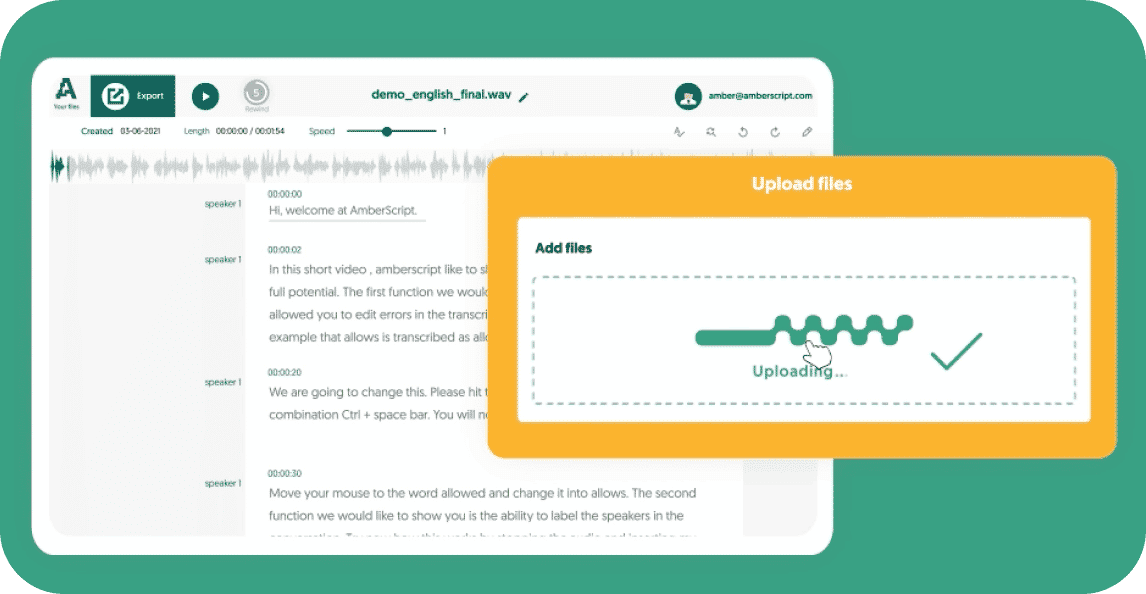
2. Edit your subtitles in the online text editor
If necessary, you can use the online text editor to make any adjustments to your subtitles. On our online text editor, you’re able to edit the generated transcript, align and format the subtitles to get them to the best file for your video. Get familiar with the editor by following the instructions in the demo video on the platform.

3. Export your file
Once you feel like your file is ready, it’s time to export and download. This is a simple process and only takes a few seconds. With Amberscript, you will be able to export your file in various formats, but we recommend you to choose between SRT, VTT and EBU-STL for subtitles. Choose the format and download it to your computer so you can access it at any time.
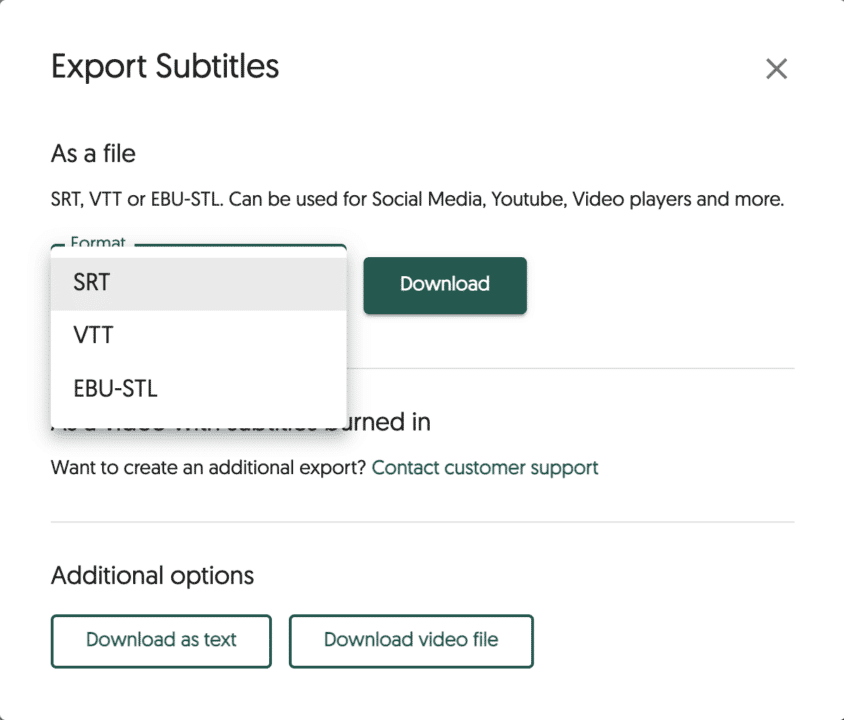
Learn more about what we do at Amberscript
Would you like to know more about how you can create subtitles with Amberscript? We have a detailed step-by-step guide explaining the process for you. If you need information on how to add subtitles to different platforms, click on the links to access our detailed guides.
- How to create subtitles in Premiere Rush
- How to create subtitles in iMovie
- How to create subtitles in Final Cut Pro
- How to create subtitles in DaVinci Resolve
- How to create subtitles for Skillshare
- How to create subtitles for Canvas
- How to create subtitles for Moodle
- How to create subtitles for Udemy
- How to create subtitles for Twitch (live streaming platform)
- How to create subtitles for Kaltura (SaaS platform)
- How to create subtitles for Vimeo (video hosting platform)
- How to create subtitles for Panopto (video platform)
Frequently asked questions
-
What is the difference between subtitles and closed captioning?
Subtitles are for viewers who are unable to understand the language spoken, whereas captions are for viewers who are not able to hear the audio.
Captions, which can be closed or open captions, incorporate both the conversation and any other relevant sounds. They are used to assist the deaf by showing all auditory sounds. That is, they include environmental sounds as well as changes in speaker and speaker tone.
Captions can also be used by hearing people who cannot hear the audio in a noisy place or who do not want to disturb the other people in their environment. Subtitles can also be used for this purpose if the viewer just wants to follow a conversation.
-
Why are they called closed captions?
The term “closed” in closed captions refers to the fact that the captions are not displayed until the viewer activates them, usually using the remote control or a menu option. The process of activating them is what is known as decoding.
-
What does closed captioning mean?
Closed captioning is text that appears on the screen to recreate the audio experience for people who may or may not understand the language being spoken, but cannot hear the audio for whatever reason.
They provide the dialogue in written form but also supplement information about background noises, soundtracks, and other noises that are part of the scene. Closed captions are mostly written in the language that is set for the video.
-
How to add subtitles to a video?
To add subtitles to a video:
- Import the video to be subtitled.
- Choose the clip in the movie or video to which you want to add subtitles.
- The viewer will then display a title sign at the top. Tap the Title sign.
- After clicking the title sign, select the title style you want.
- There are title variations for the bottom of the screen. Examples are lower, lower third, and reveal lower third. You may select any of them.
- To add a title (subtitle) style, double-click it.
- Go up to the observer. There is a text box at the top of the viewer where you may enter your text.





